![]()
New Additions - Paperweights
for Sale
![]()
New Additions - Paperweights
for Sale
|
|
||
| 6065 | Perthshire PP2 Medium Paneled Millefiori
Paperweight. circa 1978-1997. This is a
medium patterned millefiori paperweight with Perthshire's "P"
signature cane in the center surrounded by two rings of colorful
millefiori and then eleven short radial twists. Each panel has
a 1-1-2-2 pattern of millefiori. The ground is an opaque lime
green. This version of the PP2 with a signature cane and
hollow ground base was made from 1978 to 1997. It also has a
stained and worn Perthshire paper label "PERTHSHIRE PAPERWEIGHTS
CRIEFF SCOTLAND" on the base. An extra nice example with crisp
setup and bright colors. Perthshire was a small company in Crieff, Scotland that was devoted to the creation of quality glass paperweights. They stopped production in January 2002 after more than 30 years of production. Their paperweights were consistently high in quality and yet remained reasonable in price. The birth of Scottish paperweight making is credited to the glass making family of Salvador Ysart, who moved to Crieff, Scotland in 1922. They worked first at John Moncrieff Ltd and made the earliest Scottish paperweights during that period. In 1946 Salvadore and his sons Augustine and Vincent founded Ysart Brothers Glass and produced glass wares under the Vasart label. Salvador Ysart died in 1955 The company name was later changed to Vasart Glass. Stuart Drysdale was hired manage the business side of the enterprise in 1960. The company evolved into a new company Strathearn owned by Teachers Whiskey. In 1967 Drysdale was sent a magazine article on antique paperweights (Woman's Day, July 1965). The inspired him to try to produce weights comparable to the French antiques. With this goal in mind, he and several of the glass workers left Strathearn to found Perthshire in 1968. Medium size: Just under 2 1/2" diameter by 1 7/8"
high. The base is hollow ground. For extra pictures, click on the picture at the right and the following links: Large picture$135 postage paid in the US. Added 4/18/2024 For more information about Perthshire Paperweights, see my Perthshire Web Page. Click on the picture to see a larger image. |
Click
on the picture to see a larger image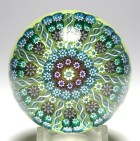
|
| 5706 | Stuart Abelman Art Nouveau Iridescent
Paperweight. dated 1996. This amazing paperweight
has a precise art nouveau design placed on a highly reflective
iridescent surface. The ground is opaque black. It is
signed on the base "Abelman OF3 1996". It is absolutely
spectacular. Note on reflections: This was a difficult paperweight to photograph because of the strong reflections and mirror-like surface. My hand holding the camera is visible in some of the pictures. Stuart Abelman studied glass at
Carnegie Mellon University and in the Master of Fine Arts
program at UCLA (California). He taught a developed a flat
glass program for El Camino College and in 1976 opened his
Abelman Glass Studio in Van Nuys, CA. He worked with a
number of other glass artists in developing his style. Size: 2 3/8" diameter by 2 1/8" high. The base
is polished flat. For extra pictures, click on the picture at the right and the following links: Large pictureSOLD. Added 3/31/3024 For more paperweights by contemporary American paperweight makers, see my Contemporary American Paperweights Web Page. Click on the picture to see a larger image. |
Click
on the picture to see a larger image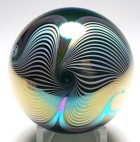 |
| 6071 | Murano Daisy Paperweight with
Millefiori Garland. circa 1970. Murano
paperweight with a complex daisy cane surrounded by a garland of
colorful complex millefiori canes. The daisy is one large
millefiori cane. The design is placed on a translucent blue
ground. I don't know the maker. A great addition to any
collection of millefiori paperweights.
This paperweight was made on the island of Murano in Venice, Italy. Venetian glass making dates back centuries and the Venetians are given credit for the earliest millefiori canes and paperweights in 1840s. More recently, paperweight making was revived in the 1930s and again in the 1960s. Large Size: 3" diameter by 2" high. The base
is polished flat. For extra pictures, click on the picture at the right and the following links: Large picture$65 postage paid in the US. Added 3/31/2024 For more information about Murano paperweights, see my Murano Paperweights Web Page . Click on the picture to see a larger image. |
Click
on the picture to see a larger image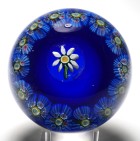 |
| 5705 | Early Magnum Kit Karbler Michael David
Blake Street Glass Art Nouveau Paperweight. dated
1981. This is a very early art nouveau paperweight made by Kit
Karbler and David Michael of Blake Street Glass in Denver,
Colorado. It features a flowing organic motif in shades of
red. The design is placed near the base and encased in clear
glass. The paperweight is extra large. It is signed on
the base by both artists near the edge of the base with the "1981"
date in the center of the base. An early example from this
studio. Great execution. Note about Blake Street Glass: This paperweight is a very early work by these outstanding glass artists and differs from their later sculptural work which evolved to a sophisticated process for cutting and faceting. Later works often sell for thousands of dollars. The price for this piece is more modest. Blake Street Glass in Denver, Colorado was started in 1979 by Kit Karbler and Michael David. The two set out to make works that were different with a sophisticated process of cutting and faceting the pieces. Their approach gained them numerous awards and recognition over the years. Their work is on display in many prestigious collections and museums. Kit Karbler received his Bachelors degree in Fine Art from Ohio University and continued his graduate studies in Glass and Design at UCLA where he studied with the internationally renowned glass artist Richard Marquis. Michael David studied Glass and Art at the University of Colorado, Goddard College and Cornell university. The Blake Street Glass Studio closed in 2020. Very large size: 3 11/16" diameter by 3 3/8"
high. The base is polished flat. The paperweight
weighs 2 pounds 5 ounces and will weigh over 3 pounds when double
boxed and packaged for mailing. For extra pictures, click on the picture at the right and the following links: Large picture$295 postage paid in the US. Added 3/30/2024 For more paperweights by contemporary American paperweight makers, see my Contemporary American Paperweights Web Page. Click on the picture to see a larger image. |
Click
on the picture to see a larger image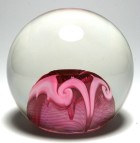 |
| 5572 | Perthshire PP31 1976 Limited Edition
Paneled Millefiori Paperweight. This
large paperweight has a large complex millefiori cane surrounded by
a ring of canes, then ten panels each with a 1-1-2 canes. The
panels are separated by ten short green and white twists and then
surrounded by a single ring canes, then a ring of green, orange, and
white twists, plus an outer ring of canes. The entire
design is set on a translucent ruby ground. It is signed on
the base with a complex "P 1976" cane and has a very worn Perthshire
paper label "PERTHSHIRE PAPERWEIGHTS CRIEFF SCOTLAND". It also
has a label from a Selman auction. An early limited edition
paperweight with an advanced complicated design. Perthshire made the limited edition PP31 only from 1976 to 1978. In 1976, the edition size was 450 paperweights. Note on Selman Auction: The previous owner paid $350 plus a 15% bidders premium for this paperweight at the Selman Auction 37 (Lot 277). Perthshire was a small company in Crieff, Scotland that was devoted to the creation of quality glass paperweights. They stopped production in January 2002 after more than 30 years of production. Their paperweights were consistently high in quality and yet remained reasonable in price. The birth of Scottish paperweight making is
credited to the glass making family of Salvador Ysart, who moved
to Crieff, Scotland in 1922. They worked first at John
Moncrieff Ltd and made the earliest Scottish paperweights during
that period. In 1946 Salvadore and his sons Augustine and
Vincent founded Ysart Brothers Glass and produced glass wares
under the Vasart label. Salvador Ysart died in 1955.
The company name was later changed to Vasart Glass. Stuart
Drysdale was hired manage the business side of the enterprise in
1960. The company evolved into a new company Strathearn
owned by Teachers Whiskey. In 1967 Drysdale was sent a
magazine article on antique paperweights (Woman's Day, July
1965). This inspired him to try to produce weights
comparable to the French antiques. With this goal in mind,
he and several of the glass workers left Strathearn to found Perthshire
in 1968. Large Size: 3 1/16" diameter by 2 1/8" high.
The base is ground concave. For extra pictures, click on the picture at the right and the following links: Large picture$265 postage paid in the US. Added 3/25/2020 For more information about Perthshire Paperweights, see my Perthshire Web Page. Click on the picture to see a larger image. |
Click
on the picture to see a larger image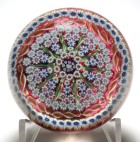 |
| 6050 | David Salazar Marbrie Paperweight with
Millefiori Star Crown. dated 1985. This
paperweight features a multi-colored surface decorated marbrie
design. At the top is a complex millefiori cane with a
concentric pattern of white stars on a black background. The
design is placed on the surface of the paperweight with an opaque
white ground. It is signed on the base "D. P. Salazar
12/85". An early example from the period when David Salazar
was establishing his own studio. Great execution. David P. Salazar was born in Del Rio, Texas. His fascination with glass started in college, when he began making scientific glassware. In 1972, he started working as an apprentice at Lundberg Studios, and quickly moved into the more creative aspects of designing and torchwork. After 10 years in the studio environment, he decided to strike out on his own in order to develop new designs and techniques. Initially he rented space from Zephyr Studios in Santa Cruz, CA, staying there from 1982 to 1985. When Zephyr went out of business, Salazar took over the building and started his own studio. Medium size: Just over 2 1/2" diameter
by just under 1 7/8" high. The base is polished flat.
For extra pictures, click on the picture at the right and the following links: Large picture$165 postage paid in the US. Added 3/23/2024 For more paperweights by contemporary American paperweight makers, see my Contemporary American Paperweights Web Page. Click on the picture to see a larger image. |
Click
on the picture to see a larger image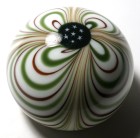 |
| 6034 | Magnum Gentile Glass Frit Butterfly
Paperweight. circa 1950-1974. This paperweight
features a frit (ground glass) butterfly and flower surrounded by a
controlled pattern of bubbles. The wings of the butterfly are
made with a speckled mixture of blue and white frit. The body
and antennae are made with black frit. The flower was made
with red and white frit and has the center pushed down to form a
stem. This design was set up in a metal die having the
butterfly and flower design and then finished by adding the bubbles
with a larger mold. It is unsigned but I guarantee this was
made at Gentile Glass in Star City, West Virginia. An
especially nice example. According to Jean Melvin's 1970 book American Glass Paperweights and Their Makers, this design was patented by John Funfrock in 1948. Funfrock made the die (mold) and Peter Gentile made the first paperweights with this design. At the time, Peter Gentile and John Funfrock were partners in the G. and F. Glass Co. The earliest design had the butterfly hovering over a flower. The paperweight is made by arranging ground glass with the desired colors in a die with depressions for the wings, body, and flower. The design is then picked up with a gather of clear glass and finished into a paperweight. The bubbles are added by pressing the nearly finished paperweight into a larger mold with points where the bubbles are to be. You can see a picture of the mold used in Melvin's book. The original glass worker in the Gentile family was Peter Gentile, born in Naples, Italy in 1884. He worked in Naples(Italy), Rochester (Pennsylvania), and Morgantown (West Virginia) before building his own factory in Star City (West Virginia) in 1947. Originally the factory was a short-lived partnership (G. and F. Glass Co.) with John Funfrock, a mold maker. His sons, Frankie, John and Joe Gentile helped him make paperweights in the off hours at the Guild Factory in Morgantown. However, most paperweight production since WWII has been associated with Peter, John, or John's wife Gertrude Gentile. Few weights were signed prior to 1963. John Gentile passed away in 2006 and it is believed that Gentile Glass closed down after his death. Most, if not all, paperweights produced from 1975 on were signed. For more information, you can read about the Gentile Family in the book American Glass Paperweights and Their Makers by Jean Melvin (1967 and 1970). Very large size: 3 5/16" diameter by 3 1/4"
high. The base is ground concave. For extra pictures, click on the picture at the right and the following links: Large picture$49 postage paid in the US. Added 3/22/2024 For more information about Gentile paperweights, see my Gentile Paperweights Web Page . Click on the picture to see a larger image. |
Click
on the picture to see a larger image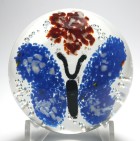 |
| 5652 | Magnum Selkirk 1990 Winter Breeze Abstract
Paperweight with Certificate. dated 1990.
This abstract paperweights represents a winter breeze churning up
waves and swirling spray on a body of water. The design is set
on a blue and white ground with lots of controlled bubbles and a
pink center. It is signed in script on the base "SELKIRK GLASS
SCOTLAND WINTER BREEZE 1990" and has its original Selkirk silver
foil label. It comes with its original certificate stating the
design is by William Lowery. A flashy paperweight with great
color and execution. Selkirk Glass founded in 1977 by
Peter Holmes and Ron Hutchinson. Peter apprenticed under
Paul Ysart at Caithness from 1963 and continued at Caithness
until 1977. Ron Hutchinson, a graduate of Edinburgh
University, was also at Caithness. Selkirk produced a wide
range of paperweight styles including abstract, lampwork, and
millefiori paperweights. The company was located in
Selkirk, Scotland in the Borders Region. At some point
they were purchased by Edinburgh Crystal and remained in
operation until 2006. Very large size: 3 3/8" diameter by 3" high.
The base is ground concave. For extra pictures, click on the picture at the right and the following links: Large picture$135 postage paid in the US. Added 3/21/2024 For more information about paperweights made by Scottish makers, see my Scottish Paperweights Web Page Click on the picture to see a larger image. |
Click
on the picture to see a larger image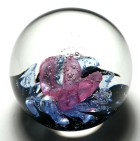 |
| 4860 | Rare Magnum Baccarat 2000 Rendez-vous des
Libellules Dragonflies Limited Edition Faceted Paperweight with
Box. dated 2000. This magnificent very large
faceted paperweight features five colored dragonflies flying above
the ground. The ground has a translucent green layer above an
opaque white layer. The title "Rendez-vous des Libellules"
translates as "Meeting of the Dragonflies". Baccarat made this
design in 2000 in a limited edition of 75 paperweights. It is
signed in the design with a complex "B2000" signature / date cane
and is also signed on the base with an acid etched Baccarat mark
along with the year (2000) and edition number (54 / 75). There
is also a Baccarat etched signature on the side next to the base and
a Baccarat red paper label on the base. The paperweight is
faceted with a barrel faceting having a top facet and 75 side cuts
in five rows. This paperweight comes with its original rigid
Baccarat box. One of the best of the Baccarat
paperweights. Large and showy with great color. Baccarat was founded in 1776 in Alsace-Lorraine with the name of Verrerie de Sainte Anne. The original location was near the town of Baccarat. Today the firm is known as Compagnie des Cristalleries de Baccarat. In 1952, Paul Jokelson approached Baccarat with the idea of making sulphide paperweights again. In 1953 Baccarat resumed paperweight production with a series of sulphide paperweights the first of which were the unsuccessful Eisenhower sulphide followed by the Queen Elizabeth coronation sulphide. Millefiori paperweight production was resumed in 1957 and lampwork paperweights were re-introduced in the early 1970s. Baccarat stopped making this type of fine glass paperweights in 2002. You can read more about the Baccarat paperweights in his book Baccarat Paperweights - two centuries of beauty by Paul Dunlop or one of the older books on paperweights in general, such as The Encyclopedia of Glass Paperweights by Paul Hollister or World Paperweights by Robert Hall. Very large size: 3 5/16" diameter by just under 2
1/16" high. The base is polished flat. The paperweight
is faceted with a barrel faceting having a top facet and 75 side
cuts in five rows. The box is 5 3/16" by 5 3/16" by 4 1/16"
high. For extra pictures, click on the picture at the right and the following links: Large picture$950 postage paid in the US. US Sales only, no international shipping. Delivery will require a signature. Added 3/21/2024 For more information about Baccarat paperweights, see my Baccarat Paperweights Web Page Click on the picture to see a larger image. |
Click
on the picture to see a larger image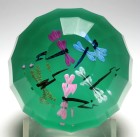 |
| 5704 | Kosta Boda Bertil Vallien Ateljé "Salvador
Dali's
Eye" Abstract Paperweight. circa 1976-1990.
This dramatic Swedish art glass paperweight was designed by
famous glass artist Bertil Vallien for Kosta Boda. It features
an internal "eye" of shimmering color with multicolored stripes
encased in an oval of clear glass. It is signed on the base
"KOSTA BODA B. Vallien 492 ATELJÉ", where 492 is the design
number. It also has a silver foil label "ATELJÉ DESIGN BERTIL
VALLIEN". An intriguing paperweight by this internationally
famous glass artist.
Note: Starting about 1976, Bertil Vallien
created his "Ateljé" (or Studio) line and also his "Artist
Collection" at Ĺfors glassworks. The Ateljé series consisted
of limited edition objects made under Vallien's direct
supervision. The Artist Collection works were made in larger
editions where each glass blower was allowed considerable freedom
in executing the design. There was a definite basic form,
but it was the craftsman's skill and feeling that completed the
work. Both of these series were enabled by the increased
capacity at Kosta Boda after the merger of Kosta, Boda and Ĺfors
in 1976. Kosta is one of the oldest glass companies in the world. Kosta Glasbruk was founded in 1742 in Smaland, Sweden by Anders Koskull and Georg B. Stael von Holstein. In 1976 the glassworks of Kosta, Boda and Ĺfors merged to form Kosta Boda AB. In 1989, Kosta Boda and Orrefors merged to form Orrefors Kosta Boda AB. Ownership changed in 2005 with the purchase of the glassworks by the New Wave Group which decided to close the Orrefors glassworks in December 2012. After that, all glass production was done under the KostaBoda brand label. Erik Bertil Vallien (1938-) initially studied Ceramics, first at the art school Konstfack in Stockholm and then at the University of Southern California (Los Angeles, CA). While in the US he also worked as a designer at a ceramics factory. After returning to Sweden in 1963, he began to focus on glass while also continuing his work in ceramics, and developed an innovative sand-casting technique. He was hired as a designer for the glassworks at Ĺfors and given the freedom to also work on his own designs part of the time. The merger of Kosta, Boda and Ĺfors in 1976 made it possible to devote more capacity to Vallien's designs. In 1963, he married Ulrica Margaret Hydman Vallien (1938-2018) a Swedish artist and fellow Konstfack student who started as a ceramist and then expanded her expertise to glass.
Oval Shape: Just over 3 9/16" long by just over 2
7/8" high by 1 5/8" thick. The base is polished flat.
For extra pictures, click on the picture at the right and the following links: Large picture$125 postage paid in the US. Added 3/19/2024 For more information about paperweights from other countries, see my Paperweights from Other Countries Web Page . Click on the picture to see a larger image. |
Click
on the picture to see a larger image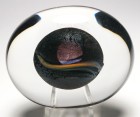 |
| 3661 | Set of St. Louis Paperweight Style Letter
Seals Limited Edition. dated 1974. This is pair
of St. Louis paperweight style letter seals, one red with a white
stripe and one blue with a white stripe. The bases are flat
and blank, ready to be engraved to create your own custom letter
seals. Each handle is hollow blown with white pinstripe
twists. These letter seals were issued in 1974 in limited
editions of 500 of each color and were sold individually and in
boxed sets. Each seal is signed on the top of the base with an
etched signature "1974 S. LOUIS France". A great addition to
any collection of modern French paperweights. Cristalleries de Saint Louis was
founded in 1767 in Lorraine, which became part of France in
1766. The region was already home to several
glassworks. Paperweight production started at St. Louis in
1845 and most likely continued until about 1860. Although
the modern production of paperweights started in 1952, the
output of millefiori and lampwork paperweights was small.
Fewer than 400 lampwork and millefiori paperweights were made
between 1952 and 1955. They were not all signed or
dated. The most successful product of this early revival
period was the Queen Elizabeth sulphide which was made to
commemorate her coronation in 1953. After 1955, no
additional weights were made at St. Louis until 1965. In
1965 the factory resumed production of lampwork and millefiori
paperweights and then in 1967 they began a series of sulphide
weights. Finally, in 1970 they started producing annual
limited edition paperweights. Size: These are handmade and differ very slightly
in size. The blue seal is 4 1/4" tall, the red seal is
slightly less. The base of each is just over 1 1/2"
diameter. The base of each seal is polished flat. For extra pictures, click on the picture at the right and the following links: Large picture$185 postage paid in the US. Added 3/18/2024 For more information about paperweights made by the St. Louis glass factory in France, see my St. Louis Web Page . Click on the picture to see a larger image. |
Click
on the picture to see a larger image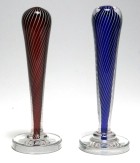 |
| 5984 | Antique New England Glass Company (NEGC)
Faceted Millefiori Nosegay Paperweight with Garland on Double
Latticinio Ground. circa 1860. This is a
wonderful antique faceted New England Glass Company (NEGC)
millefiori nosegay or posy paperweight. The nosegay setup is
very nice with three large millefiori canes, four leaves, and a stem
placed on a perfect double swirl latticinio ground. The
nosegay is surrounded by a millefiori garland with twenty complex
millefiori canes alternating blue & white and red & white
canes. The paperweight is faceted with a large six sided top
faceted and twelve side facets in two rings. The lower ring
has three side notches (crows feet) between each pair of
facets. The top facet has many small notches along each
edge. An amazing paperweight worthy of any collection of
antique paperweights. New England Glass Company (NEGC) operated in Cambridge, Massachusetts from 1818 to 1888. You can read about paperweights from the New England Glass Company in the book by Hawley, The Art of the Paperweight - The Boston & Sandwich and New England Glass Companies. Size: Just under 2 5/8” diameter by 1 9/16
high. The bottom is ground concave. For extra pictures, click on the picture at the right and the following links: Large pictureSOLD. Added 3/2/2024 For more information about Antique Paperweights, see my Antique Paperweights Web Page. Click on the picture to see a larger image. |
Click
on the picture to see a larger image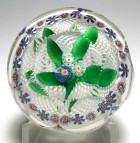 |
| 6044 | Magnum John Deacons Gordon Taylor
White PomPon Chrysanthemum Faceted Swirl Paperweight. circa
2020. This very large faceted paperweight features a
magnificent white pompon (chrysanthemum) flower with seven green
leaves and stem placed on a blue and white swirl ground. The
flower is very detailed. The swirl ground is made of fifteen
blue and five white stringers (rods of glass). The stringers
are arranged in groups of four and wrap around to the base.
This paperweight is faceted with a large top facet and six
side facets. The faceting was done by Gordon Taylor. It
is signed on the base with a "JD" signature cane and also has Gordon
Taylor's engraved "GT" below the signature cane. A wonderful
paperweight showcasing the artistry of John Deacons and Gordon
Taylor. Note: The original spelling of this flower is from the French Pompon but it is often spelled Pompom (with and without a hyphen). Take your choice. The birth of Scottish paperweight making is credited to the glass making family of Salvador Ysart, who moved to Crieff, Scotland in 1922. They worked first at John Moncrieff Ltd and made the earliest Scottish paperweights during that period. In 1946 Salvadore and his sons Augustine and Vincent founded Ysart Brothers Glass and produced glass wares under the Vasart label. Salvador Ysart died in 1955 The company name was later changed to Vasart Glass. Strathearn Glass was formed in a reorganization of Vasart glass in 1963. John H. Deacons learned his craft at
Strathearn Glass in Crieff, Scotland in 1967. When
Perthshire was formed in 1968, he left Strathearn to move to
Perthshire and worked there for 10 years before leaving in 1978
to start his own glass studio. He has produced
paperweights and other glass objects under a variety of labels,
including J Glass, St. Kilda, and now under his own name.
Some of the lines were produced simultaneously. J Glass
was produced from 1978 to 1983. The St. Kilda line was
produced from 1978 or 1979 through 1987. You can read
about John Deacons in the book by Hall - Scottish
Paperweights. Today John works at his own studio with his son Craig. Very large size: Just over 3 1/8" diameter by 2
1/8" high. The base is polished concave. It is faceted with
one large top facet and six side facets. For extra pictures, click on the picture at the right and the following links: Large picture$345 postage paid in the US. Added 3/2/2024 For more information about paperweights made by Scottish makers, see my Scottish Paperweights Web Page Click on the picture to see a larger image. |
Click
on the picture to see a larger image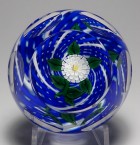 |
| 5944 | Perthshire Annual Collection 1999F Limited
Edition Three Dimensional Bouquet Paperweight with Certificate
& Box. dated 1999. This paperweight features
a multicolored three dimensional bouquet of flowers and buds set on
a clear ground with a special star and feather cut base. The
paperweight is faceted with one large top facet and 12 side facets
(eight large and four small). The paperweight is signed with
an engraved "P" on the edge of the base. It also has its
original paper label "PERTHSHIRE PAPERWEIGHTS CRIEFF
SCOTLAND". And it comes with its original certificate
identifying this as #48 out of a limited edition of 150 paperweights
and its original Perthshire box. A fantastic addition to your
collection of Perthshire paperweights.
Perthshire made this paperweight as one of their Annual Collection for 1999. This means the design was made only that one year and never again. The edition size for this paperweight was 150 weights. Each year's Annual Collection designs were lettered to indicated this special status. In 1999, there were eight Annual Collection designs, designated 1999A through 1999G plus the 1999 Foxglove design. This design, the Three Dimensional Bouquet Paperweight, was designated 1999F. Perthshire was a small company in Crieff, Scotland that was devoted to the creation of quality glass paperweights. They stopped production in January 2002 after more than 30 years of production. Their paperweights were consistently high in quality and yet remained reasonable in price. There are three books on Perthshire Paperweights. If you collect Perthshire paperweights, you should have them in your library.The birth of Scottish paperweight making is credited to the glass making family of Salvador Ysart, who moved to Crieff, Scotland in 1922. They worked first at John Moncrieff Ltd and made the earliest Scottish paperweights during that period. In 1946 Salvadore and his sons Augustine and Vincent founded Ysart Brothers Glass and produced glass wares under the Vasart label. Salvador Ysart died in 1955 The company name was later changed to Vasart Glass. Stuart Drysdale was hired manage the business side of the enterprise in 1960. The company evolved into a new company Strathearn owned by Teachers Whiskey. In 1967 Drysdale was sent a magazine article on antique paperweights (Woman's Day, July 1965). The inspired him to try to produce weights comparable to the French antiques. With this goal in mind, he and several of the glass workers left Strathearn to found Perthshire in 1968. Large size: 2 7/8" diameter by just under 2 1/2"
high. It is faceted with one large top facet and 12 side
facets (eight large and four small). The base is concave and
finished with a special star and feather cut. For extra pictures, click on the picture at the right and the following links: Large picture with box$675 postage paid in the US. US Sales only, no international shipping. Delivery will require a signature. Added 2/27/2024 For more information about Perthshire Paperweights, see my Perthshire Web Page. Click on the picture to see a larger image. |
Click
on the picture to see a larger image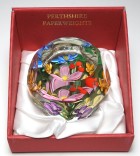 |
| 5651 | Magnum Selkirk 1986 Limited Edition Pink
Crimp Rose Paperweight with Certificate. dated
1986. This is a delicate Selkirk pink crimp rose with twelve variegated
petals arranged in an unusual 2+2+2+2+2+2 crimp pattern. The
design is set on a clear ground. It is number 125 out of a
limited edition of 250 paperweights. It is signed in script on
the base "SELKIRK GLASS SCOTLAND 125/250 1986" and has its original
Selkirk silver foil label. It comes with its original
certificate. A flashy paperweight with great color and
execution. Crimp roses represent the ultimate challenge for paperweight makers. Selkirk Glass founded in 1977 by
Peter Holmes and Ron Hutchinson. Peter apprenticed under
Paul Ysart at Caithness from 1963 and continued at Caithness
until 1977. Ron Hutchinson, a graduate of Edinburgh
University, was also at Caithness. Selkirk produced a wide
range of paperweight styles including abstract, lampwork, and
millefiori paperweights. The company was located in
Selkirk, Scotland in the Borders Region. At some point
they were purchased by Edinburgh Crystal and remained in
operation until 2006. Large size: Just over 3 1/8" diameter by just over
2 3/4" high. The base is ground concave. For extra pictures, click on the picture at the right and the following links: Large picture$195 postage paid in the US. Added 2/24/2024 For more information about paperweights made by Scottish makers, see my Scottish Paperweights Web Page Click on the picture to see a larger image. |
Click
on the picture to see a larger image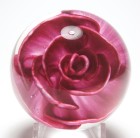 |
| 2398 | Antique Magnum Millville Masonic Frit
Paperweight. circa 1880-1920. This
antique frit paperweight features a Mason's square and compass
symbol with a "G" in the center. It was made in Millville, New
Jersey around the end of the 19th century. Blue and red ground
glass (frit) was used to make the design on a white ground.
The glass has a slightly green tint that is exaggerated in the
pictures. The profile is relatively flat. The
paperweight was made for the Masons, a fraternal organization,
probably at the Whitall Tatum factory in Millville, New Jersey. Frit refers to the powdered glass used to make the design. The design is set up in frit in a metal die and then picked up with a gather of the ground color. When encased, there is sometimes a ridge or crease line between the solid (in this case white) base area and the clear encasement. Collectors refer to this as two piece construction. This type of construction has been associated with Whitall Tatum and other factories in the Millville area. There is no crease on this paperweight, but the encasement stops where the white ground color starts. Note: Sometimes this style of paperweight will have an clear circle in the center of the base where the pontil would have been attached. Because a number of weights of this type (with the clear circle on the base) have been found in the Corning area, some collectors conjectured that the paperweights with a clear circle on the base were made in the Corning, NY area rather than Millville, NJ. I reject that conjecture as I have had this exact design with and without the clear circle. I believe both types were made in Millville and the difference is how much glass is removed when grinding the base to remove the pontil scar. Whitall Tatum was one of the first glass factories in America. Located in Millville, New Jersey, it was in operation from 1806 through 1938. The factory in Millville was purchased by a series of companies and eventually shut down in 1999. It is believed that Whitall Tatum workers were allowed to make paperweights from as early as 1860 until the practice was discouraged sometime after 1912. According to Newell's Old Glass Paperweights of Southern New Jersey , frit weights were made as early as 1863. Newell identifies this style as a true American folk art and gives a history of paperweight making at Whitall Tatum and other South Jersey factories. Very large size: Just over 3 1/4" diameter by 1 7/8"
high. The profile is relatively flat. The base is
ground flat. For extra pictures, click on the picture at the right and the following links: Large picture$145 postage paid in the US. Added 2/22/2024 For more vintage American paperweights, see my Vintage American Paperweights Web Page. (dl-va-ant) Click on the picture to see a larger image. |
Click
on the picture to see a larger image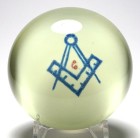 |
| 5700 | Magnum Hadeland Gro Bergslien Sommerfeldt
Abstract Painterly Paperweight. circa
1964-1986. This magnum abstract Hadeland paperweight was
designed by Norwegian designer Gro Bergslien Sommerfeldt. It
has a soft irregular shape with splotches of contrasting color on a
pink surface. The effect is a painterly experiment in
glass. It is signed on the base "Hadeland S.B." (for
Sommerfeldt Bergslien). It also has a paper label "HADELAND H
NORWAY" and a second smaller label on the base. It comes with
its original small brochure. It is a warm and comfortable
addition to any collection of abstract paperweights.
Hadeland Glasswerk was
founded in 1762 in Jevnaker, Norway and began producing glass
bottles, jars, and household glassware in 1765. During the
1800's, production moved to wine glasses, bowls and vases, in
styles popular in other European countries. Hadeland began
to create their own designs in the 1920's with a number of
prominent artists and designers. The company is still in
production today and is one of the largest glassworks in
Northern Europe. Very large size: 3 11/16" diameter by 2 3/16"
high. The base is polished flat. For extra pictures, click on the picture at the right and the following links: Large picture$95 postage paid in the US. Added 2/12/2024 For more information about paperweights from other countries, see my Paperweights from Other Countries Web Page . Click on the picture to see a larger image. |
Click
on the picture to see a larger image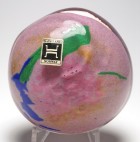 |
| 6021 | Paul Ysart Two Ducks and Flower on Pond
Signed Paperweight. circa 1972-1979. This large
Paul Ysart paperweight features a two yellow lampwork ducks and a
purple flower on the surface of a pond. The flower has a PY
signature cane in the center. The design is set on the top
translucent blue layer of a two level ground. This top layer
is very realistic, looking like water. Below is the second
level looking like a rocky pond bottom. In addition to the PY
signature cane, there is also a Paul Ysart "PY Made in Scotland"
paper label on the base. This paperweight was made during Paul
Ysart's Harland period when Paul Jokelson was the exclusive US
distributor of Paul Ysart paperweights. A wonderful example of
Paul Ysart's art from the Harland Period. A similar Paul Ysart Two Ducks on a Pond paperweight recently sold $660 in the Selman's Fall 2023 Auction (Auction 85 Lot 280). The birth of Scottish paperweight making is credited to the glass making family of Salvador Ysart, who moved to Crieff, Scotland from Spain in 1922. They worked first at John Moncrieff Ltd and made the earliest Scottish paperweights during that period. Paul Ysart (1904-1991), originally Pablo Moreno Isart, was apprenticed to his father as a glass worker at Moncrieff in 1922. He worked on the production of Monart Art Glass. Paperweights were primarily an after hours activity. Paul made his first paperweight in the early 1930s. Production was interrupted by World War II and the Monart line was not restarted until 1946. In 1946 Salvadore and his sons Augustine and Vincent left Moncrieff and founded Ysart Brothers Glass. They produced glass wares under the Vasart label. Salvador Ysart died in 1955. Paul stayed at Moncrieff from until 1962, when he joined Caithness as a Training Officer. While at Caithness, he trained Peter Holmes, Colin Terris, and William Manson, among others. After he retired from Caithness in 1972, he continued to make paperweights initially under the Harland label and then the Highland Paperweights label until 1979. You can read more about Paul Ysart in the book by Colin Mahoney Masterpieces: The Paperweights of Paul Ysart. Large size: 2 15/16" diameter by just over 2 1/4"
high. The base is polished flat. For extra pictures, click on the picture at the right and the following links: Large picture (note the two level ground with realistic water layer)$575 postage paid in the US. Added 2/11/2024 For more information about paperweights made by Scottish makers, see my Scottish Paperweights Web Page Click on the picture to see a larger image. |
Click
on the picture to see a larger image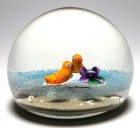 |
| 2530 | Magnum Baccarat Eight Row 1988 Close
Concentric Millefiori Paperweight. dated
1988. This magnificent close concentric millefiori paperweight
has eight rings or rows with the outer ring pulled down to the
center of the base to form a stave basket. Baccarat made this
design in 1988 and it has an edition number of 60, but no edition
size. The paperweight is signed in the design with Baccarat's
complex signature / date cane "B 1988" in the next to the last
ring. It also has an acid etched Baccarat mark on the base
along with the year (1988) and edition number (60). One of the
best of the Baccarat concentric paperweights. Large and showy
with great color. Note on edition size: According to Paul Dunlop, this design is not a limited edition and the number made is unknown. This design is shown on page 211 of Dunlop's book on Baccarat and is one of four numbered edition designs. In 1988 all four numbered editions featured a green color. Baccarat was founded in 1776 in Alsace-Lorraine with the name of Verrerie de Sainte Anne. The original location was near the town of Baccarat. Today the firm is known as Compagnie des Cristalleries de Baccarat. In 1952, Paul Jokelson approached Baccarat with the idea of making sulphide paperweights again. In 1953 Baccarat resumed paperweight production with a series of sulphide paperweights the first of which were the unsuccessful Eisenhower sulphide followed by the Queen Elizabeth coronation sulphide. Millefiori paperweight production was resumed in 1957 and lampwork paperweights were re-introduced in the early 1970s. Baccarat stopped making this type of fine glass paperweights in 2002. You can read more about the Baccarat paperweights in his book Baccarat Paperweights - two centuries of beauty by Paul Dunlop or one of the older books on paperweights in general, such as The Encyclopedia of Glass Paperweights by Paul Hollister or World Paperweights by Robert Hall. Large size: Just under 3 1/4" diameter by just
under 2 7/16" high. The base is polished
flat. For extra pictures, click on the picture at the right and the following links: Large picture$495 postage paid in the US. Added 2/10/2024 For more information about Baccarat paperweights, see my Baccarat Paperweights Web Page Click on the picture to see a larger image. |
Click
on the picture to see a larger image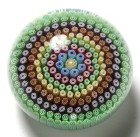 |
| 5701 | Large Terry Crider Four Leaf Clover with
Threading Iridescent Limited Edition Paperweight. dated
1979. Unusual paperweight with a delicate layer of glass
threading over an iridescent blue surface. There is a large
surface decorated four leaf clover at the top. Signed on the
base "Terry Crider 1979 P.I.C.C. 120 / 250". This paperweight
was issued in a limited edition of 250 paperweights of which this is
edition 120. An early example of Terry Crider's work. Note on condition: There are two tiny breaks or interruptions in the threading on the side. I don't know if these are flaws in the making or damage. Some wear on the base. Otherwise in excellent condition, Terry Crider is a self taught glass artist who started a small glass studio, Crider Art Glass, in Wapakoneta, OH in 1976. He worked in glass on and off until at least 2006. He made a variety of different styles of art glass and paperweights. Large Size: 2 7/8" diameter by 2 1/2" high.
The base has been ground flat. For extra pictures, click on the picture at the right and the following links: Large picture$75 postage paid in the US. Added 2/10/2024 For more paperweights by contemporary American paperweight makers, see my Contemporary American Paperweights Web Page. Click on the picture to see a larger image. |
Click
on the picture to see a larger image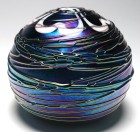 |
| 5562 | Perthshire PP70 Two Color Swirl Crown
Paperweight. circa 1984-1985. This large
crown paperweight features a swirl of sixteen white stringers (rods
of glass) placed over a translucent turquoise ground. There is
a matching millefiori cane to crown the design on top. The
stringers are arranged in groups of four and wrap around to the
base. The paperweight is signed with a complex "P" signature
cane on the base. It also has a label from a Selman
auction. This design was made only in 1984 & 1985. A
nice crisp design with great color. Crown weights are considered by some to be the most exciting of all millefiori designs. They are extremely difficult to make. Note on Selman Auction: The previous owner paid $225
plus a 15% bidders premium for this paperweight at the Selman
Auction 44 (Lot 282). Perthshire was a small company in Crieff, Scotland that was devoted to the creation of quality glass paperweights. They stopped production in January 2002 after more than 30 years of production. Their paperweights were consistently high in quality and yet remained reasonable in price. The birth of Scottish paperweight making is credited to the glass making family of Salvador Ysart, who moved to Crieff, Scotland in 1922. They worked first at John Moncrieff Ltd and made the earliest Scottish paperweights during that period. In 1946 Salvadore and his sons Augustine and Vincent founded Ysart Brothers Glass and produced glass wares under the Vasart label. Salvador Ysart died in 1955 The company name was later changed to Vasart Glass. Stuart Drysdale was hired manage the business side of the enterprise in 1960. The company evolved into a new company Strathearn owned by Teachers Whiskey. In 1967 Drysdale was sent a magazine article on antique paperweights (Woman's Day, July 1965). The inspired him to try to produce weights comparable to the French antiques. With this goal in mind, he and several of the glass workers left Strathearn to found Perthshire in 1968. Large size: 2 13/16" diameter by 1 7/8" high.
The base is ground concave. For extra pictures, click on the picture at the right and the following links: Large picture$185 postage paid in the US. Added 2/3/2024 For more information about Perthshire Paperweights, see my Perthshire Web Page Click on the picture to see a larger image. |
Click
on the picture to see a larger image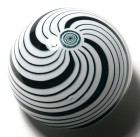 |
| 5703 | Murano Hollow Blown Closepacked Millefiori
Paperweight - with Two Labels. circa 1960 -
1980. Colorful Murano paperweight with a great assortment of
closely packed colorful millefiori canes on the surface of the
paperweight. The paperweight is hollow blown and weighs about
half of what a solid paperweight of this size would weigh. It
has two labels, a generic red and gold foil "MADE IN Murano ITALY"
label with scalloped edges and Koscherak Brothers silver foil label
"AN ORIGINAL CREATION BY KB MADE IN ITALY". The millefiori
canes were probably made by Ercole Moretti or Effetre, but it is
possible a different Murano studio made this paperweight
itself. A beautiful addition to any collection of millefiori
paperweights. The technique used to produce the inner core with millefiori canes on the surface is sometimes called a cane roll-up. The Murano firms of Fratelli Toso and Barovier & Toso produced objects with this technique. The millefiori canes are typical of Ercole Moretti which sold the millefiori and may have been the source of millefiori canes for this paperweight. This paperweight was made on the island of Murano in Venice, Italy. Venetian glass making dates back centuries and the Venetians are given credit for the earliest millefiori canes and paperweights in 1840s. More recently, paperweight making was revived in the 1930s and again in the 1960s. Koscherak Brothers (KB) were importers of Murano glass and Italian pottery from the 1950s until the late 1970s . At the time, they had a showroom at 225 Fifth Avenue, New York, NY. Some writers have observed that most of the Italian Glass imported under the KB Label was made by Fratelli Toso, but others have noted that KB labels appear on other good Italian glass including Barovier & Toso, Seguso, and others. KB is believed to have stopped importing Italian glass about 1977, but continued to exist in New York City until at least 1993. Ercole Moretti was established in 1911 on the initiative of three brothers, with the intention of producing two classic types of Venetian glass beads: the “Rosetta” and the mosaic ‘Millefiori”. The company, now managed by the founders’ grandchildren, has embraced various kinds of processes over the years to expand its product range. However, murrina glass has always been its core business. In their first years in operation, the Morettis focused on production of millefiori beads. In the 1970s they adapted to produce pendants and then launched a variety of products including dishes and ornaments in murrina. The company continues to operate today although there are two separate companies, Ercole Moretti and Effetre (previously called Effetre Moretti). Large size: 3" diameter by 2 1/4" high. The
base is fire finished with a depression in the center. For extra pictures, click on the picture at the right and the following links: Large pictureSOLD. Added 2/2/2024 For more information about Murano paperweights, see my Murano Paperweights Web Page . Click on the picture to see a larger image. |
Click
on the picture to see a larger image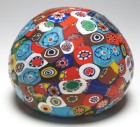 |
| 6030 | Large Pairpoint Faceted Red Rose
Paperweight. circa 1970-1990. This paperweight
features a red rose and eight leaves placed over clear ground.
The rose has fourteen variegated red petals in a 4+4+3+3 crimp
pattern plus two tiny petals in the center. In the typical
Pairpoint style, there are four wide green sepals and four skinny
sepals. It has one top facet. The paperweight is
unsigned but I guarantee that it was made by Pairpoint glass.
A beautiful example of modern Pairpoint production. Pairpoint Glass has a long history extending back to its earliest origins with Mount Washington Glass in 1837. Owners and locations changed a number of times and the name Pairpoint was first used in the 1890s. The original Pairpoint companies were located in New Bedford, Massachusetts. In 1938, it was reorganized as Gunderson Glass Works by owner Robert Gunderson and later renamed the Gunderson - Pairpoint Glass Works in 1952. The name was acquired by Robert Bryden and the company moved briefly to East Wareham, MA in 1957 where it operated as the Pairpoint Glass Company. They leased production facilities in Spain. The last New Bedford factory burned down in 1965. In its latest iteration, Robert Bryden moved Pairpoint to Sagamore, Massachusetts in 1970. It continues to operate at that location today (2024) although under new owners. Size: 3" diameter by just under 2" high. The
base is polished flat. It has one top facet. For extra pictures, click on the picture at the right and the following links: Large picture$135 postage paid in the US. Added 2/1/2024 For more vintage American paperweights, see my Vintage American Paperweights Web Page. Click on the picture to see a larger image. |
Click
on the picture to see a larger image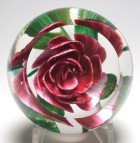 |
| 4344 | William Manson Phoenix Limited Edition FP4
Pink Flower and Millefiori Garland Paperweight. dated
2003. This paperweight features a large pink flower
with a yellow millefiori center and leaves and stems surrounded by a
garland of identical millefiori canes. The design is set on an
almost opaque turquoise ground. This paperweight was issued in
a limited edition of 50 paperweights of which this is number
30. It is signed and numbered "PHOENIX 2003 30/50" on the base
and also has a Phoenix "PP" signature cane near the stem.
Perfect condition with its original certificate and slightly damaged
Phoenix box. A great addition to any collection of Scottish
paperweights. Phoenix Paperweights was a small company started by William Manson Sr. to engage three workers from Perthshire after Perthshire closed in January 2002. They only lasted a year and issued paperweights in 2002 and 2003 before closing in August 2003. Phoenix operated in the Manson works in Perth, Scotland. The glass workers were William Manson Sr., David McNichol (paperweight maker), Duncan Smith (lampworking), and Gordon Taylor (glass cutter). Some of the lampwork was also done by Rosette Fleming. The 2003 Phoenix catalog lists William Manson Paperweights as the distributor. Large size: Just over 2 3/4" diameter by 1 7/8" high. The
base is ground concave. For extra pictures, click on the picture at the right and the following links: Large picture$235 postage paid in the US. Added 1/30/2024 For more information about paperweights made by Scottish makers, see my Scottish Paperweights Web Page Click on the picture to see a larger image. |
Click
on the picture to see a larger image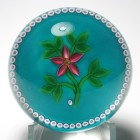 |
| 6043 | Magnum John Deacons Gordon Taylor
Complex Faceted Fuchsia Overlay Paperweight. dated 2018.
This very large faceted overlay paperweight features a
colorful fuchsia flower with leaves and stem placed on a white lace
ground. The flower is detailed and includes short stamens and
long pistils. The design is encased in a dark blue overlay
which is faceted with one large top facet and 72 side facets in six
rows. The faceting was done by Gordon Taylor. It is
signed on the base with a "JHD 2018" signature / date cane and also
has Gordon Taylor's engraved "GT" above the signature cane. A
wonderful paperweight showcasing the artistry of John Deacons and
Gordon Taylor. The birth of Scottish paperweight making is credited to the glass making family of Salvador Ysart, who moved to Crieff, Scotland in 1922. They worked first at John Moncrieff Ltd and made the earliest Scottish paperweights during that period. In 1946 Salvadore and his sons Augustine and Vincent founded Ysart Brothers Glass and produced glass wares under the Vasart label. Salvador Ysart died in 1955 The company name was later changed to Vasart Glass. Strathearn Glass was formed in a reorganization of Vasart glass in 1963. John H. Deacons learned his craft at
Strathearn Glass in Crieff, Scotland in 1967. When
Perthshire was formed in 1968, he left Strathearn to move to
Perthshire and worked there for 10 years before leaving in 1978
to start his own glass studio. He has produced
paperweights and other glass objects under a variety of labels,
including J Glass, St. Kilda, and now under his own name.
Some of the lines were produced simultaneously. J Glass
was produced from 1978 to 1983. The St. Kilda line was
produced from 1978 or 1979 through 1987. You can read
about John Deacons in the book by Hall - Scottish
Paperweights. Today John works at his own studio with his son Craig. Very large size: Just under 3 3/16" diameter by
just over 2 1/2" high. The base is polished concave. It is
faceted with one large top facet and 72 side facets in six rows. For extra pictures, click on the picture at the right and the following links: Large picture$395 postage paid in the US. Added 1/29/2024 For more information about paperweights made by Scottish makers, see my Scottish Paperweights Web Page Click on the picture to see a larger image. |
Click
on the picture to see a larger image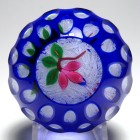 |
| 5699 | Large Antique Millville Umbrella
Paperweight. circa 1860-1912. This style
of old paperweight is associated with Millville, New Jersey.
Examples date from as early as 1860 and continued to be made until
about 1912. Many, if not all, were made at the Whitall Tatum
factory in Millville. The design consists of a white mushroom
shape with a center bubble. Additional colored bits of glass
are added and melted into the top. The top is of the mushroom
is pushed down with a crimp to form an umbrella shape with ribs or
pleats. The design is placed over a white frit ground.
This paperweight has minor flaws including surface scratches and an
abraded area on the side, but displays beautifully. The design
is well executed and displays many of the typical Millville umbrella
characteristics.
The umbrella shaped weights were originally modeled to resemble the wild tiger lily of Southern New Jersey. You can read about umbrella weights from Millville in the book Old Glass Paperweights of Southern New Jersey: An American Folk Art by Clarence A. Newell . It is not possible to identify the exact maker, but John Ruhlander, Emil Stanger, Marcus Kuntz, and Horace Rhubarth, and Ralph Barber are all known to have made weights of this style. Sometimes the style is also used as part of an inkwell or other object. Large Size : Just over 3" diameter by just under 2
3/4" high. The base is ground flat. For extra pictures, click on the picture at the right and the following links: Large picture$95 postage paid in the US. Added 1/27/2024 For more vintage American paperweights, see my Vintage American Paperweights Web Page. (dl-va-ant) Click on the picture to see a larger image. |
Click
on the picture to see a larger image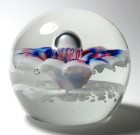 |
| 5650 | Magnum Selkirk 1988 Limited Edition
Abstract Spiral Star Paperweight with Certificate. dated
1988. This paperweight has a serene almost black and white
abstract celestial design representing a spiral star. The
design is set on a very dark (almost black) purple ground. It
is number 102 out of a limited edition of 500 paperweights. It
is signed in script on the base "SELKIRK GLASS SCOTLAND SPIRAL STAR
102/500 1988" and comes with its original certificate. A
fantastic item from Selkirk Glass. Note about reflections: In the picture, the base looks distorted, but it is not. What you are seeing is a reflection. There is no damage. Selkirk Glass founded in 1977 by
Peter Holmes and Ron Hutchinson. Peter apprenticed under
Paul Ysart at Caithness from 1963 and continued at Caithness
until 1977. Ron Hutchinson, a graduate of Edinburgh
University, was also at Caithness. Selkirk produced a wide
range of paperweight styles including abstract, lampwork and
millefiori paperweights. The company was located in
Selkirk, Scotland in the Borders Region. At some point
they were purchased by Edinburgh Crystal and remained in
operation until 2006. Very large size: Just over 3 3/8" diameter by just
over 3 1/8" high. The base is ground concave. Magnum sized,
it weighs 29 ounces. For extra pictures, click on the picture at the right and the following links: Large pictureSOLD. Added 1/24/2024 For more information about paperweights made by Scottish makers, see my Scottish Paperweights Web Page Click on the picture to see a larger image. |
Click
on the picture to see a larger image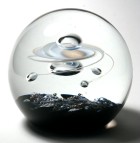 |
| 5698 | Magnum Murano Closepacked Millefiori
Paperweight - probably by Ferro & Lazzarini. circa
1960 - 1980. Colorful Murano paperweight with a great
assortment of closely packed colorful millefiori canes set over a
clear ground. I believe this was made at Ferro &
Lazzarini. A beautiful addition to any collection of
millefiori paperweights.
This paperweight was made on the island of Murano in Venice, Italy. Venetian glass making dates back centuries and the Venetians are given credit for the earliest millefiori canes and paperweights in 1840s. More recently, paperweight making was revived in the 1930s and again in the 1960s. The Ferro Eugenio & Co. glass factory was founded in 1929 on the island of Murano, Venice, Italy by Eugenio Ferro in partnership with Giovanni Lazzarini. After Eugenio died in 1947, the factory was managed by his young heirs. During this time, Giovanni Lazzarini became more involved and the company name was changed to Ferro & Lazzarini SRL. Starting in 2001, the factory has been managed by Dario Ferro, a direct descendant of Eugenio Ferro. Very large Size: Just under 3 7/16" diameter by 2
3/8" high. The base is polished flat. For extra pictures, click on the picture at the right and the following links: Large picture$135 postage paid in the US. Added 1/24/2024 For more information about Murano paperweights, see my Murano Paperweights Web Page . Click on the picture to see a larger image. |
Click
on the picture to see a larger image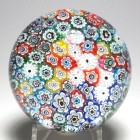 |
| 6025 | Rare Perthshire PP21 Large Millefiori
Swirl Paperweight. circa 1974-1977. This large
swirl weight is especially hard to find. The swirl is made up
of multicolored twist canes which extend outward from the center and
wrap around to the bottom. There is a fancy star cane in the
center. It was made only for four years, from 1974 to
1977. The design is set on a clear ground. The view of
the base shows how the twist canes wrap around to the base. An
interesting early paperweight from Perthshire. Note: There is some confusion in the literature
about the PP21. The PP20 consists of mostly single threads
in a swirl, but this PP21 is a larger paperweight and has twist
canes rather than single threads. The Complete Guide to
Perthshire Paperweights: The Final Years shows a picture of
a 1971 Seaweed Paperweight, but that may have been a prototype
that was produced only in pre-production samples. The birth of Scottish paperweight making is credited to the glass making family of Salvador Ysart, who moved to Crieff, Scotland in 1922. They worked first at John Moncrieff Ltd and made the earliest Scottish paperweights during that period. In 1946 Salvadore and his sons Augustine and Vincent founded Ysart Brothers Glass and produced glass wares under the Vasart label. Salvador Ysart died in 1955 The company name was later changed to Vasart Glass. Stuart Drysdale was hired manage the business side of the enterprise in 1960. The company evolved into a new company Strathearn owned by Teachers Whiskey. In 1967 Drysdale was sent a magazine article on antique paperweights (Woman's Day, July 1965). The inspired him to try to produce weights comparable to the French antiques. With this goal in mind, he and several of the glass workers left Strathearn to found Perthshire in 1968. Large size: 2 11/16" diameter by just under 2"
high. The base is polished slightly concave. For extra pictures, click on the picture at the right and the following links: Large picture$175 postage paid in the US. Added 1/23/2024 For more information about Perthshire Paperweights, see my Perthshire Web Page. Click on the picture to see a larger image. |
Click
on the picture to see a larger image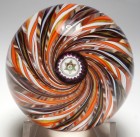 |
| 5697 | Magnum Czech / Bohemian Faceted Red and
Yellow Flowers Paperweight. circa 1880-1939.
Floral paperweight with four red and yellow five petaled
blossoms. There is a planned bubble in the center of each
flower. The flowers are pushed down to a multi-colored frit
ground layer. The glass is heavy glass. This paperweight
is faceted with a large top facet and eight side facets. A
wonderful example. Note on condition: Very good to excellent condition. There are some minor scratches. And one small internal impact mark near the base at the bottom of one facet. Appropriate wear on the base. This style is also called an icepick flower because of the sharp tool used to push each flower down to the base. Von Brackel discusses this style in his book He lists many variations on pages 106 to 149 with a wide range of values up to $300 and more. On pages 278 & 279 he describes the process used to make a trumpet flower paperweight. Very large size: 3 3/8" diameter by 2 5/16"
high. The base is polished flat with a remnant of the pontil
mark. This paperweight is faceted with a large top facet and
eight side facets. For extra pictures, click on the picture at the right and the following links: Large picture$75 postage paid in the US. Added 1/23/2024 For more information about Bohemian paperweights, see my Bohemian Paperweights Web Page . Click on the picture to see a larger image. |
Click
on the picture to see a larger image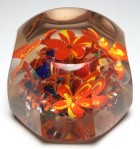 |
| 6042 | John Deacons Closepack Paperweight
with Clichy Style Roses on Lace. circa 2020. This
paperweight features a colorful closepacked assortment of Clichy
style roses. The roses are set on a white lace ground and are
pulled down to the center of the base. It is signed on the
base with a "JD" signature cane and also has a "HANDMADE IN SCOTLAND
by John Deacons" paper label. The birth of Scottish paperweight making is credited to the glass making family of Salvador Ysart, who moved to Crieff, Scotland in 1922. They worked first at John Moncrieff Ltd and made the earliest Scottish paperweights during that period. In 1946 Salvadore and his sons Augustine and Vincent founded Ysart Brothers Glass and produced glass wares under the Vasart label. Salvador Ysart died in 1955 The company name was later changed to Vasart Glass. Strathearn Glass was formed in a reorganization of Vasart glass in 1963. John Deacons learned his craft at
Strathearn Glass in Crieff, Scotland in 1967. When Perthshire
was formed in 1968, he left Strathearn to move to Perthshire and
worked there for 10 years before leaving in 1978 to start his
own glass studio. He has produced paperweights and other glass
objects under a variety of labels, including J Glass, St. Kilda,
and now under his own name. Some of the lines were produced
simultaneously. J Glass was produced from 1978 to
1983. The St. Kilda line was produced from 1978 or 1979
through 1987. You can read about John Deacons in the book
by Hall - Scottish Paperweights. Today John works
at his own studio with
his son Craig. Large size: Just over 2 7/8" diameter by 2 1/8"
high. The base is ground concave. For extra pictures, click on the picture at the right and the following links: Large picture$295 postage paid in the US. Added 1/22/2024 For more information about paperweights made by Scottish makers, see my Scottish Paperweights Web Page Click on the picture to see a larger image. |
Click
on the picture to see a larger image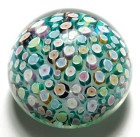 |
| 4246 | St. Louis 1994 "Eclosion" Floral Bouquet
Piedouche Paperweight - Super Magnum Limited
Edition with Box. dated 1994. This extra large
St. Louis pedestal paperweight features a floral bouquet with a
spaced concentric arrangement of lampwork flowers placed on a lush
bed of green leaves. The flowers are blue, red, white, light
blue, green, light yellow (or off white), and pink in the center
along with red, blue, white, and green buds. The paperweight
is mounted on a magnificent double swirl pedestal base with upper
and lower blue and white torsades. Signed with a complex
signature / date cane “SL 1994” in the design and etched with the
edition number “65/150” on the base. This paperweight was made
in a limited edition of 150 paperweights. It comes with its
original (damaged) St. Louis lined box. This is a fantastic
addition to any collection of paperweights. Note on condition of the box: The box has a damaged front edge - a previous owner must have taped it shut. The paperweight itself is in perfect original condition. Cristalleries de Saint Louis was
founded in 1767 in Lorraine, which became part of France in
1766. The region was already home to several
glassworks. Paperweight production started at St. Louis in
1845 and most likely continued until about 1860. Although
the modern production of paperweights started in 1952, the
output of millefiori and lampwork paperweights was small.
Fewer than 400 lampwork and millefiori paperweights were made
between 1952 and 1955. They were not all signed or
dated. The most successful product of this early revival
period was the Queen Elizabeth sulphide which was made to
commemorate her coronation in 1953. After 1955, no
additional weights were made at St. Louis until 1965. In
1965 the factory resumed production of lampwork and millefiori
paperweights and then in 1967 they began a series of sulphide
weights. Finally, in 1970 they started producing annual
limited edition paperweights. Very large size: 4" diameter by 4 1/8" high.
The base of the piedouche is ground concave. The box
measures 5 3/16" by 5 3/16" by 5 1/8" high. The paperweight
weighs 3 pounds 6 ounces. With the box it weighs 4
pounds. For extra pictures, click on the picture at the right and the following links: Large pictureSOLD. US Sales only, no international shipping. Added 1/19/2024 For more information about paperweights made by the St. Louis glass factory in France, see my St. Louis Web Page . Click on the picture to see a larger image. |
Click
on the picture to see a larger image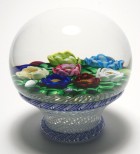 |
| 4199 | Large Antique Baccarat Double Trefoil
Millefiori Paperweight. circa 1845-1860. Colorful
antique Baccarat double trefoil millefiori paperweight with a clear
ground. The trefoils are constructed with blue and white
canes. In the center is a circle of green and white canes with
a orange cane in the very center. I believe this is from the
classic period of paperweight production (1845-1860), but it may
date from a later period. An interesting example. Note on colors: Please ignore the brown colors in some of the pictures. They are reflections from something in my work area. The glass is clear. Baccarat was founded in 1776 in Alsace-Lorraine with the name of Verrerie de Sainte Anne. The original location was near the town of Baccarat. Today the firm is known as Compagnie des Cristalleries de Baccarat. Most collectors refer to three periods of Baccarat paperweight production.
Large size: Just over 2 3/4" diameter by 1 7/8"
high. The bottom is polished concave. Unusually
high dome with the original Baccarat profile. For extra pictures, click on the picture at the right and the following links: Large picture$365 postage paid in the US. Added 1/18/2024 For more information about Antique Paperweights, see my Antique Paperweights Web Page. (dl-ant-bac) Click on the picture to see a larger image. |
Click
on the picture to see a larger image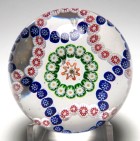 |
| 6049 | Early Chris Buzzini Lundberg Studios
Lampwork Angelfish Paperweight. dated 1980. This
is an early lampwork paperweight made by Chris Buzzini. The
underwater scene includes a brilliant yellow angelfish along with an
anemone, scallop shell, and underwater plants. There is a
trail of bubbles from the angelfish. At the bottom is a hint
of a reef. This is a compound design with the angelfish and
anemone at the top level and the other lampwork below. The
design is placed above a dark green (almost black) ground. It
is signed on the base "Lundberg Studios 1980 Buzzini 42115".
An early paperweight by one of the country's most talented glass
artists. Note: The paperweight was a challenge to photograph. The dark ground gave it a mirror like surface and picked up reflections and exaggerated the inner bubbles. There are also some striations in the glass. Chris Buzzini studied at Shasta Junior College in Redding, CA and California State University at Chico, CA. While at Shasta, Chris was exposed to glassblowing for the first time by Chris Sowder (1970). Buzzini pursued glassblowing, eventually setting up his own “backyard” studio. From 1972 to 1975, Chris worked at Orient & Flume Art Glass in Chico, CA. Later from 1976 to 1978, he operated a glass studio Bridgeton Studio in New Jersey with the backing of a collector and a partner. While at Bridgeton, Chris had two helpers (Allan Ziegler and Fritz Willie) who learned on the job. Chris did the designs. When Ziegler or Willie helped Chris make the paperweight, their name was often included in the signature. Eventually Chris moved back to California and worked at Lundberg Studios (1979-1981) and Correia Art Glass (1982-1986). Since 1986 he has been an independent studio artist. His designs often sell for several thousand dollars. In 1970 James Lundberg founded a small "backyard" studio Nouveau Glass in San Jose, California. He was joined by his brother Steven Lundberg, Daniel Salazar, David Salazar, and several other glass artists. The first paperweights were made in 1972. They were known for their surface decorated designs and torchwork and later for their lampwork. In 1973 the firm was renamed Lundberg Studios and moved to Davenport, California. Chis Buzzini worked at Lundberg Studios from 1979 to 1981. James Lundberg died in a bicycle accident in 1992. Steven Lundberg left Lundberg Studios in 1997 and set up his own studio. He died from ALS in 2008. Although in later years each paperweight produced at Lundberg Studios was signed and dated by the studio and signed by the artist, the earliest paperweights did not have the artists signature Large Size: 2 3/4" diameter by just under 2 1/2"
high. The base is polished flat. For extra pictures, click on the picture at the right and the following links: Large pictureSOLD. Added 1/18/2024 For more paperweights by contemporary American paperweight makers, see my Contemporary American Paperweights Web Page. Click on the picture to see a larger image. |
Click
on the picture to see a larger image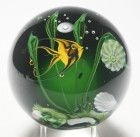 |
| 5666 | Magnum Caithness Colin
Terris Polka - Silver Twist Paperweight.
issued 1981. This wonderful paperweight features
a controlled design of clear bubbles over an almost opaque blue
ground. In the center there is a faint swirl or twist of
bubbles giving it a feeling of motion. This design was created
by Colin Terris and issued in 1981. It was offered in a
variety of colors, this one called Silver Twist. The
paperweight is etched on the base "Caithness POLKA Scotland".
A beautiful design. The POLKA design is listed and designated CT-227 on page 40 of the Charlton Standard Catalog of Caithness Paperweights. It was designed by Colin Terris and released in an unlimited edition in 1981. Several colors and slight variations were offered. The original issue price in the US was $62.50 and the Charlton Catalog lists the 2004 current value as $60. Caithness Glass was founded by Robin Sinclair in Wick in north eastern Scotland in 1961. The factory did not start making paperweights until 1962 when Paul Ysart joined Caithness. Colin Terris joined Caithness in 1968 and started the modern line of paperweights in 1969. A second factory was opened in Oban in 1969 and the Perth factory opened in 1979. In 1980, Caithness purchased the Whitefriars name and designs. More recently Caithness recently went through a number of changes of ownership. After going into receivership in 2004, it was purchased by Edinburgh Crystal, but went into receivership again in 2006. Finally, it was bought out of receivership by Dartington Crystal. The factories in Wick, Oban and Perth all closed and were replaced by a smaller operation and visitors' center in Crieff. Caithness is still operating in Crieff and making paperweights today (in 2022). Very large size: Just under 3 1/4" diameter by 2
15/16" high. The base is polished flat. For extra pictures, click on the picture at the right and the following links: Large pictureSOLD. Added 1/17/2024 For more information about paperweights made by Scottish makers, see my Scottish Paperweights Web Page Click on the picture to see a larger image. |
Click
on the picture to see a larger image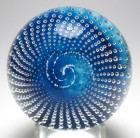 |
| 5645 | Magnum Murano Collie Paperweight - with
label. circa 1960-1980. Wonderful example of
a Murano ceramic decal paperweight with a colored collie
image. The image is created using a ceramic decal or transfer
applied to a translucent light blue ground and then encased in clear
glass. When heated the transfer burns off leaving just the
image. It is signed with a generic Murano red and silver
circular foil label "MADE IN Murano ITALY". The exact factory
is unknown to me, but I guarantee this is an authentic Murano
product. This paperweight was made on the island of Murano in Venice, Italy. Venetian glass making dates back centuries and the Venetians are given credit for the earliest millefiori canes and paperweights in 1840s. More recently, paperweight making was revived in the 1930s and again in the 1960s. Very large size: Just over 3 3/8" diameter by just
under 2 3/16" high. The base is polished flat. For extra pictures, click on the picture at the right and the following links: Large pictureSOLD. Added 1/17/2024 For more information about Murano paperweights, see my Murano Paperweights Web Page . Click on the picture to see a larger image. |
Click
on the picture to see a larger image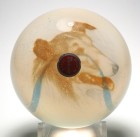 |
| 5696 | Gentile Glass Spaced Millefiori on Lace
Paperweight. signed with the pontil stamp
used in 1979. This paperweight features a concentric
millefiori pattern on a lace ground. There are six Murano made
millefiori canes arranged in a circle around a center cane.
The design is placed on a bed of twist canes and colored
strands. Under this lace ground is a multi-colored frit
ground. Gentile obtained their millefiori canes from a
distributor of Murano millefiori canes. The paperweight is
signed on the base with the hot pontil stamp used in 1979 which says
"GENTILE GLASS W. VA." and has a star with a "C" in the center for
Star City, West Virginia. A fun item.
The original glass worker in the Gentile family was Peter Gentile, born in Naples, Italy in 1884. He worked in Naples(Italy), Rochester (Pennsylvania), and Morgantown (West Virginia) before building his own factory in Star City (West Virginia) in 1947. His sons, Frankie, John and Joe Gentile helped him make paperweights in the off hours at the Guild Factory in Morgantown. However, most paperweight production since WWII has been associated with Peter, John, or John's wife Gertrude Gentile. Few weights were signed prior to1963. It is believed that Gentile Glass remained in production until 2006. Most, if not all, paperweights produced from 1975 on were signed. For more information, you can read about the Gentiles in the book American Glass Paperweights and Their Makers by Jean Melvin (1967 and 1970). Size: 2 11/16" diameter by 2 7/16" high. The
base is fire finished with the pontil stamp signature in the
center. For extra pictures, click on the picture at the right and the following links: Large picture$49 postage paid in the US. Added 1/16/2024 For more information about Gentile paperweights, see my Gentile Paperweights Web Page. Click on the picture to see a larger image. |
Click
on the picture to see a larger image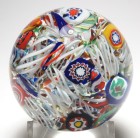 |
| 5569 | Large Perthshire PP58 Faceted Paneled
Millefiori Paperweight. circa 1997-2002. A
large patterned millefiori paperweight with 10 sections of floral
millefiori canes over an opaque blue ground. The central
design consists of two rings around a central signature cane.
This paperweight dates from 1997 or later when Perthshire changed
the PP58 pattern to have more than just a top facet. Each
paneled section has a 1-1-2-3 pattern of millefiori canes and is
bordered by multi-colored twists. The paneled sections are
surrounded by an outer ring of twists and then an outer ring of
canes. It is signed in the center with Perthshire's "P'
signature cane and also has a paper label "PERTHSHIRE PAPERWEIGHTS
CRIEFF SCOTLAND". It is faceted with a top facet and five side
facets. A stunning paperweight with great color.
Perthshire was a small company in Crieff, Scotland that was devoted to the creation of quality glass paperweights. They stopped production in January 2002 after more than 30 years of production. Their paperweights were consistently high in quality and yet remained reasonable in price. There are three books on Perthshire Paperweights. If you collect Perthshire paperweights, you should have them in your library. The birth of Scottish paperweight making is credited to the glass making family of Salvador Ysart, who moved to Crieff, Scotland in 1922. They worked first at John Moncrieff Ltd and made the earliest Scottish paperweights during that period. In 1946 Salvadore and his sons Augustine and Vincent founded Ysart Brothers Glass and produced glass wares under the Vasart label. Salvador Ysart died in 1955 The company name was later changed to Vasart Glass. Stuart Drysdale was hired manage the business side of the enterprise in 1960. The company evolved into a new company Strathearn owned by Teachers Whiskey. In 1967 Drysdale was sent a magazine article on antique paperweights (Woman's Day, July 1965). The inspired him to try to produce weights comparable to the French antiques. With this goal in mind, he and several of the glass workers left Strathearn to found Perthshire in 1968. Large size: 3" in diameter by 1 7/8" high. The
base is ground concave. It is faceted with a top facet and
five side facets. For extra pictures, click on the picture at the right and the following links: Large pictureSOLD. Added 1/16/2024 For more information about Perthshire Paperweights, see my Perthshire Web Page. Click on the picture to see a larger image. |
Click
on the picture to see a larger image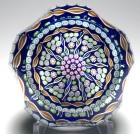 |
| 6056 | Ken Rosenfeld 1987 Vegetables Bouquet
Paperweight. dated 1987. This paperweight
consists of vegetable bouquet of radishes, carrots, asparagus
spears, and turnips (or beets). There are seven red radishes
with leafy tops, six tapered orange carrots, three asparagus spears
and two purple turnips. The design is placed on a clear
ground. It is signed on the side with Ken Rosenfeld's "R" cane
and engraved signature "KEN ROSENFELD '87". It is a
beautiful paperweight with its unusual composition of
vegetables. An early paperweight from Ken Rosenfeld. Note: This paperweight has a relatively flat profile. The low profile allows Ken to fill the paperweight with details and avoid optical distortion, but it also made it difficult eliminate all the glare from the lights when taking pictures. Ken Rosenfeld works at his own studio, Ken Rosenfeld Glass, in Milwaukie, Oregon. Ken's paperweight expertise arose from a formal art education and a technical background. He has a Bachelor's degree in art from the University of California and a Master's of Fine Arts degree from Southern Illinois University. His technical experience in scientific glasswork and his studio glass experience contributed to his superb ability as a glass artist. Ken has been a paperweight artist since the mid 1980s. He started at Correia Glass, leaving after five years to set up his own studio in 1983. This 1987 vegetable bouquet is an early paperweight made by Ken. Large size: Just under 3" diameter by just
over 1 1/2" high. It has a low, relatively flat profile
which allowed Ken to fill the paperweight with vegetables and
avoid optical distortion. The base is polished
concave. For extra pictures, click on the picture at the right and the following links: Large picture$365 postage paid in the US. Added 1/15/2024 For more paperweights by contemporary American paperweight makers, see my Contemporary American Paperweights Web Page. Click on the picture to see a larger image. |
Click
on the picture to see a larger image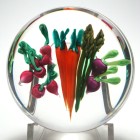 |
| 5992 | Vintage Pairpoint Concentric Millefiori
Sampler Paperweight. circa 1970s. This is a
wonderful spaced millefiori paperweight with twelve different pieces
of glass placed on a two layer turquoise ground. Included are
three complex millefiori canes, a Clichy style rose, Clichy style
pastry mold cane, a miniature cameo, two twist canes, three large
shards, and a bit of something else. The millefiori canes are
especially nice. The ground has a translucent layer above an
opaque layer, which makes the canes look like they stand proud above
the ground but when viewed from the side it is clear that the top of
the canes are actually level with the top of the translucent
layer. It is faceted with a top facet and five side
facets. The facets are concave. I believe this
paperweight dates from the early 1970s when William Burchfield was
still at Pairpoint. The paperweight is signed on the base with
an engraved "P" inside a diamond. This is an interesting
addition to any collection of millefiori paperweights. Note: According to glass artist Jim Poore, the glass fragments in this paperweight are from Pairpoint's attempts to replicate Mount Washington Glass Company "Lava" glass from the 1880s. We don't know why they ended up in this paperweight. Maybe it was an experiment to test the compatibility of the glass or a training piece or just a curiosity? I call it a millefiori sampler. Pairpoint Glass has a long history extending back to its earliest origins with Mount Washington Glass in 1837. Owners and locations changed a number of times and the name Pairpoint was first used in the 1890s. The original Pairpoint companies were located in New Bedford, Massachusetts. In 1938, it was reorganized as Gunderson Glass Works by owner Robert Gunderson and later renamed the Gunderson - Pairpoint Glass Works in 1952. The name was acquired by Robert Bryden and the company moved briefly to East Wareham, MA in 1957 where it operated as the Pairpoint Glass Company. They leased production facilities in Spain. The last New Bedford factory burned down in 1965. In its latest iteration, Robert Bryden moved Pairpoint to Sagamore, Massachusetts in 1970. It continues to operate at that location today, with new owners in 2015. William Clark Burchfield started making paperweights at Pairpoint Glass in Sagamore, Massachusetts
in 1970. He left in
1976 to form the Cape Cod Glass Works (also in Sagamore) which
continued in operation until 2000. It then continued
briefly in Crossville, Tennessee until 2001. Bill
Burchfield died in 2012. Bill's son Mark was also at the
Cape Cod Glass Works until 1998. Size: 2 9/16" diameter by 1 11/16" high. The
base is polished flat with remnants of the pontil scar. Some
rough areas on the base. It is faceted with a top facet and
five side facets. The facets are concave. For extra pictures, click on the picture at the right and the following links: Large picture$125 postage paid in the US. Added 1/15/2024 For more vintage American paperweights, see my Vintage American Paperweights Web Page. Click on the picture to see a larger image. |
Click
on the picture to see a larger image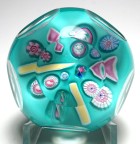 |
| 5990 | Large Fratelli Toso Murano Red White and
Blue Concentric Paperweight - with label. circa
1960-1970. Wonderful example of a Murano close packed
concentric millefiori paperweight. The design is simple, with
two rings of large red, white, and blue cog canes with clear
centers. The outer ring consists of twelve blue and white
canes. The inner ring consists of six red and white
canes. And there is a blue and white cane in the center.
This paperweight was made by Fratelli Toso and has a worn Fratelli
Toso silver foil label with a conjoined "ft" and "MADE IN ITALY
MURANO GLASS". A fun paperweight with great colors. Note on condition: This paperweight has a slight dimple on top along with a faint 1" scratch on top (see picture). And a rough area next to the base (see another picture). I also found a tiny nick on the side which I couldn't capture in a picture. This paperweight was made on the island of Murano in Venice, Italy. Venetian glass making dates back centuries and the Venetians are given credit for the earliest millefiori canes and paperweights in 1840s. More recently, paperweight making was revived in the 1930s and again in the 1960s. Fratelli Toso was started in 1854 by six brothers - Angelo Toso, Giovanni Toso, Ferdinando Toso, Carlo Toso, Gregorio Toso and Liberato Toso. They were joined by Ermanno Toso in 1924 who became artistic director. The Fratelli Toso company is well known for its use of colorful murrines and millefiori, particularly during the 1950's and earlier. In 1979, the company suffered a harsh economic crisis, forcing the owners to divide it into Antica Vetreria Fratelli Toso and Fratelli Toso International. In 1981, Fratelli Toso International filed for bankruptcy and closed its doors for good. Antica Vetreria Fratelli Toso, led by Arnoldo Toso, continued to operate. Large size: 3 1/8" diameter by just under 2
11/16" high. The base is polished flat. For extra pictures, click on the picture at the right and the following links: Large pictureSOLD. Added 1/8/2024 For more information about Murano paperweights, see my Murano Paperweights Web Page . Click on the picture to see a larger image. |
Click
on the picture to see a larger image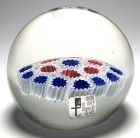 |
| 5644 | Large Colorful Murano Millefiori
Paperweight with Seven Large Flower Canes - Probably
Seguso. circa 1960-1980. Colorful millefiori
paperweight with a closepacked design consisting of seven identical
large flower canes. Each flower cane is outlined in
blue. The design is set on a clear ground. Unsigned, but
I believe this was made by Seguso. An interesting design. There exist examples of this paperweight design with labels from the Archimede Seguso company in Murano "ARCHIMEDE SEGUSO MURANO MADE IN ITALY" and also from their showroom in Milan - "SEGUSO C. SORDA VITTORIA, 40, TEL. 799648, MILANO". This example does not have a label. This paperweight was made on the island of
Murano in Venice, Italy. Venetian glass making
dates back centuries and the Venetians are given credit for the
earliest millefiori canes and paperweights in 1840s. More
recently, paperweight making was revived in the 1930s and again
in the 1960s. Archimede Seguso (1909-1999) was an Italian glass artist known for his intricate glass vases, necklaces, and sculptures. Spanning a wide range of forms and colors, his subject matter included animals and abstract shapes. He was part of an illustrious legacy of Italian glassmakers, their ancestry spanning over six centuries to the 14th century. Seguso notably led a revival of ancient Venetian glass-making techniques, specifically filigrana, which produced lattice-like patterns. Seguso ran the family business Seguso Vetri d'Arte, from 1937 to 1942. After 1942 he devoted his time to research and innovation and continued to produce many artistic breakthroughs. The Seguso company continues to produce glass today. Seguso works are included in many private and museum collections. Large size: 2 15/16" diameter by 1 7/8" high. The
base is polished flat. For extra pictures, click on the picture at the right and the following links: Large picture$89 postage paid in the US. Added 1/7/2024 For more information about Murano paperweights, see my Murano Paperweights Web Page . Click on the picture to see a larger image. |
Click
on the picture to see a larger image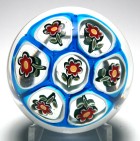 |
| 6072 | Modern Baccarat Macédoine Millefiori
Paperweight. circa 1957-1970s. This
paperweight is made up of multi-colored striped millefiori segments
arranged at (mostly) right angles. This is a contemporary
paperweight made for only a short time. It is acid etched with
the Baccarat signature on the base. This is a great example of
a unique Baccarat design.
The Macédoine is a uniquely Baccarat style in which the short sections of latticinio (twists, filigree, lace) are arranged in a quilt-like pattern with many of the sections at right angles to each other. This pattern was originally made during the classic period of French paperweights (1845-1860). The modern version was produced in the 1950s - 1970s and is similar to yet different from the antique version. Baccarat was founded in 1776 in Alsace-Lorraine with the name of Verrerie de Sainte Anne. The original location was near the town of Baccarat. Today the firm is known as Compagnie des Cristalleries de Baccarat. In 1952, Paul Jokelson approached Baccarat with the idea of making sulphide paperweights again. In 1953 Baccarat resumed paperweight production with a series of sulphide paperweights the first of which were the unsuccessful Eisenhower sulphide followed by the Queen Elizabeth coronation sulphide. Millefiori paperweight production was resumed in 1957 and lampwork paperweights were re-introduced in the early 1970s. Baccarat stopped making this type of fine glass paperweights in 2002. You can read more about the Baccarat paperweights in his book Baccarat Paperweights - two centuries of beauty by Paul Dunlop or one of the older books on paperweights in general, such as The Encyclopedia of Glass Paperweights by Paul Hollister or World Paperweights by Robert Hall.
Large size: 2 7/8" diameter by just over 2 1/8"
high. The base is polished flat. For extra pictures, click on the picture at the right and the following links: Large picture$245 postage paid in the US. Added 1/7/2024 For more information about Baccarat paperweights, see my Baccarat Paperweights Web Page Click on the picture to see a larger image. |
Click
on the picture to see a larger image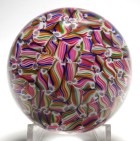 |
| 6045 | John Deacons Magnum Garlanded Pansy
Paperweight with Clichy Style Millefiori Rose Canes. circa
2020. This paperweight features a delightful five
petal red and orange pansy and bud with dark green sepals, stem, and
leaves surrounded by an alternating garland of thirteen yellow and
white Clichy style roses and thirteen dark blue twist
segments. The leaves and sepals have aventurine added giving
them a glittery appearance. The pansy consists of two large
deep red petals above over three orange and black lower petals. Each
lower petal has a pink tip with three dark black lines radiating
from center to the tip. The design is set on a translucent
dark purple ground. The flower is two dimensional and lies
even with the ground. It is signed on the base with a "JD"
signature cane and also has a "HANDMADE IN SCOTLAND by John Deacons"
paper label. A creative composition with an unusual choice of
colors. This is one of the paperweights John Deacons features
on his website. Note: This was a challenging paperweight to photograph with its dark colors and high dome. The birth of Scottish paperweight making is credited to the glass making family of Salvador Ysart, who moved to Crieff, Scotland in 1922. They worked first at John Moncrieff Ltd and made the earliest Scottish paperweights during that period. In 1946 Salvadore and his sons Augustine and Vincent founded Ysart Brothers Glass and produced glass wares under the Vasart label. Salvador Ysart died in 1955 The company name was later changed to Vasart Glass. Strathearn Glass was formed in a reorganization of Vasart glass in 1963. John Deacons learned his craft at
Strathearn Glass in Crieff, Scotland in 1967. When Perthshire
was formed in 1968, he left Strathearn to move to Perthshire and
worked there for 10 years before leaving in 1978 to start his
own glass studio. He has produced paperweights and other glass
objects under a variety of labels, including J Glass, St. Kilda,
and now under his own name. Some of the lines were produced
simultaneously. J Glass was produced from 1978 to
1983. The St. Kilda line was produced from 1978 or 1979
through 1987. You can read about John Deacons in the book
by Hall - Scottish Paperweights. Today John works
at his own studio with
his son Craig. Very large size: Just over 3 3/16" diameter by 2
7/16" high. The base is ground concave. For extra pictures, click on the picture at the right and the following links: Large picture$275 postage paid in the US. Added 1/4/2024 For more information about paperweights made by Scottish makers, see my Scottish Paperweights Web Page Click on the picture to see a larger image. |
Click
on the picture to see a larger image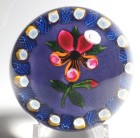 |
| 5546 | Perthshire Annual Collection 2000A Limited
Edition Bouquet in Basket Paperweight.
circa 2000. This paperweight features a bouquet of two amber
flowers, two pink buds, and green leaves inside a pristine double
basket of millefiori canes. The inner basket consists of dark
blue millefiori canes. The outer basket consists of
alternating pink and green millefiori canes. The paperweight
is faceted with a large top facet and five side facets. It is
signed with an engraved "P" and the edition number "144" in the
center of the base. It also has its original Perthshire paper
label "PERTHSHIRE PAPERWEIGHTS CRIEFF SCOTLAND" on the base and a
second label from a Selman auction. This design was made in a
limited edition of 250 paperweights only in 2000. A nice crisp
design with great color.
Note on Selman Auction: The previous owner paid $450 for this paperweight at the Selman Auction 44 (Lot 277). Perthshire made this paperweight as one of their Annual Collection designs for 2000. This means the design was made only that one year and never again. There were eight Annual Collection designs in 2000, designated A through G plus a Special Limited Edition which had no letter designation. This design is designated 2000A. The annual collection paperweights are the most desirable of the Perthshire line, with the exception of one of one items. Perthshire was a small company in Crieff, Scotland that was devoted to the creation of quality glass paperweights. They stopped production in January 2002 after more than 30 years of production. Their paperweights were consistently high in quality and yet remained reasonable in price. The birth of Scottish paperweight making is credited to the glass making family of Salvador Ysart, who moved to Crieff, Scotland in 1922. They worked first at John Moncrieff Ltd and made the earliest Scottish paperweights during that period. In 1946 Salvadore and his sons Augustine and Vincent founded Ysart Brothers Glass and produced glass wares under the Vasart label. Salvador Ysart died in 1955 The company name was later changed to Vasart Glass. Stuart Drysdale was hired manage the business side of the enterprise in 1960. The company evolved into a new company Strathearn owned by Teachers Whiskey. In 1967 Drysdale was sent a magazine article on antique paperweights (Woman's Day, July 1965). The inspired him to try to produce weights comparable to the French antiques. With this goal in mind, he and several of the glass workers left Strathearn to found Perthshire in 1968. Size: Just under 2 1/2" diameter by just over 1 1/2"
high. The base is fire finished and engraved with the letter
"P" and the edition number "144". The paperweight is faceted
with one large top facet and five side facets. For extra pictures, click on the picture at the right and the following links: Large pictureSOLD. Added 1/3/2024 For more information about Perthshire Paperweights, see my Perthshire Web Page. Click on the picture to see a larger image. |
Click
on the picture to see a larger image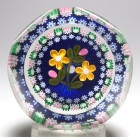 |
| 6033 | Magnum Bob St. Clair Sulphide Dog
Paperweight. circa 1971- 1986. A wonderful
example of a St. Clair dog sulphide paperweight. The
painted brown dog sulphide is placed on a layer of large
shards of colored glass. The signature "BOB ST. CLAIR" is hot
stamped on the base. A colorful addition to any collection of
St. Clair paperweights. Sulphides Paperweights are those that contain cast objects (animals, flowers, people) made of a ceramic material that has properties similar to the surrounding glass. They are normally white, but are also sometimes colored or even painted. The objects are cast in a mold that copied or made directly from a medallion, coin or sculpture. Often the object is surrounded by a millefiori or lampwork garland, but it may also appear alone. The finest sulphides are cast in a mold made by a skilled artist. The St. Clair line (as far as paperweights are concerned) started with John "Pop" St. Clair, Sr. who worked at the George MacBeth Glass Works in Elwood from around 1903 to 1938. Local natural gas production faltered in 1938 and the St. Clairs began to develop their ideas for a new business of their own. Joe did the original experimentation and the business was formally started in 1941 in Elwood, Indiana. John, Sr. and the brothers John, Jr., Joe, Ed and Bob all participated, while another brother, Paul, did not at first. By 1944 St. Clair paperweights were being sold through Georg Jensen on Fifth Avenue in New York. Joe retired for the first time) in 1971 and sold the factory to new owners in Elwood, Indiana. About the same time, Robert St. Clair (1919 - 1986) and his wife Maude opened a new factory in Elwood. Paul St. Clair retired from General Motors and joined Bob, along with Ed St. Clair and a nephew, Joe Rice. Sometime later after Bob opened his factory, the new owners of the original factory sold the factory back to Joe. So, for a while, there were two St. Clair Glass factories. Bob St. Clair died in 1986 and Joe Rice bought his estate including Bob's factory. Joe St. Clair died in 1987. Very large size: 3 3/8" diameter by 3 1/4"
high. The base is ground flat. It weighs just over 29
ounces. For extra pictures, click on the picture at the right and the following links: Large pictureSOLD. Added 1/3/2024 For more information about paperweights made by the St. Clair factory, see my St. Clair Paperweights Web Page Click on the picture to see a larger image. |
Click
on the picture to see a larger image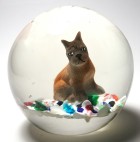 |
| 5498 | Peter McDougall (PMcD) Concentric
Millefiori on White Lace Paperweight Cabinet Knob. circa
2008-2012. Wonderful Peter McDougall cabinet knob with
a miniature millefiori paperweight as the handle. The
paperweight is a two ring concentric design with complex millefiori
canes on a white lace or upset muslin ground. There are
fifteen complex canes, all of which appear to be different, plus the
signature cane. It is signed with a "PMcD" complex signature
cane in the outer ring. The knob is mounted on a brass fitting
and comes with a brass backing plate and mounting screw.
Mounting this knob will require a 3/16" hole in your cabinet.
This is an especially nice cabinet knob. Note on Availability: I currently have twelve knobs available. You may order one or multiple knobs. Each knob appears to have the same canes with the same blue cane in the center, but the order of the other canes may be different. These knobs are used. When I inspected them, I did not find any damage but will reinspect prior to your purchase. The brass hardware shows some minor wear. Peter McDougall started his glassmaking career as an apprentice at Strathearn Glass in Crieff, Scotland back in the 1960s. When Perthshire was formed in 1968, he left Strathearn to move to Perthshire and worked there in many positions, eventually becoming Manager and Chief Glassmaker. Perthshire Paperweights closed early in 2002 after the death of the owner Neil Drysdale. Peter McDougall then made high quality glass paperweights at his own glass studio, PMcD Glass Studio Ltd. in Crieff, Scotland from 2002 until early 2012. The studio is now closed but Peter plans to continue to make a limited number of paperweights in the future. Size: 1 3/4" diameter by 2 3/16" long including
backing plate but not the screw. The brass backing plate has
a diameter of 1 3/8". For extra pictures, click on the picture at the right and the following links: Large pictureALL 12 SOLD. Added 1/2/2024 For more information about paperweights made by Peter McDougall, see my Peter McDougall Web Page. Click on the picture to see a larger image. |
Click
on the picture to see a larger image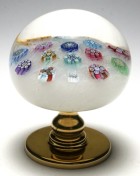 |
| 6063 | Perthshire PP46 Heart Pattern Closepack
Millefiori Paperweight. circa 1981-1995. This
Perthshire millefiori paperweight has a closepack design in the
shape of a heart in the center with a heart shaped border of
identical blue and white canes. The design is set on a
translucent ruby red ground with a garland of green and white canes
on the outside. It is signed on the base with Perthshire's
complex "P" signature cane. It also has its original very worn
Perthshire paper label "PERTHSHIRE PAPERWEIGHTS CRIEFF SCOTLAND" on
the base. The paperweight has one large top facet. Every
collector should have one of these. The PP46 was made with a heart design from 1981 to 1999. It was also made as a Spade (1981-1985), Diamond (1981-86), and Club (1981-85). Although the heart was made until 1999, this version was produced until 1995 and then the design was changed for 1996 and again for 1997-1999. Perthshire was a small company in Crieff, Scotland that was devoted to the creation of quality glass paperweights. They stopped production in January 2002 after more than 30 years of production. Their paperweights were consistently high in quality and yet remained reasonable in price. The birth of Scottish paperweight making is credited to the glass making family of Salvador Ysart, who moved to Crieff, Scotland in 1922. They worked first at John Moncrieff Ltd and made the earliest Scottish paperweights during that period. In 1946 Salvadore and his sons Augustine and Vincent founded Ysart Brothers Glass and produced glass wares under the Vasart label. Salvador Ysart died in 1955 The company name was later changed to Vasart Glass. Stuart Drysdale was hired manage the business side of the enterprise in 1960. The company evolved into a new company Strathearn owned by Teachers Whiskey. In 1967 Drysdale was sent a magazine article on antique paperweights (Woman's Day, July 1965). The inspired him to try to produce weights comparable to the French antiques. With this goal in mind, he and several of the glass workers left Strathearn to found Perthshire in 1968. Size: 2 5/8" diameter by 1 11/16" high. The base is
ground concave. There is one large top facet. For extra pictures, click on the picture at the right and the following links: Large pictureSOLD. Added 1/1/2024 For more information about Perthshire Paperweights, see my Perthshire Web Page. Click on the picture to see a larger image. |
Click
on the picture to see a larger image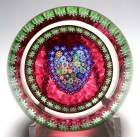 |
| 6024 | Early Rick Ayotte 1986 Miniature
Swainson's Thrush with Blue Flax Flowers and Foliage
Paperweight. dated 1986. This miniature
paperweight depicts a Swainson's thrush singing on a branch of a
common flax plant. There are five light blue flax flowers with
eight dark green leaves and foliage. This is an early
paperweight by Rick Ayotte and is signed "Ayotte M-5 '86" on
the side just below the middle of the paperweight. A precious
paperweight in excellent condition. This paperweight appears in the book Songs without Words: The Art of the Paperweight - Rick Ayotte. This weight is a miniature and is shown on page 144. The full size paperweight is shown on page 74 and is catalog number A131. A similar miniature Swainson's Thrush miniature paperweight sold for $720 ($600 plus the 20% buyers premium) in the Winter 2021 LH Selman auction (Auction 77). That one (in the Selman auction) was a variation with two blue flowers instead of five as in this paperweight. The paperweight in this listing is being offered at a lower price. As is typical of some of Rick's early weights, this paperweight has a relatively flat profile. The low profile allows Rick to fill the weight with details and avoid optical distortion, but it also made it difficult eliminate all the glare from the lights when taking pictures. Roland "Rick" Ayotte specializes in paperweights with themes from nature, including lampworked bird and other animals, flowers, fruits, and berries. His paperweights range in size from miniatures to super magnums. He also produces other wonderful glass art objects. He lives and works in New Boston, New Hampshire and has been making glass paperweights since 1978. Miniature size: Just over 1 7/8" diameter by just
over 1 1/8” high. The base is been polished concave. For extra pictures, click on the picture at the right and the following links: Large pictureSOLD. Added 1/1/2024 For more paperweights by contemporary American paperweight makers, see my Contemporary American Paperweights Web Page. Click on the picture to see a larger image. |
Click
on the picture to see a larger image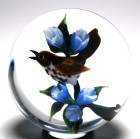 |
| 885 | Antique Abraham Lincoln Pressed Glass
Intaglio Paperweight. circa 1883 and later. This
pressed glass paperweight features a frosted profile of Lincoln with
very good detail. It has a curved top and flat base. The
image is intaglio or incised from the base and is finished with an
acid etching (frosted finish). There is a slight red tint to
the glass. The maker has been identified by various sources as
Libbey or Gillinder. It is possible first introduced as a
souvenir paperweight offered at the 1893 Columbian Exposition in
Chicago. Please see the note below about a chip on the base
and review the pictures.
Note on condition: This paperweight has a 3/8"
shallow chip on a corner of the back side as shown in the
pictures. It displays well in spite of the damage and could
be restored if desired. Size: Just under 4 1/2" tall by just under 3" wide
by 7/8" thick. For extra pictures, click on the picture at the right and the following links: Large picture$39 postage paid in the US. Added 12/19/2023 For more information about Antique Paperweights, see my Antique
Paperweights
Web Page. Click on the picture to see a larger image. |
Click
on the picture to see a larger image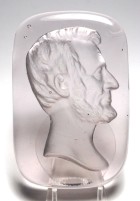 |
| 2100 | Large Antique New England Glass Company
(NEGC) Blue Double Poinsettia Paperweight on a Double Swirl
Latticinio Ground. circa 1860 - 1888. This is an
antique New England Glass Company (NEGC) double poinsettia with a
two rings of five dark blue petals arranged around an interesting
complex millefiori center. There are also three well formed
NEGC leaves and a stem. Well placed bubbles give the
appearance of dew drops on the flower and the leaves. The
design is placed over a double swirl latticinio ground. As is
typical of NEGC poinsettias, the flower is placed leaning off to the
left. This paperweight will be a worthwhile addition to
any collection of antique American paperweights offered at a bargain
price. Note on condition: Good to very good condition. There are some minor scratches on the body and considerable wear on the base. There is also a pontil scar on the base. No chips or impact marks. The center millefiori cane lacks proper coloration. The New England Glass Company (NEGC) operated in Cambridge, Massachusetts from 1818 to 1888. You can read about paperweights from the New England Glass Company in the book by John Hawley. The Art of the Paperweight - The Boston & Sandwich and New England Glass Companies covers both B&S and NEGC.
Large size: Just under 2 3/4" diameter by 2"
high. The base is ground concave. It has a relatively
high profile. For extra pictures, click on the picture at the right and the following links: Large pictureSOLD. Added 12/17/2023 For more information about Antique Paperweights, see my Antique Paperweights Web Page. Click on the picture to see a larger image. |
Click
on the picture to see a larger image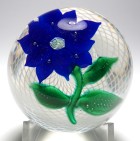 |
| 5192 | Large Antique Clichy Cinquefoil Millefiori
Paperweight - with damage. circa 1845-1860. This
antique Clichy millefiori paperweight features a classic cinquefoil
garland with five loops of identical turquoise canes. There
are six other large canes in the design, including a large pink and
green Clichy rose and a great pink pastry cane. There is a
large facet on top. Please read my comments below about the
description. This is an opportunity to own a large Clichy
paperweight for a bargain price. Note on condition: Fair condition. There are scratches, one noticeable chip on the base, and at least four circular impact marks on this paperweight. Someone without the correct skills must have attempted to restore this paperweight. It has an unusual shape. The sides are not smoothly rounded and come together in an angle. There is plenty of glass and a skilled restorer might be able to remove the damage and improve the shape. Clichy paperweights are highly sought after by collectors for their complex canes and brilliant colors. Clichy paperweights with rose canes are especially desirable. The Clichy factory was founded at Billancourt near Paris in 1837. Shortly after that it moved to Clichy-la-Garenne, which gave the factory its best known name. They stayed in operation until about the 1870s. Large size: 3 3/16" diameter by 1 3/4" high.
The base is ground concave. There is a large facet on top. For extra pictures, click on the picture at the right and the following links: Large pictureSOLD. Added 11/27/2023 For more information about Antique Paperweights, see my Antique Paperweights Web Page. Click on the picture to see a larger image. |
Click
on the picture to see a larger image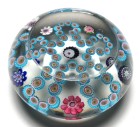 |
| 5573 | Large Perthshire PP1 Paneled Millefiori
Paperweight with Blue Ground. circa 1982-2002.
A large patterned millefiori paperweight with 10 sections of
floral millefiori canes over a translucent blue ground. The
central design consists of two rings around a central signature
cane. This paperweight dates from 1982 or later when
Perthshire changed the PP1 pattern to have 10 sections, each with a
1-1-2-3 pattern of canes. The paneled sections are surrounded
by an outer ring of twists and then an outer ring of canes. It
is signed in the center with Perthshire's "P' signature cane.
A stunning paperweight with great color and crisp execution.
Perthshire was a small company in Crieff, Scotland that was devoted to the creation of quality glass paperweights. They stopped production in January 2002 after more than 30 years of production. Their paperweights were consistently high in quality and yet remained reasonable in price. There are three books on Perthshire Paperweights. If you collect Perthshire paperweights, you should have them in your library. The birth of Scottish paperweight making is credited to the glass making family of Salvador Ysart, who moved to Crieff, Scotland in 1922. They worked first at John Moncrieff Ltd and made the earliest Scottish paperweights during that period. In 1946 Salvadore and his sons Augustine and Vincent founded Ysart Brothers Glass and produced glass wares under the Vasart label. Salvador Ysart died in 1955 The company name was later changed to Vasart Glass. Stuart Drysdale was hired manage the business side of the enterprise in 1960. The company evolved into a new company Strathearn owned by Teachers Whiskey. In 1967 Drysdale was sent a magazine article on antique paperweights (Woman's Day, July 1965). The inspired him to try to produce weights comparable to the French antiques. With this goal in mind, he and several of the glass workers left Strathearn to found Perthshire in 1968. Large size: Just over 3" in diameter by just over 2
1/8" high. The base is ground concave. For extra pictures, click on the picture at the right and the following links: Large picture$195 postage paid in the US. Added 11/11/2023 For more information about Perthshire Paperweights, see my Perthshire Web Page. Click on the picture to see a larger image. |
Click
on the picture to see a larger image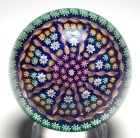 |
| 3165 | Magnum Vandermark Doug Merritt Stephen
Smarr Limited Edition Footed Floral Vase. circa
1980-2000. This very large footed vase has a floral design
with three red and three blue flowers, many buds, and stems.
The buds are depicted by large millefiori sections with red
centers. The design is three dimensional with the flowers,
buds, and stems placed on a separate layer above green and white
vines. Underneath the vines is a rich silver and blue
background. The vase was made by Doug Merritt and Stephen
Smarr in a limited edition of 750 vases of which this is edition
number 13. The foot is clear and is signed in the center
"Vandermark SBOSB #013/750 Doug Merritt Stephen Smarr". The
vase is functional with a large (4") top opening. A great
piece of glass from this important glass studio. Note: The base has eight clear plastic "buttons" that were applied by the studio. These can be removed if desired. Note: A similar example with a clear background is shown on the Vandermark-Marritt website: https://vandermarkmerritt.com/douglas-vandermark-merritt-gallery Jerry Vandermark apprenticed with
Carl Erickson in 1943 at Erickson Art Glass in Bremen,
Ohio. In 1959, Vandermark left Erickson to direct the
Colonial Glasshouse at Jamestown, Virginia for the National Park
Service. In 1968, working with Thomas Merritt, he
established the Vandermark Glasshouse at Liberty
Village, Flemington, New Jersey. Jerry later took
Thomas Merritt's son Doug Merritt as an apprentice and
they paired up to form the Vandermark-Merritt Glass Studios in
1972. The studio evolved from producing replicas of 18th
century glassware to more wide-ranging reproductions, and then
added some original art glass designs. It built its
reputation with museum quality colonial reproductions, original
art glass in the art nouveau and art deco traditions, crystal
sculpture, contemporary designs and cameo creations. Their
work can be found in a number of major collections, including
the Metropolitan Museum of Art, Smithsonian Institution, Toledo
Museum, Corning Museum, and Wheaton Museum of American
Glass. Stephen Smarr was a master glass artist for
Vandermark Merritt Glass Studios in Branchburg, NJ for 38 years
until his death in 2010. Vandermark-Merritt
Glass Studios closed in December 2015.
Very large size: Approximately 6 1/2" diameter by 7
1/4" high. The foot has a 4 1/4" diameter. The opening
in the vase is 4" diameter. The base is polished flat with a
concave center. The vase weighs 8 pounds one ounce. I
expect it to be about ten pounds when packaged for shipping.
Because of the weight, there will be an extra charge for postage
depending on the buyer's location. Please contact me for a
postage cost. US Sales only, no international shipping. For extra pictures, click on the picture at the right and the following links: Large pictureSOLD. Added 11/10/2023 For more vintage American paperweights, see my Contemporary American Paperweights Web Page. Click on the picture to see a larger image. |
Click
on the picture to see a larger image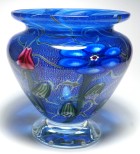 |
| 5316 | Vintage Pairpoint Faceted Concentric
Millefiori Paperweight. circa 1970s. This is a
wonderful concentric millefiori paperweight with three rings of
cogged millefiori around a center cane. Each of the 52
millefiori in the design has a star shaped center. The design
is placed on an almost opaque blue ground. The paperweight is
faceted with a large flat top facet and four flat side facets.
I believe this paperweight dates from the early 1970s when Pairpoint
was starting in its Sagamore location. Possibly an early
paperweight made by Bill Burchfield. The paperweight is
unsigned, but I guarantee the Pairpoint attribution.
Pairpoint Glass has a long history extending back to its earliest origins with Mount Washington Glass in 1837. Owners and locations changed a number of times and the name Pairpoint was first used in the 1890s. The original Pairpoint companies were located in New Bedford, Massachusetts. In 1938, it was reorganized as Gunderson Glass Works by owner Robert Gunderson and later renamed the Gunderson - Pairpoint Glass Works in 1952. The name was acquired by Robert Bryden and the company moved briefly to East Wareham, MA in 1957 where it operated as the Pairpoint Glass Company. They leased production facilities in Spain. The last New Bedford factory burned down in 1965. In its latest iteration, Robert Bryden moved Pairpoint to Sagamore, Massachusetts in 1970. It continues to operate at that location today, with new owners. William Clark Burchfield started making paperweights at Pairpoint Glass in Sagamore, Massachusetts in 1970. He left in 1976 to form the Cape Cod Glass Works (also in Sagamore) which continued in operation until 2000. It then continued briefly in Crossville, Tennessee until 2001. Bill Burchfield died in 2012. Bill's son Mark was also at the Cape Cod Glass Works until 1998. Size: 2 3/4" diameter by just under 1 7/8"
high. The base is polished flat with a large pontil
scar. The paperweight is faceted with a large flat top facet
and four flat side facets. For extra pictures, click on the picture at the right and the following links: Large pictureSOLD. Added 10/17/2023 For more vintage American paperweights, see my Vintage American Paperweights Web Page. Click on the picture to see a larger image. |
Click
on the picture to see a larger image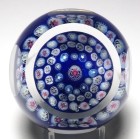 |
| 2409 | Antique Clichy Faceted Concentric
Millefiori Paperweight with 11 roses. circa
1845-1860. This wonderful antique Clichy concentric millefiori
paperweight has a classic arrangement of three concentric rings of
complex millefiori around a blue pastry mold cane. The inner
ring has eleven green and white roses. The second ring
consists of fifteen pink pastry mold canes. The outer
ring has an alternating pattern of 24 canes with six purple pastry
mold canes and 18 pink and green canes. The 18 pink and green
complex canes resemble the color of pink and green roses. In
all, there are 51 millefiori canes over a clear ground. The
canes are intricate and very colorful. See the close-up
picture for more detail. There are six side facets and a top
facet. A fantastic paperweight. Clichy paperweights are highly sought after by collectors for their complex canes and brilliant colors. Clichy paperweights with rose canes are especially desirable. The Clichy factory was founded at Billancourt near Paris in 1837. Shortly after that it moved to Clichy-la-Garenne, which gave the factory its best known name. They stayed in operation until about the 1870s. Size: 2 5/8" diameter by 1 3/4" high. The base
is ground concave. There are six side facets and a top
facet. For extra pictures, click on the picture at the right and the following links: Large pictureNew Price $645 (was $1,295) postage paid in the US. Repriced 10/17/2023 For more information about Antique Paperweights, see my Antique Paperweights Web Page. Click on the picture to see a larger image. |
Click
on the picture to see a larger image 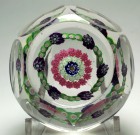 |
| 5211 | Baccarat 1971 Millefiori Mushroom
Turquoise Double Overlay Paperweight. dated 1971.
This
modern millefiori paperweight features a wonderful six row
concentric millefiori design with design pulled down to the base
to form a slender stem, completing the mushroom form. The
outer ring alternates between blue and yellow canes to create an
interesting pattern when viewed from the base. The design is
placed over clear crystal and finished with a turquoise and white
double overlay. It is signed with a Baccarat complex "B1971"
signature / date cane in the fourth ring from the center.
This paperweight is also signed twice on the base with an acid
etched Baccarat mark along with the engraved year (1971) and
edition number (153). The overlay is faceted with one large
top facet and five side facets. A fantastic paperweight. A mushroom paperweight is one that contains an upright, mushroom shaped tuft of millefiori canes. Below the tuft at the top, the canes are pulled down to form a stem. Typically the top is either a closepacked design or a close concentric design. Sometimes, especially with antique paperweights, a torsade is added surrounding the stem of the mushroom. Millefiori mushroom paperweights like this are among the most difficult paperweights to make. Add the double overlay and you have an extremely challenging and desirable paperweight. Note on limited editions: After extensive research in the Baccarat archives, Paul Dunlop concluded that popular designs like this were numbered editions, but not limited editions. Baccarat made them in more than one year as sales demanded and numbered the production sequentially. I am not entirely in agreement, but I am content to adopt Dunlop's terminology and refer to this as a numbered 1971 edition. I believe Baccarat intended to limit production of challenging designs like this double overlay mushroom. The records, if any, remain to be found. Baccarat was founded in 1776 in Alsace-Lorraine with the name of Verrerie de Sainte Anne. The original location was near the town of Baccarat. Today the firm is known as Compagnie des Cristalleries de Baccarat. In 1952, Paul Jokelson approached Baccarat with the idea of making sulphide paperweights again. In 1953 Baccarat resumed paperweight production with a series of sulphide paperweights the first of which were the unsuccessful Eisenhower sulphide followed by the Queen Elizabeth coronation sulphide. Millefiori paperweight production was resumed in 1957 and lampwork paperweights were re-introduced in the early 1970s. Baccarat stopped making this type of fine glass paperweights in 2002. You can read more about the Baccarat paperweights in his book Baccarat Paperweights - two centuries of beauty by Paul Dunlop or one of the older books on paperweights in general, such as The Encyclopedia of Glass Paperweights by Paul Hollister or World Paperweights by Robert Hall. Large size: 2 15/16" diameter by just over 2"
high. The base is polished
flat. The paperweight is faceted with one large top
facet and a five side facets. For extra pictures, click on the picture at the right and the following links: Large picture$495 postage paid in the US. Added 10/17/2023 For more information about Baccarat paperweights, see my Baccarat Paperweights Web Page Click on the picture to see a larger image. |
Click
on the picture to see a larger image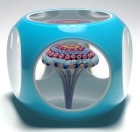 |
| 4388 | Large Antique Clichy Faceted Concentric
Millefiori Paperweight. circa 1845-1860. This
wonderful antique Clichy concentric millefiori paperweight has a
classic arrangement of three concentric rings of complex millefiori
around a blue pastry mold cane. The inner ring has nine Clichy
eight lobed edelweiss florets. The second ring consists of
fifteen purple eight lobed florets. The outer ring has an
alternating pattern of 24 pastry mold canes with six green pastry
mold canes and 18 pink pastry mold canes. In all, there are 49
millefiori canes over a clear ground. The canes are intricate
and very colorful. See the close-up picture for more
detail. There are six side facets and a top facet. A
fantastic paperweight.
Clichy paperweights are highly sought after by collectors for their complex canes and brilliant colors. Clichy paperweights with rose canes are especially desirable. The Clichy factory was founded at Billancourt near Paris in 1837. Shortly after that it moved to Clichy-la-Garenne, which gave the factory its best known name. They stayed in operation until about the 1870s. Large Size: 2 5/8" diameter by just under 1 3/4"
high. The base is ground concave. There are six side
facets and a large top facet. For extra pictures, click on the picture at the right and the following links: Large pictureNew Price $475 (was $950) postage paid in the US. Repriced 10/16/2023 For more information about Antique Paperweights, see my Antique Paperweights Web Page. Click on the picture to see a larger image. |
Click
on the picture to see a larger image 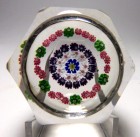 |
| 6005 | Dramatic Reijmyre (Sweden) Sunfish Figural
Paperweight. circa 1950-1960. This large
figural Sunfish paperweight was made at the Swedish firm Reijmyre
and is signed with a gold foil label "REIJMYRE 1810 SWEDEN".
Possibly made by one of the Marcolin brothers. The paperweight
has an interesting green and brown textured interior that reminds me
of later work by the Marcolin brothers at Färe-Marcolin. A
fantastic example. Reijmyre was founded in Sweden in 1810 by Johan Jacob Graver. During the early 20th century, Reijmyre produced high quality cameo glass. The company changed hands many times over the years. Lennart Rosen took over in 1950, and hired designers including Johnny Mattsson, Paul Kedelv and Bert Kindaker. The Italian brothers Josef and Benito Marcolin worked at Reijmyre just before starting their own company in 1961. The Reijmyre glassworks is still in production today. Large size: 6 1/4" wide by 4 9/16" high by 1 9/16"
thick. The base is polished
flat. For extra pictures, click on the picture at the right and the following links: Large picture$45 postage paid in the US. Added 10/15/2023 For more paperweights from other countries, see my Other Countries Web Page. Click on the picture to see a larger image. |
Click
on the picture to see a larger image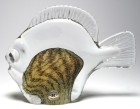 |
| 2048 | Magnum Antique Graeser Order of Elks
Paperweight. circa 1890. This uniquely American
style paperweight features a detailed image of an elk with very
large antlers above the logo "B.P.O.E." logo for the "Benevolent and
Protective Order of Elks". On each side of the elk are two
colorful hand painted floral sprays, each with a large light pink or
amber rose. There is a clock pointing to the 11 o'clock hour
in the center below the elk. The elk and hand painted spray
are placed on a white enamel disk. The image at the center was
printed onto the white disk using a photographic process developed
by William Maxwell and commercialized by Albert Graeser. After
the decorations were complete the disk was encased in glass.
The hand painted floral sprays and large roses are
outstanding. A wonderful paperweight. Note on colors: The pictures don't capture the color accurately. The roses are a light pink or amber with a slightly yellow tint. Albert Graeser was a well known producer of photographic paperweights working in Pittsburgh, Pennsylvania in the 1890-1900 period. He used a process patented by William H. Maxwell in 1882. For more information on this style of paperweight see the article "Fraternally Yours" by William Price, Jr. in the 2001 Annual Bulletin of the Paperweight Collectors Association. This style of paperweight is also described on page 413 of American Glass by George and Helen McKearin. Very large size: 3 3/8" diameter by just over 2 3/8"
high. The base is ground flat and finished with a matte
finish although there is a remnant of the pontil mark. For extra pictures, click on the picture at the right and the following links: Large picture$145 postage paid in the US. Added 10/15/2023 For more information about antique paperweights, see my Antique Paperweights Web Page (dl-ant-va) Click on the picture to see a larger image. |
Click
on the picture to see a larger image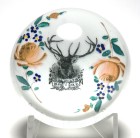 |
| 4718 | Charles Kaziun Jr. Miniature Tilted
Pedestal Spider Lily Paperweight with Red Aventurine Ground.
circa 1960-1980. This is a miniature pedestal paperweight
with a blue and white spider lily and four leaves on a rich red
aventurine ground. There is a magnificent lily flower with a
yellow complex millefiori cane for the stamen. Each leaf is a
double leaf - two leaves with a clear layer joining them so a bit of
the red ground shows through. This makes it look like each
leaf has a dark stripe down the center. The paperweight is
tilted at a 45 degree angle so it displays beautifully. Signed
on the red underside of the ground with a gold foil K.
This design was Charles Kaziun's signature design and one of the most popular with collectors. This size and style was often referred to as a #1. Charles Kaziun Jr. was one of the most famous of the American paperweight artists. He is often credited with contributing to the rebirth of interest in paperweight making. He made paperweights from the 1940s until his death in 1992. His weights are usually signed with a gold K or a special millefiori cane containing a K. You can read about him in many books, including: Signature: Signed on the underside of the red ground with Kaziun's gold foil K. Condition: Excellent condition with no chips or cracks. For extra pictures, click on the picture at the right and the following links: Large picture$195 postage paid in the US. Added 10/12/2023 For more paperweights by Charles Kaziun, see my Kaziun Paperweights Web Page. Click on the picture to see a larger image. |
Click
on the picture to see a larger image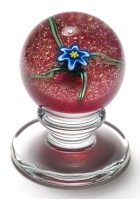 |
| 5946 | Perthshire Magnum 1976D Annual Collection
Cushion Millefiori Paperweight. dated 1976. This
is an amazing paperweight constructed in two levels and then encased
again with clear glass. It is a paperweight within a
paperweight. The inner design is a lower level closepacked
millefiori design which can also be viewed from the base. The
inner design is encased with clear glass and then an outer blue and
white double overlay having a circular window that reveals the lower
level. The window is bordered with a ring of complex canes and
is surrounded by a six sided garland of twists and larger complex
canes and is surrounded again by an outer garland of complex
canes. The entire design is then encased again in clear
glass. It is finished with one large top facet and signed on
the base with a "P 1976" Perthshire signature / date cane. The
"6" in the signature cane is distorted and looks like a "0", but
this is definitely a 1976 design. This design was offered in a
limited edition of 300 paperweights of which 295 were made. I
will mail this with a Perthshire box, but it is not the original
1976 box. A fantastic very large paperweight and a great
addition to any collection of millefiori
paperweights. Perthshire made this paperweight as one of their Annual Collection for 1976. This means the design was made only that one year and never again. The edition size for this paperweight was 300 weights of which 295 were made. Each year's Annual Collection designs were lettered to indicated this special status. In 1976, there were five Annual Collection designs, designated 1976A through 1976E. This design was given the designation 1976D. Note on blue and white inner overlay: The inner overlay wraps around to the base to create an irregular shaped window at the base. Please review the pictures of the base. Perthshire was a small company in Crieff, Scotland that was devoted to the creation of quality glass paperweights. They stopped production in January 2002 after more than 30 years of production. Their paperweights were consistently high in quality and yet remained reasonable in price. There are three books on Perthshire Paperweights. If you collect Perthshire paperweights, you should have them in your library. The birth of Scottish paperweight making is credited to the glass making family of Salvador Ysart, who moved to Crieff, Scotland in 1922. They worked first at John Moncrieff Ltd and made the earliest Scottish paperweights during that period. In 1946 Salvadore and his sons Augustine and Vincent founded Ysart Brothers Glass and produced glass wares under the Vasart label. Salvador Ysart died in 1955 The company name was later changed to Vasart Glass. Stuart Drysdale was hired manage the business side of the enterprise in 1960. The company evolved into a new company Strathearn owned by Teachers Whiskey. In 1967 Drysdale was sent a magazine article on antique paperweights (Woman's Day, July 1965). The inspired him to try to produce weights comparable to the French antiques. With this goal in mind, he and several of the glass workers left Strathearn to found Perthshire in 1968.Very large size: Just under 3 9/16" diameter by 2
1/4" high. The base is polished concave. It weighs
just under 1 pound 11 ounces and will be over two pounds when
packaged for mailing. For extra pictures, click on the picture at the right and the following links: Large pictureSOLD. Added 9/30/2023 For more information about Perthshire Paperweights, see my Perthshire Web Page. Click on the picture to see a larger image. |
Click
on the picture to see a larger image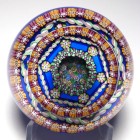 |
| 1579 | Vintage Vintage Midwest US Floral Design
Dump Paperweight with a Double Cross Pattern. circa
1900-1940. This is a very large paperweight with a
double cross pattern made up of colored glass rods (stringers) with
white frit between the rods. The rods extend down to the
base. There is a colorful trumpet shaped frit layer below the
cross pattern. And a large bubble in the center of the
cross. The paperweight or dump was made by an unknown maker,
probably in the Midwest US. The base is fire finished with a
pronounced pontil scar. This has all the characteristics of a true whimsy, made in spare time by a glass worker. I believe this was made in the midwest US in the first half of the 20th century. Very large size: 3 3/4” diameter by 3 3/16”
high. The base is fire finished with a pronounced pontil
scar. It weighs just under 2 pounds 15 ounces and will be
four pounds when packaged for shipping. For extra pictures, click on the picture at the right and the
following links: Large
picture $95 postage paid in the US. Added 9/24/2023 For more vintage American paperweights, see my Vintage American Paperweights Web Page Click on the picture to see a larger image. |
Click
on the picture to see a larger image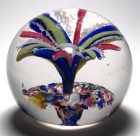 |
| 5299 | Baccarat Modern Four Row Open Concentric
Millefiori Paperweight. Circa 1958 - 1965.
This paperweight has an open concentric design with four rows of
pastel colored millefiori around a central complex center
cane. It is signed with an etched Baccarat logo on the
base. The paperweight contains examples of early Baccarat
complex millefiori and dates from the first years of Baccarat modern
millefiori production. Baccarat was founded in 1776 in Alsace-Lorraine with the name of Verrerie de Sainte Anne. The original location was near the town of Baccarat. Today the firm is known as Compagnie des Cristalleries de Baccarat. Most collectors refer to three periods of Baccarat paperweight production.
Baccarat started making modern millefiori paperweights in 1957. According to Paul Dunlop ( Baccarat Paperweights: Two Centuries of Beauty ), Baccarat started making the modern spaced millefiori paperweights on muslin or lace in 1958 and continued making undated examples until the limited editions were started in 1970. The exception is 1964 when special versions were produced for Baccarat's 200th anniversary. Medium Size: Just over 2 1/2” diameter by 1 3/4”
high. The base is polished flat. For extra pictures, click on the picture at the right and the following links: Large pictureSOLD. Added 9/20/2023 For more information about Baccarat paperweights, see my Baccarat Paperweights Web Page. Click on the picture to see a larger image. |
Click
on the picture to see a larger image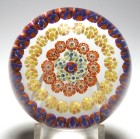 |
| 1788 | Rare Chinese Copy of a NEGC Faceted
Millefiori Nosegay Paperweight. circa 1930. This
is an almost antique Chinese copy of a New England Glass Company
(NEGC) Posy Paperweight made circa 1860. It has the fancy NEGC
quatrefoil faceting and setup. The millefiori nosegay consists
of three red, blue, and yellow complex millefiori canes with four
green leaves and a stem. All this surrounded by two garlands
of complex millefiori, one made up of alternating pink and blue
millefiori canes, the other made up of identical pink and white
flowers with green centers. This great setup is on top of a
latticinio swirl ground. There are twelve side facets (four
large and eight smaller) plus the four part top facet with a notch
between each. This is a fantastic addition to any collection
of antique paperweights. In some ways, the execution of this
example is better than the original NEGC, since NEGC examples usual
have tipped or cracked canes and the posy is often smudged. Chinese Paperweights were made in the late 1920s and throughout the 1930s as an attempt to duplicate 19th Century antique weights made in the United States and France. Because they are almost 100 years old, they are very collectible and every collector should own a few of these as study pieces. The history of the early Chinese paperweights is mostly anecdotal as no written records have been discovered. The story is that an American dealer sent examples of paperweights made by the New England Glass Company (NEGC), Boston & Sandwich Glass Company (B&S), Millville makers, and French factories to a Chinese factory and requested copies be made. The results are interesting and sometimes confused with the originals by inexperienced collectors. The earliest pictures of these paperweights appeared in the book American Glass Paperweights by Francis Edgar Smith published in 1939. Smith was aware that at least one of the paperweights shown in his book was Chinese. Since Smith was not an expert collector, this indicates that there was some general knowledge that these were Chinese prior to 1939. Large Size: 2 7/8" diameter by 1 15/16" high.
The bottom is ground concave. For extra pictures, click on the picture at the right and the following links: Large picture$175 postage paid in the US. Added 9/19/2023 For more information about paperweights from China, see my Chinese Paperweights Web Page. Click on the picture to see a larger image. |
Click
on the picture to see a larger image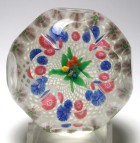 |
| 4407 | Charles Kaziun Jr. Crimp Rose Tilted
Upright Pedestal Paperweight - Dark Pink. circa
1960-1980. This small tilted upright pedestal paperweight
features a magnificent crimp rose with fifteen variegated dark pink
petals, a center pistil, and four upturned dark green leaves.
The petals are arranged in Kaziun's 4+4+4+3 crimp pattern. It
is signed on the underside of the rose with Kaziun's complex
signature cane having a K in the center surrounded by six heart
canes. Because the rose is tilted, the signature cane is
visible from the back and also through the base. The design is
set on a clear ground and supported by a pedestal base. A
fantastic addition to any collection of glass paperweights.
After being introduced to the Millville glass artist Emil Larson, Charles Kaziun set a goal to create and perfect his own version of Larson's famous Millville Rose. This was considered the ultimate icon of glass perfection. It took Charles almost four years and many thousands of dollars worth of experimentation to succeed. Many collectors consider the pedestal rose the pinnacle of Kaziun's artistry. Charles Kaziun Jr. was one of the most famous of the American paperweight artists. He is often credited with contributing to the rebirth of interest in paperweight making. He made paperweights from the 1940s until his death in 1992. His weights are usually signed with a gold K or a special millefiori cane containing a K. You can read about him in many books, including: Signature: Signed on the underside of the rose with Kaziun's complex signature cane having a K in the center surrounded by six heart canes. Condition: Excellent condition with no chips. cracks, or scratches. For extra pictures, click on the picture at the right and the following links: Large picture facing left$645 postage paid in the US. Added 9/18/2023 For more paperweights by Charles Kaziun, see my Kaziun Paperweights Web Page. (dl-kaz-ca) Click on the picture to see a larger image. |
Click
on the picture to see a larger image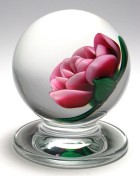 |
| 848 | Czech / Bohemian Faceted Morning Glories
Trumpet Flower Paperweight. circa 1880-1925.
Trumpet flower paperweight with five blossoms. There is one
large blue center flower and four smaller multicolored flowers at a
lower level. There is a planned bubble in the center of each
flower. The flowers are pushed down to a green frit flower pot
shaped ground. The glass is heavy crystal. This
paperweight is faceted with 32 facets arranged in four rows. A
wonderful example. Note on condition: Good condition for its age. There are chips on the edges of some of the facets, but no major damage. This style is also called an icepick flower because of the sharp tool used to push each flower down to the base. Some authors call these morning glory flowers. Von Brackel discusses this style in his book He lists many variations on pages 106 to 149 with a wide range of values up to $300 and more. On pages 278 & 279 he describes the process used to make a trumpet flower paperweight. Size: 2 7/8" diameter by 3 1/8" high. The
bottom is polished flat with a remnant of the pontil mark. For extra pictures, click on the picture at the right and the following links: Large picture$95 postage paid in the US. Added 9/7/2023 For more information about Bohemian paperweights, see my Bohemian Paperweights Web Page . Click on the picture to see a larger image. |
Click
on the picture to see a larger image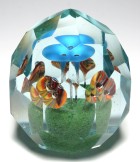 |
| 5956 | Large Ed Rithner Multi-Colored Candy Cane
Millefiori Paperweight. circa 1940-1970. A
wonderful example of a relatively rare style of paperweight.
The millefiori canes are striped lengthwise and are placed over a
transparent turquoise ground. The canes are various
colors of red, green, and white. A classic Rithner design. Note: As shown in the side view, there are many striations (sugaring) in the glass. Still, the paperweight views beautifully. Ed Rithner worked in Wellsburg, West Virginia from 1908 to the 1970s or later. You can read about Ed Rithner in Jean Melvin's book on American Glass Paperweights and their Makers . All of Rithner's weights are unsigned. Large Size: 2 15/16" diameter by 2" high. The
base is fire finished and then ground to a matte finish in the
center to remove the pontil mark. For extra pictures, click on the picture at the right and the following links: Large pictureSOLD. Added 9/7/2023 For more vintage American paperweights, see my Vintage American Paperweights Web Page. Click on the picture to see a larger image. |
Click
on the picture to see a larger image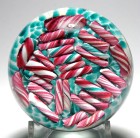 |
| 1365 | Magnum Tom Mosser Devout Woman
Paperweight. circa 1970. This classic decorative
plaque paperweight was made by Thomas Mosser at his Variety Glass
Company in Cambridge Ohio. The white enamel plaque is
decorated with a printed decal image (ceramic transfer) of a devout
woman engaged in prayer. It is signed with an "M" in the lower
edge of the scene. The plaque rests on a blue and white frit
ground with a second frit ground below. A great example from
this Cambridge Ohio maker. Note: The edge of the base has an imperfection - it is not perfectly round. Perhaps a flaw was polished out. Please review the pictures. Thomas Mosser (born 1927) learned to work with glass at the Cambridge Glass Company where his father Orie Mosser was the plant manager. When Cambridge Glass closed in 1954, Tom decided to continue in the glass business and formed Variety Glass with the support of several experienced glass workers from Cambridge. The first couple of locations failed due to fires, but eventually a stable operation emerged and produced a variety of products, including glassware for the pharmaceutical industry, medical supplies, and also collectible molded items such as novelty salts, jam dishes, toothpick holders, ashtrays, and miniature boot and shoes. Tom also made paperweights to order as well as fixed designs for Shrine and Masonic lodges. Many of his paperweights used ceramic transfers of well known paintings by other artists. For more information, you can read about the Tom Mosser in the book American Glass Paperweights and Their Makers by Jean Melvin (revised 1970). The Mosser family continues to operate a glass business in Cambridge Ohio. Very large size: Just over 3 1/2" diameter by just
over 2 3/4" high. The base is polished flat. It weighs
just under 30 ounces and will be three pounds when packaged for
mailing. For extra pictures, click on the picture at the right and the following links: Large picture$75 postage paid in the US. Added 9/4/2023 For more vintage American paperweights, see my Vintage
American
Paperweights Web Page. Click on the picture to see a larger image. |
Click
on the picture to see a larger image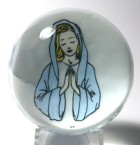 |
| 4575 | St. Louis 1973 Millefiori Looped Garlands
Paperweight - Magnum Limited Edition. dated 1973.
This paperweight features a millefiori garland with six loops
arranged a large complex millefiori cane. The six loops
alternate between white and blue canes. The design is placed
on an opaque red ground. It is signed and dated with a "SL
1973" complex millefiori cane between two of the loops. It
also has its original (slightly worn) "CRISTAL SAINT LOUIS FRANCE"
foil label. A precious addition to any collection of Saint
Louis paperweights. According to the two books on St. Louis paperweights, this paperweight was issued in a limited edition of 400 paperweights of which 250 were reserved for US collectors. Note on condition: This paperweight has a small scuff mark (about 3/16" long) on the side near the base. Otherwise, it is in excellent condition with no other damage found. Cristalleries de Saint Louis was
founded in 1767 in Lorraine, which became part of France in
1766. The region was already home to several
glassworks. Paperweight production started at St. Louis in
1845 and most likely continued until about 1860. Although
the modern production of paperweights started in 1952, the
output of millefiori and lampwork paperweights was small.
Fewer than 400 lampwork and millefiori paperweights were made
between 1952 and 1955. They were not all signed or
dated. The most successful product of this early revival
period was the Queen Elizabeth sulphide which was made to
commemorate her coronation in 1953. After 1955, no
additional weights were made at St. Louis until 1965. In
1965 the factory resumed production of lampwork and millefiori
paperweights and then in 1967 they began a series of sulphide
weights. Finally, in 1970 they started producing annual
limited edition paperweights. Very large size: 3 1/4" diameter by 2 1/4"
high. The base is ground concave. For extra pictures, click on the picture at the right and the following links: Large picture$395 postage paid in the US. Added 9/4/2023 For more information about paperweights made by the St. Louis glass factory in France, see my St. Louis Web Page . Click on the picture to see a larger image. |
Click
on the picture to see a larger image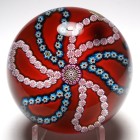 |
| 5290 | Large Colorful Strathearn Paneled
Millefiori Paperweight. circa 1963-1968. This very
attractive paperweight consists of a paneled millefiori pattern with
nine panels of 1 (yellow) + 2 (pink) millefiori canes each separated
by a white latticinio twist cane. There is a central ring of
eight dark red millefiori canes and then a center pink and
white millefiori cane. The canes are early Scottish millefiori
canes on an transparent green ground. This is a great addition
to any collection of Scottish paperweights. Great color. The birth of Scottish paperweight making is credited to the glass making family of Salvador Ysart, who moved to Crieff, Scotland in 1922. They worked first at John Moncrieff Ltd and made the earliest Scottish paperweights during that period. In 1946 Salvadore and his sons Augustine and Vincent founded Ysart Brothers Glass and produced glass wares under the Vasart label. Salvador Ysart died in 1955 The company name was later changed to Vasart Glass. Strathearn Glass was formed in a reorganization of Vasart glass in 1963. The new company was owned by Teachers Whiskey. The company is no longer in existence. Large size: Just over 3” diameter by 2 1/8”
high. The base is fire polished with a remnant of the pontil
mark. For extra pictures, click on the picture at the right and the following links: Large picture$110 postage paid in the US. Added 8/31/2023 For more information about paperweights made by Scottish makers, see my Scottish Paperweights Web Page Click on the picture to see a larger image. |
Click
on the picture to see a larger image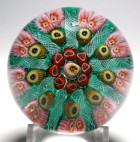 |
| 4438 | Large Fratelli Toso Murano Latticinio and
Twist Crown Paperweight with Millefiori Canes.
circa 1970. Wonderful example of a Murano swirl crown
paperweight formed from 24 colorful twists alternating in color and
arranged in a swirl. There are also three large millefiori
canes. Every other twist is a white latticinio twist.
Alternating colors are blue, green, red, pink, and
yellow. The yellow and pink twists have gold aventurine
edges. This paperweight was made by Fratelli Toso. A fun
paperweight with brilliant colors. Technically a crown weight should have a crown millefiori or group of millefiori on top. This weight does not. Crown weights are considered by some to be the most exciting of all millefiori designs. They are extremely difficult to make. Pedestal crowns are the most desirable.
This paperweight was made on the island of Murano in Venice, Italy. Venetian glass making dates back centuries and the Venetians are given credit for the earliest millefiori canes and paperweights in 1840s. More recently, paperweight making was revived in the 1930s and again in the 1960s. Fratelli Toso was started in 1854 by six brothers - Angelo Toso, Giovanni Toso, Ferdinando Toso, Carlo Toso, Gregorio Toso and Liberato Toso. They were joined by Ermanno Toso in 1924 who became artistic director. The Fratelli Toso company is well known for its use of colorful murrines and millefiori, particularly during the 1950's and earlier. In 1979, the company suffered a harsh economic crisis, forcing the owners to divide it into Antica Vetreria Fratelli Toso and Fratelli Toso International. In 1981, Fratelli Toso International filed for bankruptcy and closed its doors for good. Antica Vetreria Fratelli Toso, led by Arnoldo Toso, continued to operate. Very large size: 3 1/16" diameter by 2 5/8"
high. The base is polished flat. For extra pictures, click on the picture at the right and the following links: Large picture$95 postage paid in the US. Added 8/18/2023 For more information about Murano paperweights, see my Murano Paperweights Web Page . Click on the picture to see a larger image. |
Click
on the picture to see a larger image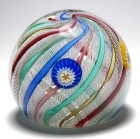 |
| 6002 | Magnum AVEM Murano Hollow Blown Crown
Paperweight. circa 1930-1960. Colorful
Murano crown paperweight made by Arte Vetraria Muranese
(AVEM). The paperweight is formed from 26 alternating strands
of white and pink twists. The pink twists have gold aventurine
borders to add sparkle. The white twists are made up of a
ribbon of five white rods. Eighteen colorful millefiori canes
make up the crown on top. There is a remnant of a Murano label
on the base. The
top of the dome has a small unevenness (from the making) which
cases a tiny bit of distortion. A wonderful large
example. This crown paperweight is unusual in that it is hollow blown with a large bubble in the center in the style of antique crown paperweights. Most modern crown paperweights are solid in the center. A great example for any collector of paperweights or Murano glass. Crown weights are considered by some to be the most exciting of all millefiori designs. They are extremely difficult to make. Hollow blown crown weights are even more difficult to make and are hard to find. This paperweight was made on the island of Murano in Venice, Italy. Venetian glass making dates back centuries and the Venetians are given credit for the earliest millefiori canes and paperweights in 1840s. More recently, paperweight making was revived in the 1930s and again in the 1960s. A.V.E.M. or Arte Vetraria Muranese was founded on the Island of Murano in Venice, Italy in 1932. They were no longer producing glass in 2003. For more information see page 9 of the book Murano Glass Century 20 by Leslie Pina. Very large size: Just over 3 1/2" diameter by
just over 2 15/16" high. The base is polished flat and
hollow ground in the center. This paperweight weighs 28
ounces. For extra pictures, click on the picture at the right and the following links: Large pictureSOLD. Added 8/17/2023 For more information about Murano paperweights, see my Murano Paperweights Web Page . Click on the picture to see a larger image. |
Click
on the picture to see a larger image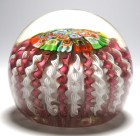 |
| 5401 | Large Baccarat 1977 Spaced Millefiori on
Lace Paperweight. dated 1977. This wonderful
spaced millefiori paperweight from Baccarat contains an arrangement
of 19 millefiori canes on a lace or upset muslin ground. The
canes are intricate and very colorful. See the close-up
picture for more detail. It is signed with a Baccarat "B1977"
signature / date cane in the design. And the base is signed
with an etched Baccarat logo, the engraved edition number (52), and
the engraved year (1977). It comes with its original
(distressed) box and certificate. A large colorful
example.
This design was produced in 1977. It is not listed as a limited edition, but the individual paperweights were numbered sequentially. This is number 52 in that series. Paul Dunlop states on page 178 of his book Baccarat Paperweights two centuries of beauty that this style was made in numerous years as a numbered edition paperweight. Note on white glare: Please ignore the white areas, they are glare from the lights. Baccarat was founded in 1776 in Alsace-Lorraine with the name of Verrerie de Sainte Anne. The original location was near the town of Baccarat. Today the firm is known as Compagnie des Cristalleries de Baccarat. In 1952, Paul Jokelson approached Baccarat with the idea of making sulphide paperweights again. In 1953 Baccarat resumed paperweight production with a series of sulphide paperweights the first of which were the unsuccessful Eisenhower sulphide followed by the Queen Elizabeth coronation sulphide. Millefiori paperweight production was resumed in 1957 and lampwork paperweights were re-introduced in the early 1970s. Baccarat stopped making this type of fine glass paperweights in 2002. You can read more about the Baccarat paperweights in his book Baccarat Paperweights - two centuries of beauty by Paul Dunlop or one of the older books on paperweights in general, such as The Encyclopedia of Glass Paperweights by Paul Hollister or World Paperweights by Robert Hall. Large size: 3 1/16" diameter by just over 2 1/4"
high. The base is polished flat. For extra pictures, click on the picture at the right and the following links: Large picture$425 postage paid in the US. Added 8/16/2023 For more information about Baccarat paperweights, see my Baccarat Paperweights Web Page. Click on the picture to see a larger image. |
Click
on the picture to see a larger image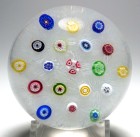 |
| 3015 | Magnum Whitefriars Pattern 9850 Pink
Streaky Abstract Paperweight. circa
1978-1980. This paperweight has a distinctive swirl pattern
created by picking up red, yellow, and pink colored glass stringers
(rods). It has typical heavy Whitefriars lead crystal.
This is pattern 9850 and it has a label identifying it as
such. It has its original (slightly worn) Whitefriars paper
label on the side near the base. The label has a Whitefriars
monk symbol and the text "WHITEFRIARS FULL LEAD CRYSTAL MADE IN
ENGLAND". It also has label identifying the pattern as
"9850". A great addition to any collection of modern English
paperweights. The pattern "9850" was introduced in 1978 by Geoffrey Baxter. The paper label with the number "9850" has an added handwritten "A" and another number "9793". To the best of my knowledge, there is no pattern 9793, so this is probably an error. It may have been a reference to 9893 which was a version introduced in 1980 by Ray Annenberg (which would also explain the "A"). The Whitefriars Paperweights Collectors Guide by Brian Slingsby and Judy Taylor refers the group of designs (9850, 9851, 9893, & 9894) with this style of abstract as "Bubble & Streaky". Streaky weights came with and without a controlled bubble pattern in a variety of colors. They were made in the 1978 to 1980 time frame. Modern Whitefriars paperweights are prized by collectors for their high quality glass and millefiori designs. The limited edition paperweights with mosaic canes are especially sought after. The name Whitefriars Glass dates from sometime in the 1600s. The original site had been occupied by a community of Carmelite monks known as White Friars, hence the name taken by the glass company. Some sources state that at least a portion of the company operated under the name of James Powell and Sons from 1834 to 1962. Other sources state that the Whitefriars name was used from 1680 to 1980. Limited production of millefiori paperweights and other millefiori items started some time in the 1930s and first appeared in the 1938 catalog. Millefiori items were made using English full lead crystal (33% lead oxide). It is difficult to associate specific paperweights with this production. After 1945, they made colored glass and bubble design paperweights until the modern millefiori production started about 1951. Even then relatively few designs were produced until the 1970s. In 1980, Whitefriars glass went out of business. After Whitefriars Glass was liquidated, Caithness Glass purchased the rights to the name and produced paperweights under the Whitefriars name for awhile. Very large size: 3 3/8" diameter by 2 7/8"
tall. The bottom is polished concave. This paperweight
is heavy and weighs almost 34 ounces. For extra pictures, click on the picture at the right and the following links: Large picture$145 postage paid in the US. Added 8/15/2023 For more information about Whitefriars and other paperweights from England,see my English Paperweights Web Page. Click on the picture to see a larger image. |
Click
on the picture to see a larger image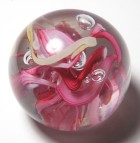 |
| 5914 | Miniature Strathearn Eight Pointed Star
Millefiori Paperweight with Opaque Yellow Ground. circa
1963-1968. This miniature paperweight features a three ring
concentric millefiori design and is finished as a eight pointed
star. The outer ring consists of 16 canes, alternating between
blue and red. The middle ring ten identical pink and red
canes. The inner ring consists of five identical white and red
canes. The center cane is a tiny yellow cane. The ground
is an opaque yellow. The star points give the glass a glittery
appearance. This paperweight has a worn Strathearn paper label
with a leaping salmon and "STRATHEARN HAND MADE IN SCOTLAND" on the
base. A great addition to any collection of Scottish
glass. This is called a pressed weight because a mold is used to form the shape. The top is flattened. The star points give the glass a real glittery appearance as you can see in the pictures. The birth of Scottish paperweight making is credited to the glass making family of Salvador Ysart, who moved to Crieff, Scotland in 1922. They worked first at John Moncrieff Ltd and made the earliest Scottish paperweights during that period. In 1946 Salvadore and his sons Augustine and Vincent founded Ysart Brothers Glass and produced glass wares under the Vasart label. Salvador Ysart died in 1955 The company name was later changed to Vasart Glass. Strathearn Glass was formed in a reorganization of Vasart glass in 1963. The new company was owned by Teachers Whiskey. Miniature size: Just under 2 1/8” diameter by
1 1/8” high. The base is fire polished. For extra pictures, click on the picture at the right and the following links: Large picture$49 postage paid in the US. Added 8/14/2023 For more information about paperweights made by Scottish makers, see my Scottish Paperweights Web Page Click on the picture to see a larger image. |
Click
on the picture to see a larger image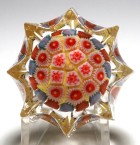 |
| 5251 | Perthshire Annual Collection 1977B Limited
Edition Damson Plums Paperweight with Certificate and
Box. circa 1977. This paperweight features
three rich purple colored lampwork plums with green stems and leaves
on a clear ground. It is faceted with a complex faceting of
one large top facet and 16 side facets (eight large and eight
smaller facets). The base is ground concave and finished with
a grid cut pattern that Perthshire calls a strawberry cut. It
is signed with a small engraved "P" on a tiny extra facet near the
base. The "P" is engraved in reverse so it displays correctly
when viewed from the top. It comes with its original box and
original certificate identifying this as #97 out of a limited
edition of 500 weights (only 315 were made). A great addition
to any collection of paperweights.
Perthshire made this paperweight as one of their Annual Collection for 1977. This means the design was made only that one year and never again. The edition size for this paperweight was 500 weights, but only 315 were made. Each year's Annual Collection designs were lettered to indicated this special status. In 1977, there were six Annual Collection designs, designated 1977A through 1977F. This design, the Damson Plum Weight, was designated 1977B. Perthshire was a small company in Crieff, Scotland that was devoted to the creation of quality glass paperweights. They stopped production in January 2002 after more than 30 years of production. Their paperweights were consistently high in quality and yet remained reasonable in price. There are three books on Perthshire Paperweights. If you collect Perthshire paperweights, you should have them in your library.The birth of Scottish paperweight making is credited to the glass making family of Salvador Ysart, who moved to Crieff, Scotland in 1922. They worked first at John Moncrieff Ltd and made the earliest Scottish paperweights during that period. In 1946 Salvadore and his sons Augustine and Vincent founded Ysart Brothers Glass and produced glass wares under the Vasart label. Salvador Ysart died in 1955 The company name was later changed to Vasart Glass. Stuart Drysdale was hired manage the business side of the enterprise in 1960. The company evolved into a new company Strathearn owned by Teachers Whiskey. In 1967 Drysdale was sent a magazine article on antique paperweights (Woman's Day, July 1965). The inspired him to try to produce weights comparable to the French antiques. With this goal in mind, he and several of the glass workers left Strathearn to found Perthshire in 1968. Small size : 2 1/16" diameter by 1 1/2" high.
Perthshire calls it a miniature but it is slightly larger than a
true miniature. It is faceted with one large top facet and
16 side facets (eight large and eight smaller facets). There
is an extra tiny facet near the base where the "P" signature is
engraved in reverse. The base is ground concave and finished
with a strawberry (grid) cut. For extra pictures, click on the picture at the right and the following links: Large picture$175 postage paid in the US. Added 8/9/2023 For more information about Perthshire Paperweights, see my Perthshire Web Page. Click on the picture to see a larger image. |
Click
on the picture to see a larger image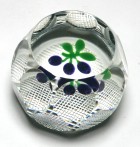 |
| 2254 | Antique Thuringia Lauscha Millefiori
Paperweight with Name Plaque "Hauptm. Karl". Circa
1870 - 1940. Colorful antique paperweight with colorful
millefiori canes arranged around a central name plaque. The
name "Hauptm. Karl" is probably an abbreviation of "Hauptmann Karl",
meaning Captain Karl or leader Karl. The complex millefiori
canes repeat in alternating patterns to make up the design with 26
canes in all. The pattern is arranged over a multicolored frit
ground. There are some wonderful complex canes in this
paperweight. An interesting example of a type of weight that
is becoming more in demand as collectors learn more about the
various Bohemian factories and eastern Germany factories. This
is a relatively rare item. Similar paperweights are on display in the museum in Lauscha and are identified as being from Lauscha in Thuringia. Examples can be found in the book by von Brackel, Paperweights: Historicism - Art Nouveau - Art Deco - 1842 to Today See pages 90-95 and figure 507 on page 221. Large Size: 2 3/4" diameter by 1 11/16" high. The
base is ground flat with a matte finish. There is a
depression remaining from the pontil mark in the center. For extra pictures, click on the picture at the right and the following links: Large picture$135 (was $195) postage paid in the US. New Price 8/8/2023 For more information about Bohemian paperweights, see my Bohemian Paperweights Web Page . Click on the picture to see a larger image. |
Click
on the picture to see a larger image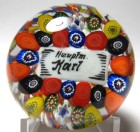 |
| 1550 | Large Vintage Czech / Bohemian Faceted
Masaryk Picture Paperweight. circa
1900-1939. Large faceted paperweight with a picture of Tomáš
Garrigue Masaryk, the first president of Czechoslovakia. The
picture is placed on a tombstone (or picture frame) shaped sulphide
that rests on a multicolored cushion of glass bits. The
tombstone has ornamental features on each side of the picture.
On the back of the tombstone is a large brightly colored orange and
amber bouquet of flowers. The paperweight has a complex
faceting with one large window facet in front, an eight part facet
at the top, and 24 other side facets for a total of 33 facets on
four levels. The paperweight was made in Northern Bohemia
during the period 1900 to 1939. It weighs almost 23
ounces. An important paperweight of historical significance. Von Brackel refers to the style as picture frame sulphides, rather than tombstones, but does not account for the presence of the flowers on the reverse side. This paperweight has no writing on the tombstone, but I have had others with the same or similar pictures that had the name "T. G. Masaryk" under the picture. Masaryk was the president of Czechoslovakia from 1918 to 1935. He died in 1937 at the age of 87. The picture was taken earlier in his life. Most likely this paperweight was produced during his presidency or possibly at the time of his death. It is also possible that it was produced earlier in his life when he was a political activist advocating for the creation of an independent Czechoslovakia. Von Brackel discusses this style of paperweight in his book Paperweights - Historicism - Art Nouveau - Art Deco . He discusses several similar examples on pages 102 to 105 with a range of values of $250 and up. The picture format, he says is a specialty of Northern Bohemia. Large size: Just under 3" at the widest by just over 3
1/2" high. The base is ground flat. Faceted with a
total of 33 facets. It weighs just under 23 ounces. For extra pictures, click on the picture at the right and the following links: Large picture$145 postage paid in the US. Added 8/8/2023 For more information about Bohemian paperweights, see my Bohemian Paperweights Web Page . Click on the picture to see a larger image. |
Click
on the picture to see a larger image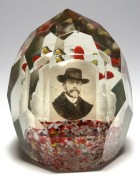 |
| 5393 | Large Whitefriars 1974 Multi-faceted
Carpet Ground Millefiori Paperweight. dated 1974.
Wonderful design with a carpet ground of identical red and white
millefiori canes surrounded by a ring of lime green canes.
There is a clear ground underneath the design. The paperweight
is faceted with one top facet and a total of 30 side facets in three
rows (12 small + six larger + 12 small side facets). There is
a Whitefriars signature cane with a white monk and the year 1974
next to the outer ring. It comes with a Whitefriars box, but
probably not the original box. A great addition to any
collection of millefiori paperweights. Note about condition: I am rating the condition of this paperweight as very good. It has manufacturing flaws - some of the larger side facets were not polished and show parallel grinding marks. The paperweight displays beautifully. The price has been reduced. Modern Whitefriars paperweights are prized by collectors for their high quality glass and millefiori designs. The paperweights with mosaic canes are especially sought after. The name Whitefriars Glass dates from sometime in the 1600s. The original site had been occupied by a community of Carmelite monks known as White Friars, hence the name taken by the glass company. Some sources state that at least a portion of the company operated under the name of James Powell and Sons from 1834 to 1962. Other sources state that the Whitefriars name was used from 1680 to 1980. Limited production of millefiori paperweights and other millefiori items started some time in the 1930s and first appeared in the 1938 catalog. Millefiori items were made using English full lead crystal (33% lead oxide). It is difficult to associate specific paperweights with this production. After 1945, they made colored glass and bubble design paperweights until the modern millefiori production started about 1951. Even then relatively few designs were produced until the 1970s. In 1980, Whitefriars glass went out of business. After Whitefriars Glass was liquidated, Caithness Glass purchased the rights to the name and produced paperweights under the Whitefriars name for awhile. Large Size: Just under 3 1/16" diameter by 2"
high. The base is ground concave. Faceted with a total
of 31 facets, one top facet and 30 side facets in three rows (12 +
6 + 12) For extra pictures, click on the picture at the right and the following links: Large pictureSOLD. Added 8/7/2023 For more information about Whitefriars and other paperweights from England,see my English Paperweights Web Page. Click on the picture to see a larger image. |
Click
on the picture to see a larger image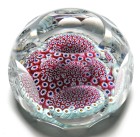 |
| 2920 | Perthshire Annual Collection 1973E Limited
Edition Miniature Amber Flower Paperweight with
certificate. This paperweight features a five-petaled
amber flower with a stem set over a clear ground. It is
faceted with one top facet and eight side facets and finished with a
brilliant grid cut base. This was the first design Perthshire
made with the grid cut base, which they called a
strawberry-cut. It is signed with Perthshire's "P" signature
cane in the center of the flower. This paperweight was made in
a limited edition of 600 paperweights of which 563 were made.
This comes which its original certificate which identifies it as
#554 in the edition. There is no paper label on this
paperweight. A nice crisp design with great color. Perthshire made this paperweight as one of their annual collection items for 1973. This means the design was made only that one year and never again. There were five annual collection designs in 1973, designated A through E, of which this is 1973E. The annual collection paperweights are the most desirable of the Perthshire line, with the exception of one of one items. Perthshire was a small company in Crieff, Scotland that was devoted to the creation of quality glass paperweights. They stopped production in January 2002 after more than 30 years of production. Their paperweights were consistently high in quality and yet remained reasonable in price. The birth of Scottish paperweight making is
credited to the glass making family of Salvador Ysart, who moved
to Crieff, Scotland in 1922. They worked first at John
Moncrieff Ltd and made the earliest Scottish paperweights during
that period. In 1946 Salvadore and his sons Augustine and
Vincent founded Ysart Brothers Glass and produced glass wares
under the Vasart label. Salvador Ysart died in 1955.
The company name was later changed to Vasart Glass. Stuart
Drysdale was hired manage the business side of the enterprise in
1960. The company evolved into a new company Strathearn
owned by Teachers Whiskey. In 1967 Drysdale was sent a
magazine article on antique paperweights (Woman's Day, July
1965). This inspired him to try to produce weights
comparable to the French antiques. With this goal in mind,
he and several of the glass workers left Strathearn to found Perthshire
in 1968. Small Size: 2 1/8" diameter by 1 3/8" high.
The bottom is ground concave and finished with a grid-cut.
This paperweight is faceted with a larger top facet and eight
small side facets. For extra pictures, click on the picture at the right and the following links: Large picture of the paperweight$195 postage paid in the US. New Price (was $265) 8/6/2021 For more information about Perthshire Paperweights, see my Perthshire Web Page. Click on the picture to see a larger image. |
Click
on the picture to see a larger image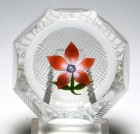 |
| 4078 | Old Chinese Two Color Fantasy Flower
Paperweight with Leaves and Bud - Copy of Baccarat Antique.
circa 1930. This is a copy of a French Baccarat 12 petal
fantasy flower paperweight with bud made in the classic period from
1845-1860. The two color flower has a complex millefiori
center cane, five leaves, two color bud, and a stem. The
ground is clear. The style dates from the 1920s or 1930s and
is almost an antique.
Chinese Paperweights were made in the late 1920s and throughout the 1930s as an attempt to duplicate 19th Century antique weights made in the United States and France. Because they are almost 100 years old, they are very collectible and every collector should own a few of these as study pieces. The history of the early Chinese paperweights is mostly anecdotal as no written records have been discovered. The story is that an American dealer sent examples of paperweights made by the New England Glass Company (NEGC), Boston & Sandwich Glass Company (B&S), Millville makers, and French factories to a Chinese factory and requested copies be made. The results are interesting and sometimes confused with the originals by inexperienced collectors. The earliest pictures of these paperweights appeared in the book American Glass Paperweights by Francis Edgar Smith published in 1939. Smith was aware that at least one of the paperweights shown in his book was Chinese. Since Smith was not an expert collector, this indicates that there was some general knowledge that these were Chinese prior to 1939. In the United States, the Tariff Act of 1930 required that every imported item must be conspicuously and indelibly marked in English with its country of origin. As a result, many of these Chinese paperweights are scratch signed on the bottom "CHINA". Many are also not signed, suggesting that either they were imported prior to 1930 or the importer ignored the requirement. Most likely the earliest Chinese paperweights were made prior to 1930. The Chinese makers often combined design features found in paperweights from different makers. For example they copied the latticinio grounds used by New England Glass Company and used them with copies of Baccarat Pansy weights. The original Baccarat pansy paperweights never had a latticinio ground. They copied the pedestal rose from Millville and then used the pedestal bottom with other weights. It is fun to collect all the variations. In general, Chinese paperweights from this period have a light weight glass mixture that is high in soda and has a greenish tinge. The glass also has a soft almost oily feel. Frequently they have bubbles or debris in the glass. And because of their age, many of these have minor scratches or other surface defects. Size: Just under 2 3/4" diameter by 1/4" high.
The base is ground concave in the center. $45 postage paid in the US. Added 8/6/2023 For more information about paperweights from China, see my Chinese Paperweights Web Page. Click on the picture to see a larger image. |
Click
on the picture to see a larger image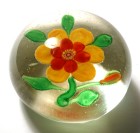 |
| 4721 | Charles Kaziun Jr. Miniature Tilted
Pedestal Light Blue Spider Lily Paperweight with Aventurine
Ground. circa 1960-1980. This is a miniature
pedestal paperweight with a light blue spider lily and four green
leaves on an opaque aventurine ground. The flower has a red
stripe on each petal and the center is a complex millefiori cane
made up of seven star shaped millefiori canes (three blue, three
yellow, and a slightly orange center). Each leaf is a double
leaf - two leaves with a clear layer joining them so a bit of the
ground shows through. This makes it look like each leaf has an
aventurine stripe down the center. The aventurine ground is
set on a brown base and a white under-layer. The paperweight
is tilted at a 45 degree angle so it displays beautifully.
Signed on the white underside of the ground with a gold K.
This design was Charles Kaziun's signature design and one of the most popular with collectors. This size and style was often referred to as a #1. Charles Kaziun Jr. was one of the most famous of the American paperweight artists. He is often credited with contributing to the rebirth of interest in paperweight making. He made paperweights from the 1940s until his death in 1992. His weights are usually signed with a gold K or a special millefiori cane containing a K. You can read about him in many books, including: Signature: Signed on the white underside of the aventurine ground with Kaziun's gold K. Condition: Excellent condition with no chips or cracks. For extra pictures, click on the picture at the right and the following links: Large picture$195 postage paid in the US. New Price 8/2/2021 For more paperweights by Charles Kaziun, see my Kaziun Paperweights Web Page. Click on the picture to see a larger image. |
Click
on the picture to see a larger image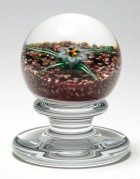 |
| 5943 | Perthshire Magnum 1987G Annual Collection
Horse & Jockey Millefiori Paperweight. dated
1987. This is an amazing paperweight constructed in two levels
and then encased again with clear glass. It is a paperweight
within a paperweight. The inner design features a large
colored picture cane of a horse and jockey surrounded by two
concentric rings of complex canes. This design can also be
partially viewed from the base. The inner design is encased
with clear glass and then an outer blue and white double overlay
having a circular window that reveals the lower level. The
window is bordered with a ring of complex canes and is surrounded by
a four sided garland of twists and larger canes. The entire
design is then encased again in clear glass. It is signed on
the base with a "P 1987" Perthshire signature / date cane.
This design was offered in a limited edition of 250 paperweights of
which only 120 were made. It comes with its original
Perthshire box. Great color and execution. Perthshire made this paperweight as one of their Annual Collection for 1987. This means the design was made only that one year and never again. The edition size for this paperweight was 250 weights, but only 120 were made. Each year's Annual Collection designs were lettered to indicated this special status. In 1987, there were seven Annual Collection designs, designated 1987A through 1987G. This design was given the designation 1987G. Perthshire was a small company in Crieff, Scotland that was devoted to the creation of quality glass paperweights. They stopped production in January 2002 after more than 30 years of production. Their paperweights were consistently high in quality and yet remained reasonable in price. There are three books on Perthshire Paperweights. If you collect Perthshire paperweights, you should have them in your library. The birth of Scottish paperweight making is credited to the glass making family of Salvador Ysart, who moved to Crieff, Scotland in 1922. They worked first at John Moncrieff Ltd and made the earliest Scottish paperweights during that period. In 1946 Salvadore and his sons Augustine and Vincent founded Ysart Brothers Glass and produced glass wares under the Vasart label. Salvador Ysart died in 1955 The company name was later changed to Vasart Glass. Stuart Drysdale was hired manage the business side of the enterprise in 1960. The company evolved into a new company Strathearn owned by Teachers Whiskey. In 1967 Drysdale was sent a magazine article on antique paperweights (Woman's Day, July 1965). The inspired him to try to produce weights comparable to the French antiques. With this goal in mind, he and several of the glass workers left Strathearn to found Perthshire in 1968.Very large size: Just under 3 3/16" diameter by 2
5/16" high. The base is ground concave. For extra pictures, click on the picture at the right and the following links: Large picture$575 postage paid in the US. Added 7/29/2023 For more information about Perthshire Paperweights, see my Perthshire Web Page. Click on the picture to see a larger image. |
Click
on the picture to see a larger image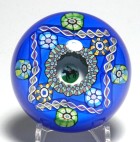 |
| 2992 | Baccarat 1971 Millefiori Mushroom Double
Overlay Paperweight. dated 1971. This
modern millefiori paperweight features a wonderful seven row
concentric millefiori design with design pulled down to the base
to form a slender stem, completing the mushroom form. The
two outer rings are somehow arranged to alternate when viewed from
the base resulting in a stunning spiral pattern. The design
is placed over clear crystal and finished with a red and white
double overlay. It is signed with a Baccarat complex "B1971"
signature / date cane in the outer ring. This paperweight is
also signed twice on the base with an acid etched Baccarat mark
along with the engraved year (1971) and edition number
(103). The red over white overlay is faceted with one large
top facet and six side facets. The base is cut with a
complex star pattern that is flat in the center. A fantastic
paperweight. A mushroom paperweight is one that contains an upright, mushroom shaped tuft of millefiori canes. Below the tuft at the top, the canes are pulled down to form a stem. Typically the top is either a closepacked design or a close concentric design. Sometimes, especially with antique paperweights, a torsade is added surrounding the stem of the mushroom. Millefiori mushroom paperweights like this are among the most difficult paperweights to make. Add the double overlay and you have an extremely challenging and desirable paperweight. Note on number of rows or rings: This design has either six or seven rows, depending on whether you count the very first ring around the single center cane. I have chosen to count the inner ring to be consistent with past listings. Note on limited editions: After extensive research in the Baccarat archives, Paul Dunlop concluded that popular designs like this were numbered editions, but not limited editions. Baccarat made them in more than one year as sales demanded and numbered the production sequentially. I am not entirely in agreement, but I am content to adopt Dunlop's terminology and refer to this as a numbered 1971 edition. I believe Baccarat intended to limit production of challenging designs like this double overlay mushroom. The records, if any, remain to be found. Baccarat was founded in 1776 in Alsace-Lorraine with the name of Verrerie de Sainte Anne. The original location was near the town of Baccarat. Today the firm is known as Compagnie des Cristalleries de Baccarat. In 1952, Paul Jokelson approached Baccarat with the idea of making sulphide paperweights again. In 1953 Baccarat resumed paperweight production with a series of sulphide paperweights the first of which were the unsuccessful Eisenhower sulphide followed by the Queen Elizabeth coronation sulphide. Millefiori paperweight production was resumed in 1957 and lampwork paperweights were re-introduced in the early 1970s. Baccarat stopped making this type of fine glass paperweights in 2002. You can read more about the Baccarat paperweights in his book Baccarat Paperweights - two centuries of beauty by Paul Dunlop or one of the older books on paperweights in general, such as The Encyclopedia of Glass Paperweights by Paul Hollister or World Paperweights by Robert Hall. Large size: 2 15/16" diameter by just under 2"
high. The base is cut
with a complex star pattern that is flat in the center.
The paperweight is faceted with one large top facet and a six side
facets. For extra pictures, click on the picture at the right and the following links: Large picture$495 postage paid in the US. Added 7/29/2023 For more information about Baccarat paperweights, see my Baccarat Paperweights Web Page Click on the picture to see a larger image. |
Click
on the picture to see a larger image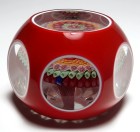 |
| 5929 | Perthshire 1995 PP47 Limited Edition
Concentric Millefiori Paperweight with Six Picture Canes and
Certificate. dated 1995. This is small
sized millefiori paperweight with two concentric rings of complex
millefiori canes and a center picture cane. The design is
placed on a white lace ground. The center cane is a complex
cane with a picture cane of a heron. The center cane is
surrounded by a ring of five spaced complex blue millefiori
canes. The outer ring is a garland of five picture canes
separated by multicolored twists. The five picture canes in
the outer garland are, I think, a panda, swan, kangaroo, penguin,
and mushroom. It is signed and dated on the base with a
"P1995" signature / date cane. It comes with its original
certificate stating that it is number 25 out of a limited edition of
300 paperweights. It is also engraved 25 on the base.
This is a really flashy paperweight with great color.
Although the PP47 was made from 1981 to 2002, the design varied each year. This particular design was made only in 1995. Perthshire was a small company in Crieff, Scotland that was devoted to the creation of quality glass paperweights. They stopped production in January 2002 after more than 30 years of production. Their paperweights were consistently high in quality and yet remained reasonable in price. There are three books on Perthshire Paperweights. If you collect Perthshire paperweights, you should have them in your library. The birth of Scottish paperweight making is credited to the glass making family of Salvador Ysart, who moved to Crieff, Scotland in 1922. They worked first at John Moncrieff Ltd and made the earliest Scottish paperweights during that period. In 1946 Salvadore and his sons Augustine and Vincent founded Ysart Brothers Glass and produced glass wares under the Vasart label. Salvador Ysart died in 1955 The company name was later changed to Vasart Glass. Stuart Drysdale was hired manage the business side of the enterprise in 1960. The company evolved into a new company Strathearn owned by Teachers Whiskey. In 1967 Drysdale was sent a magazine article on antique paperweights (Woman's Day, July 1965). The inspired him to try to produce weights comparable to the French antiques. With this goal in mind, he and several of the glass workers left Strathearn to found Perthshire in 1968. Small size: Just over 2 3/16" diameter by 1 9/16"
high. The base is ground concave. For extra pictures, click on the picture at the right and the following links: Large pictureSOLD. Added 7/21/2023 For more information about Perthshire Paperweights, see my Perthshire Web Page. Click on the picture to see a larger image. |
Click
on the picture to see a larger image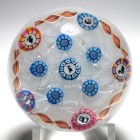 |
| 4644 | Unique Baccarat 1964 JFK Sulphide Double
Overlay Paperweight. dated 1963, issued 1964. This
modern Baccarat sulphide paperweight features a large three
dimensional figure of President John F. Kennedy. Even
though it is dated 1963, I believe it wasn't issued until 1964 after
Kennedy was assassinated. The sulphide figure was designed by
Albert David. It has a cobalt blue and white overlay with a
red base. The paperweight is faceted with one large top facet
and five side facets. The overlay has an unusual cutting with
half-circle notches between each facet. Only 201 copies were
made with this color combination, but the cutting may be
unique. It is signed on the edge of the sulphide "A. DAVID 63"
and has an acid etched Baccarat logo / mark on the base. An
extra nice example. Paul Dunlop provides a detailed study of the variations on this paperweight. This paperweight was made in several formats, including 308 overlays and 3,572 non-overlays. Of the overlays, 201 were like the example shown here with a red uncut base and a blue and white overlay. However not all of the 201 will have the same cutting on the double overlay as the glass workers at Baccarat were given some artistic freedom to vary the cutting. 35 more were finished with a star cut on the base. And 72 were made with a blue base and a red and white overlay. There were nine different formats for the 3,572 non-overlay versions. An additional 314 non-overlay weights with an amethyst base were issued in a memorial edition. Sulphides are cast objects (animals, flowers, people) made of a ceramic material that has properties similar to the surrounding glass. They are normally white, but are also sometimes colored or even painted. The objects are cast in a mold that copied or made directly from a medallion, coin or sculpture. The finest French sulphides are cast in a mold made by a skilled artist. Sometimes a sulphide will have a silvery appearance due to a thin layer of trapped bubbles between the glass and the sulphide itself. Baccarat was founded in 1776 in Alsace-Lorraine with the name of Verrerie de Sainte Anne. The original location was near the town of Baccarat. Today the firm is known as Compagnie des Cristalleries de Baccarat. In 1952, Paul Jokelson approached Baccarat with the idea of making sulphide paperweights again. In 1953 Baccarat resumed paperweight production with a series of sulphide paperweights the first of which were the unsuccessful Eisenhower sulphide followed by the Queen Elizabeth coronation sulphide. Millefiori paperweight production was resumed in 1957 and lampwork paperweights were re-introduced in the early 1970s. Baccarat stopped making this type of fine glass paperweights in 2002. You can read more about the Baccarat paperweights in his book Baccarat Paperweights - two centuries of beauty by Paul Dunlop or one of the older books on paperweights in general, such as The Encyclopedia of Glass Paperweights by Paul Hollister or World Paperweights by Robert Hall. Albert David (1896 - 1970) was a French sculptor and ceramist who studied under Jean Boucher at the École des Beaux-Arts in Paris. David exhibited in Paris at the Salon of the Société des Artistes Français, Salon d'Automne and the Salon des Artistes Décorateurs. He received an honorable mention in 1921, a gold medal at the 1937 Exposition Universelle and a third-class medal in 1938. His work was entered in the Art competitions at the 1924 Summer Olympics, but he did not win a medal. In 1938, he was was made a Chevalier of the Legion of Honor. He was particularly known for his flat reliefs and war memorials and also his pottery. In addition, he also designed plaques and medals. David served as an official sculptor for the Monnaie de Paris (Paris Mint), a government-owned institution responsible for producing France's coins. During the 1960s he designed sulphides for Baccarat, some of which were produced after his death in 1970. Large Size: 3 1/8" diameter by just over 2 1/8"
high. The base is polished flat is faceted with one large
top facet and five side facets. For extra pictures, click on the picture at the right and the following links: Large picture$235 postage paid in the US. Added 7/10/2023 For more information about sulphide paperweights, see my Sulphide
Paperweights
Web Page (dl-sul-bac) Click on the picture to see a larger image. |
Click
on the picture to see a larger image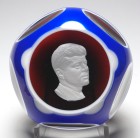 |
| 3511 | Perthshire PP52 End of Week Green
Paperweight Bottle. circa 1982 - 1994. This
end-of-week (or end-of-day) bottle contained crushed millefiori
canes embedded in an opaque green base layer. Some whole
millefiori canes are visible. The stopper matches the
bottle. It is unsigned and does not have a paper label.
It is an extra nice example. Note: Multiple views are shown taken from all sides, but only one bottle is offered for sale. The Perthshire PP52 was made from 1982 to 1994. The base layer can be green, ruby, or blue. Perthshire was a small company in Crieff, Scotland that was devoted to the creation of quality glass paperweights. They stopped production in January 2002 after more than 30 years of production. Their paperweights were consistently high in quality and yet remained reasonable in price. The birth of Scottish paperweight making is credited to the glass making family of Salvador Ysart, who moved to Crieff, Scotland in 1922. They worked first at John Moncrieff Ltd and made the earliest Scottish paperweights during that period. In 1946 Salvadore and his sons Augustine and Vincent founded Ysart Brothers Glass and produced glass wares under the Vasart label. Salvador Ysart died in 1955 The company name was later changed to Vasart Glass. Stuart Drysdale was hired manage the business side of the enterprise in 1960. The company evolved into a new company Strathearn owned by Teachers Whiskey. In 1967 Drysdale was sent a magazine article on antique paperweights (Woman's Day, July 1965). The inspired him to try to produce weights comparable to the French antiques. With this goal in mind, he and several of the glass workers left Strathearn to found Perthshire in 1968. Size: Just over 4 3/4" high by 2 5/8"
diameter including the stopper. The base is shaped
concave. For extra pictures, click on the picture at the right and the following links: Large picture$245 postage paid in the US. Added 7/8/2023 For more information about Perthshire Paperweights, see my Perthshire Web Page. Click on the picture to see a larger image. |
Click
on the picture to see a larger image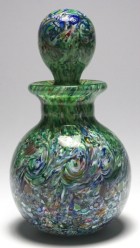 |
| 5995 | Modern St. Louis Cupid Amour Sulphide
Paperweight. dated 1979. This is a
modern St. Louis sulphide paperweight featuring a ceramic image of
cupid set on a opaque red ground and surrounded by a garland of blue
lampwork flowers with millefiori centers and green leaves.
There is an opaque white layer under the red layer which is visible
from the base. The paperweight was issued in a limited edition
of 400 in 1979. It is faceted with a large top facet and six
side facets. It is signed on the base with a millefiori
signature date cane "SL 1979". A great paperweight with
fantastic color. The conceptual design for the paperweight was by Linda Pope-Selman. Gilbert Poillerat sculpted the model for the image of cupid. The sulphide bears the title AMOUR and the initials of the sculptor (GP). Sulphides are cast objects (animals,
flowers, people) made of a ceramic material that has properties
similar to the surrounding glass. They are normally white,
but are also sometimes colored or even painted. The
objects are cast in a mold that copied or made directly from a
medallion, coin or sculpture. The finest French sulphides
are cast in a mold made by a skilled artist. Often a
sulphide will have a silvery appearance due to a thin layer of
trapped bubbles between the glass and the sulphide itself. Cristalleries de Saint Louis was founded in 1767 in Lorraine, which became part of France in 1766. The region was already home to several glassworks. Paperweight production started at St. Louis in 1845 and most likely continued until about 1860. Although the modern production of paperweights started in 1952, the output of millefiori and lampwork paperweights was small. Fewer than 400 lampwork and millefiori paperweights were made between 1952 and 1955. They were not all signed or dated. The most successful product of this early revival period was the Queen Elizabeth sulphide which was made to commemorate her coronation in 1953. After 1955, no additional weights were made at St. Louis until 1965. In 1965 the factory resumed production of lampwork and millefiori paperweights and then in 1967 they began a series of sulphide weights. Finally, in 1970 they started producing annual limited edition paperweights. Gilbert Poillerat (1902 - 1988) was
a French designer, jeweler, and sculptor. He studied at
the École Boulle, graduating in 1921. Initially he worked
in wrought iron for Edgar Brandt doing design and production
work. Later Poillerat branched out to design furniture and
other decorative arts. In 1946 he became a professor at
the École Nationale des Arts Decoratifs. He taught there
for 26 years, all the while continuing his own design output,
collaborating with the likes of André Arbus, Jean Pascaud, and
Vadim Androusov. During the 1950s, Poillerat became
involved in the rediscovery of the art of sulphide paperweights
at Baccarat and St. Louis, contributing to many of the early
modern sulphide paperweights. Large size: Just under 3 1/8" diameter by just under
1 5/8" high. The bottom is ground concave. For extra pictures, click on the picture at the right and the following links: Large picture$295 postage paid in the US. Added 7/7/2023 For more information about paperweights made by the St. Louis factory, see my St. Louis Web Page . (dl-sl-sul) Click on the picture to see a larger image. |
Click
on the picture to see a larger image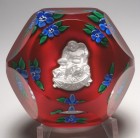 |
| 2999 | Very Early St. Louis 1953 Millefiori
Mushroom Double Overlay Paperweight. dated 1953.
This is one of only a few very early modern St. Louis millefiori
mushroom paperweights. It has a closepacked millefiori design
pulled down to the base to form a mushroom shape. It is signed
and dated with a "SL 1953" millefiori cane in the design. It
has a double overlay of dark blue over light blue and is finished
with a large top facet and five side facets. The base is
ground slightly concave and has a star cutting. This
paperweight is one of the earliest of the modern SL millefiori
mushroom paperweights and was probably made by Paul Gossmann with
guidance from Louis Lutz. A precious addition to any
collection of Saint Louis paperweights. Note on execution: This very early Saint Louis paperweight was made when Saint Louis was exploring the possibility of resuming paperweight production. It should be considered an experiment and is not perfect. The millefiori in the top are smudged and there are some tiny tool marks in the overlay. Paul Gossmann, an 18 year old glass blower at St. Louis, was assigned to try to duplicate the classic designs of the 19th century. Working with Louis Lutz, a retired glassworker from decades earlier, Gossmann experimented with millefiori and with lampwork in 1951 or 1952 and as quality improved made the first overlay paperweights at the end of 1953. His attention was then redirected to the production of sulphide paperweights and the 1953 Queen Elizabeth sulphide. Cristalleries de Saint Louis was
founded in 1767 in Lorraine, which became part of France in
1766. The region was already home to several
glassworks. Paperweight production started at St. Louis in
1845 and most likely continued until about 1860. Although
the modern production of paperweights started in 1952, the
output of millefiori and lampwork paperweights was small.
Fewer than 400 lampwork and millefiori paperweights were made
between 1952 and 1955. They were not all signed or
dated. The most successful product of this early revival
period was the Queen Elizabeth sulphide which was made to
commemorate her coronation in 1953. After 1955, no
additional weights were made at St. Louis until 1965. In
1965 the factory resumed production of lampwork and millefiori
paperweights and then in 1967 they began a series of sulphide
weights. Finally, in 1970 they started producing annual
limited edition paperweights. Large size: 3" diameter by just over 2 3/8"
high. The base is ground slightly concave and has a star
cutting. The paperweight is faceted with one large top facet
and a five side facets. For extra pictures, click on the picture at the right and the following links: Large picture$595 postage paid in the US. Added 7/3/2023 For more information about paperweights made by the St. Louis glass factory in France, see my St. Louis Web Page . Click on the picture to see a larger image. |
Click
on the picture to see a larger image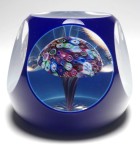 |
| 3222 | Chinese Pedestal Scrambled Millefiori
Paperweight, 1930s. circa 1930. This is a good
example of a Chinese 1930s pedestal form scrambled millefiori
paperweight. It has a great assortment of millefiori canes and
twist canes. Even though this was intended to be a copy of a
French scramble or end of day weight from 1845-1860 (probably St.
Louis or Clichy), the Chinese factory made it in a pedestal form
more common with paperweights from Millville, New Jersey.
Either way, it will not fool today's collectors. Often these
paperweights can be found scratch signed "CHINA" on the base or more
rarely signed with a cane signature, but this example is
unsigned. As with most Chinese
paperweights, this paperweight has a light weight glass mixture
that is high in soda and has a green-yellow tinge. The glass has a
soft oily feel and there are some
light scratches and small nicks. Good color and condition. Note on condition: This paperweight is in very good condition for its age. It has an internal fracture on the base (see pictures) that is solid and is not spreading. It also has minor scratches but other cracks and no chips.
Large size: Just under 2 3/4” diameter by 3
1/4" high. The base is ground concave. For extra pictures, click on the picture at the right and the following links: Large picture$85 postage paid in the US. Added 7/2/2023 For more information about paperweights from China, see my Chinese Paperweights Web Page Click on the picture to see a larger image. Chinese Paperweights were made in the late 1920s and throughout the 1930s as an attempt to duplicate 19th Century antique weights made in the United States and France. Because they are almost 100 years old, they are very collectible and every collector should own a few of these as study pieces. The history of the early Chinese paperweights is mostly anecdotal as no written records have been discovered. The story is that an American dealer sent examples of paperweights made by the New England Glass Company (NEGC), Boston & Sandwich Glass Company (B&S), Millville makers, and French factories to a Chinese factory and requested copies be made. The results are interesting and sometimes confused with the originals by inexperienced collectors. The earliest pictures of these paperweights appeared in the book American Glass Paperweights by Francis Edgar Smith published in 1939. Smith was aware that at least one of the paperweights shown in his book was Chinese. Since Smith was not an expert collector, this indicates that there was some general knowledge that these were Chinese prior to 1939. In the United States, the Tariff Act of 1930 required that every imported item must be conspicuously and indelibly marked in English with its country of origin. As a result, many of these Chinese paperweights are scratch signed on the bottom "CHINA". Many are also not signed, suggesting that either they were imported prior to 1930 or the importer ignored the requirement. Most likely the earliest Chinese paperweights were made prior to 1930. The Chinese makers often combined design features found in paperweights from different makers. For example they copied the latticinio grounds used by New England Glass Company and used them with copies of Baccarat Pansy weights. The original Baccarat pansy paperweights never had a latticinio ground. They copied the pedestal rose from Millville and then used the pedestal bottom with other weights. It is fun to collect all the variations. In general, Chinese paperweights from the 1930s have a light weight glass mixture that is high in soda and has a greenish tinge. The glass also has a soft almost oily feel. Frequently they have bubbles or debris in the glass. And because of their age, many of these have minor scratches or other surface defects. Chinese paperweights made in the 1970s and later usually have better quality glass and are free of debris. |
Click
on the picture to see a larger image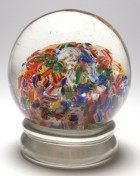 |
| 2797 | Portugal Stylized Floral
Paperweight. circa 1970. Medium paperweight with
stylized flowers. This style is distinctive to Portugal.
The paperweight has four blue and yellow flowers arranged around an
orange four petal flower in the center. The design is placed
over a fine frit ground. Each flower has a carefully placed
bubble in the center. The glass has a slight yellow tint which
may be a reflection from the frit ground. A very colorful
paperweight. Medium size: 2 3/8" diameter by 2 7/16" high.
The base is polished flat. For extra pictures, click on the picture at the right and the following links: Large picture$29 postage paid in the US. Added 7/1/2023 For more paperweights from Portugal and other countries, see my Other Countries Web Page Click on the picture to see a larger image. |
Click
on the picture to see a larger image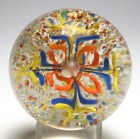 |
| 5636 | Norman Rockwell Triple Self Portrait
Limited Edition Sulphide Paperweight. issued in
1979. This modern sulphide paperweight features a three
dimensional sulphide interpretation of the famous 1960 painting by
Norman Rockwell. In the painting (and also the paperweight),
Rockwell is depicted with a pipe in his mouth painting a
self-portrait while viewing himself in a mirror. Rockwell had
tacked four small images of other self-portraits (by Durer,
Rembrandt, Picasso, and van Gogh) to the canvas, but only three are
shown in the sulphide. He also has sketches of himself in the
upper left corner of the canvas. The design is set on a
translucent turquoise ground. The sulphide was modeled by the
American sculptor and medalist Roger J. Brown who has signed his the
sulphide R. J. Brown twice. It was encased in crystal by an
unnamed glass company for the River Shore company. The
paperweight was issued in a limited edition of 2,500 paperweights,
of which this is number 1,602. It is engraved on the base
"Rockwell's TRIPLE SELF-PORTRAIT by Roger J. Brown © 1979 River
Shore Ltd. ® 1602 / 2500".
The paperweight is faceted with one large top facet and five side
facets and the footed base is star cut. This paperweight was sold under the collectibles brand River Shore, which was one of several companies that offered pieces by Roger J. Brown. I was unable to learn much about River Shore. And I was also unable to uncover which glass company made made it, but it was likely either Baccarat or D'Albret. Both of these companies also produced paperweights for the Franklin Mint during this period. Is it possible that this was a Paul Jokelson project? Sulphides are cast objects (animals,
flowers, people) made of a ceramic material that has properties
similar to the surrounding glass. They are normally white,
but are also sometimes colored or even painted. The
objects are cast in a mold that copied or made directly from a
medallion, coin or sculpture. The finest French sulphides
are cast in a mold made by a skilled artist. Sometimes a
sulphide will have a silvery appearance due to a thin layer of
trapped bubbles between the glass and the sulphide itself. Roger J. Brown (1933-2006) was born
in Jersey City, NJ and originally was in Data Processing with an
MBA from Fairleigh Dickinson University. He started
sculpting in 1963 and created an impressive variety of
figurines, medallions, and busts on many topics. He had
commissions from the Rockwell Society, Westminster Kennel Club,
and others. His work is represented in a number of museums
including the Aviation Hall of Fame, Whitney Museum of American
Art in New York City and the Remington Museum in Ogdensburg, NY. Large size: Just over 2 13/16" diameter by just
under 1 7/8" high. The paperweight is faceted with
one large top facet and five side facets and the footed base is
star cut. For extra pictures, click on the picture at the right and the following links: Large picture$39 postage paid in the US. Added 6/30/2023 For more information about sulphide paperweights, see my Sulphide Paperweights Web Page Click on the picture to see a larger image. |
Click
on the picture to see a larger image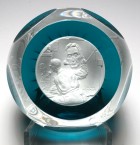 |
| 5516 | Rare Magnum Paolo Venini Closepacked
Millefiori Paperweight. circa 1930-1959. Very
large colorful Paoli Venini closepacked millefiori
paperweight. The design is placed over a clear ground.
Some of the millefiori canes are tipped on their side. This
paperweight has a low profile (see side view). An important
early 20th century paperweight from Murano. Several experts have advised me that this paperweight was made by Paola Venini. Most of his paperweights are not signed, but he also made signed mirrors with millefiori borders containing the same millefiori canes. This paperweight was made on the island of Murano in Venice, Italy. Venetian glass making dates back centuries and the Venetians are given credit for the earliest millefiori canes and paperweights in 1840s. More recently, paperweight making was revived in the 1930s and again in the 1960s. Paolo Venini (1895-1959) was born in Cusano, Italy. As a young man he studied law in Milan. During the first war he was stationed near Venice where he became fascinated with the glass mosaics and stained glass of St. Mark’s cathedral. After the war he began a law practice but soon came under the influence of Venetian art and antiquities dealer Giacomo Cappellin who convinced the young Venini to join him as a business partner in a new Murano glass enterprise in 1921. The firm was incorporated in 1924 as Vetri Soffiati Muranesi Venini Cappelin & Co. The Venini company continued to operate after Paolo's death in 1959 and remains in operation today (2023). Very large size: Just under 4" diameter by
2" high. The base is polished flat. There is the
remnant of the pontil scar on the base. For extra pictures, click on the picture at the right and the following links: Large picture$275 postage paid in the US. Added 6/28/2023 For more information about Murano paperweights, see my Murano Paperweights Web Page . Click on the picture to see a larger image. |
Click
on the picture to see a larger image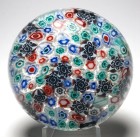 |
| 2643 | Large Faceted Baccarat Limited Edition
Fruit Basket Paperweight. dated 1976.
Classical design with a lampwork basket of fruit set over an opaque
white milk glass ground. The basket is filled with luscious
strawberries with leaves attached. It is signed with a
Baccarat signature cane "B 1976" and also signed again on the base
with the Baccarat logo. The paperweight is faceted with a
large concave top facet and six smaller concave side facets.
Perfect execution.
This design was produced only in 1976 in a limited edition of 300 paperweights. This is number 57 in that series. There is a signature cane "B 1976" shown in the pictures. The base has the acid etched Baccarat logo plus it is engraved with the year (1976), the edition number (57) and the size of the series (300). It is unusual to find a Baccarat paperweight with a white opaque ground as they produced very few designs with this choice of ground. It works perfectly as a contrast to the delicate fruit basket. Baccarat originally suggested a retail price of $3,542 for this paperweight, but my price is much lower. Large size: 3 1/16" diameter by 1 7/8" high. The
base is polished flat. Faceted with a large top facet and
six side facets. All the facets are concave. For extra pictures, click on the picture at the right and the following links: Large picture
$295 postage paid in the US. Added 6/24/2023 For more information about Baccarat paperweights, see my Baccarat Paperweights Web Page. Click on the picture to see a larger image. Baccarat was founded in 1776 in Alsace-Lorraine with the name of Verrerie de Sainte Anne. The original location was near the town of Baccarat. Today the firm is known as Compagnie des Cristalleries de Baccarat. Most collectors refer to three periods of Baccarat paperweight production.
In 1952, Paul Jokelson approached Baccarat with the idea of making sulphide paperweights again. In 1953 Baccarat resumed paperweight production with a series of sulphide paperweights the first of which were the unsuccessful Eisenhower sulphide followed by the Queen Elizabeth coronation sulphide. Millefiori paperweight production was resumed in 1957 and lampwork paperweights were re-introduced in the early 1970s. Baccarat stopped making this type of fine glass paperweights in 2002. You can read more about the Baccarat paperweights in the new book Baccarat Paperweights - two centuries of beauty by Paul Dunlop or one of the older books on paperweights in general, such as The Encyclopedia of Glass Paperweights by Paul Hollister or World Paperweights by Robert Hall. |
Click
on the picture to see a larger image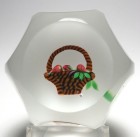 |
| 5896 | Large St. Louis 1980 Pansy on Lace Ground
Limited Edition Paperweight with Fancy Cutting. dated
1980. This dramatic St. Louis paperweight has a large lampwork
pansy with leaves and stem set on a white lace ground. The
pansy has two dark blue upper petals, and three yellow lower
petals. In the center of the flower is a complex millefiori
cane. Each lower petal has three dark lines (crows feet)
radiating from the central cane. There is a large top facet
and a fancy side cutting with 18 side cuts. It is signed with
a complex signature cane "SL 1980" on the base. The
paperweight was issued in a limited edition of 400 paperweights of
which 250 were reserved for American collectors. A wonderful
addition to any collection of St. Louis paperweights. Note: This paperweight was issued in a limited edition of 400 paperweights of which 250 were reserved for American collectors. The original issue price in 1980 was $450. Cristalleries de Saint Louis was
founded in 1767 in Lorraine, which became part of France in
1766. The region was already home to several
glassworks. Paperweight production started at St. Louis in
1845 and most likely continued until about 1860. Although
the modern production of paperweights started in 1952, the
output of millefiori and lampwork paperweights was small.
Fewer than 400 lampwork and millefiori paperweights were made
between 1952 and 1955. They were not all signed or
dated. The most successful product of this early revival
period was the Queen Elizabeth sulphide which was made to
commemorate her coronation in 1953. After 1955, no
additional weights were made at St. Louis until 1965. In
1965 the factory resumed production of lampwork and millefiori
paperweights and then in 1967 they began a series of sulphide
weights. Finally, in 1970 they started producing annual
limited edition paperweights. Large Size: 3 1/16" diameter by 1 13/16"
high. The base is ground concave. The paperweight is
faceted with one large top facet and a fancy side cutting with 18
side cuts. For extra pictures, click on the picture at the right and the following links: Large pictureSOLD. Added 6/22/2023 For more information about paperweights made by the St. Louis glass factory in France, see my St. Louis Web Page . Click on the picture to see a larger image. |
Click
on the picture to see a larger image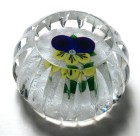 |
| 5920 | Modern Chinese Pink Rose
Paperweight. circa 2000. This is a modern Chinese
pink rose paperweight with 16 pink colored petals and three green
leaves. The petals are arranged in four rings in an
approximate 4+4+4+4 pattern. The base is polished flat and is
almost circular. A great example of a modern Chinese lampwork
rose.
Unlike the 1930s copies of Millville crimp roses, this example thin petals and appears to be a lampwork assembly. Lampwork flowers are assembled at a hot torch (lamp) before being encased in glass. Crimp roses are made by a more difficult process that creates the rose in a single step using a metal crimp. Chinese Paperweights were
made in the late 1920s and throughout the 1930s as an attempt to
duplicate 19th Century antique weights made in the United States
and France. Because they are almost 100 years old, they
are very collectible and every collector should own a few of
these as study pieces. The history of the early Chinese
paperweights is mostly anecdotal as no written records have been
discovered. The story is that an American dealer sent
examples of paperweights made by the New England Glass Company
(NEGC), Boston & Sandwich Glass Company (B&S), Millville
makers, and French factories to a Chinese factory and requested
copies be made. The results are interesting and sometimes
confused with the originals by inexperienced collectors.
The earliest pictures of these paperweights appeared in the book
American Glass Paperweights by Francis Edgar Smith
published in 1939. Smith was aware that at least one of
the paperweights shown in his book was Chinese.
Since Smith was not an expert collector, this indicates that
there was some general knowledge that these were Chinese prior
to 1939. Chinese paperweights continued to be made
throughout the 20th century and now into the 21st century with
greatly improved quality. Size: 2 11/16” diameter by just over 2 1/2"
high. The base is polished flat. For extra pictures, click on the picture at the right and the following links: Large picture $29 postage paid in the US. Added 6/22/2023 For more paperweights from China, see my Chinese Paperweights Web Page. Click on the picture to see a larger image. |
Click
on the picture to see a larger image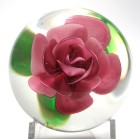 |
| 5596 | Perthshire PP46 Club Pattern Closepack
Millefiori Paperweight. circa 1981-1985. This
Perthshire millefiori paperweight has a closepack design in the
shape of a club in the center with a club shaped border of identical
amber and white canes. The design is set on a translucent
green ground with a garland of green and white canes on the
outside. It is signed on the base with Perthshire's complex
"P" signature cane. It also has its original worn Perthshire
paper label "PERTHSHIRE PAPERWEIGHTS CRIEFF SCOTLAND" on the
base. The paperweight has one large top facet. Every
collector should have one of these. The PP46 was made with a Club design from 1981 to 1985. It was also made as a Heart (1981-1999), Diamond (1981-1986), and Spade (1981-1985). Perthshire was a small company in Crieff, Scotland that was devoted to the creation of quality glass paperweights. They stopped production in January 2002 after more than 30 years of production. Their paperweights were consistently high in quality and yet remained reasonable in price. The birth of Scottish paperweight making is credited to the glass making family of Salvador Ysart, who moved to Crieff, Scotland in 1922. They worked first at John Moncrieff Ltd and made the earliest Scottish paperweights during that period. In 1946 Salvadore and his sons Augustine and Vincent founded Ysart Brothers Glass and produced glass wares under the Vasart label. Salvador Ysart died in 1955 The company name was later changed to Vasart Glass. Stuart Drysdale was hired manage the business side of the enterprise in 1960. The company evolved into a new company Strathearn owned by Teachers Whiskey. In 1967 Drysdale was sent a magazine article on antique paperweights (Woman's Day, July 1965). The inspired him to try to produce weights comparable to the French antiques. With this goal in mind, he and several of the glass workers left Strathearn to found Perthshire in 1968. Size: 2 9/16" diameter by just under 1 11/16" high.
The base is ground concave. There is one large top
facet. For extra pictures, click on the picture at the right and the following links: Large pictureSOLD. Added 6/19/2023 For more information about Perthshire Paperweights, see my Perthshire Web Page. Click on the picture to see a larger image. |
Click
on the picture to see a larger image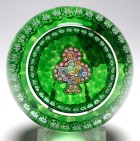 |
| 5616 | Perthshire Annual Collection 1982C Limited
Edition Magnum Millefiori Garland Paperweight. circa
1982. This extra large paperweight features a white six
petaled flower surrounded by six millefiori clusters. Each
cluster consists of two rings of complex canes around a central
cane. The design is closely arranged over a translucent ruby
ground. It is signed on the base under the flower with a "P
1982" signature cane. There is also a paper label "PERTHSHIRE
PAPERWEIGHTS CRIEFF SCOTLAND". The edition size was set at
300, but only 165 were made. A magnificent paperweight.
The Perthshire Annual Collection Paperweights were special limited edition designs that offered one year only. Each year's editions were lettered to indicate this special status. In 1982 they made eight special designs designated A through H. This design was designated 1982C. These were the top of the Perthshire line. Perthshire was a small company in Crieff, Scotland that was devoted to the creation of quality glass paperweights. They stopped production in January 2002 after more than 30 years of production. Their paperweights were consistently high in quality and yet remained reasonable in price. The birth of Scottish paperweight making is credited to the glass making family of Salvador Ysart, who moved to Crieff, Scotland in 1922. They worked first at John Moncrieff Ltd and made the earliest Scottish paperweights during that period. In 1946 Salvadore and his sons Augustine and Vincent founded Ysart Brothers Glass and produced glass wares under the Vasart label. Salvador Ysart died in 1955 The company name was later changed to Vasart Glass. Stuart Drysdale was hired manage the business side of the enterprise in 1960. The company evolved into a new company Strathearn owned by Teachers Whiskey. In 1967 Drysdale was sent a magazine article on antique paperweights (Woman's Day, July 1965). The inspired him to try to produce weights comparable to the French antiques. With this goal in mind, he and several of the glass workers left Strathearn to found Perthshire in 1968. Very large size: Just over 3 1/8" diameter by 2
1/4" high. The base is hollow ground. For extra pictures, click on the picture at the right and the following links: Large picture$395 postage paid in the US. Added 6/18/2023 For more information about Perthshire Paperweights, see my Perthshire Web Page. Click on the picture to see a larger image. |
Click
on the picture to see a larger image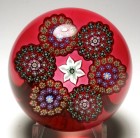 |
| 5238 | Mdina Glass Swirl Paperweight with Knob /
Handle. circa 1968-1985. Wonderful paperweight
with a dark swirling interior of green, blue, brown, white, and
other colors. The paperweight has a knob or handle on
top. The knob has some swirls of amber glass plus bits of
white glass in it. Made on the island of Malta in the
Mediterranean Sea. It is signed "Mdina"in script on the base. Note on condition: This paperweight has two popped bubbles on the surface of the glass. They are not damage, but I am mentioning them for completeness. The larger of the bubbles is shown in one of the pictures. Mdina Glass was founded on the Island of Malta in 1968 by Michael Harris (1933-1994) and Eric Dobson with financial incentives and the encouragement of the Maltese government. Initially it was called the Maltese Glass Industries, but the name was changed to Mdina Glass shortly later. Michael Harris received his training in glass at several institutions graduating from the Royal College of Art in London in 1959. He later became an RCA tutor setting up hot glass facilities there in 1967. He was a pioneer of the studio glass movement in the UK. Eric Dobson was also at the Royal College of Art. Mdina Glass was a successful venture and gave rise to a significant glass craft industry on the Island of Malta. Michael Harris left Malta in 1972 to establish Wight Glass in the UK. In 1971, two Italian maestros, the father and son team of Vincente and Ettore Boffo joined Mdina Glass to introduce Italian glassmaking techniques. Eric Dobson continued until about 1985 working with the local glass artists that he and Michael had trained. Eventually Mdina Glass was taken over by Joseph Said, a Maltese glassworker who had trained at Mdina. For context, during this period Malta gained independence from Britain in 1964 after 150 years as a British colony. In 1974 it became the Republic of Malta, and in 2004 joined the European Union. Size: Just under 2 1/2" diameter by 3 7/16"
high. The bottom is polished flat.. For extra pictures, click on the picture at the right and the following links: Large picture $45 postage paid in the US.
Added 3/19/2023 For more information about paperweights from England, see my English Paperweights Web Page.
Click on the picture to see a larger image. |
Click
on the picture to see a larger image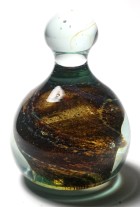 |
| 5248 | Perthshire Annual Collection 1975B Limited
Edition Penguin Paperweight. circa 1975. This
magnum sized paperweight features a penguin inside a hollow
paperweight with a translucent blue flash overlay. The penguin
is standing on a small ice floe; the translucent blue overlay
represents the cold blue sea. This is one of a series of
hollow weights each with a different animal. The translucent
blue overlay is faceted with one large top facet and 16 side facets
(eight large and eight smaller facets). It is signed with a
"P" signature cane on the base of the ice flow. It also has
its original Perthshire paper label "PERTHSHIRE PAPERWEIGHTS CRIEFF
SCOTLAND" on the base. It comes with its original certificate
identifying this as #213 out of a limited edition of 350 weights, of
which 316 actually made. A wonderful paperweight that sparkles
like iced water.
The hollow weights like this are one of the favorites of collectors since they are so difficult to make. This paperweight is a joy to examine. Perthshire made this paperweight as one of their annual collection items for 1975. This means the design was made only that one year and never again. There were five annual collection designs in 1975, designated A through E. This design is 1975B. It was limited to a maximum of 350 paperweights, of which only 316 were actually made. The annual collection paperweights are the most desirable of the Perthshire line, with the exception of one of one items. Perthshire was a small company in Crieff, Scotland that was devoted to the creation of quality glass paperweights. They stopped production in January 2002 after more than 30 years of production. Their paperweights were consistently high in quality and yet remained reasonable in price. The birth of Scottish paperweight making is credited to the glass making family of Salvador Ysart, who moved to Crieff, Scotland in 1922. They worked first at John Moncrieff Ltd and made the earliest Scottish paperweights during that period. In 1946 Salvadore and his sons Augustine and Vincent founded Ysart Brothers Glass and produced glass wares under the Vasart label. Salvador Ysart died in 1955 The company name was later changed to Vasart Glass. Stuart Drysdale was hired manage the business side of the enterprise in 1960. The company evolved into a new company Strathearn owned by Teachers Whiskey. In 1967 Drysdale was sent a magazine article on antique paperweights (Woman's Day, July 1965). The inspired him to try to produce weights comparable to the French antiques. With this goal in mind, he and several of the glass workers left Strathearn to found Perthshire in 1968. Magnum size: 3 1/8" diameter by 2 9/16" high.
It is faceted with one large top facet and 16 side facets (eight
large and eight smaller facets). The base is polished
flat. For extra pictures, click on the picture at the right and the following links: Large picture$435 postage paid in the US. Added 3/18/2023. For more information about Perthshire Paperweights, see my Perthshire Web Page. Click on the picture to see a larger image. |
Click
on the picture to see a larger image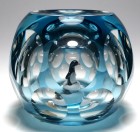 |
| 5968 | Francis Whittemore Miniature Faceted Pink
Crimp Rose Upright Pedestal Paperweight. circa
1970. This miniature upright pedestal paperweight features a
magnificent pink crimp rose with twelve variegated pink petals and
four upturned green sepals. The petals are arranged in
Whittemore's 3+3+3+3 crimp pattern. It is signed on the
underside of the rose with an early Whittemore signature cane.
The signature cane has a black "W" on a yellow background. The
design is set on a clear ground and supported by a pedestal
base. It is faceted with one large top facet and five side
facets. A fantastic addition to any collection of glass
paperweights. Francis Dyer Whittemore, Jr. is considered one of the pioneers of the modern paperweight renaissance. He started working in glass in 1938, originally as a scientific glass maker and instructor in South Jersey. He did not start making paperweights until 1962 when he set up a studio in Lansdale, Pennsylvania. For five years, he spent one month a year consulting at Baccarat to help them refine their lampwork paperweight art. Some sources have this consulting work from 1971 to 1976. Other sources have it starting later. The signature cane used on this paperweight was one he developed prior to working at Baccarat. Most of his paperweights are miniature to medium in size. You can read about Francis Whittemore in the book American Glass Paperweights and Their Makers by Jean Melvin (1970). Miniature size: 1 5/8" diameter by 2 3/16" high. The base of the pedestal has a 1 5/8" diameter. The bottom is ground slightly concave.Signature: Signed on the underside of the rose with an early Whittemore signature cane. The cane has a black "W" on a yellow background. Condition: Excellent condition. No chips, cracks, or scratches found on inspection. For extra pictures, click on the picture at the right and the following links: Large picture$395 postage paid in the US. Added 3/15/2023 For more paperweights by contemporary American paperweight
makers, see my Contemporary
American Paperweights Web Page. (dl-ca-va) |
Click
on the picture to see a larger image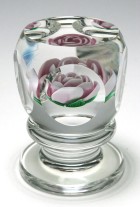 |
| 5227 | Charles Kaziun Jr. Miniature Tilted
Pedestal White Spider Lily Paperweight with Cobalt Blue Aventurine
Ground. circa 1960-1980. This is a miniature
pedestal paperweight with a white spider lily and four green leaves
on an opaque cobalt blue aventurine ground. The flower has a
six sided yellow millefiori center with a red flare over each
petal. Each leaf is a double leaf - two leaves with a clear
layer joining them so a bit of the ground shows through. This
makes it look like each leaf has an aventurine stripe down the
center. The aventurine ground is set on a cobalt blue
under-layer. The paperweight is tilted at a 45 degree angle so
it displays beautifully. Signed on the white underside of the
ground with a gold K. A great addition to any collection of
Kaziun paperweights. Note: Please note that the base on this paperweight
is slightly larger than the typical Kaziun #1. Charles Kaziun Jr. was one of the most famous of the American paperweight artists. He is often credited with contributing to the rebirth of interest in paperweight making. He made paperweights from the 1940s until his death in 1992. His weights are usually signed with a gold K or a special millefiori cane containing a K. You can read about him in many books, including:
Signature: Signed on the underside of the blue ground with Kaziun's gold K. Condition: Excellent condition with no chips, cracks, or scratches found on inspection. For extra pictures, click on the picture at the right and the following links: Large picture$295 postage paid in the US. Added 3/15/2023 For more paperweights by Charles Kaziun, see my Kaziun Paperweights Web Page. (dl-kaz-ca) Click on the picture to see a larger image. |
Click
on the picture to see a larger image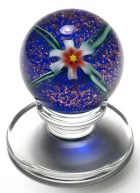 |
| 5592 | Perthshire 1979 PP11 Limited Edition Large
Spaced Millefiori Paperweight with Picture Canes and
Certificate. dated 1979. This is a large
limited edition spaced millefiori paperweight with twelve mostly
complex millefiori canes plus a complex signature date cane.
There are four colored picture canes, a rooster, kangaroo,
butterfly, and cat. The ground is a white lace. More
properly, this could also be considered a spaced concentric design
as there are eight millefiori canes in the outer ring and four
millefiori picture canes in the inner ring, arranged around a
central signature cane. The paperweight is signed with a
"P1979" date cane in the center of the design. This particular
version of the PP11 with silhouette or picture canes and a hollow
ground base was made from 1975 to 1982. This paperweight comes
with its original (worn) certificate stating that it is edition
number 330 in a limited edition of 400 paperweights. It does
not have a paper label. A great example with a nice assortment
of complex canes and picture canes. The Perthshire PP11 design was made from 1969 to 1992, although the design changed several times over the years. Those made from 1972 to 1982 have one or more silhouette or picture canes. Before 1972 there were no silhouette canes. Starting in 1983 to 1990, an outer ring of millefiori canes was added. In 1991 and 1992 the design changed again. The base also changed over the years. PP11s made from 1969 to 1974 have a flat polished base. Those made starting in 1975 have a hollow ground base. Perthshire was a small company in Crieff, Scotland that was devoted to the creation of quality glass paperweights. They stopped production in January 2002 after more than 30 years of production. Their paperweights were consistently high in quality and yet remained reasonable in price. There are three books on Perthshire Paperweights. If you collect Perthshire paperweights, you should have them in your library. The birth of Scottish paperweight making is credited to the glass making family of Salvador Ysart, who moved to Crieff, Scotland in 1922. They worked first at John Moncrieff Ltd and made the earliest Scottish paperweights during that period. In 1946 Salvadore and his sons Augustine and Vincent founded Ysart Brothers Glass and produced glass wares under the Vasart label. Salvador Ysart died in 1955 The company name was later changed to Vasart Glass. Stuart Drysdale was hired manage the business side of the enterprise in 1960. The company evolved into a new company Strathearn owned by Teachers Whiskey. In 1967 Drysdale was sent a magazine article on antique paperweights (Woman's Day, July 1965). The inspired him to try to produce weights comparable to the French antiques. With this goal in mind, he and several of the glass workers left Strathearn to found Perthshire in 1968. Large Size: Just over 2 15/16" diameter by 2 1/4"
high. The base is hollow ground. For extra pictures, click on the picture at the right and the following links: Large picture$265 postage paid in the US. Added 2/20/2023 For more information about Perthshire Paperweights, see my Perthshire Web Page. Click on the picture to see a larger image. |
Click
on the picture to see a larger image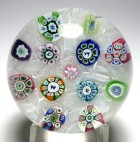 |
| 1603 | Antique Franchini Type Aventurine Venetian
Murine Paperweight Scent Bottle. circa 1840-1880.
This rare Franchini type miniature Venetian scent bottle has two
early murrine canes. On the front is a murrine of a
gondola. The murrine on the back depicts a winged lion on
water, or the Lion of St. Mark. This murrine has a small
fracture in the cane. The six-sided shape is similar to known
scent bottles made by Giacomo Franchini. The glass is filled
with aventurine and colored swirls. It is in very good
condition aside from the fractured murrine and has normal age
appropriate wear. There are also small fractures on the
neck. It does not have its original stopper and hinged
cap. Most likely it also originally had a chain. Despite
the similarity to known Franchini items, I am selling this as
"Franchini Type" as other glass artisans of the period probably
copied the work of the Franchini workshop. For comparable images, see the following pages in Miniature Masterpieces - Mosaic Glass 1838-1924 by Giovanni Sarpellon. A similar six-sided scent bottle appears in figure 520 on page 57. Similar gondola murrine appear in figures 425-439 on page 47. The lion of St. Mark appears in figure 422 on page 46. Note on condition: The scent bottle has several flaws. The cane of the Lion of St. Mark has a small fracture. There are also small fractures on the neck. The scent bottle does not have its original stopper, hinged cap, or chain. It also has age appropriate wear. Giacomo (Jacopo) Franchini (1827-1897) worked with his father Giovanni Battista Franchini (1804-1873) on the development of millefiori canes incorporating figurative designs as well as floral patterns. His is best known for his miniature portraits of the famous people of his time. He produced some of the most remarkable glass portraits and many were incorporated into scent bottles, walking stick handles and other objects, some useful and some purely decorative. His creative period ended in 1863 when he was confined to an asylum. For more details on the remarkable work produced by the Franchini family and others of the period, see the book Miniature Masterpieces - Mosaic Glass 1838-1924 by Giovanni Sarpellon. Miniature size: Just over
2 3/8" tall by just under 15/16" wide by 11/16" thick..
It weighs two ounces. The base is ground flat. For extra pictures, click on the picture at the right and the following links: Large picture$395 postage paid in the US. Added 2/19/2023 For more information about antique paperweights see my Antique Paperweights Web Page. (dl-ant-mur) Click on the picture to see a larger image. |
Click
on the picture to see a larger image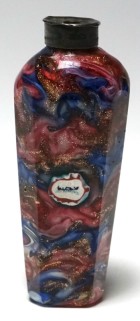 |
| 1938 | Vasart / Lassman Concentric Millefiori
Paperweight Handle Corkscrew. circa 1950s-1960s.
This corkscrew has a concentric millefiori paperweight handle.
The firm of Lassman & Co. designed and produced this corkscrew
and a variety of other useful objects during the 1950s and
1960s. The attractive millefiori paperweight handle was made
by the Ysart family of Scotland under the Vasart label. The
handle has a two ring concentric millefiori pattern. The
design is set on an opaque white ground. The chrome plated
metal screw part and other hardware were made by Lassman and the
assembly was also done by them. A fun collectible. The maker of this item was Lassman & Co. located in the Kilburn area of North London. Samuel Lassman purchased the paperweight handles from George Dunlop's Pirelli Glass in London. Pirelli obtained them from Vasart. Pirelli also took some assembled inventory back from Lassman and sold the barware items under the Pirelli label. Pirelli also included the line in their 1959 catalog. For more information, see my web page on Lassman & Co. or the article by Angela Bowey and Allan Port “Pirelli, Vasart and the Ysart Family” in the Paperweight Collectors Association Inc. Annual Bulletin 2015. The barware line was sold individually and also in complete box sets. Lassman also made a line of large industrial sized corkscrews - called packing gland extractors and used for servicing nautical applications that required a waterproof seal. The birth of Scottish paperweight making is credited to the glass making family of Salvador Ysart, who moved to Crieff, Scotland in 1922. They worked first at John Moncrieff Ltd and made the earliest Scottish paperweights during that period. In 1946 Salvadore and his sons Augustine and Vincent founded Ysart Brothers Glass and produced glass wares under the Vasart label. Salvador Ysart died in 1955 The company name was later changed to Vasart Glass. Stuart Drysdale was hired manage the business side of the enterprise in 1960. The company evolved into a new company Strathearn owned by Teachers Whiskey. In 1967 Drysdale was sent a magazine article on antique paperweights (Woman's Day, July 1965). The inspired him to try to produce weights comparable to the French antiques. With this goal in mind, he and several of the glass workers left Strathearn to found Perthshire in 1968. Size: 1 7/16" diameter. With the metal
hardware, it is 4 3/8" long. For extra pictures, click on the picture at the right and the following links: Large picture$79 postage paid in the US. Added 2/5/2023 For more information about paperweights made by Scottish makers, see my Scottish Paperweights Web Page Click on the picture to see a larger image. |
Click
on the picture to see a larger image |
| 1297 | Antique Green and White Jasper Ground
Paperweight. circa 1845-1890. This is
an unusual antique jasper ground paperweight - unusual in that there
is no other motif present. Normally we find a jasper ground
paperweight with a flower or a millefiori pattern. It could be
a practice piece made by a glass worker learning how to create a
jasper ground, or it could be that the flower or design wasn't ready
when it needed to be picked up. I don't know which factory
made it. Among antique American paperweight makers, both the
New England Glass Company and the Boston and Sandwich Glass Company
made floral paperweights with jasper grounds. In France, St.
Louis made jasper ground paperweights during the classic period
(1845 - 1860). Other factories probably did as well. So
the origin remains a mystery, but I think it is likely to have been
made at the New England Glass Company (NEGC). A colorful
example that you will keep on your desk and use as - a paperweight. Large Size: 2 3/4" diameter by 1 3/4" high. The base
is ground concave with a pontil scar remaining. For extra pictures, click on the picture at the right and the following links: Large picture$85 postage paid in the US. Added 2/4/2023 For more information about antique paperweights see my Antique Paperweights Web Page. Click on the picture to see a larger image. |
Click
on the picture to see a larger image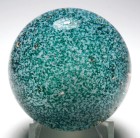 |
| 4693 | Charles Kaziun Jr. Miniature Pink Sandwich
Rose Tilted Pedestal Paperweight with Torsade. circa
1960-1980. This is a marvelous miniature tilted pedestal
paperweight with pink sandwich rose and an outer white twist
torsade. The rose has three sepals, two longer leaves and a
green stem. At the base of the stem is bit of aventurine,
perhaps intended as a ribbon. The design is set on an opaque
aqua ground. The paperweight is tilted at a 45 degree angle so
it displays beautifully. Signed on the underside of the ground
with a gold foil K. A great addition to any collection of
Kaziun paperweights. Kaziun called this style of rose a Sandwich rose. He was inspired by the tiny roses found in antique basket of roses paperweights made by the Boston & Sandwich Glass Company. It is also called a rope rose. The rose is made with a tiny molten glass rod. Note: Please note that this is slightly larger than
the typical Kaziun #1. I have been referring to this size as
a #2. Charles Kaziun Jr. was one of the most famous of the American paperweight artists. He is often credited with contributing to the rebirth of interest in paperweight making. He made paperweights from the 1940s until his death in 1992. His weights are usually signed with a gold K or a special millefiori cane containing a K. You can read about him in many books, including: Signature: Signed on the underside of the aqua ground with Kaziun's gold K. Condition: Excellent condition with no chips or cracks. For extra pictures, click on the picture at the right and the following links: Large picture$375 postage paid in the US. Added 2/2/2023 For more paperweights by Charles Kaziun, see my Kaziun Paperweights Web Page. (dl-kaz-ca) Click on the picture to see a larger image. |
Click
on the picture to see a larger image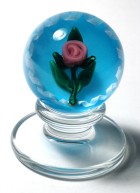 |
| 5257 | Rare Magnum Joe St. Clair Pink Crimp Rose
Paperweight with Twenty Petals. circa 1960-1980.
This is a delicate pink crimp rose with twenty petals plus a center
stamen (or pistil). The petals are arranged in Joe St. Clair's
five row 4+4+4+4+4 crimp pattern and placed over a four leaf shaped
green ground. It is signed on a polished flat base with
indented letters "JOE ST CLAIR". This may be engraved or
machined rather than hot stamped. This is a fancier signature
than the hot stamped signature that Joe used on most
paperweights. A flashy paperweight with great color and
execution. Crimp roses represent the ultimate challenge for paperweight makers. You can read about the crimps and their use in making crimp roses in the book American Glass Paperweights and Their Makers by Jean Melvin (1970). The St. Clair line (as far as paperweights are concerned) started with John "Pop" St. Clair, Sr. who worked at the George MacBeth Glass Works in Elwood from around 1903 to 1938. Local natural gas production faltered in 1938 and the St. Clairs began to develop their ideas for a new business of their own. Joe St. Clair (1909 - 1987) did the original experimentation and the business was formally started in 1941 in Elwood, Indiana. John, Sr. and the brothers John, Jr., Joe, Ed and Bob all participated, while another brother, Paul, did not at first. By 1944 St. Clair paperweights were being sold through Georg Jensen on Fifth Avenue in New York. Joe retired (the first time) in 1971 and sold the factory to new owners in Elwood, Indiana. About the same time, Bob St. Clair and his wife Maude opened a new factory in Elwood. Paul St. Clair retired from General Motors and joined Bob, along with Ed St. Clair and a nephew, Joe Rice. Sometime later after Bob opened his factory, the new owners of the original factory sold the factory back to Joe. So, for a while, there were two St. Clair Glass factories. Bob St. Clair died in 1986. Joe St. Clair died in 1987. Ed St. Clair died in 1989 and the last brother, Paul St. Clair died in 2000. Very large size: Just under 3 1/2” diameter by 3
3/8” high. The base is polished flat. It weighs just
over two pounds. For extra pictures, click on the picture at the right and the following links: Large pictureSOLD. Added 1/2/2023 For more information about paperweights made by the St. Clair factory, see my St. Clair Paperweights Web Page Click on the picture to see a larger image. |
Click
on the picture to see a larger image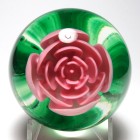 |
| 5492 | Early Large Michael O'Keefe Silver Veiled
Underwater Translucent Paperweight. dated 1988.
This disk shaped paperweight consists of a multi-layered veiled
design of transparent pale amber and clear colored glass. The
design shows a blue tint when turned in the light. It is
possible to imagine a stylized undersea anemone or animal. The
silver veiling technique used allows the glass to react to light and
create a fluid, underwater effect. This is an early O'Keefe
paperweight and is signed on the oval base “MJ O'Keefe ©
6/88”. A wonderful large paperweight from this influential
early glass artist. This paperweight has a precise translucent design was difficult to photograph. The "veil" effect created by using a metallic powder in the glass. The veiling technique was first developed by Dominic Labino who worked back in the early 1970s. Later it was used by Harvey Littleton (1980) and Ed Nesteruk in 1982. O'Keefe adopted the technique a little later. This paperweight is dated 6/88. Michael J. O'Keefe has a BFA from the Center of Creative Studies, Detroit, MI. He has also studied at the Penland School of Craft, Penland, NC (with Paul Stankard) and at the Pratt Fine Arts Center, Seattle, WA (with Stephen Dale Edwards). He has had his own studio Michael O'Keefe Glass since 1983. His early paperweights, such as this one, use the silver veiling technique. Large size: Just under 4 3/4" wide by 4 3/16" high
by 1 1/2" thick. It is disk shaped with a flat oval
base. The back is polished flat in the center. It
weighs just under two pounds. For extra pictures, click on the picture at the right and the following links: Large pictureSOLD. Added 1/30/2023 For more paperweights by contemporary American paperweight makers, see my Contemporary American Paperweights Web Page. Click on the picture to see a larger image. |
Click
on the picture to see a larger image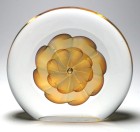 |
| 5889 | Peter McDougall (PMcD) 2004 Collection
Double Overlay Butterfly and Red Bouquet Paperweight. circa
2004. This rare green and white double overlay
paperweight features a floral design with a butterfly hovering
amidst a bouquet of four red flowers with three, four, and five
petals. Peter McDougall said the flowers are pink, but they
look red to me. The butterfly has a pink body, yellow head,
black antennae, and green and white millefiori wings. The
flowers have millefiori centers and green leaves and stems.
This was a part of Peter's 2004 Collection. It is a limited
edition paperweight limited to 30 paperweights. It is signed
in the design with Peter's complex signature cane "PMcD" and is also
engraved on the edge of the base with the edition number
18/30. The paperweight is faceted with one large top facet and
twelve side facets (six large and six smaller). A special
paperweight for the collector seeking unique paperweights. This paperweight was one of the 2004 Collection Paperweights from Peter McDougall. The design was limited to 30 paperweights. Peter McDougall started his glassmaking career as an apprentice at Strathearn Glass in Crieff, Scotland back in the 1960s. When Perthshire was formed in 1968, he left Strathearn to move to Perthshire and worked there in many positions, eventually becoming Manager and Chief Glassmaker. Perthshire Paperweights closed early in 2002 after the death of the owner Neil Drysdale. Peter McDougall then made high quality glass paperweights at his own glass studio, PMcD Glass Studio Ltd. in Crieff, Scotland from 2002 until early 2012. The studio is now closed but Peter plans to continue to make a limited number of paperweights in the future. Large Size: 3 1/8" diameter by 2 1/4" high.
The base is ground concave. This paperweight is faceted with
one large top facet and twelve side facets (six large and six
smaller). For extra pictures, click on the picture at the right and the following links: Large picture$435 postage paid in the US. Added 1/30/2023 For more information about paperweights made by Peter McDougall, see my Peter McDougall Web Page Click on the picture to see a larger image. |
Click
on the picture to see a larger image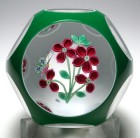 |
| 4457 | Chinese Aquarium Paperweight with Two Fish
and Foliage. circa 1930. This is a Chinese
invention. It is intended to be placed in an aquarium
along with the rocks and plants. The paperweight has two blue
and red fish plus an orange plant. It is roughly cube shaped
with rounded edges. Novelty items like this started appearing
in the US in the 1930s and some were sold at the 1939 World's
Fair. This is a fun collectible. Chinese Paperweights were made in the late 1920s and throughout the 1930s as an attempt to duplicate 19th Century antique weights made in the United States and France. Because they are almost 100 years old, they are very collectible and every collector should own a few of these as study pieces. The history of the early Chinese paperweights is mostly anecdotal as no written records have been discovered. The story is that an American dealer sent examples of paperweights made by the New England Glass Company (NEGC), Boston & Sandwich Glass Company (B&S), Millville makers, and French factories to a Chinese factory and requested copies be made. The results are interesting and sometimes confused with the originals by inexperienced collectors. The earliest pictures of these paperweights appeared in the book American Glass Paperweights by Francis Edgar Smith published in 1939. Smith was aware that at least one of the paperweights shown in his book was Chinese. Since Smith was not an expert collector, this indicates that there was some general knowledge that these were Chinese prior to 1939. Chinese paperweights continued to be made throughout the 20th century and now into the 21st century with greatly improved quality. In the United States, the Tariff Act of
1930 required that every imported item must be conspicuously and
indelibly marked in English with its country of origin. As
a result, many of these Chinese paperweights are scratch signed
on the bottom "CHINA". Many are also not signed,
suggesting that either they were imported prior to 1930 or the
importer ignored the requirement. Most likely the earliest
Chinese paperweights were made prior to 1930. In general,
Chinese paperweights from the 1930s have a light weight glass
mixture that is high in soda and has a greenish tinge. The glass
also has a soft almost oily feel. Frequently they have
bubbles or debris in the glass. And because of their age,
many of these have minor scratches or other surface
defects. Chinese paperweights made in the 1970s and later
usually have better quality glass and are free of debris.
Size: 1 3/8" by 1 3/8" by 1 1/2" high. All of
the edges are rounded. The base is fire finished with the
remnant of a pontil mark. For extra pictures, click on the picture at the right and the following links: Large picture$45 postage paid in the US. Added 1/23/2023 For more paperweights from China, see my Chinese Paperweights Web Page. Click on the picture to see a larger image. |
Click
on the picture to see a larger image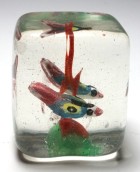 |
| 2187 | Miniature Red Crimp Rose Paperweight -
Unknown American Maker. This paperweight features a
tiny fifteen petal red crimp rose. The crimp pattern is
4+4+4+3 for a total of 15 petals. There are four green leaves
underneath. It is unsigned and I don't know who made it.
Three of the outer petals are missing some of the red color and the
underlying white shows instead. Two of the green leaves are
also missing some of their color. The design is off
center. There are bubbles in the glass. Please read the
description of condition below. The base is polished flat so
it appears that the maker must have thought it was worth keeping
even with its flaws. An important early example for the
collector of crimp rose paperweights. Crimp roses represent the ultimate challenge for paperweight makers. You can read about the crimps and their use in making crimp roses in the book American Glass Paperweights and Their Makers by Jean Melvin (1970). Note: Francis Whittemore, Robert Grablow, Charles Kaziun II, and others made similar crimp roses and used a 4+4+4+3 crimp pattern. Possibly it is an early Kaziun piece but I don't know for sure. It was found in Massachusetts. Miniature size: Just over 1 3/4" diameter by 1 9/16"
high. The base is polished flat. For extra pictures, click on the picture at the right and the following links: Large picture$195 postage paid in the US. Added 1/19/2023. For more paperweights by contemporary American paperweight makers, see my Contemporary American Paperweights Web Page. Click on the picture to see a larger image. |
Click
on the picture to see a larger image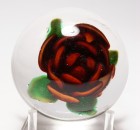 |
| 5970 | Large Murano Carpet Ground Millefiori
Paperweight - ALT or 3 Fiori. circa 1970s-2000.
This paperweight is a great example of a carpet millefiori
paperweight from the premier Murano glass studio ALT or its later
successor Vetreria 3 Fiori. The design is closely packed with
two types of flower canes. One type of flower canes sets up a
concentric design of two rows around a center cane of the same
type. The other type of flower cane fills in all the spaces to
form a uniform carpet and also forms a stave basket on the outside
of the design. The setup is convex when viewed from the side
but concave when viewed from the base. The base is polished
flat. It is unsigned, but certainly originated at either ALT
or 3 Fiori. A wonderful paperweight. Note on condition: This paperweight has two small areas with damage on the side. One is an abrasion or rough area approximately 1/4" across. The other is an area about the same size low on the side with several pinpricks or tiny chips. Both are hard to see without magnification. They are shown in the pictures. The paperweight displays beautifully but I have chosen to reduce the price to compensate for these flaws. This paperweight was made either ALT studio or Vetreria
3 Fiori studio on the island of Murano
in Venice, Italy. ALT
was founded in the 1970s and specialized in making paperweights,
although they also made other types of glass. They
continued in operation until around 2002. In the late
1990s two glass workers at ALT left and founded Vetreria 3 Fiori, which
came to be recognized as the
best millefiori paperweight maker in Murano. This studio
was in operation for only five years from about 2000 to
2005. Subsequently, two of
the workers at 3 Fiori opened a new
studio called The Millefiori Factory but it appears that that
has also closed. Venetian glass making dates back centuries and the Venetians are given credit for the earliest millefiori canes and paperweights in 1840s. More recently, paperweight making was revived in the 1930s and again in the 1960s. Large size: 3 1/16" diameter by 1 15/16" high
with a flat polished base. For extra pictures, click on the picture at the right and the following links: Large picture$75 postage paid in the US. Added 1/16/2023 For more information about Murano paperweights, see my Murano Paperweights Web Page . Click on the picture to see a larger image. |
Click
on the picture to see a larger image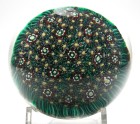 |
| 5887 | Vintage Pairpoint Concentric Millefiori
Paperweight. circa 1970s. This is a wonderful
spaced millefiori paperweight with thirteen fantastic millefiori
canes placed on a two layer turquoise ground. The canes are
especially nice. The ground has a translucent layer above an
opaque layer, which makes the canes look like they stand proud above
the ground but when viewed from the side it is clear that the top of
the canes are actually level with the top of the translucent layer.
It is faceted with a large top facet and five side facets. The
facets are concave. I believe this paperweight dates from the
early 1970s when William Burchfield was still at Pairpoint.
The paperweight is unsigned, but I guarantee the attribution.
This is the nicest Pairpoint millefiori paperweight I have
seen. A well balanced deign.
Pairpoint Glass has a long history extending back to its earliest origins with Mount Washington Glass in 1837. Owners and locations changed a number of times and the name Pairpoint was first used in the 1890s. The original Pairpoint companies were located in New Bedford, Massachusetts. In 1938, it was reorganized as Gunderson Glass Works by owner Robert Gunderson and later renamed the Gunderson - Pairpoint Glass Works in 1952. The name was acquired by Robert Bryden and the company moved briefly to East Wareham, MA in 1957 where it operated as the Pairpoint Glass Company. They leased production facilities in Spain. The last New Bedford factory burned down in 1965. In its latest iteration, Robert Bryden moved Pairpoint to Sagamore, Massachusetts in 1970. It continues to operate at that location today, with new owners in 2015. William Clark Burchfield started making paperweights at Pairpoint Glass in Sagamore, Massachusetts in 1970. He left in 1976 to form the Cape Cod Glass Works (also in Sagamore) which continued in operation until 2000. It then continued briefly in Crossville, Tennessee until 2001. Bill Burchfield died in 2012. Bill's son Mark was also at the Cape Cod Glass Works until 1998. Size: Just over 2 5/8" diameter by 1 9/16"
high. The base is polished flat. For extra pictures, click on the picture at the right and the following links: Large picture$195 postage paid in the US. Added 1/15/2023 For more vintage American paperweights, see my Vintage American Paperweights Web Page. Click on the picture to see a larger image. |
Click
on the picture to see a larger image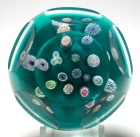 |
| 5942 | Perthshire 1981H Annual Collection Amber Double
Overlay Closepack Limited Edition Paperweight.
dated 1981. This is a closepacked millefiori design with a
double overlay of amber over white. The millefiori are all
complex canes and are pulled down to the base forming a basket
appearance. Underneath the millefiori is a ground of twist
canes visible from the bottom. The paperweight has an unusual
five sided faceting design consisting of a large top facet, five
medium sized side facets, and five smaller side facets at a lower
level. In addition to the facets, there is a semi-facet where
the amber material is removed to reveal white ovals between each of
the medium side facets. It is signed on the base with a
complex "P 1981" signature / date cane. The base is polished
concave. This paperweight was made in a limited edition of 250
paperweights (of which 152 were made).
A wonderful paperweight with brilliant execution.
Perthshire made this paperweight as one of their Annual Collection designs for 1981. This means the design was made only that one year and never again. There were eight Annual Collection designs in 1981, designated A through H. This design is designated 1981H. The annual collection paperweights are the most desirable of the Perthshire line, with the exception of one of one items. Perthshire was a small company in Crieff, Scotland that was devoted to the creation of quality glass paperweights. They stopped production in January 2002 after more than 30 years of production. Their paperweights were consistently high in quality and yet remained reasonable in price. The birth of Scottish paperweight making is credited to the glass making family of Salvador Ysart, who moved to Crieff, Scotland in 1922. They worked first at John Moncrieff Ltd and made the earliest Scottish paperweights during that period. In 1946 Salvadore and his sons Augustine and Vincent founded Ysart Brothers Glass and produced glass wares under the Vasart label. Salvador Ysart died in 1955 The company name was later changed to Vasart Glass. Stuart Drysdale was hired manage the business side of the enterprise in 1960. The company evolved into a new company Strathearn owned by Teachers Whiskey. In 1967 Drysdale was sent a magazine article on antique paperweights (Woman's Day, July 1965). The inspired him to try to produce weights comparable to the French antiques. With this goal in mind, he and several of the glass workers left Strathearn to found Perthshire in 1968. Size: 2 11/16" diameter by just over 1 3/4"
high. The base is ground concave. The paperweight is
finished with a large top facet and ten side facets in two
rows. It also has five semi-facets (see description). For extra pictures, click on the picture at the right and the following links: Large pictureSOLD. Added 11/27/2022 For more information about Perthshire Paperweights, see my Perthshire Web Page. Click on the picture to see a larger image. |
Click
on the picture to see a larger image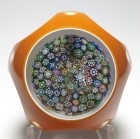 |
| 4435 | Large Tom Mosser Old Ironsides USS
Constitution Paperweight. circa 1970. This
classic decorative plaque paperweight was made by Thomas Mosser at
his Variety Glass Company in Cambridge Ohio. The white enamel
plaque is decorated with a printed decal image (ceramic transfer) of
an the Old Ironsides USS Constitution alongside a dock. The
rigging is present, but the sails have been stored away. It is
signed with an "M" in the lower edge of the scene. The plaque
rests on a multi-colored frit ground with a second frit ground
below. A great example from this Cambridge Ohio maker. Note: This paperweight has a chip or imperfection which has been polished on the edge of the base. Please review the pictures. Thomas Mosser (born 1927) learned to work with glass at the Cambridge Glass Company where his father Orie Mosser was the plant manager. When Cambridge Glass closed in 1954, Tom decided to continue in the glass business and formed Variety Glass with the support of several experienced glass workers from Cambridge. The first couple of locations failed due to fires, but eventually a stable operation emerged and produced a variety of products, including glassware for the pharmaceutical industry, medical supplies, and also collectible molded items such as novelty salts, jam dishes, toothpick holders, ashtrays, and miniature boot and shoes. Tom also made paperweights to order as well as fixed designs for Shrine and Masonic lodges. Many of his paperweights used ceramic transfers of well known paintings by other artists. For more information, you can read about the Tom Mosser in the book American Glass Paperweights and Their Makers by Jean Melvin (revised 1970). The Mosser family continues to operate a glass business in Cambridge Ohio. Large size: 3 1/8" diameter by 2 1/2" high.
The base is polished flat. It weighs just over 21 ounces and
will be two pounds when packaged for mailing. For extra pictures, click on the picture at the right and the following links: Large pictureSOLD. Added 11/15/2022 For more vintage American paperweights, see my Vintage
American
Paperweights Web Page. Click on the picture to see a larger image. |
Click
on the picture to see a larger image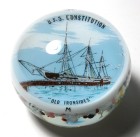 |
| 5483 | Baccarat 1971 Gridel Series Magnum
Millefiori Rooster Limited Edition Paperweight. dated
1971. This modern millefiori paperweight features a large
central black Gridel rooster silhouette facing left on a white
background. The rooster cane is set in the center of a
concentric design with four rings of millefiori canes, including a
ring of all 18 Gridel canes. The design is set on a lace
ground. Baccarat's complex signature / date cane "B 1971" is
in the third ring at 3 o'clock. The rooster appears twice,
once in the center and a smaller one facing right at 2
o'clock. This design was released in 1971 in a limited edition
of 1,200 pieces. This is number 519 in that edition.
This paperweight is also signed on the base with two acid etched
Baccarat marks along with the year (1971) and edition number
(519). The year is hard to read on the base as it was engraved
on top of one of the Baccarat marks. I show several pictures
of this signature taken from different angles. An extra large
example. In 1846 Baccarat introduced the popular Gridel figures in their closepack millefiori paperweights. It was named after Emil Gridel, the nephew of Jean-Baptiste Toussaint the general manager of Baccarat. Toussaint saw Gridel making paper cutouts of animals and saw an opportunity to incorporate these silhouettes in millefiori paperweights. From 1971 to 1979 Baccarat issued a modern Gridel series of millefiori paperweights based on eighteen Gridel figures. Each paperweight has a large Gridel figure in the center with smaller versions of the other figures included in the design. There are variations in orientation and color as well as the types of canes in each design and it is possible to amass a very large collection covering just this series. Very large size: Just over 3 3/8" diameter by 2
1/16" high. The base is polished
flat. The profile is slightly flat. For extra pictures, click on the picture at the right and the following links: Large picture$395 postage paid in the US. Added 11/5/2022 For more information about Baccarat paperweights, see my Baccarat Paperweights Web Page Click on the picture to see a larger image. |
Click
on the picture to see a larger image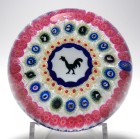 |
| 5906 | Large Whitefriars Multifaceted Six Ring
Red White & Blue Concentric Millefiori Paperweight. dated
1975. This paperweight has six concentric rings of red, white,
and blue millefiori canes around a center cane. The
paperweight is faceted with a ten sided top facet and many diamond
shaped side facets that are arranged in a spiral up to the top
facet. The faceting makes it look like there are many more
rings than the actual six ring setup. It has a Whitefriars
signature cane with a white monk and the date 1975 in the outermost
red ring (the fifth ring from the center). The ground is clear
crystal. Typical heavy Whitefriars lead crystal. With
its dramatic faceting and bold colors, this is a very nice addition
to any collection of millefiori paperweights.
Modern Whitefriars paperweights are prized by collectors for their high quality glass and millefiori designs. The paperweights with mosaic canes are especially sought after. The name Whitefriars Glass dates from sometime in the 1600s. The original site had been occupied by a community of Carmelite monks known as White Friars, hence the name taken by the glass company. Some sources state that at least a portion of the company operated under the name of James Powell and Sons from 1834 to 1962. Other sources state that the Whitefriars name was used from 1680 to 1980. Limited production of millefiori paperweights and other millefiori items started some time in the 1930s and first appeared in the 1938 catalog. Millefiori items were made using English full lead crystal (33% lead oxide). It is difficult to associate specific paperweights with this production. After 1945, they made colored glass and bubble design paperweights until the modern millefiori production started about 1951. Even then relatively few designs were produced until the 1970s. In 1980, Whitefriars glass went out of business. After Whitefriars Glass was liquidated, Caithness Glass purchased the rights to the name and produced paperweights under the Whitefriars name for awhile. Large size: Just over 3" diameter by just over 1
15/16" high. The base is ground concave. Faceted with
a ten sided top facet and many diamond shaped side facets that are
arranged in a spiral up to the top facet. For extra pictures, click on the picture at the right and the following links: Large picture$345 postage paid in the US. Added 10/31/2022 For more information about Whitefriars and other paperweights from England,see my English Paperweights Web Page. Click on the picture to see a larger image. |
Click
on the picture to see a larger image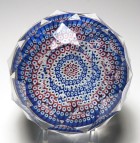 |
| 5242 | Magnum Murano Faceted Double Overlay Three
Row Concentric Millefiori Paperweight with 1854 Date.
circa 1960-1970. A wonderful Murano three row concentric
millefiori paperweight with a red and white double overlay.
The 1854 date cane is surrounded by three rings of identical white
cog canes with turquoise centers. The "1854" date cane is
either a fake date intended to deceive the buyer or perhaps
commemorative of a past event. This paperweight is faceted
with one large top facet and five side facets. The top facet
has an unusual cutting as does the base which is polished flat and
finished with a fancy star cut. Probably made in the 1960s by
Fratelli Toso. A classic design. Murano paperweights with fake dates are an interesting sub-collection. Some people collect these paperweights with the goal of getting examples of each date. Some dates correspond dates used in real antique French or American paperweights, but there are no antique paperweights known to have an 1854 date. This paperweight was made on the island of Murano in Venice, Italy. Venetian glass making dates back centuries and the Venetians are given credit for the earliest millefiori canes and paperweights in 1840s. More recently, paperweight making was revived in the 1930s and again in the 1960s. Fratelli Toso was started in 1854 by six brothers - Angelo Toso, Giovanni Toso, Ferdinando Toso, Carlo Toso, Gregorio Toso and Liberato Toso. They were joined by Ermanno Toso in 1924 who became artistic director. The Fratelli Toso company is well known for its use of colorful murrines and millefiori, particularly during the 1950's and earlier. In 1979, the company suffered a harsh economic crisis, forcing the owners to divide it into Antica Vetreria Fratelli Toso and Fratelli Toso International. In 1981, Fratelli Toso International filed for bankruptcy and closed its doors for good. Antica Vetreria Fratelli Toso, led by Arnoldo Toso, continued to operate. Very large size: 3 3/16" diameter by 2 1/8"
high. The base is polished flat and finished with a fancy
star cut. This paperweight is faceted with one large top
facet and five smaller side facets. The top facet has an
unusual cutting. For extra pictures, click on the picture at the right and the following links: Large picture$145 postage paid in the US. Added 10/29/2022 For more information about Murano paperweights, see my Murano Paperweights Web Page . Click on the picture to see a larger image. |
Click
on the picture to see a larger image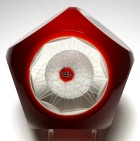 |
| 5910 | Perthshire 1970 PP19 Limited Edition
Millefiori Scramble Paperweight. dated
1970. This is a large sized scramble or end of day millefiori
paperweight with a Perthshire "P 1970" signature / date cane in the
design. It also has a large but faint "P" signature cane near
the center. The colors resemble an antique Clichy scramble
paperweight. There is a large number of millefiori canes and
pieces of canes packed into this paperweight making it a joy to
examine and study. The design is placed over a clear
ground. It also has a very worn paper label "PERTHSHIRE
PAPERWEIGHTS CRIEFF SCOTLAND" taped to the base. A fun early
paperweight from Perthshire.
The PP19 was made in a limited edition from 1969 to 1980 and from 1987 to 2002. Each year was a little different with silhouettes added in later years. The earliest versions were smaller This version (with a clear ground) was made until 1991. Perthshire was a small company in Crieff, Scotland that was devoted to the creation of quality glass paperweights. They stopped production in January 2002 after more than 30 years of production. Their paperweights were consistently high in quality and yet remained reasonable in price. The birth of Scottish paperweight making is credited to the glass making family of Salvador Ysart, who moved to Crieff, Scotland in 1922. They worked first at John Moncrieff Ltd and made the earliest Scottish paperweights during that period. In 1946 Salvadore and his sons Augustine and Vincent founded Ysart Brothers Glass and produced glass wares under the Vasart label. Salvador Ysart died in 1955 The company name was later changed to Vasart Glass. Stuart Drysdale was hired manage the business side of the enterprise in 1960. The company evolved into a new company Strathearn owned by Teachers Whiskey. In 1967 Drysdale was sent a magazine article on antique paperweights (Woman's Day, July 1965). The inspired him to try to produce weights comparable to the French antiques. With this goal in mind, he and several of the glass workers left Strathearn to found Perthshire in 1968. Large size: 2 13/16" diameter by just over 2 1/8"
high. The base is ground concave. For extra pictures, click on the picture at the right and the following links: Large picture$225 postage paid in the US. Added 10/28/2022 For more information about Perthshire Paperweights, see my Perthshire Web Page. Click on the picture to see a larger image. |
Click
on the picture to see a larger image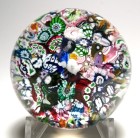 |
| 4445 | Large Murano Pear
Paperweight. circa 1950-1980. This
pear paperweight is made in the style of the antique New England
Glass Company pear paperweights with a variegated pear set on a
clear slightly oval cookie base. It appears to be hollow blown
just like those from NEGC. An excellent example of this
style. This paperweight was made on the island of Murano in Venice, Italy. Venetian glass making dates back centuries and the Venetians are given credit for the earliest millefiori canes and paperweights in 1840s. More recently, paperweight making was revived in the 1930s and again in the 1960s. Size: 2 3/4" diameter by 3 15/16" long by 2
15/16" high. The base 2 13/16" by 2 11/16" and is fire
finished. For extra pictures, click on the picture at the right and the following links: Large picture$69 postage paid in the US. Added 10/22/2022 For more information about Murano paperweights, see my Murano Paperweights Web Page . Click on the picture to see a larger image. |
Click
on the picture to see a larger image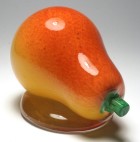 |
| 2082 | Caithness Helen MacDonald Red
Carnation Style One Paperweight. issued
1999. This beautiful paperweight features a crimp red
carnation set on a rich cobalt blue ground. There is a
contrasting field of controlled bubbles located top right. It
is finished with a small polished flat base and a large angled
facet. The carnation is set at an angle matching the
facet. This design was created by Helen MacDonald and issued
in 1999. The paperweight is engraved on the edge of the base
"Red Carnation Caithness Scotland" with a registration number
"Y17099". Please see note below about a scratched area on the
backside. A beautiful design. The RED CARNATION Style One design is listed on page 256 of the Charlton Standard Catalog of Caithness Paperweights. It was designed by Helen MacDonald and released in an unlimited edition in 1999. The original issue price in the US was $82.50 and the Charlton Catalog lists the 2004 current value as $500. Note about condition: This paperweight has an area on the backside near the base with many small scratches or abrasions (see picture). The area looks like a dirt smudge and I had to look with magnification to realize that this is damage. In spite of this, the paperweight displays beautifully. Offered for a bargain price. Caithness Glass was founded by Robin Sinclair in Wick in north eastern Scotland in 1961. The factory did not start making paperweights until 1962 when Paul Ysart joined Caithness. Colin Terris joined Caithness in 1968 and started the modern line of paperweights in 1969. A second factory was opened in Oban in 1969 and the Perth factory opened in 1979. In 1980, Caithness purchased the Whitefriars name and designs. More recently Caithness recently went through a number of changes of ownership. After going into receivership in 2004, it was purchased by Edinburgh Crystal, but went into receivership again in 2006. Finally, it was bought out of receivership by Dartington Crystal. The factories in Wick, Oban and Perth all closed and were replaced by a smaller operation and visitors' center in Crieff. Caithness is still operating in Crieff and making paperweights today (in 2022). Large size: 2 3/4" diameter by 2 11/16" high.
The small base is polished flat. It is faceted with a large
angled facet. For extra pictures, click on the picture at the right and the following links: Large picture$69 postage paid in the US. Added 10/20/2022 For more information about paperweights made by Scottish makers, see my Scottish Paperweights Web Page Click on the picture to see a larger image. |
Click
on the picture to see a larger image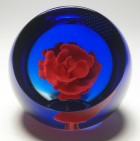 |
| 4511 | Magnum Goebel Charlottenhütte Molded Bee
Paperweight. circa 1970s. This very large molded
paperweight has a three dimensional bee on the textured top.
It is disk shaped and is signed with an acid etched "Goebel" logo on
the base and a silver foil label "Goebel Charlottenhütte Western
Germany". The glass has a very slight yellow cast but is
mostly colorless and clear with a frosted bee on top. An
interesting addition to any collection of glass paperweights. Note about color: The glass has a very slight yellow cast but is mostly colorless and clear with a frosted bee on top. The pictures exaggerate the yellow color. Note about precedent: This paperweight reminds me of the Baccarat molded paperweights that appeared in their 1885 catalog. Baccarat also included a molded bee. Goebel was founded in 1831 by William Goebel and his father Franz Detleff. The first factory opened in 1878 in Oeslau-Rödental (Bavaria). The company sought recognition for its artistic accomplishments, high quality, and craftsmanship. In 1935 Goebel was granted an exclusive agreement by Sister Maria Innocentia Hummel and the Convent of Siessen to create three dimensional porcelain figurines based on Hummel's drawings. This product was immensely successful and led to the expansion of the company into other product lines, including glass. The company prospered until the financial turmoils following events in 2001 and 2006 forced several reorganizations spanning until 2017. Now under new ownership, the company has moved from Rödental to Bad Staffelstein. The product line continues to be designed in Germany, but some production takes place elsewhere. The Charlottenhütte Western Germany label is found on Goebel glass products made before the fall of the Berlin Wall in 1989. Charlottenhütte was an industrial area known for its steel industry prior to and during WWII. After the war steel production was dismantled and other industries were allowed to develop. Goebel Charlottenhütte also made copies of Swedish and Finnish molded glass patterns, including a very successful line of melting ice tree bark pattern tumblers. Very large size: 3 5/8” diameter by 1 5/8”
high. The base is polished flat. For extra pictures, click on the picture at the right and the following links: Large picture$45 postage paid in the US. Added 10/19/2022 For more paperweights from other countries, see my Other Countries Web Page. Click on the picture to see a larger image. |
Click
on the picture to see a larger image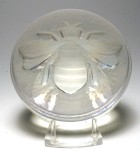 |
| 5378 | Antique New England Glass Company (NEGC)
Seal with Millefiori Nosegay Handle. circa 1860-1888.
Interesting NEGC seal with millefiori nosegay handle.
The nosegay has three marvelous complex millefiori. The base
has a grid cut and is not customized for the owner. Fair to
good condition, with many small chips on the edges and
corners. The handle has a six sided top facet plus two rows of
six facets each. The stem and base are six sided. Rare
item. The New England Glass Company (NEGC) operated in Cambridge, Massachusetts from 1818 to 1888. You can read about paperweights from the New England Glass Company in the book by John Hawley. The Art of the Paperweight - The Boston & Sandwich and New England Glass Companies covers both B&S and NEGC. Size: The six-sided handle is 1 5/16" wide at its
widest. 2 5/8" long. The base is 7/8" width at its
widest. Heavily faceted. For extra pictures, click on the picture at the right and the following links: Large picture$1,100 postage paid in the US. US Sales only, no international shipping. Delivery will require a signature. Added 8/22/2021 For more information about Antique Paperweights, see my Antique Paperweights Web Page. Click on the picture to see a larger image. |
Click
on the picture to see a larger image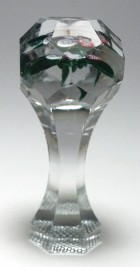 |
| 1537 | Magnum Chinese Blue Pedestal Rose
Paperweight. circa 1980-2000. This is a modern
Chinese blue pedestal rose paperweight with 30 blue colored petals
and five green leaves. The petals are arranged in six rings in
a 6+6+6+5+4+3 pattern. The design is set on a pedestal stem
with three knops and a white and green frit base. A large
example of a modern Chinese lampwork rose.
Unlike the 1930s copies of Millville crimp roses, this example thin petals and appears to be a lampwork assembly. Lampwork flowers are assembled at a hot torch (lamp) before being encased in glass. Crimp roses are made by a more difficult process that creates the rose in a single step using a metal crimp. Chinese Paperweights were
made in the late 1920s and throughout the 1930s as an attempt to
duplicate 19th Century antique weights made in the United States
and France. Because they are almost 100 years old, they
are very collectible and every collector should own a few of
these as study pieces. The history of the early Chinese
paperweights is mostly anecdotal as no written records have been
discovered. The story is that an American dealer sent
examples of paperweights made by the New England Glass Company
(NEGC), Boston & Sandwich Glass Company (B&S), Millville
makers, and French factories to a Chinese factory and requested
copies be made. The results are interesting and sometimes
confused with the originals by inexperienced collectors.
The earliest pictures of these paperweights appeared in the book
American Glass Paperweights by Francis Edgar Smith
published in 1939. Smith was aware that at least one of
the paperweights shown in his book was Chinese.
Since Smith was not an expert collector, this indicates that
there was some general knowledge that these were Chinese prior
to 1939. Chinese paperweights continued to be made
throughout the 20th century and now into the 21st century with
greatly improved quality. Very large size: 3 9/16” diameter by 5 1/8”
high. The base is 3 1/4" diameter. The base is ground
flat. It weighs 46 ounces (2 pounds, 14 ounces). For extra pictures, click on the picture at the right and the following links: Large picture SOLD. Added 8/21/2022 For more paperweights from China, see my Chinese Paperweights Web Page. Click on the picture to see a larger image. |
Click
on the picture to see a larger image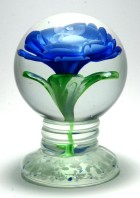 |
| 5965 | St. Louis 1977 Limited
Edition Five Flower Bouquet Paperweight with Red and White Double
Overlay. dated 1977. This 1977 St. Louis
paperweight features a lampwork bouquet of five red, white, and blue
clematis flowers with green stems and leaves. The design is
placed on a clear ground and encased in a brilliant red and white
double overlay. It is finished with a large top facet and
twelve side facets in two rows, plus a star cut base. The
paperweight is is signed in the center of white flower with a
complex "SL 1977" signature / date cane, although the signature cane
is put in upside down. This limited edition design was offered
by St. Louis in a limited edition of 450 paperweights of which 200
were reserved for the American market. It also has its
original foil label "CRISTAL SAINT LOUIS FRANCE" and comes with its
original certificate of authenticity assigning this as edition
number 269 of the 1150 limited edition paperweights made for the
American market in 1977. It also comes with its original very
worn and stained box. See note below about manufacturing
flaws. A brilliant design. A great addition to any
collection of modern French paperweights. Note about manufacturing flaws: The double overlay has several manufacturing flaws which are shown in the pictures. The most significant is a line on the side where there is a lighter red color. There are also two tiny tool marks, one near the top facet and another near the base. The latter may be a tiny nick or scratch and there is also a nearby scratch on the clear base. All of these marks and scratches are very small but showed up in the pictures. Cristalleries de Saint Louis was
founded in 1767 in Lorraine, which became part of France in
1766. The region was already home to several
glassworks. Paperweight production started at St. Louis in
1845 and most likely continued until about 1860. Although
the modern production of paperweights started in 1952, the
output of millefiori and lampwork paperweights was small.
Fewer than 400 lampwork and millefiori paperweights were made
between 1952 and 1955. They were not all signed or
dated. The most successful product of this early revival
period was the Queen Elizabeth sulphide which was made to
commemorate her coronation in 1953. After 1955, no
additional weights were made at St. Louis until 1965. In
1965 the factory resumed production of lampwork and millefiori
paperweights and then in 1967 they began a series of sulphide
weights. Finally, in 1970 they started producing annual
limited edition paperweights. Large Size: 3 1/8" diameter by 2 1/4" high.
The base has a star cut. Finished with a red and white
double overlay and faceted with a large top facet and twelve side
facets. For extra pictures, click on the picture at the right and the following links: Large pictureSOLD. Added 8/2/2022 For more information about paperweights made by the St. Louis glass factory in France, see my St. Louis Web Page . Click on the picture to see a larger image. |
Click
on the picture to see a larger image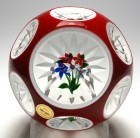 |
| 5363 | Large Strathearn Spaced Millefiori on Lace
Paperweight. 1963 - 1980. This Strathearn spaced
millefiori on lace paperweight features twelve colorful millefiori
canes in a randomly spaced pattern. The design is placed on a
white lace (or upset muslin) ground. This paperweight has a
Strathearn paper label with a leaping salmon and "STRATHEARN HAND
MADE IN SCOTLAND" on the base. A great addition to any
collection of Scottish glass.
The birth of Scottish paperweight making is
credited to the glass making family of Salvador Ysart, who moved
to Crieff, Scotland in 1922. They worked first at John
Moncrieff Ltd and made the earliest Scottish paperweights during
that period. In 1946 Salvadore and his sons Augustine and
Vincent founded Ysart Brothers Glass and produced glass wares
under the Vasart label. Salvador Ysart died in 1955
The company name was later changed to Vasart Glass. Strathearn
Glass was formed in a reorganization of Vasart glass in
1963. The new company was owned by Teachers Whiskey.
The factory was taken over by Stuart Glass in 1980 and renamed
Stuart Strathearn Ltd. After 1980, this factory ceased
production of paperweights and stopped all production in
1992. Stuart Crystal ceased all operations in 2001.
Size: Just over 3” diameter by 2 1/8"
high. The base is polished flat. For extra pictures, click on the picture at the right and the following links: Large picture$175 postage paid in the US. Added 8/1/2022 For more information about paperweights made by Scottish makers, see my Scottish Paperweights Web Page Click on the picture to see a larger image. |
Click
on the picture to see a larger image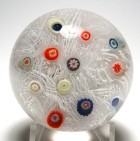 |
| 4459 | 1930s Chinese Footed Orange-Red Crimp Rose
Paperweight. circa 1930. This paperweight is a
well executed almost antique 1930s Chinese copy of a Millville Crimp
Rose. It has 11 orange-red colored petals and four green
leaves. The petals are arranged in a 4+4+3 pattern.
There is a double foot at the base. As is typical of Chinese
paperweights from this period, the glass has a greenish tinge and
there are many tiny bubbles in the glass. The South Jersey Crimp Rose is one of the most famous American paperweights. The best makers were Emil Larson of Vineland, New Jersey and Ralph Barber of Millville, New Jersey. There were also other makers. Newell's Old Glass Paperweights of Southern New Jersey shows examples of both the South Jersey weight and the 1930s Chinese copy. Chinese Paperweights were made in the late 1920s and throughout the 1930s as an attempt to duplicate 19th Century antique weights made in the United States and France. Because they are almost 100 years old, they are very collectible and every collector should own a few of these as study pieces. The history of the early Chinese paperweights is mostly anecdotal as no written records have been discovered. The story is that an American dealer sent examples of paperweights made by the New England Glass Company (NEGC), Boston & Sandwich Glass Company (B&S), Millville makers, and French factories to a Chinese factory and requested copies be made. The results are interesting and sometimes confused with the originals by inexperienced collectors. The earliest pictures of these paperweights appeared in the book American Glass Paperweights by Francis Edgar Smith published in 1939. Smith was aware that at least one of the paperweights shown in his book was Chinese. Since Smith was not an expert collector, this indicates that there was some general knowledge that these were Chinese prior to 1939. In the United States, the Tariff Act of 1930 required that every imported item must be conspicuously and indelibly marked in English with its country of origin. As a result, many of these Chinese paperweights are scratch signed on the bottom "CHINA". Many are also not signed, suggesting that either they were imported prior to 1930 or the importer ignored the requirement. Most likely the earliest Chinese paperweights were made prior to 1930. In general, Chinese paperweights from this period have a light weight glass mixture that is high in soda and has a greenish tinge. The glass also has a soft almost oily feel. Frequently they have bubbles or debris in the glass. And because of their age, many of these have minor scratches or other surface defects.
Size: 3 1/8" diameter by 3 7/16" high. The
base is just over 2 7/16" diameter and has a double foot.
The center is ground concave. For extra pictures, click on the picture at the right and the following links: Large picture$145 postage paid in the US. Added 7/27/2022 For more information about paperweights from China, see my Chinese Paperweights Web Page. Click on the picture to see a larger image. |
Click
on the picture to see a larger image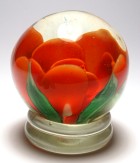 |
| 1770 | Antique German Paperweight
with Picture of Student in Fraternity Uniform. circa
1870-1915. This is an antique paperweight with a photograph or
painting of a young man in a military type uniform. The image
is on a white enamel plaque and is either a painting or a hand
colored photograph. The enamel plaque is placed in the center
of a spatter or frit ground. An interesting and rare type of
paperweight. The paperweight was most likely made in Germany or
Silesia. A great addition to any collection of antique
European paperweights.
Note: There is a fracture surrounding the image that is caused by incompatibilities between the plaque and the surrounding glass. This type of fracture is, unfortunately, fairly common in plaque weights of that period. After considerable research, I have concluded that the uniform is probably one used by a German or Austrian university student fraternity or student association. Members of these student associations surrounded themselves with the symbols of their fraternities. The uniforms are quite commonly depicted on German steins and other "studentica" of the period. For more information, see http://stein-collectors.org/library/articles/Student/studentica.html Size: 2 1/2” diameter by 1 3/4” high. The
bottom is fire finished with remnants of the pontil mark. For extra pictures, click on the picture at the right and the following links: Large pictureNew Price $185 (was $265) postage paid in the US. Repriced 7/27/2022 For more information about Antique Paperweights, see my Antique Paperweights Web Page. Click on the picture to see a larger image. |
Click on the picture
to see a larger image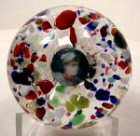 |
| 5635 | Webb Corbett Purple Flash Overlay Paperweight
with Certificate. 1969-1986. This Webb Corbett
paperweight was produced during the period that Webb Corbett was
owned by Royal Doulton. It has a clear interior with no inner
design and a transparent purple (or amethyst) flash overlay.
It is finished with one top facet, five side facets, and a star cut
base. It has its original foil label "FINEST ENGLISH FULL LEAD
CRYSTAL ROYAL DOULTON MADE IN ENGLAND". It also comes with its
original Webb Corbett certificate declaring "Webb Corbett Fine
English Hand Made Crystal PURPLE MULTI HOLLOW PAPERWEIGHT" and
giving a history of the company. Webb Corbett is one of the great
names in English lead-crystal glass. It was set up in 1897 by
two grandsons of Thomas Webb I, Herbert Webb and Thomas Webb
III, together with George Harry Corbett. The original
company name was Thomas Webb and Corbett Limited. It was a
separate operation from Thomas Webb and Sons. Thomas Webb
and Corbett Ltd changed their name to Webb Corbett Ltd in the
1930's. In 1969 the company was taken over by Royal
Doulton and in 1986 they stopped using the Webb Corbett
name. Glass from the former Webb Corbett glassworks was
then produced under the name Royal Doulton Crystal until this
glassworks closed down. After several mergers and
reorganizations, Royal Doulton Crystal is now owned by the
Finnish company Fiskars Corporation, along with Waterford
Crystal, Wedgwood, and Iittala. David Smith was the chief
designer at Webb Corbett from 1965 until he left in 1982. He
introduced a magnificent range of cameo glass designs using
clear crystal with an overlay of colored glass. The design
was produced by sand blasting the glass to remove part of the
colored layer. For extra pictures, click on the picture at the right and the following links: Large picture$49 postage paid in the US. Added 7/23/2022 For more information about Whitefriars and other paperweights from England, see my English Paperweights Web Page. Click on the picture to see a larger image. |
Click
on the picture to see a larger image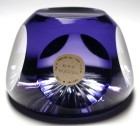 |
| 5695 | Whitefriars 1976 Bicentennial Liberty Bell
Limited Edition Millefiori Paperweight with
Certificate. circa 1976. This Whitefriars
paperweight has a central picture cane depicting the Liberty
Bell. It is surrounded by thirteen white stars each with a
blue background. There is a special Whitefriars signature cane
with a white monk and the years 1776 and 1976. It also has its
original paper label with a Whitefriars monk symbol and the text
"WHITEFRIARS FULL LEAD CRYSTAL MADE IN ENGLAND". The colors
are red, white, and blue to celebrate the 200th anniversary of the
signing of the American Declaration of Independence on July 4,
1776. This weight is numbered 416 on the base. The
paperweight also comes with its original certificate which states
that it is number 416 in a limited edition of 750
paperweights. The paperweight is made using full lead crystal
which gives it a brilliant finish. It is faceted with a top
facet and five side facets. Modern Whitefriars paperweights are prized by collectors for their high quality glass and millefiori designs. The limited edition paperweights with mosaic canes are especially sought after. The name Whitefriars Glass dates from sometime in the 1600s. The original site had been occupied by a community of Carmelite monks known as White Friars, hence the name taken by the glass company. Some sources state that at least a portion of the company operated under the name of James Powell and Sons from 1834 to 1962. Other sources state that the Whitefriars name was used from 1680 to 1980. Limited production of millefiori paperweights and other millefiori items started some time in the 1930s and first appeared in the 1938 catalog. Millefiori items were made using English full lead crystal (33% lead oxide). It is difficult to associate specific paperweights with this production. After 1945, they made colored glass and bubble design paperweights until the modern millefiori production started about 1951. Even then relatively few designs were produced until the 1970s. In 1980, Whitefriars glass went out of business. After Whitefriars Glass was liquidated, Caithness Glass purchased the rights to the name and produced paperweights under the Whitefriars name for a while. For a long time, collectors believed that English paperweights and inkwells dated 1848 and similar undated items were made by Whitefriars. The dates, however, are false dates and have been traced to production at Arculus and Walsh-Walsh in the 1920s and 1930s. Most paperweights referred to as old Whitefriars or antique Whitefriars were, in fact, made by other factories such as Richardson, Arculus, Walsh-Walsh, or one of the unidentified Old English factories. When the maker can not be identified, it is best to call them Old English paperweights and not associate them with Whitefriars. Size: 3 1/8" diameter by 1 3/4" high. The base
is ground concave. Faceted with one top facet and five side
facets. For extra pictures, click on the picture at the right and the following links: Large picture$265 postage paid in the US. Added 7/20/2022 For more information about Whitefriars and other paperweights from England, see my English Paperweights Web Page. Click on the picture to see a larger image. |
Click
on the picture to see a larger image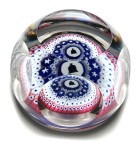 |
| 5619 | Perthshire Annual Collection 1984D Limited
Edition Pink Floral Spray Paperweight. issued
1984. This is a large light pink lampwork flower with five
pink buds on a white double spiral latticinio cushion ground.
The flower has a yellow complex millefiori center. The flower
and buds have individual stems. It is signed with Perthshire's
complex "P" signature cane on the base. This design was issued
with blue flowers and with pink flowers in a limited edition of 400
paperweights, of which only 271 were made. Great color and
execution. Note on color: The actual color of the flower is a lighter pink than is shown in the pictures. Perthshire made this paperweight as one of their Annual Collection designs for 1984. This means the design was made only that one year and never again. There were seven Annual Collection designs in 1984, designated A through G. The annual collection paperweights are the most desirable of the Perthshire line, with the exception of one of one items. Perthshire was a small company in Crieff, Scotland that was devoted to the creation of quality glass paperweights. They stopped production in January 2002 after more than 30 years of production. Their paperweights were consistently high in quality and yet remained reasonable in price. There are three books on Perthshire Paperweights. If you collect Perthshire paperweights, you should have them in your library.
Large size: 2 15/16" diameter by 2 3/16" high.
The base is ground concave. For extra pictures, click on the picture at the right and the following links: Large picture$395 postage paid in the US. Added 7/20/2022 For more information about Perthshire Paperweights, see my Perthshire Web Page. Click on the picture to see a larger image. |
Click
on the picture to see a larger image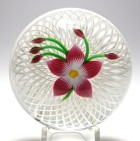 |
| 5567 | Caithness Colin Terris Ballerina
Limited Edition Flash Overlay Paperweight. issued
1993. This stunningly beautiful paperweight uses a pink
swirl of lacy bubbles to depict a twirling ballerina. The
design is placed at the center of a transparent cobalt blue flash
overlay. This design was created by Colin Terris in 1993 and
issued in a very limited edition of only 50 paperweights, of which
this is number 42. It is faceted with one large top facet and
twelve smaller side facets in two rows. The paperweight is
engraved on the edge of the base "Ballerina Caithness Scotland
42/50". It also has Selman auction label. A beautiful
design. The BALLERINA design is listed and designated CT-931 on page 140 of the Charlton Standard Catalog of Caithness Paperweights. It was designed in 1993 by Colin Terris and released in a limited edition of only 50 paperweights. The original issue price in the US was $595 and the Charlton Catalog lists the 2004 current value as $350. Note about provenance: The previous owner acquired this paperweight at the Selman Auction 44 (Fall 2009) Lot 298. The auction estimate was $180-$250. Caithness Glass was founded by Robin Sinclair in Wick in north eastern Scotland in 1961. The factory did not start making paperweights until 1962 when Paul Ysart joined Caithness. Colin Terris joined Caithness in 1968 and started the modern line of paperweights in 1969. A second factory was opened in Oban in 1969 and the Perth factory opened in 1979. In 1980, Caithness purchased the Whitefriars name and designs. More recently Caithness recently went through a number of changes of ownership. After going into receivership in 2004, it was purchased by Edinburgh Crystal, but went into receivership again in 2006. Finally, it was bought out of receivership by Dartington Crystal. The factories in Wick, Oban and Perth all closed and were replaced by a smaller operation and visitors' center in Crieff. Caithness is still operating in Crieff and making paperweights today (in 2022). Large size: Just under 3 1/8" diameter by just under
2 7/16" high. The base is polished flat. It is faceted
with one large top facet and twelve smaller side facets in two
rows. For extra pictures, click on the picture at the right and the following links: Large picture$175 postage paid in the US. Added 7/16/2022 For more information about paperweights made by Scottish makers, see my Scottish Paperweights Web Page Click on the picture to see a larger image. |
Click
on the picture to see a larger image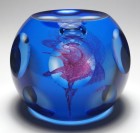 |
| 4542 | Antique New England Glass Company (NEGC)
Mixed Fruit Paperweight. circa 1869. This is an
antique New England Glass Company (NEGC) mixed fruit paperweight,
consisting of five apples (or pears), four radishes (or cherries),
four large leaves and four smaller leaves over a nearly perfect
double swirl latticinio ground. The fruit have bright vivid
colors and the leaves show good definition. The cruciform
design is beautifully composed. Unfortunately there are of
striations (sugaring) in the glass that are exaggerated in the
pictures. The paperweight is in great condition and appears to
have been restored in the past. It displays beautifully.
Many authors call the fruit pears and cherries. I feel that they look more like apples and radishes. The New England Glass Company (NEGC) operated in Cambridge, Massachusetts from 1818 to 1888. You can read about paperweights from the New England Glass Company in the book by John Hawley. The Art of the Paperweight - The Boston & Sandwich and New England Glass Companies covers both B&S and NEGC. Size: 2 9/16" diameter by 1 13/16" high. The
base is ground concave. For extra pictures, click on the picture at the right and the following links: Large picture$395 postage paid in the US. Added 7/15/2022 For more information about Antique Paperweights, see my Antique Paperweights Web Page. Click on the picture to see a larger image. |
Click
on the picture to see a larger image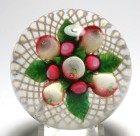 |
| 5352 | Magnum Victor Trabucco Yellow Morning
Glory Paperweight with buds. circa 1988. This
paperweight consists of a large yellow morning glory flower with two
yellow buds and leaves and stems on a transparent blue ground.
It is signed with Victor Trabucco's "VT" signature cane on the
underside of a leaf. There is also a very faint scratched
signature on the base "Trabucco 1988". A magnificent
paperweight. Victor Trabucco's original career was as a steelworker. He began working with glass in 1974 after seeing a flameworker make a sculpture. He knew this was what he wanted to do for his life's work. Trabucco says that “Glass is the ultimate challenge; it has properties of no other material and offers the artist possibilities that are inspiring for the creative process. His work is often inspired by nature, capturing the beauty and motion of the subject and freezing a moment in time. His work is in the collection of many major museums. Victor set up his first studio in the basement of his house and learned by experimentation. He now works with his sons Jon and David in a large studio in Clarence, NY. Very Large Size: 3 1/4" diameter by 2 3/4"
high. The base is ground slightly concave. For extra pictures, click on the picture at the right and the following links: Large picture$750 postage paid in the US. Added 7/15/2022 For more paperweights by contemporary American paperweight makers, see my Contemporary American Paperweights Web Page. Click on the picture to see a larger image. |
Click
on the picture to see a larger image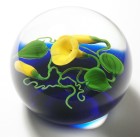 |
| 5960 | Perthshire Annual Collection 1982H Limited
Edition Double Overlay Floral Bouquet Paperweight. issued
1982. This is a special floral design featuring a bouquet of
flowers within a blue and white double overlay cut deeply to show
alternating blue and white sides. The bouquet has three
lampwork flowers and two opening buds with leaves and stems on on
clear ground. The flowers have complex millefiori
centers. There is a flat top facet, fancy cut side facets, and
a star cut base. The effect of the cutting is to make the
overlay resemble blue and white petals. There is a complex "P"
signature cane next to the stem. This paperweight is #37 of a
limited edition of 300 weights, of which only 205 were made.
It comes with its original Perthshire certificate and box.
Great color and execution.
Perthshire made this paperweight as one of their Annual Collection designs for 1982. This means the design was made only that one year and never again. There were eight Annual Collection designs in 1982, designated A through H. The annual collection paperweights are the most desirable of the Perthshire line, with the exception of one of one items. Perthshire was a small company in Crieff, Scotland that was devoted to the creation of quality glass paperweights. They stopped production in January 2002 after more than 30 years of production. Their paperweights were consistently high in quality and yet remained reasonable in price. There are three books on Perthshire Paperweights. If you collect Perthshire paperweights, you should have them in your library.
Size: Just under 2 5/8" diameter by 1 3/4"
high. There is a fancy star cut on the base. For extra pictures, click on the picture at the right and the following links: Large picture$395 postage paid in the US. Added 7/14/2022 For more information about Perthshire Paperweights, see my Perthshire Web Page. Click on the picture to see a larger image. |
Click
on the picture to see a larger image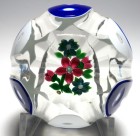 |
| 5640 | Large Murano Crown Hollow Blown
Paperweight - Probably Fratelli Toso. circa
1950-1970. Colorful Murano crown crown paperweight. The
weight is formed from 16 alternating strands of pink , red, and
lavender twists. This crown paperweight is unusual in that it
is hollow blown with a large bubble in the center in the style of
antique crown paperweights. Most modern crown paperweights are solid
in the center. A great example for any collector of
paperweights or Murano glass. Probably made by Fratelli
Toso.
Crown weights are considered by some to be the most exciting of all millefiori designs. They are extremely difficult to make. Hollow blown crown weights are even more difficult to make and are hard to find. A similar hollow crown paperweight appears on page 51 of the book Paperweights by Sibylle Jargstorf and is attributed to Fratelli Toso. This paperweight was made on the island of Murano in Venice, Italy. Venetian glass making dates back centuries and the Venetians are given credit for the earliest millefiori canes and paperweights in 1840s. More recently, paperweight making was revived in the 1930s and again in the 1960s. Fratelli Toso was started in 1854 by six brothers - Angelo Toso, Giovanni Toso, Ferdinando Toso, Carlo Toso, Gregorio Toso and Liberato Toso. They were joined by Ermanno Toso in 1924 who became artistic director. The Fratelli Toso company is well known for its use of colorful murrines and millefiori, particularly during the 1950's and earlier. In 1979, the company suffered a harsh economic crisis, forcing the owners to divide it into Antica Vetreria Fratelli Toso and Fratelli Toso International. In 1981, Fratelli Toso International filed for bankruptcy and closed its doors for good. Antica Vetreria Fratelli Toso, led by Arnoldo Toso, continued to operate. Large Size: Just under 2 15/16" diameter by 2
3/8" high. The bottom is polished flat. For extra pictures, click on the picture at the right and the following links: Large pictureSOLD. Added 7/7/2022 For more information about Murano paperweights, see my Murano Paperweights Web Page . Click on the picture to see a larger image. |
Click
on the picture to see a larger image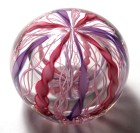 |
| 5558 | Large Antique Baccarat Dupont Period Type
III Pansy Paperweight with Star Cut Base. circa
1900-1920. Baccarat Pansy paperweight with leaves and
stem. The base is finished with a Baccarat star cut.
This paperweight is from Baccarat's Dupont period. This style
of pansy is called a type III pansy. It consists of two large
velvet purple petals above over three lower petals. The lower
petals are amber yellow over a white base. Each lower petal
has a purple tip and three dark lines radiating from the central
cane consisting of star canes with a red whorl center. A large
paperweight in great shape. Note: This paperweight has been restored in the past and has a relatively flat profile. There is plenty of glass and it could be reshaped to give it a proper profile. Note about provenance: The previous owner acquired this paperweight at the Selman Auction 37 (Fall 2006) Lot 41 and paid $460 including the bidders premium for the paperweight. Baccarat was founded in 1776 in Alsace-Lorraine with the name of Verrerie de Sainte Anne. The original location was near the town of Baccarat. Today the firm is known as Compagnie des Cristalleries de Baccarat. Most collectors refer to three periods of Baccarat paperweight production.
Large size: 3 1/8" diameter by 2" high. The
bottom is polished flat and finished with a Baccarat star cut
base. It has a relatively flat profile as shown in the
pictures. For extra pictures, click on the picture at the right and the following links: Large picture SOLD. Added 7/7/2022 For more information about Baccarat paperweights, see my Baccarat
Paperweights
Web Page. (dl-bac-ant) Click on the picture to see a larger image. |
Click
on the picture to see a larger image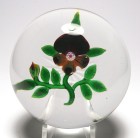 |
| 4064 | Orient & Flume Iridescent Figural Pear
Paperweight. circa 2003. Wonderful hand crafted
Orient & Flume pear paperweight having a stem and leaf.
The surface is has a light green iridescent sheen. Signed on
the base "Orient & Flume GQT3". A wonderful example.
Orient & Flume was started in 1972 in Chico, California by Douglas Boyd and David Hopper. It studio took its name from its initial location which was at the corner of Orient & Flume. Their early weights adopted a style that has become known as the California style of iridescent paperweights with surface torchworked art nouveau motifs on the outside surface of the weight. Later work involved interior lampworked designs. Every Orient & Flume piece has a registration number which usually includes a date code. In this case, I believe the "G" is for 2003. Size: 2 9/16" diameter by just over 4 7/16" high
including the stem. The bottom has been ground flat. For extra pictures, click on the picture at the right and the following links: Large picture$75 postage paid in the US. Added 7/4/2022 For more paperweights by contemporary American paperweight makers, see my Contemporary American Paperweights Web Page. Click on the picture to see a larger image. |
Click
on the picture to see a larger image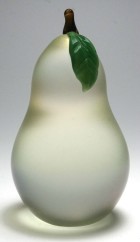 |
| 4062 | Large Caithness 1993 Margot Thomson Gold
Congratulations (Style Two) Abstract Paperweight.
issued in 1993. This abstract Caithness paperweight depicts a
woven gold "cap" with four descending tassels. There are
carefully placed bubbles at the corners of the cap and at the tip of
each tassel. All of this is surrounded by a mist of
transparent white glass. The paperweight is signed on
the base "Caithness CONGRATULATIONS Scotland" along with a
registration number "T89628". Designed by Margot
Thomson.
This design is listed and designated CT-985 on page 147 of the Charlton Standard Catalog of Caithness Paperweights. It was designed in 1993 by Margot Thomson as part of the Weight - Spherical series. The paperweight is recorded as coming in three colors (Gold, Ruby, and Silver). Caithness Glass was founded by Robin Sinclair in Wick in north eastern Scotland in 1961. The factory did not start making paperweights until 1962 when Paul Ysart joined Caithness. Colin Terris joined Caithness in 1968 and started the modern line of paperweights in 1969. A second factory was opened in Oban in 1969 and the Perth factory opened in 1979. In 1980, Caithness purchased the Whitefriars name and designs. More recently Caithness recently went through a number of changes of ownership. After going into receivership in 2004, it was purchased by Edinburgh Crystal, but went into receivership again in 2006. Finally, it was bought out of receivership by Dartington Crystal. The factories in Wick, Oban and Perth all closed and were replaced by a smaller operation and visitors' center in Crieff. Caithness is still operating in Crieff and making paperweights today (in 2022). Large size: 3 1/8" diameter by just under 2 7/8"
high. The base is polished flat. For extra pictures, click on the picture at the right and the following links: Large picture$45 postage paid in the US. 7/4/2022 For more information about paperweights made by Scottish makers, see my Scottish Paperweights Web Page Click on the picture to see a larger image. |
Click
on the picture to see a larger image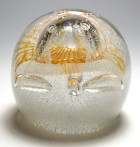 |
| 5685 | Rare Whitefriars 1976 Bicentennial
Millefiori Flag Limited Edition Paperweight - damaged.
circa 1976. This is a hard to find Whitefriars Bicentennial
Paperweight featuring a millefiori mosaic of the American
Flag. There are thirteen blue and white canes for stars and
four red and three white canes for the stripes. A gold cane
makes provides a staff . In the background there is a white
and gold carpet ground of millefiori canes and also a millefiori
garland of blue and white canes on the outside. This weight is
numbered 135 on the base. There is a special Whitefriars
signature cane with a white monk and the years 1776 and 1976.
It also has its original paper label with a Whitefriars monk symbol
and the text "WHITEFRIARS FULL LEAD CRYSTAL MADE IN ENGLAND".
The paperweight also comes with its original (wrinkled) certificate
which states that it is number 135 in a limited edition of 150
paperweights. The paperweight is made using full lead crystal
which gives it a brilliant finish. It is faceted with a top
facet and five side facets.
This is an especially rare Whitefriars paperweight.
Although the edition size was planned for 1,000 paperweights, very
few were made due to the complexity of the design made setup and
pickup very difficult. The certificate states that only 150
were actually made. It was made for sale in the US only. Modern Whitefriars paperweights are prized by collectors for their high quality glass and millefiori designs. The limited edition paperweights with mosaic canes are especially sought after. The name Whitefriars Glass dates from sometime in the 1600s. The original site had been occupied by a community of Carmelite monks known as White Friars, hence the name taken by the glass company. Some sources state that at least a portion of the company operated under the name of James Powell and Sons from 1834 to 1962. Other sources state that the Whitefriars name was used from 1680 to 1980. Limited production of millefiori paperweights and other millefiori items started some time in the 1930s and first appeared in the 1938 catalog. Millefiori items were made using English full lead crystal (33% lead oxide). It is difficult to associate specific paperweights with this production. After 1945, they made colored glass and bubble design paperweights until the modern millefiori production started about 1951. Even then relatively few designs were produced until the 1970s. In 1980, Whitefriars glass went out of business. After Whitefriars Glass was liquidated, Caithness Glass purchased the rights to the name and produced paperweights under the Whitefriars name for a while. For a long time, collectors believed that English paperweights and inkwells dated 1848 and similar undated items were made by Whitefriars. The dates, however, are false dates and have been traced to production at Arculus and Walsh-Walsh in the 1920s and 1930s. Most paperweights referred to as old Whitefriars or antique Whitefriars were, in fact, made by other factories such as Richardson, Arculus, Walsh-Walsh, or one of the unidentified Old English factories. When the maker can not be identified, it is best to call them Old English paperweights and not associate them with Whitefriars. Size: 3 1/16 diameter by 1 3/4" high. The base
is ground concave. Faceted with one top facet and five side
facets. For extra pictures, click on the picture at the right and the following links: Large picture$235 postage paid in the US. Added 6/18/2022 For more information about Whitefriars and other paperweights from England, see my English Paperweights Web Page. Click on the picture to see a larger image. |
Click
on the picture to see a larger image |
| 5690 | Great Early Robert Eickholt Translucent
Double Hearts Paperweight. Circa 1981. This
surface decorated paperweight consists of a hearts and vines
design with two hearts on the surface of a translucent gold colored
paperweight. This is an early Robert Eickholt paperweight and
is signed on the bottom "R. Eickholt 1981". Eickholt called
this design "Double Hearts." Robert Eickholt has been making glass paperweights since 1978 when he founded Eickholt Glass in Columbus, Ohio. His designs often make use of precious metals such as gold and silver, and rare oxides such as cobalt and copper. This is an early example of the use of gold color. In later paperweights by Eickholt the design moved to the interior and veiling techniques began to appear. He retired in 2013. Large Size: 3 1/8" diameter by 2 15/16" high.
The base is polished flat. For extra pictures, click on the picture at the right and the following links: Large picture$125 postage paid in the US. Added 6/18/2022 For more paperweights by contemporary American paperweight makers, see my Contemporary American Paperweights Web Page. Click on the picture to see a larger image. |
Click
on the picture to see a larger image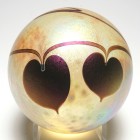 |
| 5566 | Large Colorful Strathearn Paneled
Millefiori Paperweight. circa 1963-1968. This very
attractive paperweight consists of a paneled millefiori pattern with
nine panels of 1 (blue) + 2 (red) + 2 (orange and white) millefiori
patterns each separated by a white latticinio twist cane.
There is a central ring of seven dark blue millefiori canes
and then a center orange and white millefiori cane. The canes
are early Scottish millefiori canes on an opaque black ground.
This paperweight has its original Strathearn paper label "STRATHEARN
HAND MADE IN SCOTLAND" on the base. It also has a sticker from
an early Selman auction. This is a great addition to any
collection of Scottish paperweights. Great color. This paperweight has a sticker on the base from an early Selman Online Auction (Auction 7 Lot 68). This is online auction is different from the auctions that had print catalogs. The previous owner paid $200 for this paperweight. The birth of Scottish paperweight making is credited to the glass making family of Salvador Ysart, who moved to Crieff, Scotland in 1922. They worked first at John Moncrieff Ltd and made the earliest Scottish paperweights during that period. In 1946 Salvadore and his sons Augustine and Vincent founded Ysart Brothers Glass and produced glass wares under the Vasart label. Salvador Ysart died in 1955 The company name was later changed to Vasart Glass. Strathearn Glass was formed in a reorganization of Vasart glass in 1963. The new company was owned by Teachers Whiskey. The company is no longer in existence. Large size: Just under 3” diameter by 2 1/4”
high. The base is fire polished. For extra pictures, click on the picture at the right and the following links: Large picture$125 postage paid in the US. Added 6/17/2022 For more information about paperweights made by Scottish makers, see my Scottish Paperweights Web Page Click on the picture to see a larger image. |
Click
on the picture to see a larger image |
| 5599 | Perthshire 1982
PP49 Limited Edition Patterned Millefiori Paperweight with
Complex Canes. dated 1982. This medium sized
millefiori paperweight has a large complex center cane surrounded by
four large complex canes and a closepacked carpet of many smaller
pink canes. Three pairs of large complex canes surround the
center cluster. The perimeter of the paperweight has a garland
with three large half circles and three small half circles, each
with a large complex cane in the center. The design is placed
over a translucent green ground. It is signed with a
Perthshire "P 1982" date / signature cane in the center of the base
and also has its original worn paper label "PERTHSHIRE PAPERWEIGHTS
CRIEFF SCOTLAND" on the base. The PP49 design was issued in a
limited edition only in 1982, with the edition size unknown. A
beautiful addition to any collection of Perthshire
paperweights.
Perthshire was a small company in Crieff, Scotland that was devoted to the creation of quality glass paperweights. They stopped production in January 2002 after more than 30 years of production. Their paperweights were consistently high in quality and yet remained reasonable in price. The birth of Scottish paperweight making is credited to the glass making family of Salvador Ysart, who moved to Crieff, Scotland in 1922. They worked first at John Moncrieff Ltd and made the earliest Scottish paperweights during that period. In 1946 Salvadore and his sons Augustine and Vincent founded Ysart Brothers Glass and produced glass wares under the Vasart label. Salvador Ysart died in 1955 The company name was later changed to Vasart Glass. Stuart Drysdale was hired manage the business side of the enterprise in 1960. The company evolved into a new company Strathearn owned by Teachers Whiskey. In 1967 Drysdale was sent a magazine article on antique paperweights (Woman's Day, July 1965). The inspired him to try to produce weights comparable to the French antiques. With this goal in mind, he and several of the glass workers left Strathearn to found Perthshire in 1968. Large size: Just over 2 5/8" diameter by 1 15/16"
high. The base is polished concave. For extra pictures, click on the picture at the right and the following links: Large picture$345 postage paid in the US. Added 6/4/2022 For more information about Perthshire Paperweights, see my Perthshire Web Page. Click on the picture to see a larger image. |
Click
on the picture to see a larger image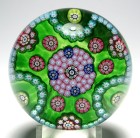 |
| 5894 | Large Faceted Strathearn Spaced Millefiori
on Lace Paperweight with Early Scottish Canes. dated
1979. This fine Strathearn spaced millefiori on lace
paperweight features sixteen early Scottish millefiori canes that
were originally made in the Moncrieff (Monart) or Vasart
period. The paperweight was made by either David Moir or
Herbert Dreier and has a (distorted) Strathearn complex signature
cane "S 79" on the base. The paperweight is faceted with one
large top facet and five side facets. This would make a
fantastic addition addition to any collection of Scottish
paperweights. According to David Moir, the millefiori canes in this paperweight are old Monart type canes that were brought with by the Ysarts when they left Moncrieff. They were never used and kept out of the way until David Moir and Herbert Dreier were given permission to use them in 1979 by the management at Teachers Whiskey (who owned Strathearn). Some of the individual canes might be attributed to Salvadore during the early Vasart period rather than Monart. The birth of Scottish paperweight making is
credited to the glass making family of Salvador Ysart, who moved
to Crieff, Scotland in 1922. They worked first at John
Moncrieff Ltd and made the earliest Scottish paperweights during
that period. In 1946 Salvadore and his sons Augustine and
Vincent founded Ysart Brothers Glass and produced glass wares
under the Vasart label. Salvador Ysart died in 1955
The company name was later changed to Vasart Glass. Strathearn
Glass was formed in a reorganization of Vasart glass in
1963. The new company was owned by Teachers Whiskey.
The factory was taken over by Stuart Glass in 1980 and renamed
Stuart Strathearn Ltd. After 1980, this factory ceased
production of paperweights and stopped all production in
1992. Stuart Crystal ceased all operations in 2001. David Quintin Moir (born 1939) started as an apprentice at Vasart (Ysart Brothers Shore Road works) in 1954. He stayed when the name was changed to Strathearn and left in 1980. He often contributes to discussions of Scottish glass on Facebook. Herbert Dreier (born 1942 to an
Austrian coal-mining family) was originally destined to work in
the mines, but he left to join a glass factory in Bärnbach,
Austria where served a three year apprenticeship. In 1960,
he moved to Germany where he worked for Peill Butzler, Dren,
Germany as a glass blower. He and a friend responded to an
advertisement for Caithness Glass and moved to Wick, Scotland,
where he worked as a glass blower under Paul Ysart from 1963-65,
later moving to Strathearn Glass as Master Craftsman. He
remained with Strathearn through the takeover by Stuart Crystal
and had a number of positions with Stuart Crystal. When
Stuart ceased operation in 2001, he moved to Plowden &
Thompson in Stourbridge as a Master Craftsman. In a
life-time devoted to the art of glassblowing, Herbert Dreier’s
repertoire encompassed paperweights, lamp-bases, decorative
bowls, vases and three-dimensional decorative pieces. Size: 3” diameter by 2 3/16" high. The
base is polished flat. The paperweight is faceted with one
large top facet and five side facets. For extra pictures, click on the picture at the right and the following links: Large pictureSOLD. Added 5/25/2022 For more information about paperweights made by Scottish makers, see my Scottish Paperweights Web Page Click on the picture to see a larger image. |
Click
on the picture to see a larger image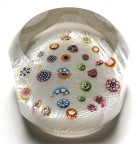 |
| 5512 | Baccarat 1975 Gridel Series Millefiori
Black Monkey Limited Edition Paperweight. dated
1975. This modern millefiori paperweight features a large
central black monkey silhouette on a white background surrounded by
two concentric rings of picture canes (seventeen Gridel canes plus a
signature / date cane). The design is placed over a green
carpet ground. The paperweight is signed in the design with
Baccarat's complex signature cane "B 1975". It also has an
acid etched Baccarat mark on the base along with the year (1975) and
edition number (262). This is the most popular of the Gridel
series paperweight. This design was released in 1975 in a limited edition of 350 pieces. This is number 262 in that series. There is a signature cane "B 1975" shown in the pictures. The bottom has the acid etched Baccarat logo plus it is engraved with the year (1975) and the number (262). In 1846 Baccarat introduced the popular Gridel figures in their closepack millefiori paperweights. It was named after Emil Gridel, the nephew of Jean-Baptiste Toussaint the general manager of Baccarat. Toussaint saw Gridel making paper cutouts of animals and saw an opportunity to incorporate these silhouettes in millefiori paperweights. From 1971 to 1979 Baccarat issued a modern Gridel series of millefiori paperweights based on eighteen Gridel figures. Each paperweight has a large Gridel figure in the center with smaller versions of the other figures included in the design. There are variations in orientation and color as well as the types of canes in each design and it is possible to amass a very large collection covering just this series. Baccarat was founded in 1776 in Alsace-Lorraine with the name of Verrerie de Sainte Anne. The original location was near the town of Baccarat. Today the firm is known as Compagnie des Cristalleries de Baccarat. Most collectors refer to three periods of Baccarat paperweight production.
In 1952, Paul Jokelson approached Baccarat with the idea of making sulphide paperweights again. In 1953 Baccarat resumed paperweight production with a series of sulphide paperweights the first of which were the unsuccessful Eisenhower sulphide followed by the Queen Elizabeth coronation sulphide. Millefiori paperweight production was resumed in 1957 and lampwork paperweights were re-introduced in the early 1970s. Baccarat stopped making this type of fine glass paperweights in 2002. You can read more about the Baccarat paperweights in the new book Baccarat Paperweights - two centuries of beauty by Paul Dunlop or one of the older books on paperweights in general, such as The Encyclopedia of Glass Paperweights by Paul Hollister or World Paperweights by Robert Hall. Large Size: 3 1/8" diameter by just under 2 1/4"
high. The base is polished flat with an
indent for the edition number. For extra pictures, click on the picture at the right and the following links: Large pictureSOLD. Added 5/15/2022 For more information about Baccarat paperweights, see my Baccarat Paperweights Web Page Click on the picture to see a larger image. |
Click
on the picture to see a larger image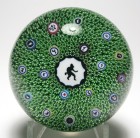 |
| 5385 | Large Antique New England Glass Company
(NEGC) Salmon Red Double Poinsettia Paperweight on a Blue and
White Jasper Ground. circa 1860 - 1888. This is an
antique New England Glass Company (NEGC) double poinsettia with a
two rings of five salmon red petals arranged around an interesting
complex millefiori center. Well place bubbles give the
appearance of dew drops. There are also three well formed NEGC
green leaves and a green stem. The design is placed over
wonderful blue and white jasper ground giving this paperweight a
patriotic red, white, and blue theme. Unlike many NEGC
poinsettias, the flower is fairly well centered. This
paperweight will be a worthwhile addition to any collection of
antique American paperweights. The New England Glass Company (NEGC) operated in Cambridge, Massachusetts from 1818 to 1888. You can read about paperweights from the New England Glass Company in the book by John Hawley. The Art of the Paperweight - The Boston & Sandwich and New England Glass Companies covers both B&S and NEGC.
Large Size: 2 11/16" diameter by1 5/8" high.
The base is ground concave. It has a relatively flat
profile. For extra pictures, click on the picture at the right and the following links: Large picture$495 postage paid in the US. Added 5/10/2022 For more information about Antique Paperweights, see my Antique Paperweights Web Page. Click on the picture to see a larger image. |
Click
on the picture to see a larger image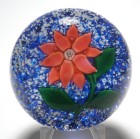 |
| 5362 | Robert Banford Blue Clematis with
Buds and Dragonfly Paperweight. circa 1980. This
compound paperweight features a wonderful large dragonfly hovering
above a striped blue clematis. The clematis has a yellow
center and two buds in various states of opening. There are
many green leaves and a stem. The design is set in clear
crystal with an opaque white ground at the base of the
paperweight. The paperweight is compound with the two levels
above the ground layer. The flower floats in the middle layer
and the dragonfly hovers above the flower. The paperweight is
signed with Bob Banford's “B” signature cane at the tip of the
stem. A very desirable addition to any collection of
contemporary American paperweights. Note: The bright light used to take the pictures exaggerate the refractive lines where the layers of glass are joined. This is normal in compound paperweights that use high quality glass. Note 2: There is a 3/16" flaw near the base of this of the paperweight. I'm not sure what caused this. It is not a chip or crack. Robert Banford worked in Hammonton, NJ. He started making paperweights in 1971 along with his father, Ray Banford. Bob continued to make paperweights until 2006. Bob and Ray did not date their paperweights, but it is sometimes possible to get an idea of when a paperweight was made by the progression of styles and the type of glass used. Bob Banford used a signature cane with a red "B" and a blue surround. Ray Banford used a different signature cane with a black B. Ray passed away in 2003.
Large size: 2 3/4" diameter by just over 2 5/16"
high. The white base is polished flat. For extra pictures, click on the picture at the right and the following links: Large picture$345 postage paid in the US. Added 5/9/2022 For more paperweights by contemporary American paperweight makers, see my Contemporary American Paperweights Web Page. Click on the picture to see a larger image. |
Click
on the picture to see a larger image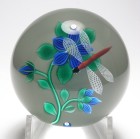 |
| 5615 | Perthshire Annual Collection 1982B Limited
Edition Flamingo Paperweight with Certificate.
dated 1982. This paperweight features a pink flamingo standing
on one leg in a blue pond with two water lilies and two cat
tails. There is a translucent blue and green ground. The
paperweight has a single top facet. It is signed with a
complex "P 1982" signature cane in the center of the base. It
also has its original worn Perthshire
paper label "PERTHSHIRE PAPERWEIGHTS CRIEFF SCOTLAND" on the base
and comes with its original (somewhat wrinkled) certificate
stating that this is edition number 26 in a limited edition of 300
paperweights (of which only 184 were made). An
unusual design from Perthshire..
Perthshire made this paperweight as one of their Annual Collection designs for 1982. This means the design was made only that one year and never again. There were eight Annual Collection designs in 1982, designated A through H. This design is designated 1982B. The annual collection paperweights are the most desirable of the Perthshire line, with the exception of one of one items. Perthshire was a small company in Crieff, Scotland that was devoted to the creation of quality glass paperweights. They stopped production in January 2002 after more than 30 years of production. Their paperweights were consistently high in quality and yet remained reasonable in price. The birth of Scottish paperweight making is credited to the glass making family of Salvador Ysart, who moved to Crieff, Scotland in 1922. They worked first at John Moncrieff Ltd and made the earliest Scottish paperweights during that period. In 1946 Salvadore and his sons Augustine and Vincent founded Ysart Brothers Glass and produced glass wares under the Vasart label. Salvador Ysart died in 1955 The company name was later changed to Vasart Glass. Stuart Drysdale was hired manage the business side of the enterprise in 1960. The company evolved into a new company Strathearn owned by Teachers Whiskey. In 1967 Drysdale was sent a magazine article on antique paperweights (Woman's Day, July 1965). The inspired him to try to produce weights comparable to the French antiques. With this goal in mind, he and several of the glass workers left Strathearn to found Perthshire in 1968. Size: Just under 2 5/8" diameter by 1 11/16"
high. The base is ground concave. Faceted with one
large top facet. For extra pictures, click on the picture at the right and the following links: Large pictureSOLD. Added 5/8/2022 For more information about Perthshire Paperweights, see my Perthshire Web Page. Click on the picture to see a larger image. |
Click
on the picture to see a larger image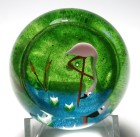 |
| 5916 | Randy Strong 2003 Abstract Flat Top
Iridescent Millefiori Paperweight. dated
2003. Contemporary abstract millefiori style paperweight
created by Randy Strong of Berkeley, California. The paperweight has
an unusual shape with the a large top and small base. It has
white and pink millefiori and an outer "garland" of white latticinio
twists. Iridescent pieces of blue and copper color fill in the
empty spaces. There is also a controlled pattern of tiny
bubbles in the clear glass edge. The underlying ground color
is black. It is signed "R. Strong 2003". A fun
paperweight with great color. Note: This paperweight has an unusual shape with the flat top considerably larger then the base. It is not a typical dome shaped object. Randy Strong has studied at the California College of Arts and Crafts, Oakland, CA and has a Bachelor of Fine Arts 1971 from the Osaka University of the Arts, Osaka, Japan. He has been blowing glass and running his own studio in Northern California for over 40 years. His work has been collected and displayed throughout the world in such places as The Corning Museum of Glass (New York), The Louvre, the Osaka Museum of Art, The San Francisco Museum of Art, The Ludwig Schaffrath Collection (Germany), The John D. Rockefeller Collection, the IBM Collection (USA) and at the American Crafts exhibitions at Baltimore, West Springfield and Rhinebeck. Size: Just under 3" diameter at the top by 1 1/4"
high. The base has a diameter of 1". The top has a
flat profile. The base is ground flat. For extra pictures, click on the picture at the right and the following links: Large pictureSOLD. Added 4/29/2022 For more paperweights by contemporary American paperweight makers, see my Contemporary American Paperweights Web Page. Click on the picture to see a larger image. |
Click
on the picture to see a larger image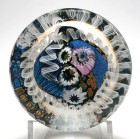 |
| 5934 | Perthshire Annual Collection 1981C Limited
Edition Magnum Aquarium Paperweight. dated
1981. This magnum paperweight features a colorful assortment
of sea life in a three dimensional display. There is a green
seahorse, a blue crab, a brown snail, and two fish amidst a large
pink seaweed. The design is placed on a grey sand
ground. It is signed with a complex "P 1981" signature cane in
the center of the base. It is also engraved with Peter
McDougall's "PMcD" signature on the base. It is faceted with
one large top facet and 24 side facets in three rows. This
design was made in a 1981 limited edition of 350 paperweights of
which 237 were actually made. It comes with its original
box. A very large stunning paperweight from Perthshire.
Perthshire made this paperweight as one of their Annual Collection designs for 1981. This means the design was made only that one year and never again. There were eight Annual Collection designs in 1981, designated A through H. This design is designated 1981C. The annual collection paperweights are the most desirable of the Perthshire line, with the exception of one of one items. Perthshire was a small company in Crieff, Scotland that was devoted to the creation of quality glass paperweights. They stopped production in January 2002 after more than 30 years of production. Their paperweights were consistently high in quality and yet remained reasonable in price. The birth of Scottish paperweight making is credited to the glass making family of Salvador Ysart, who moved to Crieff, Scotland in 1922. They worked first at John Moncrieff Ltd and made the earliest Scottish paperweights during that period. In 1946 Salvadore and his sons Augustine and Vincent founded Ysart Brothers Glass and produced glass wares under the Vasart label. Salvador Ysart died in 1955 The company name was later changed to Vasart Glass. Stuart Drysdale was hired manage the business side of the enterprise in 1960. The company evolved into a new company Strathearn owned by Teachers Whiskey. In 1967 Drysdale was sent a magazine article on antique paperweights (Woman's Day, July 1965). The inspired him to try to produce weights comparable to the French antiques. With this goal in mind, he and several of the glass workers left Strathearn to found Perthshire in 1968. Very large size: 3 3/8" diameter by 2 11/16"
high. The base is ground concave. Faceted with one
large top facet and 24 side facets in three rows. For extra pictures, click on the picture at the right and the following links: Large picture$395 postage paid in the US. Added 4/28/2022 For more information about Perthshire Paperweights, see my Perthshire Web Page. Click on the picture to see a larger image. |
Click
on the picture to see a larger image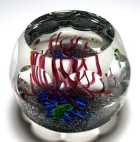 |
| 2012 | Chinese Miniature Orange Butterfly on
Green Ground Paperweight. circa 1940 - 1960. This
paperweight features an orange and yellow winged lampwork butterfly
flying with wings extended over a green frit ground. The
butterfly body is light green with two well defined antennae.
The green ground gives the glass a greenish tinge, but it is mostly
clear glass. This paperweight is unsigned. Note: Please ignore the white areas, they are glare from the lights. Chinese Paperweights were made in the late 1920s and throughout the 1930s as an attempt to duplicate 19th Century antique weights made in the United States and France. Because they are almost 100 years old, they are very collectible and every collector should own a few of these as study pieces. The history of the early Chinese paperweights is mostly anecdotal as no written records have been discovered. The story is that an American dealer sent examples of paperweights made by the New England Glass Company (NEGC), Boston &Sandwich Glass Company (B&S), Millville makers, and French factories to a Chinese factory and requested copies be made. The results are interesting and sometimes confused with the originals by inexperienced collectors. The earliest pictures of these paperweights appeared in the book American Glass Paperweights by Francis Edgar Smith published in 1939. Smith was aware that at least one of the paperweights shown in his book was Chinese. Since Smith was not an expert collector, this indicates that there was some general knowledge that these were Chinese prior to 1939. In the United States, the Tariff Act of 1930 required that every imported item must be conspicuously and indelibly marked in English with its country of origin. As a result, many of these Chinese paperweights are scratch signed on the bottom "CHINA". Many are also not signed, suggesting that either they were imported prior to 1930 or the importer ignored the requirement. Most likely the earliest Chinese paperweights were made prior to 1930. The Chinese makers often combined design features found in paperweights from different makers. For example they copied the latticinio grounds used by New England Glass Company and used them with copies of Baccarat Pansy weights. The original Baccarat pansy paperweights never had a latticinio ground. They copied the pedestal rose from Millville and then used the pedestal bottom with other weights. It is fun to collect all the variations. In general, Chinese paperweights from the
1930s have a light weight glass mixture that is high in soda and
has a greenish tinge. The glass also has a soft almost oily
feel. Frequently they have bubbles or debris in the glass.
And because of their age, many of these have minor scratches or
other surface defects. Chinese paperweights made in the
1970s and later usually have better quality glass and are free
of debris. Miniature size: 2" diameter by 1 5/8"
high. The bottom is flat with remnants of the pontil scar. For extra pictures, click on the picture at the right and the following links: Large picture$39 postage paid in the US. Added 4/28/2022 For more paperweights from China, see my Chinese Paperweights Web Page. Click on the picture to see a larger image. |
Click
on the picture to see a larger image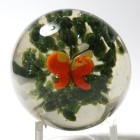 |
| 3547 | Baccarat 1987 Special Edition Double
Trefoil Millefiori Paperweight. dated 1987.
This modern millefiori paperweight features a double trefoil design
with a concentric pattern in the center. It has two interlaced
three lobe garlands of amber and burgundy. The concentric
design has green and amber circles. The design is placed on a
pale yellow lace ground. This was one of the special
paperweights featured in Baccarat's 1987 annual brochure. It
was made in this color arrangement only in 1987. It is signed
with a Baccarat's complex "B 1987" signature / date cane in the
design. This paperweight is also signed on the base with an
acid etched Baccarat mark along with the engraved year (1987) and
edition number (64). A fantastic paperweight. Note: After extensive research in the Baccarat archives, Paul Dunlop concluded that from 1986 to 1989, Baccarat made special editions of four designs using a different color scheme each year. For example, the double trefoil was made in each of the four years, but with a different color scheme each year. These designs were featured in the annual brochure for each year and were numbered sequentially. Although the edition size was not known he estimated that about 200 of each design were made. Baccarat was founded in 1776 in Alsace-Lorraine with the name of Verrerie de Sainte Anne. The original location was near the town of Baccarat. Today the firm is known as Compagnie des Cristalleries de Baccarat. Most collectors refer to three periods of Baccarat paperweight production.
In 1952, Paul Jokelson approached Baccarat with the idea of making sulphide paperweights again. In 1953 Baccarat resumed paperweight production with a series of sulphide paperweights the first of which were the unsuccessful Eisenhower sulphide followed by the Queen Elizabeth coronation sulphide. Millefiori paperweight production was resumed in 1957 and lampwork paperweights were re-introduced in the early 1970s. Baccarat stopped making this type of fine glass paperweights in 2002. You can read more about the Baccarat paperweights in the new book Baccarat Paperweights - two centuries of beauty by Paul Dunlop or one of the older books on paperweights in general, such as The Encyclopedia of Glass Paperweights by Paul Hollister or World Paperweights by Robert Hall. Large Size: Just under 3 3/16" diameter by 2 3/8"
high. The base is polished flat. For extra pictures, click on the picture at the right and the following links: Large picture$465 postage paid in the US. Added 4/22/2022. For more information about Baccarat paperweights, see my Baccarat Paperweights Web Page Click on the picture to see a larger image. |
Click
on the picture to see a larger image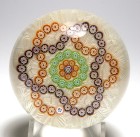 |
| 1868 | Rare 1930s Chinese Butterfly
Paperweight. circa 1930. This paperweight
features a red winged lampwork butterfly flying with wings extended
over millefiori frit ground. The wings are covered with
multi-colored dots. The butterfly body is light blue with two
well defined antennae. The frit ground consists of millefiori
cane slices. This paperweight is signed on the base with a
scratch signature "CHINA". A great example. Note: Please ignore the white areas, they are glare from the lights. Chinese Paperweights were made in the late 1920s and throughout the 1930s as an attempt to duplicate 19th Century antique weights made in the United States and France. Because they are almost 100 years old, they are very collectible and every collector should own a few of these as study pieces. The history of the early Chinese paperweights is mostly anecdotal as no written records have been discovered. The story is that an American dealer sent examples of paperweights made by the New England Glass Company (NEGC), Boston &Sandwich Glass Company (B&S), Millville makers, and French factories to a Chinese factory and requested copies be made. The results are interesting and sometimes confused with the originals by inexperienced collectors. The earliest pictures of these paperweights appeared in the book American Glass Paperweights by Francis Edgar Smith published in 1939. Smith was aware that at least one of the paperweights shown in his book was Chinese. Since Smith was not an expert collector, this indicates that there was some general knowledge that these were Chinese prior to 1939. In the United States, the Tariff Act of 1930 required that every imported item must be conspicuously and indelibly marked in English with its country of origin. As a result, many of these Chinese paperweights are scratch signed on the bottom "CHINA". Many are also not signed, suggesting that either they were imported prior to 1930 or the importer ignored the requirement. Most likely the earliest Chinese paperweights were made prior to 1930. The Chinese makers often combined design features found in paperweights from different makers. For example they copied the latticinio grounds used by New England Glass Company and used them with copies of Baccarat Pansy weights. The original Baccarat pansy paperweights never had a latticinio ground. They copied the pedestal rose from Millville and then used the pedestal bottom with other weights. It is fun to collect all the variations. In general, Chinese paperweights from the
1930s have a light weight glass mixture that is high in soda and
has a greenish tinge. The glass also has a soft almost oily
feel. Frequently they have bubbles or debris in the glass.
And because of their age, many of these have minor scratches or
other surface defects. Chinese paperweights made in the
1970s and later usually have better quality glass and are free
of debris. Medium Size: Just over 2 1/2" diameter by just under
1 3/4" high. The bottom is ground flat. For extra pictures, click on the picture at the right and the following links: Large picture$49 postage paid in the US. Added 4/14/2022 For more paperweights from China, see my Chinese Paperweights Web Page. Click on the picture to see a larger image. |
Click
on the picture to see a larger image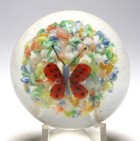 |
| 5624 | Magnum St. Louis 1970 Faceted Red Double
Clematis Paperweight. dated 1970. This
paperweight features a wonderful red double clematis with twelve red
petals in two layers, an emerging bud, green sepals, leaves
and stems. There is a complex yellow St. Louis "SL 1970"
signature / date cane in the center of the clematis. The
signature cane is rotated in its placement (almost upside
down). The design is placed over a opaque dark blue (almost
black) ground. The paperweight is faceted with one large top
facet and six side facets. St. Louis started producing annual
limited editions in 1970. This paperweight, the double
clematis, was issued in a limited edition of 800 paperweights, 300
of which were reserved for the American market. Of those
reserved for American collectors, 150 were red and 150 were
pistachio colored. A wonderful paperweight.
St. Louis started producing annual limited editions in 1970. Only three designs were produced in 1970, this faceted double clematis, a large unfaceted dahlia, and a millefiori double overlay mushroom. These paperweights appear in the the two books on St. Louis paperweights, The Art of the Paperweight - Saint Louis (First Edition (1981) and Second Edition (1995) by Gerard Ingold. Cristalleries de Saint Louis was founded in 1767 in Lorraine, which became part of France in 1766. The region was already home to several glassworks. Paperweight production started at St. Louis in 1845 and most likely continued until about 1860. Although the modern production of paperweights started in 1952, the output of millefiori and lampwork paperweights was small. Fewer than 400 lampwork and millefiori paperweights were made between 1952 and 1955. They were not all signed or dated. The most successful product of this early revival period was the Queen Elizabeth sulphide which was made to commemorate her coronation in 1953. After 1955, no additional weights were made at St. Louis until 1965. In 1965 the factory resumed production of lampwork and millefiori paperweights and then in 1967 they began a series of sulphide weights. Finally, in 1970 they started producing annual limited edition paperweights. In addition to the three types already mentioned, millefiori, lampwork, and sulphide paperweights, St. Louis also made a small number of designs with gold inclusions. Very Large Size : 3 1/4" diameter by 2" high.
The bottom is ground concave. It is faceted with one large
top facet and six side facets. For extra pictures, click on the picture at the right and the following links: Large pictureSOLD. Added 3/17/2022 For more information about paperweights made by the St. Louis factory, see my St. Louis Web Page . Click on the picture to see a larger image. |
Click
on the picture to see a larger image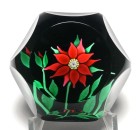 |
| 5277 | Very Early Francis Whittemore Miniature
Yellow Lampwork Flower with Pink Ground Paperweight.
circa 1962 - 1969. This very early paperweight by Francis
Whittemore features a six petal yellow flower with two green leaves
and a stem. It is signed in the design with an early
Whittemore signature cane. The cane has a black "W" on a
yellow background. The design is placed on a pink
ground. It is an important early example of Francis
Whittemore's work and worthy of any collection of Whittemore
paperweights. Note: This lampwork flower paperweight is similar to the millefiori type examples with the same frit ground offered in Larry Selman's first two editions of "CATALOGUE OF COLLECTORS' PAPERWEIGHTS". See the 1970 Catalog (robins egg blue cover) or the 1971 Catalog (olive green cover). Francis Dyer Whittemore, Jr. is considered one of the pioneers of the modern paperweight renaissance. He started working in glass in 1938, but did not start making paperweights until 1962. His studio was in Lansdale, Pennsylvania. Like many other early glass artists, Francis started his career as a scientific glass blower and then later taught glass as an instructor. For five years, he spent one month a year consulting at Baccarat to help them refine their lampwork paperweight art. Some sources have this consulting work from 1971 to 1976. Other sources have it starting later. The signature cane used on this paperweight was one he developed prior to working at Baccarat. Most of his paperweights are miniature to medium in size. You can read about Francis Whittemore in the book American Glass Paperweights and Their Makers by Jean Melvin (1970). Size: 2 5/16" diameter by 1 3/16" high. This paperweight has a very low profile. The base is polished concave.Signature: Signed in the design with an early Whittemore signature cane. The cane has a black "W" on a yellow background. Condition: Excellent condition. No chips, cracks, or scratches found on inspection. For extra pictures, click on the picture at the right and the following links: Large picture$195 postage paid in the US. Added 3/16/2022 For more paperweights by contemporary American paperweight
makers, see my Contemporary
American Paperweights Web Page. (dl-ca-va) |
Click
on the picture to see a larger image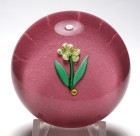 |
| 5621 | Miniature Strathearn Eight Pointed Star
Concentric Millefiori Paperweight with Opaque Turquoise Ground.
circa 1963-1968. This miniature paperweight features a three
ring concentric millefiori design and is finished as a eight pointed
star. The ground is an opaque turquoise. The star points
give the glass a glittery appearance. This paperweight has a
Strathearn paper label with a leaping salmon and "STRATHEARN HAND
MADE IN SCOTLAND" on the base. A great addition to any
collection of Scottish glass. This is called a pressed weight because a mold is used to form the shape. The top is flattened. The star points give the glass a real glittery appearance as you can see in the pictures. The birth of Scottish paperweight making is credited to the glass making family of Salvador Ysart, who moved to Crieff, Scotland in 1922. They worked first at John Moncrieff Ltd and made the earliest Scottish paperweights during that period. In 1946 Salvadore and his sons Augustine and Vincent founded Ysart Brothers Glass and produced glass wares under the Vasart label. Salvador Ysart died in 1955 The company name was later changed to Vasart Glass. Strathearn Glass was formed in a reorganization of Vasart glass in 1963. The new company was owned by Teachers Whiskey. Miniature size: 2” diameter by 1 3/16”
high. The base is fire polished. For extra pictures, click on the picture at the right and the following links: Large picture$59 postage paid in the US. Added 3/4/2022 For more information about paperweights made by Scottish makers, see my Scottish Paperweights Web Page Click on the picture to see a larger image. |
Click
on the picture to see a larger image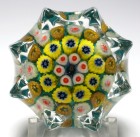 |
| 5648 | Magnum Selkirk 1988 Limited Edition
Abstract Calypso Paperweight with Certificate. dated
1988. This paperweight has a colorful abstract design
reminiscent of a twirling calypso dancer kicking up dust on the
ground. It is number 51 out of a limited edition of 500
paperweights. It is signed in script on the base "SELKIRK
GLASS SCOTLAND CALYPSO 51/500 1988" and comes with its original
certificate. A fantastic item from Selkirk Glass. Selkirk Glass founded in 1977 by
Peter Holmes and Ron Hutchinson. Peter apprenticed under
Paul Ysart at Caithness from 1963 and continued at Caithness
until 1977. Ron Hutchinson, a graduate of Edinburgh
University, was also at Caithness. Selkirk produced a wide
range of paperweight styles including abstract, lampwork and
millefiori paperweights. The company was located in
Selkirk, Scotland in the Borders Region. At some point
they were purchased by Edinburgh Crystal and remained in
operation until 2006. Very large size: 3 5/16" diameter by 2 3/16" high.
The bottom is ground concave. Magnum sized, it weighs 28
ounces. For extra pictures, click on the picture at the right and the following links: Large picture$125 postage paid in the US. Added 2/20/2022 For more information about paperweights made by Scottish makers, see my Scottish Paperweights Web Page Click on the picture to see a larger image. |
Click
on the picture to see a larger image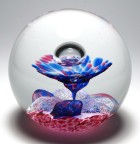 |
| 5530 | Ed Rithner Eight Petal Teal Flower
Paperweight. circa 1940-1970. An upright flower
with eight teal green petals over a speckled green cushion
ground. Each petal has a white outline. The cushion
ground has four pleats with a carefully placed bubble between each
pleat. There is also a planned bubble in the center of the
larger flower at the top. A classic Rithner design.
Ed Rithner worked in Wellsburg, West Virginia from 1908 to the 1970s or later. You can read about Ed Rithner in Jean Melvin's book on American Glass Paperweights and their Makers . All of Rithner's weights are unsigned. Large size: 3" diameter by 2 3/8" high. The
base is fire finished and then ground to a matte finish in the
center to remove the pontil mark. For extra pictures, click on the picture at the right and the following links: Large picture$115 postage paid in the US. Added 2/18/2022 For more vintage American paperweights, see my Vintage American Paperweights Web Page. Click on the picture to see a larger image. |
Click
on the picture to see a larger image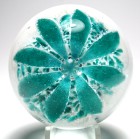 |
| 4837 |
Whitefriars 1978 Christmas Millefiori
Paperweight - The Journey to Bethlehem. dated
1978. This is a hard to find Whitefriars Christmas paperweight
featuring a millefiori mosaic of the Mary and Joseph on their
journey to Bethlehem guided by the Star of Bethlehem shining above
them. Mary is depicted riding a donkey with Joseph leading the
way on foot. There is a light blue carpet ground of complex
millefiori canes surrounding the mosaic and also a two ring
millefiori garland of complex canes on the outside. It is
signed in the design with a Whitefriars signature cane having a
white monk and the year 1978. It also has a worn Whitefriars
paper label with a white silhouette of a monk and the text
"WHITEFRIARS FULL LEAD CRYSTAL MADE IN ENGLAND". This
paperweight was issued in a limited edition of 1,000 paperweights of
which only 610 were sold, including 102 to the United States.
A marvelous paperweight.
The Whitefriars Christmas paperweights were limited editions made in 1975 through 1980, each with a different Christmas theme. The central pictorial mosaic cane was created by Ray Annenburg. Ray started working at Whitefriars in 1953 and became their chief cane maker in 1972. Modern Whitefriars paperweights are prized by collectors for their high quality glass and millefiori designs. The paperweights with mosaic canes are especially sought after. The name Whitefriars Glass dates from sometime in the 1600s. The original site had been occupied by a community of Carmelite monks known as White Friars, hence the name taken by the glass company. Some sources state that at least a portion of the company operated under the name of James Powell and Sons from 1834 to 1962. Other sources state that the Whitefriars name was used from 1680 to 1980. Limited production of millefiori paperweights and other millefiori items started some time in the 1930s and first appeared in the 1938 catalog. Millefiori items were made using English full lead crystal (33% lead oxide). It is difficult to associate specific paperweights with this production. After 1945, they made colored glass and bubble design paperweights until the modern millefiori production started about 1951. Even then relatively few designs were produced until the 1970s. In 1980, Whitefriars glass went out of business. After Whitefriars Glass was liquidated, Caithness Glass purchased the rights to the name and produced paperweights under the Whitefriars name for a while. Large size: 3 1/16" diameter by 1 7/8" high.
The base is ground concave. Faceted with one top facet and five
side facets. For extra pictures, click on the picture at the right and the following links: Large picture$395 postage paid in the US. Added 2/16/2022 For more information about Whitefriars and other paperweights from England,see my English Paperweights Web Page. Click on the picture to see a larger image. |
Click
on the picture to see a larger image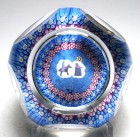 |
| 4325 | Perthshire Annual Collection 1978C Limited
Edition Bluebell Faceted Paperweight.
circa 1978. This paperweight features three Scottish bluebell
blossoms on a stem with green leaves. The design is set on a
clear ground. It has one convex top facet, sixteen convex side
facets in two rows, and a star-cut base. It is signed with a
complex "P" signature cane near the base of the stem. This
design was made in a 1978 limited edition of 350 paperweights of
which all were made. A nice crisp design that glitters. Perthshire made this paperweight as one of their Annual Collection designs for 1978. This means the design was made only that one year and never again. There were six Annual Collection designs in 1978, designated A through F. This design is designated 1978C. The annual collection paperweights are the most desirable of the Perthshire line, with the exception of one of one items. Perthshire was a small company in Crieff, Scotland that was devoted to the creation of quality glass paperweights. They stopped production in January 2002 after more than 30 years of production. Their paperweights were consistently high in quality and yet remained reasonable in price. The birth of Scottish paperweight making is credited to the glass making family of Salvador Ysart, who moved to Crieff, Scotland in 1922. They worked first at John Moncrieff Ltd and made the earliest Scottish paperweights during that period. In 1946 Salvadore and his sons Augustine and Vincent founded Ysart Brothers Glass and produced glass wares under the Vasart label. Salvador Ysart died in 1955 The company name was later changed to Vasart Glass. Stuart Drysdale was hired manage the business side of the enterprise in 1960. The company evolved into a new company Strathearn owned by Teachers Whiskey. In 1967 Drysdale was sent a magazine article on antique paperweights (Woman's Day, July 1965). The inspired him to try to produce weights comparable to the French antiques. With this goal in mind, he and several of the glass workers left Strathearn to found Perthshire in 1968. Small size: 2 1/4" diameter by 1 11/16" high.
The base is finished with a fancy star-cutting. The
paperweight is faceted with one convex top facet and sixteen
convex side facets in two rows. For extra pictures, click on the picture at the right and the following links: Large picture$275 postage paid in the US. Added 2/14/2022 For more information about Perthshire Paperweights, see my Perthshire Web Page. Click on the picture to see a larger image. |
Click
on the picture to see a larger image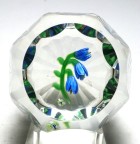 |
| 2128 | Rare Large Chinese White Paperweight with
Squirrel Eating Grapes. circa 1930. This large
Chinese white paperweight has a colored painting of squirrel sitting
upright and eating a luscious bunch of grapes. The painting is
created on a white enamel base and then encased in glass. The
style dates from the 1930s and is almost an antique.
This paperweight is a form of Chinese folk art although it was most likely inspired by frit weights from Southern New Jersey. I believe the Chinese were given examples of Millville frit weights to duplicate. Since they were already experienced in painting on ceramics, they applied their own unique interpretation to paperweights using a white enamel disk as the base and incorporating familiar themes already found in Chinese art. Chinese Paperweights were made in the late 1920s and throughout the 1930s as an attempt to duplicate 19th Century antique weights made in the United States and France. Because they are almost 100 years old, they are very collectible and every collector should own a few of these as study pieces. The history of the early Chinese paperweights is mostly anecdotal as no written records have been discovered. The story is that an American dealer sent examples of paperweights made by the New England Glass Company (NEGC), Boston & Sandwich Glass Company (B&S), Millville makers, and French factories to a Chinese factory and requested copies be made. The results are interesting and sometimes confused with the originals by inexperienced collectors. The earliest pictures of these paperweights appeared in the book American Glass Paperweights by Francis Edgar Smith published in 1939. Smith was aware that at least one of the paperweights shown in his book was Chinese. Since Smith was not an expert collector, this indicates that there was some general knowledge that these were Chinese prior to 1939. In the United States, the Tariff Act of 1930 required that every imported item must be conspicuously and indelibly marked in English with its country of origin. As a result, many of these Chinese paperweights are scratch signed on the bottom "CHINA". Many are also not signed, suggesting that either they were imported prior to 1930 or the importer ignored the requirement. Most likely the earliest Chinese paperweights were made prior to 1930. In general, Chinese paperweights from this period have a light weight glass mixture that is high in soda and has a greenish tinge. The glass also has a soft almost oily feel. Frequently they have bubbles or debris in the glass. And because of their age, many of these have minor scratches or other surface defects. Large size: Just over 2 11/16" diameter by 1
7/8" high. The base is finished base. For extra pictures, click on the picture at the right and the following links: Large picture$195 postage paid in the US. Added 2/11/2022 For more information about paperweights from China, see my Chinese Paperweights Web Page. Click on the picture to see a larger image. |
Click
on the picture to see a larger image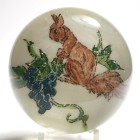 |
| 4309 | Large Iridized Royal Brierley Studio (Isle
of Wight Studio Glass) Paperweight. 1988-1991.
Wonderful patterned paperweight made at the Isle of Wight Studio
Glass as part of their Royal Brierley Studio line. It was
designed by Elizabeth Harris. I believe the pattern is either
the Silk or Lace finish and it features an iridized metallic pattern
on the surface with a brilliant blue core. It is signed on the
base with an acid etched "Royal Brierley Studio" - although the etch
was applied in reverse. There is a lot of confusion on the web as to the origin of the Royal Brierley Studio glass line which was made by the Isle of Wight Studio Glass, Old Park, St Lawrence during the period 1985-2000. The confusion is because of the existence of another company named Royal Brierley Crystal. Isle of Wight Studio Glass was established in 1973 by one of the founders of the British Studio Glass Movement, Michael Harris (1933 – 1994). Michael graduated from the Royal College of Art in 1959 and later became an RCA tutor, setting up hot glass facilities there in 1967. The following year he founded Mdina Glass in Malta, remaining there until 1972, when he moved back to the UK. In 1973, with his wife Elizabeth Harris, he founded Isle of Wight Studio Glass, in Old Park, St Lawrence where it continued until his premature death in 1994. The glass studio continued to operate under the guidance of his son Timothy Harris until 2012. It is worth mentioning that there is also a Royal Brierley Crystal which had a brief connection to the design activity that became Royal Brierley Studio line – but was not the same company. Royal Brierley Crystal traced its origins to Smith & Williams Glass (founded 1846) and before that to Brierley Hill Glass Works (founded in 1740). In the mid 1970s, Catherine Hough was the Artist in Residence for two years at Royal Brierley Crystal. She was experimenting with enameling and electroplating on her blown objects. Royal Brierley Crystal was interested in creating a newer product line of studio glass and Hough assisted in the establishment of a Studio at Royal Brierley Crystal. Michael Harris was commissioned to design these pieces which had an iridized finish over red or blue (Loetz-like). The Studio effort was short lived and ended about 1982, but some of the design ideas were continued by Michael Harris and Elizabeth Harris at the Isle of Wight Studio Glass. Large Size: 3 1/16" diameter and just under 2
11/16" high. The base is polished concave. For extra pictures, click on the picture at the right and the following links: Large picture $125 postage paid in the US.
Added 2/3/2022 For more information about paperweights from England, see my English Paperweights Web Page.
Click on the picture to see a larger image. |
Click
on the picture to see a larger image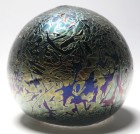 |
| 1700 | Magnum Chinese Copy of the Famous Clichy
Millefiori Basket Paperweight - Heart Shaped. Circa
2000. This very large millefiori paperweight has a basket form
with a heart shaped top. The top is bulging with flowers
arranged in a complex millefiori garland pattern on a moss
ground. The top is edged with a reddish orange and white
torsade lip. The sides of the basket are formed using green
and white staves and the base also has a reddish orange and white
torsade lip. It was originally marketed on the QVC television
network and was sold as a "lamp" with a lighted stand. This
copy does not have the stand. A fun addition to any collection
of glass paperweights. Note: While the resemblance to the antique Clichy basket paperweight is unmistakable, this paperweight is considerably larger than the original which was only 4 1/4" in diameter. The original antique was oval shaped rather than heart shaped. The original Clichy antique held the record for the most expensive paperweight ever sold. It sold for $258,500 to a private collector at a Sotheby's auction in New York on June 26, 1990. Unfortunately it was dropped and damaged beyond repair. You can see the cover of the Sotheby's auction with a picture of the Clichy basket at this link: Sotheby's Catalog Very large size: 7 1/2" wide by 7" deep by 3 7/8"
high. The base is ground flat. It weighs 102 ounces
(six pounds six ounces) and will be approximately eight pounds
when boxed for mailing. For extra pictures, click on the picture at the right and the following links: Large picture$275 plus postage. For this item, because of the weight (8 pounds packaged), the buyer will pay the postage. US Sales only, no international shipping. Added 12/9/2021 For more information about paperweights from China, see my Chinese Paperweights Web Page. Click on the picture to see a larger image. |
Click
on the picture to see a larger image |
| 5513 | Magnum Rosenthal Studio-Linie Swirl
Paperweight. circa 1971 or later. This very large
and wonderful Rosenthal swirl paperweight features a swirl of white
glass over a clear crystal ground. It is acid etch marked on
the base with the name Rosenthal, the crown and crossed swords logo,
and Studio-Linie underneath. A dramatic addition to any
collection of glass paperweights. Rosenthal was founded in 1879 as a family business. Originally the focus was porcelain manufacture and porcelain painting. In 1960, the Rosenthal Studiohaus was opened in Nuremberg and in 1965 the name was changed briefly to Rosenthal Glas & Porzellan AG and then in 1960 to Rosenthal AG in 1969. From 1997 to 2008, the Rosenthal AG owned most of the British-Irish Waterford Wedgwood Group. The Studio-Linie mark was used from 1971 to at least 1995. Since the Rosenthal mark on this paperweight does not identify the country of origin (normally Germany), it is possible that the paperweight was made at Waterford, but I have no evidence one way or the other. Very large size: 4 5/15” diameter by 2 15/16”
high. The base is polished flat. It weighs just under
three pounds (47.1 ounces). For extra pictures, click on the picture at the right and the following links: Large picture$95 postage paid in the US. 11/6/2021 For more paperweights from other countries, see my Other Countries Web Page. Click on the picture to see a larger image. |
Click
on the picture to see a larger image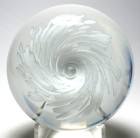 |
| 4285 | Magnum Caithness 1977 Colin
Terris Jubilee Moonflower Limited Edition Paperweight.
dated 1977. This paperweight is one of a group of
four Caithness paperweights created to celebrate the silver jubilee
of Queen Elizabeth II in 1977. The large spherical Caithness
paperweight features a celebratory fountain design with four large
bubbles and a center spray. There are nine smaller bubbles at
a lower level. The design is set over a clear
ground. This paperweight is engraved "EiiR 1952 - 1977"
and the number 501. It is number 501 in a limited edition of
3,000 paperweights. It also has a worn Caithness label "CG
HAND MADE IN SCOTLAND" with writing in blue ink on it. A
beautiful design. The JUBILEE MOONFLOWER design is listed and designated CT-70 on page 18 of the Charlton Standard Catalog of Caithness Paperweights. It was designed in 1977 by Colin Terris. It was released in a limited edition of 3,000 paperweights, all of which were made. This design was one of four paperweights in the HM Queen Elizabeth II Silver Jubilee Collection. Caithness Glass was founded by Robin Sinclair in Wick in north eastern Scotland in 1961. The factory did not start making paperweights until 1962 when Paul Ysart joined Caithness. Colin Terris joined Caithness in 1968 and started the modern line of paperweights in 1969. A second factory was opened in Oban in 1969 and the Perth factory opened in 1979. In 1980, Caithness purchased the Whitefriars name and designs. More recently Caithness recently went through a number of changes of ownership. After going into receivership in 2004, it was purchased by Edinburgh Crystal, but went into receivership again in 2006. Finally, it was bought out of receivership by Dartington Crystal. The factories in Wick, Oban and Perth all closed and were replaced by a smaller operation and visitors' center in Crieff. Very large size: Just under 3 3/16" diameter by 2
11/16" high. The base is polished flat. For extra pictures, click on the picture at the right and the following links: Large picture$65 postage paid in the US. Added 10/29/2021 For more information about paperweights made by Scottish makers, see my Scottish Paperweights Web Page Click on the picture to see a larger image. |
Click
on the picture to see a larger image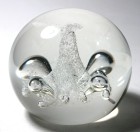 |
| 4805 | Perthshire Annual Collection 1989F Limited
Edition Cherries Faceted Paperweight.
circa 1989. This paperweight features five cherries with green
leaves and stems on a clear ground. The all over honeycomb
faceting makes it appear as if there are many more cherries than
just five. It has a grid cut base and is engraved with a "P"
signature on a facet near the base. This design was made in a
1989 limited edition of 300 paperweights of which only 154 were
made. A nice crisp design with many reflections. Perthshire made this paperweight as one of their Annual Collection designs for 1989. This means the design was made only that one year and never again. There were seven Annual Collection designs in 1989, designated A through G. This design is designated 1989F. The annual collection paperweights are the most desirable of the Perthshire line, with the exception of one of one items. Perthshire was a small company in Crieff, Scotland that was devoted to the creation of quality glass paperweights. They stopped production in January 2002 after more than 30 years of production. Their paperweights were consistently high in quality and yet remained reasonable in price. The birth of Scottish paperweight making is credited to the glass making family of Salvador Ysart, who moved to Crieff, Scotland in 1922. They worked first at John Moncrieff Ltd and made the earliest Scottish paperweights during that period. In 1946 Salvadore and his sons Augustine and Vincent founded Ysart Brothers Glass and produced glass wares under the Vasart label. Salvador Ysart died in 1955 The company name was later changed to Vasart Glass. Stuart Drysdale was hired manage the business side of the enterprise in 1960. The company evolved into a new company Strathearn owned by Teachers Whiskey. In 1967 Drysdale was sent a magazine article on antique paperweights (Woman's Day, July 1965). The inspired him to try to produce weights comparable to the French antiques. With this goal in mind, he and several of the glass workers left Strathearn to found Perthshire in 1968. Large size: 2 7/16" diameter by 1 1/2" high.
The base is fire finished and engraved with the letter "P".
The paperweight is faceted with one large top facet and five side
facets. For extra pictures, click on the picture at the right and the following links: Large picture$395 postage paid in the US. Added 9/4/2021 For more information about Perthshire Paperweights, see my Perthshire Web Page. Click on the picture to see a larger image. |
Click
on the picture to see a larger image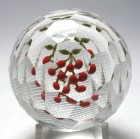 |
| 1693 | Rare Chinese Scramble Paperweight with
"MADE IN CHINA" Signature Canes. circa 1930. An
entertaining addition from China. Since this style was
intended to be a copy of a French scramble or end of day weight from
1845-1860 (probably St. Louis or Clichy), it leaves you wondering
why they chose to add the "MADE IN CHINA" canes at the bottom.
Perhaps it was a response to the US customs requirement that goods
be marked with the country of origin in English starting about
1930. Some importers complied by scratch signing the word
CHINA on the bottom. In any event, this is a rare and welcome
addition to any collection of Chinese paperweights. As
with most Chinese paperweights, this paperweight has a light
weight glass mixture that is high in soda and has a greenish
tinge. The glass has a soft oily feel and there
are some light scratches. This example is especially
colorful with a nice variety of twist cans and millefiori slices. Special thanks to another collector who
pointed out that the words are actually word canes rather than
painted plaques. The lettering goes all the way through
the white background from top to bottom. You can see the
letters in reverse from the bottom. This is in contrast to
a painted plaque where the letters would be visible on only the
top surface. Chinese Paperweights were made in the late 1920s and throughout the 1930s as an attempt to duplicate 19th Century antique weights made in the United States and France. Because they are almost 100 years old, they are very collectible and every collector should own a few of these as study pieces. The history of the early Chinese paperweights is mostly anecdotal as no written records have been discovered. The story is that an American dealer sent examples of paperweights made by the New England Glass Company (NEGC), Boston & Sandwich Glass Company (B&S), Millville makers, and French factories to a Chinese factory and requested copies be made. The results are interesting and sometimes confused with the originals by inexperienced collectors. The earliest pictures of these paperweights appeared in the book American Glass Paperweights by Francis Edgar Smith published in 1939. Smith was aware that at least one of the paperweights shown in his book was Chinese. Since Smith was not an expert collector, this indicates that there was some general knowledge that these were Chinese prior to 1939. In the United States, the Tariff Act of 1930 required that every imported item must be conspicuously and indelibly marked in English with its country of origin. As a result, many of these Chinese paperweights are scratch signed on the bottom "CHINA". Many are also not signed, suggesting that either they were imported prior to 1930 or the importer ignored the requirement. Most likely the earliest Chinese paperweights were made prior to 1930. The Chinese makers often combined design features found in paperweights from different makers. For example they copied the latticinio grounds used by New England Glass Company and used them with copies of Baccarat Pansy weights. The original Baccarat pansy paperweights never had a latticinio ground. They copied the pedestal rose from Millville and then used the pedestal bottom with other weights. It is fun to collect all the variations. In general, Chinese paperweights from the 1930s have a light weight glass mixture that is high in soda and has a greenish tinge. The glass also has a soft almost oily feel. Frequently they have bubbles or debris in the glass. And because of their age, many of these have minor scratches or other surface defects. Chinese paperweights made in the 1970s and later usually have better quality glass and are free of debris.
Small Size: Just over 2 1/16” diameter by just
over 1 1/16" high. The base is fire finished
flat. For extra pictures, click on the picture at the right and the following links: Large picture$125 postage paid in the US. Added 8/30/2021 For more information about paperweights from China, see my Chinese Paperweights Web Page Click on the picture to see a larger image. |
Click
on the picture to see a larger image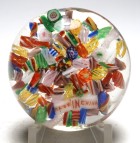 |
| 4281 | Large Whitefriars Faceted Six Ring Red
White & Blue Concentric Millefiori Paperweight. dated
1975. This paperweight has six concentric rings of red, white,
and blue millefiori canes around a center cane with a star
center. The ground is clear crystal. Typical heavy
Whitefriars lead crystal. The paperweight is faceted with a
large top facet and five large side facets. It has a
Whitefriars signature cane with a white monk and the date 1975 in
the outermost white ring (the fifth ring from the center) and also
has a paper label used starting in 1970. With its bold colors,
this is a very nice addition to any collection of millefiori
paperweights. Modern Whitefriars paperweights are prized by collectors for their high quality glass and millefiori designs. The paperweights with mosaic canes are especially sought after. The name Whitefriars Glass dates from sometime in the 1600s. The original site had been occupied by a community of Carmelite monks known as White Friars, hence the name taken by the glass company. Some sources state that at least a portion of the company operated under the name of James Powell and Sons from 1834 to 1962. Other sources state that the Whitefriars name was used from 1680 to 1980. Limited production of millefiori paperweights and other millefiori items started some time in the 1930s and first appeared in the 1938 catalog. Millefiori items were made using English full lead crystal (33% lead oxide). It is difficult to associate specific paperweights with this production. After 1945, they made colored glass and bubble design paperweights until the modern millefiori production started about 1951. Even then relatively few designs were produced until the 1970s. In 1980, Whitefriars glass went out of business. After Whitefriars Glass was liquidated, Caithness Glass purchased the rights to the name and produced paperweights under the Whitefriars name for awhile. Large size: 3 1/8" diameter by 1 7/8" high.
The base is ground concave. Faceted with a total of one
large top facet and five large side facets. For extra pictures, click on the picture at the right and the following links: Large picture$295 postage paid in the US. Added 8/29/2021 For more information about Whitefriars and other paperweights from England,see my English Paperweights Web Page. Click on the picture to see a larger image. |
Click
on the picture to see a larger image |
| 5382 | Antique New England Glass Company (NEGC)
Blown Glass Pear Paperweight - Good Condition. circa
1860. This is a wonderful antique New England Glass Company
(NEGC) life-size blown pear placed on a round clear glass
cookie. The pear is hollow. It is complete with blossom
end up in the air and an intact stem resting on the clear
cookie. The coloration shades from a light red to a
yellow-green. Unlike most examples of this type, there is no
crackling of the surface. The paperweight displays beautifully
with the sides or stem end displayed. Please read the note
below about condition. If you don't already have one in
your collection, this is a chance to acquire a NEGC blown pair at a
bargain price. Note on condition: Unfortunately there is an area near the blossom end that has a loss of surface color and a strange white stripe where no color was applied. There is some chipping near the blossom end. And there is also a tiny nick in the area of deep red where some color is lost. Finally, there is a fracture at the bottom of the pear visible only through the base. The most common NEGC blown fruit are apples and pears, although some collectors have seen other fruits. It is not unusual to find pieces of these fruit in scramble paperweights, mixed in with millefiori and twist canes. The shading of the colors on the exterior often leads to crackling and this flaw is found in varying degrees in many blown fruit paperweights. Normally a NEGC hollow blown pear paperweight would be a $800 to $1,000 paperweight but this one is offered at a considerably reduced price to compensate for the flaws in condition. The New England Glass Company (NEGC) operated
in Cambridge, Massachusetts from 1818 to 1888. You
can read about paperweights from the New England Glass Company
in the book by John Hawley. The Art of the
Paperweight - The Boston & Sandwich and New England
Glass Companies covers both B&S and NEGC or the newer
book by John Hawley devoted just to NEGC, The Art of the
Paperweight - The New England Glass Company. Size: The pear itself is 2 1/2” diameter by 3 1/4”
long. Overall dimensions are 3 7/16" diameter by 2 9/16"
high. For extra pictures, click on the picture at the right and the following links: Large picture$325 postage paid in the US. Added 8/28/2021 For more information about Antique Paperweights, see my Antique Paperweights Web Page. Click on the picture to see a larger image. |
Click
on the picture to see a larger image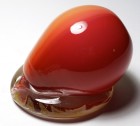 |
| 2270 | German or Bohemian Souvenir Paperweight
with Ruby Stain Engraved Scene of Münster in Freiburg.
circa 1840-1910. This is a large footed
paperweight with an engraved image of the cathedral of Freiburg im
Breisgau in southwest Germany. There are initials after the
title which I assume are those of the engraver. The engraving is
done from the bottom which has a ruby stain. The paperweight
has a footed or pedestal base. The techniques used in this type of paperweight are attributed to the pioneering work with colored stains (sometimes incorrectly called flash overlays) by Friedrich Egermann (1774-1864) in North Bohemia. Egermann discovered methods of applying metallic salts to glass to produce a colored stain. Silver salts would produce a yellow stain, copper salts would produce a ruby stain, etc. The application of this colored layer enabled many Bohemian (and also European) glass factories to engrave a variety of images as souvenirs of the prominent buildings and spas throughout Europe. The style became known as spa paperweights. Although the technique was enabled by Egermann's discoveries, it is not possible to attribute this paperweight to a specific factory, engraver, or country. There is an excellent article this subject with many examples in the 2016 Annual Bulletin of the Paperweight Collectors Association "19th Century Engraved Bohemian Paperweights: Spas and Other Local Views" by Jim and Nancy Barton. Bohemian Glass generally refers to the glass made in the regions that form the border area between the Czech Republic, Poland, and Germany. Most of these areas are now parts of the western Czech Republic. Size: 3 7/8" diameter by approximately 1 3/8" high.
The foot has a diameter of 3 1/2". For extra pictures, click on the picture at the right and the following links: Large picture$135 postage paid in the US. Added 8/27/2021 For more information about Bohemian paperweights, see my Bohemian
Paperweights
Web Page
.
(dl-boh-ant) |
Click
on the picture to see a larger image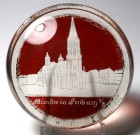 |
| 2528 | Antique Belgian or Bohemian Doorknob with
Miniature Concentric Millefiori Paperweight Handle. circa
1880-1910. This is a wonderful antique doorknob with a
concentric millefiori paperweight handle. The handle has
bright colors on a clear ground. It has two concentric circles
of canes around a complex center cane. The outer ring
alternates between larger complex blue and white canes and simpler
red and white canes. One red cane is missing. The inner
ring consists of six large identical white, pink, and yellow complex
canes. There is a complex green, pink, and yellow center
cane. The maker of this paperweight is unknown. It has
similarities to a group of paperweights believed to have originated
at an unidentified glass factory in Belgium, Northern Europe, or
even Bohemia. The hardware portion is in good condition with a
fixed spindle. The design is well centered and a wonder to
study. This paperweight has a strong similarity to a group of paperweights and doorknobs that are believed to have originated at an unidentified glass factory in Belgium or Northern Europe. Bohemian Glass generally refers to the glass made in the regions that form the border area between the Czech Republic, Poland, and Germany. Most of these areas are now parts of the western Czech Republic. Size: The knob is 1 13/16" diameter by 2 3/16" long
including the brass hardware, but not the spindle. With the
spindle, it is 4 13/16" long. For extra pictures, click on the picture at the right and the following links: Large pictureSOLD. Added 8/26/2021 For more information about Bohemian paperweights, see my Bohemian
Paperweights
Web Page
.
(dl-boh-ant) |
Click
on the picture to see a larger image |
| 1472 | Unusual Miniature Chinese Mosaic
Millefiori Paperweight with Rose Cane. circa
1950-70. Unusual Chinese millefiori with mosaic canes.
There are red and yellow star canes surrounded by leaf canes and a
single rose cane. I have no idea what the pattern is supposed
to represent. Very little is known about this style.
Other examples have a butterfly pattern and some have Chinese
writing in the design. The style is believed to be from
1950-1970.
Chinese Paperweights were made in the late 1920s and throughout the 1930s as an attempt to duplicate 19th Century antique weights made in the United States and France. Because they are almost 100 years old, they are very collectible and every collector should own a few of these as study pieces. The history of the early Chinese paperweights is mostly anecdotal as no written records have been discovered. The story is that an American dealer sent examples of paperweights made by the New England Glass Company (NEGC), Boston & Sandwich Glass Company (B&S), Millville makers, and French factories to a Chinese factory and requested copies be made. The results are interesting and sometimes confused with the originals by inexperienced collectors. The earliest pictures of these paperweights appeared in the book American Glass Paperweights by Francis Edgar Smith published in 1939. Smith was aware that at least one of the paperweights shown in his book was Chinese. Since Smith was not an expert collector, this indicates that there was some general knowledge that these were Chinese prior to 1939. In the United States, the Tariff Act of 1930 required that every imported item must be conspicuously and indelibly marked in English with its country of origin. As a result, many of these Chinese paperweights are scratch signed on the bottom "CHINA". Many are also not signed, suggesting that either they were imported prior to 1930 or the importer ignored the requirement. Most likely the earliest Chinese paperweights were made prior to 1930. The Chinese makers often combined design features found in paperweights from different makers. For example they copied the latticinio grounds used by New England Glass Company and used them with copies of Baccarat Pansy weights. The original Baccarat pansy paperweights never had a latticinio ground. They copied the pedestal rose from Millville and then used the pedestal bottom with other weights. It is fun to collect all the variations. In general, Chinese paperweights from the earliest period (1930-1950) have a light weight glass mixture that is high in soda and has a greenish tinge. The glass also has a soft almost oily feel. Frequently they have bubbles or debris in the glass. And because of their age, many of these have minor scratches or other surface defects. This paperweight has a slightly better glass, but it is not crystal clear like modern paperweights. Miniature Size: 1 13/16" diameter by 1 1/2"
high. The bottom is ground flat. For extra pictures, click on the picture at the right and the following links: Large picture$39 postage paid in the US. Added 8/17/2021 For more information about paperweights from China, see my Chinese Paperweights Web Page. Click on the picture to see a larger image. |
Click
on the picture to see a larger image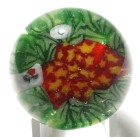 |
| 4850 | Magnum Baccarat 1975 Gridel Series
Pheasant Concentric Millefiori Limited Edition
Paperweight. dated 1975. This modern three
ring concentric millefiori paperweight features a large white
pheasant silhouette on a black background in the center. This
large center cane is surrounded by a circle of yellow millefiori
canes. The middle ring of canes has seventeen small Gridel
canes plus a Baccarat "B 1975" signature / date cane. The
pheasant Gridel appears only in the center, not in the middle
ring. The design is set on a transparent blue ground. In
addition to the Baccarat signature / date cane, this paperweight has
an acid etched Baccarat mark on the base along with the engraved
year (1975) and engraved edition number (46). This is a nice
balanced design. A beautiful addition to any collection of
Baccarat paperweights. This design was released in 1975 in a limited edition of 350 pieces. This is number 46 in that series. There is a signature / date cane "B 1975" shown in the pictures. The base has an acid etched Baccarat logo plus it is engraved with the year (1975) and the edition number (46). In 1846 Baccarat introduced the popular Gridel figures in their closepack millefiori paperweights. It was named after Emil Gridel, the nephew of Jean-Baptiste Toussaint the general manager of Baccarat. Toussaint saw Gridel making paper cutouts of animals and saw an opportunity to incorporate these silhouettes in millefiori paperweights. From 1971 to 1979 Baccarat issued a modern Gridel series of millefiori paperweights based on eighteen Gridel figures. Each paperweight has a large Gridel figure in the center with smaller versions of the other figures included in the design. There are variations in orientation and color as well as the types of canes in each design and it is possible to amass a very large collection covering just this series. Baccarat was founded in 1776 in Alsace-Lorraine with the name of Verrerie de Sainte Anne. The original location was near the town of Baccarat. Today the firm is known as Compagnie des Cristalleries de Baccarat. Most collectors refer to three periods of Baccarat paperweight production.
In 1952, Paul Jokelson approached Baccarat with the idea of making sulphide paperweights again. In 1953 Baccarat resumed paperweight production with a series of sulphide paperweights the first of which were the unsuccessful Eisenhower sulphide followed by the Queen Elizabeth coronation sulphide. Millefiori paperweight production was resumed in 1957 and lampwork paperweights were re-introduced in the early 1970s. Baccarat stopped making this type of fine glass paperweights in 2002. You can read more about the Baccarat paperweights in the new book Baccarat Paperweights - two centuries of beauty by Paul Dunlop or one of the older books on paperweights in general, such as The Encyclopedia of Glass Paperweights by Paul Hollister or World Paperweights by Robert Hall. Very large size: 3 3/16" diameter by 2 3/8"
high. The base is ground flat. For extra pictures, click on the picture at the right and the following links: Large picture$375 postage paid in the US. Added 8/14/2021 For more information about Baccarat paperweights, see my Baccarat Paperweights Web Page Click on the picture to see a larger image. |
Click
on the picture to see a larger image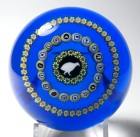 |
| 5017 | Late Ysart Brothers or Early Vasart
Paneled Millefiori Paperweight - Many Annealing Cracks.
circa 1952-1956. This colorful paperweight consists of a
paneled millefiori pattern with eight sections with 1 green +2 brown
millefiori canes each separated by a red and blue twist cane.
There is a central cluster of two rings of canes, 15 blue and 5
orange canes, around a central cross cane. The design is set
on a clear ground. The glass is slightly
gray. Unfortunately this paperweight is filled with many
internal annealing fractures / cracks. See the note below for
more information on the cause. An interesting historical
addition to any collection of Scottish paperweights. Note on annealing fractures / cracks: According to David Moir, who was an apprentice at the Ysart Brothers Shore Road works in 1954, the glass works had a lot of annealing problems at the Shore Road factory because it was fired with poor quality coke. It was difficult to maintain a level annealing temperature and sometimes would get too hot or too cold. Temperature was judged by putting your arm inside the oven to feel the heat. The problem was solved when George Dunlop (owner of Pirelli Glass in London) brought in fresh capital, equipment, and orders. This included an electrically controlled second-hand kiln from Rolls Royce which was a vast improvement on the old one and had electric temperature gauges. The birth of Scottish paperweight making is credited to the glass making family of Salvador Ysart, who moved to Crieff, Scotland in 1922. They worked first at John Moncrieff Ltd and made the earliest Scottish paperweights during that period. Paul Ysart (1904-1991), originally Pablo Moreno Isart, was apprenticed to his father as a glass worker at Moncrieff in 1922. In 1946 Salvadore and his sons Augustine and Vincent founded Ysart Brothers Glass and produced glass wares under the Vasart label. Salvador Ysart died in 1955. Shortly later, George Dunlop, the owner of Pirelli Glass in London, brought in fresh capital, equipment, and orders. Vincent Ysart and George Dunlop formed a new company in 1956, Vasart Glass Ltd. Strathearn Glass was formed in a reorganization of Vasart glass in 1963. The new company was owned by Teachers Whiskey. The factory was taken over by Stuart Glass in 1980, and renamed Stuart Strathearn Ltd. Production ceased in 1992. Size: Just under 3" diameter by 1 15/16"
high. The base is fire finished. For extra pictures, click on the picture at the right and the following links: Large picture$95 postage paid in the US. Added 7/14/2021 For more information about paperweights made by Scottish makers, see my Scottish Paperweights Web Page Click on the picture to see a larger image. |
Click
on the picture to see a larger image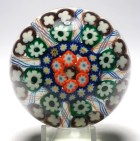 |
| 4747 | Antique Paperweight Style Mystery
Object - Probably a Cut Down Candle Holder. circa
1900. I don't know for sure what this was originally. It
is safe to assume the shape has been altered because it has no
apparent use in its current form except as paperweight. It has
a cup at one end and the other end is faceted with a flat
base. The middle section has a paperweight form with ice pick
flowers and small bubbles. The faceted end has a five sided
shape in the center with five sloping cuts away from that. I'm
certain it is an antique and that the cup end has not been
modified. The way the bubbles in the faceted end are towards
the center suggests that the cup was originally the up side.
I've discussed this with other collectors and our best guess is that
this was originally a candle holder for a fairly large candle which
would fit the cup. It is also likely that the original shape
was supported by a five sided stem and larger base to provide
stability. If you look at pictures of older style candle
holders or candlesticks you can find some with a round cup and
faceted stem. An interesting object - too good to throw in the
trash. I'm not asking much for it. Note: Although this object can be used in its current form as a candle holder, but caution you not to use it with a lighted candle. It doesn't have the large base that would normally provide the necessary stability. Size: In its current form, it is 3" long, the cup
has a diameter of 2". The inner diameter of the cup is just
over 1 1/2". The base is flat in the center. The
original shape is unknown. For extra pictures, click on the picture at the right and the following links: Large picture$65 postage paid in the US. Added 7/10/2021 For more information about antique paperweights see my Antique Paperweights Web Page. Click on the picture to see a larger image. |
Click
on the picture to see a larger image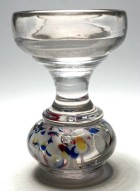 |
| 5278 | Very Early Francis Whittemore Miniature
Paperweight with White and Blue Millefiori Flowers on a Pink
Ground. circa 1962 - 1969. This very early
paperweight by Francis Whittemore features five small white
millefiori flowers with blue star centers. There is also a
stem and two green leaves. The design is placed on a powdery
pink ground. This paperweight is signed in the design with an
early Whittemore signature cane, a black "W" on a yellow
background. This is an important early example of
Francis Whittemore's work and worthy of any collection of Whittemore
paperweights. Note: This paperweight is almost the same as the examples offered in Larry Selman's first two editions of "CATALOGUE OF COLLECTORS' PAPERWEIGHTS". See the 1970 Catalog (robins egg blue cover) or the 1971 Catalog (olive green cover). Francis Dyer Whittemore, Jr. is considered one of the pioneers of the modern paperweight renaissance. He started working in glass in 1938, but did not start making paperweights until 1962. His studio was in Lansdale, Pennsylvania. Like many other early glass artists, Francis started his career as a scientific glass blower and then later taught glass as an instructor. For five years, he spent one month a year consulting at Baccarat to help them refine their lampwork paperweight art. Some sources have this consulting work from 1971 to 1976. Other sources have it starting later. The signature cane used on this paperweight was one he developed prior to working at Baccarat. Most of his paperweights are miniature to medium in size. You can read about Francis Whittemore in the book American Glass Paperweights and Their Makers by Jean Melvin (1970). Size: 2 3/8" diameter by 1 1/8" high. This paperweight has a very low profile. The base is flat with a concave center.Signature: Signed in the design with an early Whittemore signature cane. The cane has a black "W" on a yellow background. Condition: Excellent condition. No chips, cracks, or scratches found on inspection. There are many bubbles in the ground and a few striations in the glass. For extra pictures, click on the picture at the right and the following links: Large picture$165 postage paid in the US. Added 7/10/2021 For more paperweights by contemporary American paperweight
makers, see my Contemporary
American Paperweights Web Page. (dl-ca-va) |
Click
on the picture to see a larger image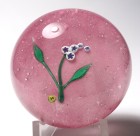 |
| 1377 | Baccarat 1988 Four Row Open Concentric
Millefiori Paperweight. dated 1988. This
paperweight has an open concentric design with four rows of colorful
millefiori around a central millefiori cane. The design is
placed over a clear ground. It is signed with an etched
Baccarat logo on the base. It also has a Baccarat "B1988"
signature / date cane in the outermost row. A fantastic
example of a modern open concentric from Baccarat. Baccarat was founded in 1776 in Alsace-Lorraine with the name of Verrerie de Sainte Anne. The original location was near the town of Baccarat. Today the firm is known as Compagnie des Cristalleries de Baccarat. Most collectors refer to three periods of Baccarat paperweight production.
Baccarat started making modern millefiori paperweights in 1957. According to Paul Dunlop ( Baccarat Paperweights: Two Centuries of Beauty ), Baccarat started making the modern spaced millefiori paperweights on muslin or lace in 1958 and continued making undated examples until the limited editions were started in 1970. The exception is 1964 when special versions were produced for Baccarat's 200th anniversary. Size: 2 11/16” diameter by 2 1/16” high. The
base is polished flat. For extra pictures, click on the picture at the right and the following links: Large picture$285 postage paid in the US. Added 6/19/2021 For more information about Baccarat paperweights, see my Baccarat Paperweights Web Page. Click on the picture to see a larger image. |
Click
on the picture to see a larger image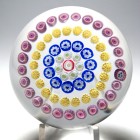 |
| 5250 | Perthshire Annual Collection 1975E
Limited Edition Green Overlay Millefiori Paperweight Bottle with
Original Box. This is a tall bottle with a green flash
overlay and a three ring concentric millefiori pattern base.
The concentric millefiori pattern consists of all complex millefiori
canes. There is a center complex cane that matches the single
millefiori cane in the stopper. The bottle has 24 side facets
arranged in three rows. The stopper has a matching green flash
overlay with eight side facets arranged in two rows. The
stopper has a single complex millefiori cane which matches the
center cane in the base. This bottle is signed with a
Perthshire "P1975" signature / date cane in the base. It also
has a Perthshire paper label "PERTHSHIRE PAPERWEIGHTS CRIEFF
SCOTLAND" on the base and comes with its original fitted satin lined
box. This design was made with a green or blue overlay and
offered in a limited edition of 350 bottles of which 347 were
made. I do not have the original certificate. This is a
great addition to any collection of paperweight related items. Perthshire made this paperweight bottle as one of their Annual Collection designs for 1975. This means the design was made only that one year and never again. There were five Annual Collection designs in 1975, designated A through E. This design is designated 1975E. The annual collection paperweights are the most desirable of the Perthshire line, with the exception of one of one items. Perthshire was a small company in Crieff, Scotland that was devoted to the creation of quality glass paperweights. They stopped production in January 2002 after more than 30 years of production. Their paperweights were consistently high in quality and yet remained reasonable in price. There are three books on Perthshire Paperweights. If you collect Perthshire paperweights, you should have them in your library. The birth of Scottish paperweight making is credited to the glass making family of Salvador Ysart, who moved to Crieff, Scotland in 1922. They worked first at John Moncrieff Ltd and made the earliest Scottish paperweights during that period. In 1946 Salvadore and his sons Augustine and Vincent founded Ysart Brothers Glass and produced glass wares under the Vasart label. Salvador Ysart died in 1955 The company name was later changed to Vasart Glass. Stuart Drysdale was hired manage the business side of the enterprise in 1960. The company evolved into a new company Strathearn owned by Teachers Whiskey. In 1967 Drysdale was sent a magazine article on antique paperweights (Woman's Day, July 1965). The inspired him to try to produce weights comparable to the French antiques. With this goal in mind, he and several of the glass workers left Strathearn to found Perthshire in 1968. Large size: Just under 3 1/8" diameter by just under
7 1/2" high with the stopper. The bottle is 5 3/4" tall
without the stopper. The stopper is 1 9/16" diameter by 2
5/8" long. The base is ground concave in the center.
The bottle has 24 side facets and the stopper has eight side
facets. The box is 8" long by just under 5 1/2" wide by 3
7/8" tall. For extra pictures, click on the picture at the right and the following links: Large picture$395 postage paid in the US. Added 6/15/2021 For more information about Perthshire Paperweights, see my Perthshire Web Page. Click on the picture to see a larger image. |
Click
on the picture to see a larger image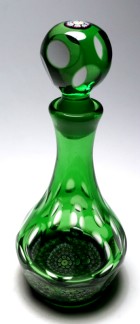 |
| 345 | Colorful Surface Decorated Hollow
Paperweight - Unknown Maker. This surface
decorated paperweight is hollow blown rather than solid. The
colorful decorations are tactile and can be felt on the
surface. There is a hole in the base left over from the
blowing process. Signed KO on the base but the maker is
unknown. A fun paperweight. The maker of this paperweight is unknown. Size: Just over 2 7/8" diameter by just over 2"
high. The base has been polished concave. The surface
is a little irregular There is a hole in the base left from the
blowing process. For extra pictures, click on the picture at the right and the following links: Large picture$44 postage paid in the US. Added 6/13/2021 For more information about paperweights by unknown makers, see my Unknown Makers Paperweights Web Page . Click on the picture to see a larger image. |
Click
on the picture to see a larger image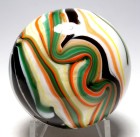 |
| 778 | Miniature Art Glass Carpet Ground
Millefiori Paperweight - Unknown Maker. This art
glass miniature millefiori paperweight consists of identical red,
white, and pink cogged millefiori, although it looks like there may
be some filler pieces added to complete the carpet. The maker
is unknown. The maker of this paperweight is unknown. Very small size: 2" diameter by 1 1/4" high.
The base has been polished flat. For extra pictures, click on the picture at the right and the following links: Large picture$59 postage paid in the US. Added 6/12/2021 For more information about paperweights by unknown makers, see my Unknown Makers Paperweights Web Page . Click on the picture to see a larger image. |
Click
on the picture to see a larger image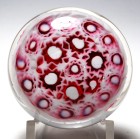 |
| 3437 | Large Colorful Strathearn Paneled
Millefiori Paperweight. circa 1963-1968. This very
attractive paperweight consists of a paneled millefiori pattern with
nine panels of 1 (white) + 2 (yellow) + 2 (pink) millefiori patterns
each separated by a white latticinio twist cane. There is a
central ring of seven dark green millefiori canes and then a
center orange millefiori cane. The canes are early Scottish
millefiori canes on a translucent blue ground. This is a great
addition to any collection of Scottish paperweights. Great
color. The birth of Scottish paperweight making is credited to the glass making family of Salvador Ysart, who moved to Crieff, Scotland in 1922. They worked first at John Moncrieff Ltd and made the earliest Scottish paperweights during that period. In 1946 Salvadore and his sons Augustine and Vincent founded Ysart Brothers Glass and produced glass wares under the Vasart label. Salvador Ysart died in 1955 The company name was later changed to Vasart Glass. Strathearn Glass was formed in a reorganization of Vasart glass in 1963. The new company was owned by Teachers Whiskey. The company is no longer in existence. Size: 3 1/16” diameter by 2 5/16” high.
The base is fire polished. For extra pictures, click on the picture at the right and the following links: Large picture$125 postage paid in the US. Added 5/29/2021 For more information about paperweights made by Scottish makers, see my Scottish Paperweights Web Page Click on the picture to see a larger image. |
Click
on the picture to see a larger image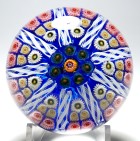 |
| 2850 | Unsigned Miniature Lampwork Flower
Paperweight, possibly by Ronald Hansen.
undated. This miniature paperweight features a six petal
lampwork flower with leaves and stem. The petals are yellow
with orange stripes. There are five variegated sepals and plus
two leaves and a stem. It has a low profile. Nicely
executed, it has an unusual amber ground placed over a white button
base (see picture of the base). Definitely the work of a
talented artist. Possibly by Ronald Hansen. Note: The maker of paperweight is unknown, but it is possibly by Ronald Hansen who made paperweights from the late 1950s to 1971. Ronald E. Hansen was born in Virginia, Minnesota in 1910. He was first exposed to glass lampwork as a child when he was befriended by Bohemian glassworkers in a "hobo village" making glass ships. He later worked as the director of the Neon Tube School in Detroit, Michigan. With this exposure, he was aware of the artistic and technical aspects of glassworking. He established his own studio in Mackinaw City, Michigan, mixed his own colors and glass, and created a variety of small glass paperweights, most of which are 2 1/2" or less in diameter. He made paperweights from the late 1950s to 1971. He was one of a number of glass artists in this paperweight making family. His nephew, Eric Hansen, continues the art today. You can read more about Ronald E. Hansen in the book American Glass Paperweights and their makers by Jean Melvin (1970 Revised edition) or the article by Nancy Alfano in the 2004 PCA Bulletin. Very small size: Low profile, 1 15/16" diameter by just over 1" high. The base is ground flat with a frosted finish.Signature: Unsigned. I believe this paperweight was made by Ronald Hansen, but have been unable to confirm this ID. Condition: Very good condition with a few faint scratches or scuffed areas. For extra pictures, click on the picture at the right and the following links: Large picture$85 postage paid in the US. Added 5/17/2021 For more vintage American paperweights, see my Vintage American Paperweights Web Page. Click on the picture to see a larger image. |
Click
on the picture to see a larger image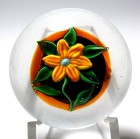 |
| 4382 | Robert Banford Blue Double Clematis
with Buds Double Overlay Faceted Paperweight with Fancy Base
Cutting. circa 1987. This paperweight
features a wonderful dark blue double clematis with a yellow center
and two companion buds, one open and the other still closed.
It is has many green leaves and a stem. The design is set on a
clear ground and encased with a brilliant red and white double
overlay. It is faceted with a large top facet and six side
facets. In addition there is a fancy cutting on the lower
portion below the facets. The paperweight is signed with Bob
Banfords “B” signature cane at the tip of the stem. I believe
this is part of Bob Banford's 1987 Collection and the cutting is by
Ed Poore. A very desirable addition to any collection of
contemporary American paperweights.
Note on condition: There is a 1/8" nick or tool mark just above the fancy cutting. It is barely visible, but I mention this for completeness and provide a much magnified picture. No other flaws found on inspection. Robert Banford worked in Hammonton, NJ. He started making paperweights in 1971 along with his father, Ray Banford. Bob continued to make paperweights until 2006. Bob and Ray did not date their paperweights, but it is sometimes possible to get an idea of when a paperweight was made by the progression of styles and the type of glass used. Bob Banford used a signature cane with a red "B" and a blue surround. Ray Banford used a different signature cane with a black B. Ray passed away in 2003.
Size: 2 15/16" diameter by just over 2 1/8"
high. The bottom is ground slightly concave. It is
faceted with a large top facet and six side facets. In
addition there is a fancy cutting on the lower portion below the
facets. For extra pictures, click on the picture at the right and the following links: Large picture$950 postage paid in the US. US Sales only, no international shipping. Delivery will require a signature. Added 5/13/2021 For more paperweights by contemporary American paperweight makers, see my Contemporary American Paperweights Web Page. Click on the picture to see a larger image. |
Click
on the picture to see a larger image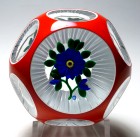 |
| 3794 | Colorful Magnum Rollin Karg Three Sided
Paperweight. circa 1983 to 2000. This is an
interesting three sided sculptural paperweight with inner
folds. Primarily blue, most of the surface has colored spots
of pinks, reds, and browns. One side has an area that is
dichroic. It is signed "KARG" on the side near the base. Extra
large. A fun paperweight.
Rollin Karg spent the first part of his career as an industrial engineer, photographer, potter and woodworker before becoming a full time glass artist in 1983. He studied hot glass at Emporia State University (Kansas) and built his first glassblowing furnace there. Today he owns a studio and gallery in Kechi, Kansas. Very large size: Three sided shape. 3 1/2" at
the widest by 2 13/16" tall. The base is ground flat.
For extra pictures, click on the picture at the right and the following links: Large picture$79 postage paid in the US. Added 4/21/2021 For more paperweights by contemporary American paperweight makers, see my Contemporary American Paperweights Web Page. Click on the picture to see a larger image. |
Click
on the picture to see a larger image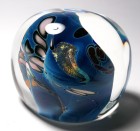 |
| 4040 | Large Strathearn Eight Pointed Star
Paneled Millefiori Paperweight with Opaque Orange Ground.
circa 1963-1968. This paperweight is finished as a eight
pointed star. The star points give the glass a glittery
appearance. It features a paneled millefiori design with seven
panels of 1+1+2 millefiori patterns each separated by a white
latticinio twist cane. There is a central ring of six
millefiori canes and then a center millefiori cane. The canes
are early Scottish millefiori canes on an opaque orange
ground. A great addition to any collection of Scottish
glass. This is called a pressed weight because a mold is used to form the shape. The top is flattened. The star points give the glass a real glittery appearance as you can see in the pictures. The birth of Scottish paperweight making is credited to the glass making family of Salvador Ysart, who moved to Crieff, Scotland in 1922. They worked first at John Moncrieff Ltd and made the earliest Scottish paperweights during that period. In 1946 Salvadore and his sons Augustine and Vincent founded Ysart Brothers Glass and produced glass wares under the Vasart label. Salvador Ysart died in 1955 The company name was later changed to Vasart Glass. Strathearn Glass was formed in a reorganization of Vasart glass in 1963. The new company was owned by Teachers Whiskey. Size: 2 3/4” diameter by 1 3/16” high.
The base is fire polished. For extra pictures, click on the picture at the right and the following links: Large picture$85 postage paid in the US. Added 4/19/2021 For more information about paperweights made by Scottish makers, see my Scottish Paperweights Web Page Click on the picture to see a larger image. |
Click
on the picture to see a larger image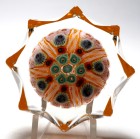 |
| 4022 | Large Blue Iridescent Abstract Paperweight
with Gecko Pontil Stamp by Unknown Maker. dated
1999. This is a large mystery abstract iridescent blue
paperweight made by an unknown maker. The signature is legible
with the date 99 but I have not been able to identify the
maker. The pontil stamp is a long tailed lizard or gecko or
something similar. Not much I can say about the design - it is
a blue abstract blob. A mystery for future study. The maker of this paperweight is unknown. Large Size: 2 7/8" diameter by 2 13/16" high.
The base is fire finished with a pontil stamp. For extra pictures, click on the picture at the right and the following links: Large picture$49 postage paid in the US. Added 4/14/2021 For more information about paperweights by unknown makers, see my Unknown Makers Paperweights Web Page . Click on the picture to see a larger image. |
Click
on the picture to see a larger image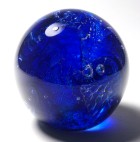 |
| 4032 | Colorful Guernsey Island Studio
Paperweight with Silverplate Base by Sileda Ltd. dated
1986. This colorful glass paperweight was most likely
made by the Guernsey Island Studio (also known as Guernsey
Glass). The Sheffield silverplate base was added by Sileda
Ltd. (Wales) and has the silver marks indicating Sileda was the
maker of the base and it was made in 1986. There are several
discussions on the Internet about this type of paperweight and I was
able garner the basic facts about the makers and the date (see
below). The silver plate has been lost some of its silver
layer and the underlying copper is visible. There is a felt
cover in the center base. I did not remove the felt to see if
there was a Guernsey mark on the glass. This is an odd item,
but it will make a good conversation piece. Guernsey Island Studio (also known as Guernsey Glass) was located at the Oatlands Craft Centre, St Sampson, Guernsey, Channel Islands. It was founded about 1980 with advice and assistance from Michael Harris of the Isle of Wight Studio Glass. They made small souvenir pieces, such as vases, animal figures, and paperweights and often marked them on the base with the trademark Guernsey mark, which was three lions passant on a shield. They closed sometime in the 1990s. Sileda Ltd was founded in Cefn-y-bedd Wales UK about 1980. They were a small silver company that registered their punches at the Sheffield Assay Office from 1980 to 2000. The makers mark is "SL" with a small indent between the two letters. In addition to any other silver work they may have done, they were known for sourcing (purchasing) glass objects such as paperweights and vases from UK glass studios and adding silver enhancements or decorations to the glass objects. For paperweights, the enhancement was a silverplate base, for vases it was often a silver collar. In many cases, collectors could identify the original source of the glass object. Size: 2 3/4" diameter by 1 15/16" high. The
base is covered with a silverplate covering and a felt cover in
the center. I did not remove the felt to see if the Guernsey
mark is under the felt. For extra pictures, click on the picture at the right and the following links: Large picture$65 postage paid in the US. Added 4/3/2021 For more information about paperweights by English makers, see my English Paperweights Web Page . Click on the picture to see a larger image. |
Click
on the picture to see a larger image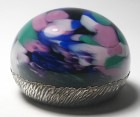 |
| 4034 | Medium Colorful Strathearn Close Packed
Millefiori Paperweight. circa 1963-1968. This is a
very attractive and colorful Strathearn close packed millefiori
paperweight. The design is placed over an opaque pink- beige
ground. A nice addition to any collection of Scottish
paperweights. The birth of Scottish paperweight making is credited to the glass making family of Salvador Ysart, who moved to Crieff, Scotland in 1922. They worked first at John Moncrieff Ltd and made the earliest Scottish paperweights during that period. In 1946 Salvadore and his sons Augustine and Vincent founded Ysart Brothers Glass and produced glass wares under the Vasart label. Salvador Ysart died in 1955 The company name was later changed to Vasart Glass. Strathearn Glass was formed in a reorganization of Vasart glass in 1963. The new company was owned by Teachers Whiskey. The company is no longer in existence. Medium size: Just over 2 3/8” diameter by 2
1/16” high. The base is fire polished and ground concave in
the center. For extra pictures, click on the picture at the right and the following links: Large picture$89 postage paid in the US. Added 3/27/2021 For more information about paperweights made by Scottish makers, see my Scottish Paperweights Web Page Click on the picture to see a larger image. |
Click
on the picture to see a larger image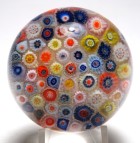 |
| 4031 | Large Maude and Bob 1976 Blue Icepick
Flower Candle Holder Paperweight. dated
1976. This large candle holder paperweight features five light
blue icepick flowers over an dark blue ground. As is typical
of the St. Clair style, there is a carefully placed bubble in the
center of each flower and also a carefully placed bubble in the
ground in between each flower. There is a ribbed handle on one
side. It is hot stamped on the base "MAUDE AND BOB ST CLAIR
1976". Maude and Bob St. Clair produced paperweights under
their own label for less than fifteen years. A great addition
to any collection of St. Clair items. This style of flower is called an ice-pick flower because of the icepick like tool used to push each flower down to the ground to form a stem. Note: In the pictures, the handle shows a yellow color. This is a reflection from something in my work area. The handle of the candle holder is clear colorless glass. The St. Clair line (as far as paperweights are concerned) started with John "Pop" St. Clair, Sr. who worked at the George MacBeth Glass Works in Elwood from around 1903 to 1938. Local natural gas production faltered in 1938 and the St. Clairs began to develop their ideas for a new business of their own. Joe St. Clair (1909 - 1987) did the original experimentation and the business was formally started in 1941 in Elwood, Indiana. John, Sr. and the brothers John, Jr., Joe, Ed and Bob all participated, while another brother, Paul, did not at first. By 1944 St. Clair paperweights were being sold through Georg Jensen on Fifth Avenue in New York. Joe retired (the first time) in 1971 and sold the factory to new owners in Elwood, Indiana. About the same time, Bob St. Clair and his wife Maude opened a new factory in Elwood. Paul St. Clair retired from General Motors and joined Bob, along with Ed St. Clair and a nephew, Joe Rice. Sometime later after Bob opened his factory, the new owners of the original factory sold the factory back to Joe. So, for a while, there were two St. Clair Glass factories. Bob St. Clair died in 1986. Joe St. Clair died in 1987. Ed St. Clair died in 1989 and the last brother, Paul St. Clair died in 2000. Robert (Bob) St. Clair was born May 18, 1919 and passed away in 1986. He is known to have used two signatures from 1971 to 1986. Most of the time he included his wife and used the stamp "MAUDE AND BOB ST. CLAIR", often with a date with raised lettering. Less frequently, he used the stamp "BOB ST. CLAIR" with no date. This stamp, with only BOB, can be found with either raised or indented lettering.
Size: The center paperweight portion is just under
3" diameter. With the handle and the cup for the candle it
is 4 1/16" wide by just under 3" deep by 3 1/16" high. The
base is finished flat and hot stamped in the center with the
signature. For extra pictures, click on the picture at the right and the following links: Large picture$85 postage paid in the US. Added 3/26/2021 For more information about paperweights made by the St. Clair factory, see my St. Clair Paperweights Web Page Click on the picture to see a larger image. |
Click
on the picture to see a larger image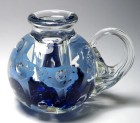 |
| 4746 | Chris Sherwin Art Glass Black-Capped
Chickadee Paperweight. dated 2017. This
black-capped chickadee paperweight is a wonderful example of Chris
Sherwin's recent work. The figural paperweight was created for
a meeting of the Founders Chapter of the National American Glass
Club. It is signed on the base "Sherwin Art Glass 2017". The black-capped chickadee is the state bird of Massachusetts and of Maine in the United States, and the provincial bird of New Brunswick in Canada. Chris Sherwin has worked in glass for 25 years, specializing in designs inspired by nature. Almost all of his work involves some aspect of torchwork decoration applied to the surface or encased torchwork creations. He makes his own glass and canes in his environmentally conscious hydro-powered studio. Chris studied glassblowing at Southern Connecticut State University and apprenticed at Simon Pearce. He also spent seven years at Orient & Flume Art Glass, an internationally renowned glass studio in Chico, CA known for their iridescent vases, intricate paperweights, and torchwork designs. At O&F he was able to create designs of his own and collaborative pieces that earned him a separate section in the O&F retail showroom. He opened his own studio in Bellows Falls, VT in 2005 and makes a variety of paperweights, vessels, animal sculptures, seasonal themed and other objects. Size: 3 7/8" long by 1 7/8" wide by just under 3
1/16" high. The base is ground flat. For extra pictures, click on the picture at the right and the following links: Large pictureSOLD. Added 3/24/2021 For more paperweights by contemporary American paperweight makers, see my Contemporary American Paperweights Web Page. Click on the picture to see a larger image. |
Click
on the picture to see a larger image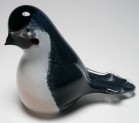 |
| 1851 | Rare Large Vasart or Strathearn Paneled
Millefiori Paperweight Pin Dish. circa 1946-1969.
This pin dish features a paneled millefiori design with seven panels
with a 1-2 cane pattern separated by colored twists over an orange
ground. There is a ring of pink canes with blue centers in the
center of the design. The dish is heavy with thick walls and a
depressed center. An interesting historical addition to any
collection of Scottish paperweights, Ysart glass or millefiori
collectibles.
Items like this were made by the many of the Scottish paperweight companies (Ysart Brothers, Vasart Glass, Strathearn Glass, or even Perthshire Paperweights). Some of the products made by Vasart were also sold with a Pirelli label. It is important to note that most pin dishes started off as a paperweight. The maker found a defect or problem and rather than stop, turned it into a pin dish. The birth of Scottish paperweight making is credited to the glass making family of Salvador Ysart, who moved to Crieff, Scotland in 1922. They worked first at John Moncrieff Ltd and made the earliest Scottish paperweights during that period. In 1946 Salvadore and his sons Augustine and Vincent founded Ysart Brothers Glass and produced glass wares under the Vasart label. Salvador Ysart died in 1955 The company name was later changed to Vasart Glass. Strathearn Glass was formed in a reorganization of Vasart glass in 1963. The new company was owned by Teachers Whiskey. Large Size: 3 7/8” diameter by 1 5/8” high.
The center well is 2 13/16" diameter. The base is fire
polished and the pontil mark is ground down. For extra pictures, click on the picture at the right and the following links: Large picture$125 postage paid in the US. Added 3/20/2021 For more information about paperweights made by Scottish makers, see my Scottish Paperweights Web Page Click on the picture to see a larger image. |
Click
on the picture to see a larger image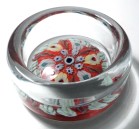 |
| 5185 |
Large Joe St. Clair Icepick Flower Teapot Ring Holder Paperweight. circa 1960 - 1980. This teapot shaped figural paperweight is intended for use as a ring holder and is a very popular design. It has five light blue icepick flowers over a white chipped glass ground. As is typical of this style, there is a carefully placed bubble in the center of each flower and also a carefully placed bubble in the ground in between each pair of flowers. It is hot stamped "JOE ST CLAIR" on the bottom. A very flashy figural paperweight. This style of flower is called an icepick flower because of the ice-pick like tool used to push each flower down to the ground to form a stem.
The St. Clair line (as far as paperweights are concerned) started with John "Pop" St. Clair, Sr. who worked at the George MacBeth Glass Works in Elwood from around 1903 to 1938. Local natural gas production faltered in 1938 and the St. Clairs began to develop their ideas for a new business of their own. Joe St. Clair (1909 - 1987) did the original experimentation and the business was formally started in 1941 in Elwood, Indiana. John, Sr. and the brothers John, Jr., Joe, Ed and Bob all participated, while another brother, Paul, did not at first. By 1944 St. Clair paperweights were being sold through the Georg Jensen Shop on Fifth Avenue in New York. Joe retired (the first time) in 1971 and sold the factory to new owners in Elwood, Indiana. Sometime later, the new owners of the original factory sold the factory back to Joe. For a while, there were two St. Clair factories, one owned by Joe and the other owned by Bob St. Clair. Size: 4 7/8" wide by 4" high. The center
paperweight portion is 2 1/2" in diameter. The bottom is finished
flat and hot stamped in the center with the signature. For extra pictures, click on the picture at the right and the following links: Large picture$59 postage paid in the US. Added 2/24/2021 For more information about paperweights made by the St. Clair factory, see my St. Clair Paperweights Web Page Click on the picture to see a larger image. |
Click
on the picture to see a larger image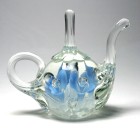 |
| 842 | Magnum 1930s Chinese Scrambled Millefiori
Paperweight. circa 1930. This is an extra large
example of a 1930s scrambled millefiori paperweight from China
filled with a nice assortment of millefiori canes and twist
canes. This style was intended to be a copy of a French
scramble or end of day weight from 1845-1860 (probably St. Louis or
Clichy), but it will not fool today's collectors. This example
is scratch signed "CHINA" on the base. As
with most Chinese paperweights of this period, this paperweight
has a light weight glass mixture that is high in soda and has a
greenish tinge. The glass has a soft oily feel and there are many light scratches and scuff
marks. There are also striations (sugaring) in the
glass. An unusually large example worthy of any collection
of Chinese paperweights. Chinese Paperweights were made in the late 1920s and throughout the 1930s as an attempt to duplicate 19th Century antique weights made in the United States and France. Because they are almost 100 years old, they are very collectible and every collector should own a few of these as study pieces. The history of the early Chinese paperweights is mostly anecdotal as no written records have been discovered. The story is that an American dealer sent examples of paperweights made by the New England Glass Company (NEGC), Boston & Sandwich Glass Company (B&S), Millville makers, and French factories to a Chinese factory and requested copies be made. The results are interesting and sometimes confused with the originals by inexperienced collectors. The earliest pictures of these paperweights appeared in the book American Glass Paperweights by Francis Edgar Smith published in 1939. Smith was aware that at least one of the paperweights shown in his book was Chinese. Since Smith was not an expert collector, this indicates that there was some general knowledge that these were Chinese prior to 1939. In the United States, the Tariff Act of 1930 required that every imported item must be conspicuously and indelibly marked in English with its country of origin. As a result, many of these Chinese paperweights are scratch signed on the bottom "CHINA". Many are also not signed, suggesting that either they were imported prior to 1930 or the importer ignored the requirement. Most likely the earliest Chinese paperweights were made prior to 1930. The Chinese makers often combined design features found in paperweights from different makers. For example they copied the latticinio grounds used by New England Glass Company and used them with copies of Baccarat Pansy weights. The original Baccarat pansy paperweights never had a latticinio ground. They copied the pedestal rose from Millville and then used the pedestal bottom with other weights. It is fun to collect all the variations. In general, Chinese paperweights from the 1930s have a light weight glass mixture that is high in soda and has a greenish tinge. The glass also has a soft almost oily feel. Frequently they have bubbles or debris in the glass. And because of their age, many of these have minor scratches or other surface defects. Chinese paperweights made in the 1970s and later usually have better quality glass and are free of debris.
Very large size: Just under 3 7/16” diameter
by 2 7/16" high. The base is rough, fire finished, and
ground concave in the center. A remnant of the pontil scar
remains in the center. For extra pictures, click on the picture at the right and the following links: Large picture$125 postage paid in the US. Added 2/23/2021 For more information about paperweights from China, see my Chinese Paperweights Web Page Click on the picture to see a larger image. |
Click
on the picture to see a larger image |
| 4026 | Miniature Strathearn Eight Pointed Star
Concentric Millefiori Paperweight with Opaque Lime Green Ground.
circa 1963-1968. This miniature paperweight features a three
ring concentric millefiori design and is finished as a eight pointed
star. The ground is an opaque lime green. The star
points give the glass a glittery appearance. This paperweight
has a worn Strathearn paper label with a leaping salmon and
"STRATHEARN HAND MADE IN SCOTLAND" on the base. A great
addition to any collection of Scottish glass. This is called a pressed weight because a mold is used to form the shape. The top is flattened. The star points give the glass a real glittery appearance as you can see in the pictures. The birth of Scottish paperweight making is credited to the glass making family of Salvador Ysart, who moved to Crieff, Scotland in 1922. They worked first at John Moncrieff Ltd and made the earliest Scottish paperweights during that period. In 1946 Salvadore and his sons Augustine and Vincent founded Ysart Brothers Glass and produced glass wares under the Vasart label. Salvador Ysart died in 1955 The company name was later changed to Vasart Glass. Strathearn Glass was formed in a reorganization of Vasart glass in 1963. The new company was owned by Teachers Whiskey. Miniature size: 2 1/16” diameter by 1 1/8”
high. The base is fire polished. For extra pictures, click on the picture at the right and the following links: Large picture$59 postage paid in the US. Added 2/22/2020 For more information about paperweights made by Scottish makers, see my Scottish Paperweights Web Page Click on the picture to see a larger image. |
Click
on the picture to see a larger image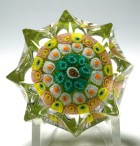 |
| 2836 | Selkirk 1996 Stylized Blue Flower
Paperweight. dated 1996. This paperweight has an
stylized or abstract blue floral design with five trumpet shaped
petals and a green center. Each of the trumpet shapes has an
elongated bubble in the center. The design is placed over a
translucent blue ground. It is signed in script on the base
"SELKIRK GLASS SCOTLAND 1996". It also has a worn paper label
"SELKIRK GLASS HANDMADE IN SCOTLAND". A colorful example
from Selkirk Glass. Selkirk Glass founded in 1977 by Peter Holmes and Ron Hutchinson. Peter apprenticed under Paul Ysart at Caithness from 1963 and continued at Caithness until 1977. Ron Hutchinson was also at Caithness. Selkirk produced a wide range of paperweight styles including abstract, lampwork and millefiori paperweights. The company was located in Selkirk, Scotland in the Borders Region. At some point they were purchased by Edinburgh Crystal and remained in operation until 2006. . Peter Holmes started his glass working career at Caithness Glass (Scotland) in 1963 as an apprentice to Paul Ysart. He continued at Caithness until 1977, when he and Ron Hutchinson left Caithness to start Selkirk Glass. Peter left Selkirk in 2002 to start Scottish Borders Art Glass with his son, Andrew, at Galalaw, Hawick. Large size: 2 13/16" diameter by 2 5/8" high. The
bottom is ground concave. For extra pictures, click on the picture at the right and the following links: Large picture$95 postage paid in the US. Added 2/18/2021 For more information about paperweights made by Scottish makers, see my Scottish Paperweights Web Page Click on the picture to see a larger image. |
Click
on the picture to see a larger image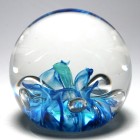 |
| 5265 | Francis Whittemore Miniature Yellow Pears
with Leaves and Seed Pod Paperweight. circa 1971 -
1980. This paperweight features two yellow pears along with
three green leaves, and a seed pod. It is signed in the design
with a fancy Whittemore "W" compound signature cane. The
signature cane is a white "W" on a blue background surrounded by a
ring of white stars. The design is placed on a translucent
green ground. Whittemore revisited this theme several times
during his career as a paperweight maker. A beautiful example. Note: This was a difficult paperweight to photograph. The highly reflective surface even picked up a reflection of my hand and my camera. If you need more pictures please let me know. Francis Dyer Whittemore, Jr. is considered one of the pioneers of the modern paperweight renaissance. He started working in glass in 1938, but did not start making paperweights until 1962. His studio was in Lansdale, Pennsylvania. Like many other early glass artists, Francis started his career as a scientific glass blower and then later taught glass as an instructor. For five years, he spent one month a year consulting at Baccarat to help them refine their lampwork paperweight art. Some sources have this consulting work from 1971 to 1976. Other sources have it starting later. The signature cane used on this paperweight was one he developed during the period that he was consulting at Baccarat. Most of his paperweights are miniature to medium in size. You can read about Francis Whittemore in the book American Glass Paperweights and Their Makers by Jean Melvin (1970). Miniature size: Just under 2 1/16" diameter
by 1 11/16" high. The bottom is ground concave. For extra pictures, click on the picture at the right and the following links: Large picture$375 postage paid in the US. Added 2/14/2021 For more paperweights by contemporary American paperweight
makers, see my Contemporary
American Paperweights Web Page. (dl-ca-va) |
Click
on the picture to see a larger image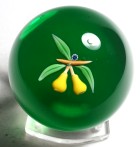 |
| 4856 | Baccarat 1976 Gridel Series Magnum
Millefiori White Monkey Limited Edition Paperweight. dated
1976. This modern millefiori paperweight features a large
central Gridel white monkey silhouette on a black background
surrounded by a ring of white canes. The white monkey cane is
set in the center of a paneled pattern with six panels of blue and
green millefiori and surrounded by a ring of identical green
canes. The panels are divided by rays of smaller Gridel canes
plus Baccarat's complex signature / date cane "B 1976". Each
ray contains three Gridel canes, with the exception of one ray which
contains two Gridel canes plus the signature / date cane. The
design is set on a translucent white ground. This design was
released in 1976 in a limited edition of 350 pieces. This is
number 186 in that edition. This paperweight is also signed on
the base with an acid etched Baccarat mark along with the year
(1976) and edition number (186). A fantastic
paperweight. In 1846 Baccarat introduced the popular Gridel figures in their closepack millefiori paperweights. It was named after Emil Gridel, the nephew of Jean-Baptiste Toussaint the general manager of Baccarat. Toussaint saw Gridel making paper cutouts of animals and saw an opportunity to incorporate these silhouettes in millefiori paperweights. From 1971 to 1979 Baccarat issued a modern Gridel series of millefiori paperweights based on eighteen Gridel figures. Each paperweight has a large Gridel figure in the center with smaller versions of the other figures included in the design. There are variations in orientation and color as well as the types of canes in each design and it is possible to amass a very large collection covering just this series. Very Large Size: Just under 3 7/16" diameter by
just under 2 5/16" high. The base is ground flat. For extra pictures, click on the picture at the right and the following links: Large picture$395 postage paid in the US. Added 1/30/2021. For more information about Baccarat paperweights, see my Baccarat Paperweights Web Page Click on the picture to see a larger image. |
Click
on the picture to see a larger image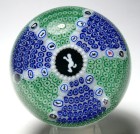 |
| 5383 | Rare Harold J. Hacker Snake
Paperweight. circa 1966 - 1980. This
wonderful Harold Hacker lampwork snake paperweight. The long
brown snake with two white eyes and a long slender tongue has a
yellow stripe down its back. It blends perfectly with the
copper colored frit ground. It is engraved "HJH" on the
base. A very similar example is shown on page 172 of Melvin's
book American Glass Paperweights and their Makers (Revised
1970). A desirable example of Hacker's work. Harold James Hacker (1906 - 1989)
was born in Weston, West Virginia and, at the age of thirteen,
took a job at the Weston Glass Plant. Later he worked at
the West Virginia Specialty Glass Company and learned some of
the rudiments of blowing glass. In 1936 he moved to
California and worked at the Technical Glass Company in Los
Angeles. After service in the armed services during world
war II, he obtained a concession at the Knott's Berry Farm
making miniature glass objects, built on a hobby of lampworking
that started back in West Virginia. In 1966 Hacker and a
friend from West Virginia, A. F. Carpenter, started
experimenting with glass paperweights at a small studio near
Hacker's home in Buena Park, CA. In the beginning they
made more traditional lampwork floral arrangements and
millefiori paperweights, but then focused on lampwork snakes,
reptiles, turtles, and other animals. Their output was low
and, even with two helpers, never exceeded 200 paperweights a
year. All were signed with variations of Hacker's
signature, "Hacker", "Harold Hacker", "Harold J Hacker", or just
the initials "HJH". It is not possible to specifically
identify which lampwork animals were made by A. F. Carpenter,
but it is believed that Carpenter was the better lampwork artist
and Hacker did some of the simpler designs. Hacker also
did the encasement. Their work was considered good enough
to earn an entry in Dunlop's Dictionary of Glass
Paperweights. Both men are included in Jean Melvin's
book American Glass Paperweights and their Makers (revised
edition 1970) and Hacker has a page in Larry Selman's
All About Paperweights. Harold Hacker wrote
an article "The Art of Paperweights" for the 1968 Annual
Bulletin of the Paperweight Collectors' Association. Size: 2 3/4" diameter by 1 1/16" high. The
base is ground flat. Note the low profile. For extra pictures, click on the picture at the right and the following links: Large picture$165 postage paid in the US. Added 1/22/2021 For more paperweights by contemporary American paperweight makers, see my Contemporary American Paperweights Web Page. Click on the picture to see a larger image. |
Click
on the picture to see a larger image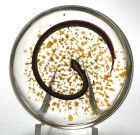 |
| 600 | Early Mark Matthews 1981 Experimental
Spiral Paperweight. dated 1981. This is an early
Mark Matthews Translucent Swirl Paperweight. It features a
precise gold swirl applied to a dark brown or dark red
surface. It was made in 1981 before Mark started his studio in
1985, so it may have been made during his student days. I have
labeled this as an experimental piece because there are many surface
"flaws". These flaws don't appear to be damage but rather the
result of an unfinished or experimental process. Marble
collectors are familiar with this amazing artist but he made
relatively few paperweights. His focus is spheres and some of
them sell for thousands of dollars. This is a chance to own an
early Mark Matthews work. Mark Matthews started working in glass in 1974 while he was still an undergraduate at glorious Kent State University and continued his studies at Ohio University, receiving an MFA. Since 1985 he as worked full time in glass as an independent glass artist with his studio located within the Sauder Village in Archbold, Ohio. Matthews has become internationally recognized for his mastery of the glass sphere. His stated goal is to explore the ways radically different designs and techniques can be used within a well-defined category such as spheres. Mark Matthews work has been published in many books and is held in museums such as the Victoria & Albert Museum in London, England, the Corning Museum of Glass in New York, the Toledo Museum of Art in Ohio and the National Museum of American Art, Smithsonian Institution, Washington, D.C. Large Size: Just under 3 1/16" diameter by 2 7/16"
high. The base is unfinished with a broken pontil
scar. For extra pictures, click on the picture at the right and the following links: Large picture$395 postage paid in the US. Added 1/17/2021 For more paperweights by contemporary American paperweight makers, see my Contemporary American Paperweights Web Page. Click on the picture to see a larger image. |
Click
on the picture to see a larger image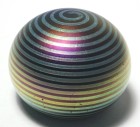 |
| 4646 | Magnum Victor Trabucco Pink Clematis
Paperweight with Buds on Trellis. dated 1983.
This Victor Trabucco paperweight consists of a large pink clematis
with two buds and leaves and stems on a white trellis. The
clematis flower has five textured petals with dark bushy stamens in
the center. One bud is about to open. There are ten
veined leaves. The design is set on a clear ground. It
is signed on the side near the base "Trabucco 1983". There is
also a "VT" signature cane on the underside of a leaf. A
beautiful paperweight.
Victor Trabucco's original career
was as a steelworker. He began working with glass in 1974
after seeing a flameworker make a sculpture. He knew this was
what he wanted to do for his life's work. Trabucco says that
“Glass is the ultimate challenge; it has properties of no other
material and offers the artist possibilities that are inspiring
for the creative process. His work is often inspired by nature,
capturing the beauty and motion of the subject and freezing a
moment in time. His work is in the collection of many major
museums. Victor set up his first studio in the basement of
his house and learned by experimentation. He now works
with his sons Jon and David in a large studio in Clarence,
NY. Very Large Size: Just over 3 1/8" diameter by
2 1/2" high. The base is ground concave. For extra pictures, click on the picture at the right and the following links: Large picture$675 postage paid in the US. Added 1/5/2021 For more paperweights by contemporary American paperweight makers, see my Contemporary American Paperweights Web Page. Click on the picture to see a larger image. |
Click
on the picture to see a larger image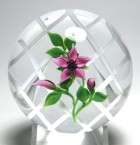 |
| 4566 | Large Whitefriars Early Faceted Six Ring
Concentric Millefiori Paperweight. dated 1970.
This paperweight has six concentric rings of canes (blue, white,
turquoise, dark blue, red, and white) around a larger center cane
with a star center. The ground is clear crystal. Typical
heavy Whitefriars lead crystal. The paperweight is faceted
with a large top facet and five large side facets. It has a
Whitefriars signature cane with a white monk and the date 1970 in
the outermost white ring and also has an early paper label used from
the mid 1950s into the early 1970s. With its bold colors, this
is a very nice addition to any collection of millefiori
paperweights. Modern Whitefriars paperweights are prized by collectors for their high quality glass and millefiori designs. The paperweights with mosaic canes are especially sought after. The name Whitefriars Glass dates from sometime in the 1600s. The original site had been occupied by a community of Carmelite monks known as White Friars, hence the name taken by the glass company. Some sources state that at least a portion of the company operated under the name of James Powell and Sons from 1834 to 1962. Other sources state that the Whitefriars name was used from 1680 to 1980. Limited production of millefiori paperweights and other millefiori items started some time in the 1930s and first appeared in the 1938 catalog. Millefiori items were made using English full lead crystal (33% lead oxide). It is difficult to associate specific paperweights with this production. After 1945, they made colored glass and bubble design paperweights until the modern millefiori production started about 1951. Even then relatively few designs were produced until the 1970s. In 1980, Whitefriars glass went out of business. After Whitefriars Glass was liquidated, Caithness Glass purchased the rights to the name and produced paperweights under the Whitefriars name for awhile. Large Size: Just over 3" diameter by 1 7/8"
high. The base is ground concave. Faceted with a total
of one large top facet and five large side facets. For extra pictures, click on the picture at the right and the following links: Large picture$275 postage paid in the US. Added 1/4/2021 For more information about Whitefriars and other paperweights from England,see my English Paperweights Web Page. Click on the picture to see a larger image. |
Click
on the picture to see a larger image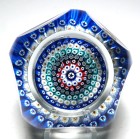 |
| 5102 | Large Antique Clichy Spaced Concentric
Millefiori Paperweight with 25 canes including a Green and Pink
Rose. circa 1845-1860. This wonderful antique
Clichy spaced millefiori paperweight contains an arrangement of 25
millefiori canes on lace ground. There are three rings with 12
canes in the outer ring, six in the middle ring and six in the inner
ring plus a wonderful large green and pink rose cane in the
center. The canes are intricate and very colorful. See
the close-up picture for more detail. A fantastic paperweight.
Clichy paperweights are highly sought after by collectors for their complex canes and brilliant colors. The Clichy factory was founded at Billancourt near Paris in 1837. Shortly after that it moved to Clichy-la-Garenne, which gave the factory its best known name. They stayed in operation until about the 1870s. Large Size: Just over 3 1/16" diameter by 2 1/8"
high. The base is ground concave. For extra pictures, click on the picture at the right and the following links: Large picture$995 postage paid in the US. US Sales only, no international shipping. Delivery will require a signature. Added 12/26/2020 For more information about Antique Paperweights, see my Antique Paperweights Web Page. Click on the picture to see a larger image. |
Click
on the picture to see a larger image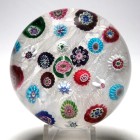 |
| 5428 | Rare 1974 Strathearn Faceted Upright Red
Flower Paperweight with Original Box. dated 1974.
This is a rare Strathearn faceted five petal upright red flower with
three leaves and a stem. There is a translucent red
ground. It is designated PSF62 in the catalog on Scotland's
Glass and is part of the second series of upright flower. It
has a polished flat base. The paperweight is faceted with a
small top facet and eight side facets (four large and four smaller
below). There is a paper label "STRATHEARN HAND MADE IN
SCOTLAND" and Strathearn's "S 74" signature cane on the base.
It comes with its original satin lined blue Strathearn Glass
box. A great addition to any collection of Scottish
paperweights. The birth of Scottish paperweight making is credited to the glass making family of Salvador Ysart, who moved to Crieff, Scotland in 1922. They worked first at John Moncrieff Ltd and made the earliest Scottish paperweights during that period. In 1946 Salvadore and his sons Augustine and Vincent founded Ysart Brothers Glass and produced glass wares under the Vasart label. Salvador Ysart died in 1955 The company name was later changed to Vasart Glass. Strathearn Glass was formed in a reorganization of Vasart glass in 1963. The new company was owned by Teachers Whiskey. The company is no longer in existence. Large Size: 2 5/16” diameter by 3 1/2” high.
It has a polished flat base. The paperweight is faceted with
a small top facet and eight side facets (four large and four
smaller below). The box is 6 1/2" long by 4" wide by 3"
high. For extra pictures, click on the picture at the right and the following links: Large picture$175 postage paid in the US. Added 11/30/2020 For more information about paperweights made by Scottish makers, see my Scottish Paperweights Web Page Click on the picture to see a larger image. |
Click
on the picture to see a larger image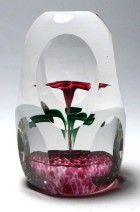 |
| 4742 | Antique Millville Style Magnum Rock of
Ages Four Color Frit Paperweight. circa
1900-1920. This frit paperweight features a rare four color
Rock of Ages motif with a turquoise cross on a rock in the middle of
the water. There is a brown or dark red vine growing on the
cross. The text "ROCK OF AGES" appears in blue and red above
the cross. The design is set in colored frit on an opaque
white enamel ground. The white ground color wraps around to
the base and covers the base except for a clear circle in the center
of the base where the pontil rod would have been. This
paperweight was probably made at the Whitall Tatum factory in
Millville, New Jersey in the first quarter of the 19th
century. Some collectors believe that the clear circle on the
base points to the Corning, NY area rather than Millville as the
place of manufacture. A great addition to any collection of
antique American paperweights. Note: This is a very nice clean example but I did find a very faint small (1/8”) partial circular impact mark on careful inspection. Please review the pictures. Frit refers to the powdered glass used to make the design. The design is set up in frit in a metal die and then picked up with a gather of the ground color. When encased, there is sometimes a ridge or crease line between the solid (in this case white) base area and the clear encasement. Some collectors refer to this as two piece construction. This type of construction has been associated with Whitall Tatum and other factories in the Millville area. There is no crease on this paperweight, but the encasement stops where the white ground color starts. Whitall Tatum was one of the first glass factories in America. Located in Millville, New Jersey, it was in operation from 1806 through 1938. The factory in Millville was purchased by a series of companies and eventually shut down in 1999. It is believed that Whitall Tatum workers were allowed to make paperweights from as early as 1860 until the practice was discouraged sometime after 1912. Some collectors believe that the clear circle on the base points to the Corning, NY area rather than Millville as the place of manufacture. There is no documentary proof to support this, but a number of weights of this type (with the clear circle on the base) have been found in the Corning area. According to Newell's Old Glass Paperweights of Southern New Jersey , frit weights were made as early as 1863. Newell identifies this style as a true American folk art and gives a history of paperweight making at Whitall Tatum and other South Jersey factories. Very large size: 3 11/16” diameter by 2 9/16”
high. The base is ground flat. This paperweight weighs
34 ounces. For extra pictures, click on the picture at the right and the following links: Large picture$195 postage paid in the US. Added 11/11/2020 For more vintage American paperweights, see my Vintage American Paperweights Web Page. Click on the picture to see a larger image. |
Click
on the picture to see a larger image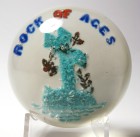 |
| 5283 | Antique Clichy Spaced Concentric
Millefiori on Lace Paperweight with Rose. circa
1845-1860. This antique Clichy spaced concentric millefiori
paperweight has a two concentric rings of complex millefiori around
a central red pastry mold cane. There is a wonderful large
green and pink Clichy rose in the inner ring. There are 19
canes in all, all placed on an upset muslin or lace ground.
The canes are intricate and very colorful. See the close-up
picture for more detail. A especially nice antique Clichy
paperweight.
Clichy paperweights are highly sought after by collectors for their complex canes and brilliant colors. Clichy paperweights with rose canes are especially desirable. The Clichy factory was founded at Billancourt near Paris in 1837. Shortly after that it moved to Clichy-la-Garenne, which gave the factory its best known name. They stayed in operation until about the 1870s. Small Size: 2 1/4" diameter by just over 1 5/8"
high. The base is ground slightly concave. For extra pictures, click on the picture at the right and the following links: Large picture$1,125 postage paid in the US. US Sales only, no international shipping. Delivery will require a signature. Added 10/25/2020 For more information about Antique Paperweights, see my Antique Paperweights Web Page. Click on the picture to see a larger image. |
Click
on the picture to see a larger image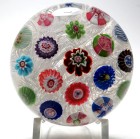 |
| 3070 | Special Peter McDougall Medium Ribbed
Millefiori Paperweight Made For 2011 PCA Convention. This
ribbed millefiori paperweight has a paneled millefiori pattern with
set in red, white, and blue. It was made as a table favor for
the 2011 Paperweight Collectors Association convention in
Washington, DC. There are seven panels, each with a 1-2
pattern of red, white and blue millefiori separated by red, white
and blue twists. There is a special convention complex cane in
the center "WDC 2011". The ground is a opaque black. It
is scratch signed PCA on the back and also has a paper label "PMcD
Glass Studio LTD, Hand Made in Crieff Scotland."
This is called a pressed weight because a mold is used to form the shape. The top is flattened. Peter McDougall started his glassmaking career as an apprentice at Strathearn Glass in Crieff, Scotland back in the 1960s. When Perthshire was formed in 1968, he left Strathearn to move to Perthshire and worked there in many positions, eventually becoming Manager and Chief Glassmaker. Perthshire Paperweights closed early in 2002 after the death of the owner Neil Drysdale. Peter McDougall then made high quality glass paperweights at his own glass studio, PMcD Glass Studio Ltd. in Crieff, Scotland from 2002 until early 2012. The studio is now closed but Peter plans to continue to make a limited number of paperweights in the future. Medium Size: Just over 2 1/2" diameter by 1 1/4"
high. The base is ground concave. For extra pictures, click on the picture at the right and the following links: Large picture$195 postage paid in the US. Added 10/13/2020 For more information about paperweights made by Peter McDougall, see my Peter McDougall Web Page . Click on the picture to see a larger image. |
Click
on the picture to see a larger image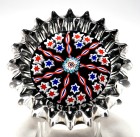 |
| 3069 | Special Peter McDougall Small Daisy
Millefiori Paperweight Made For 2011 PCA Convention. This
daisy shaped paperweight has a paneled millefiori pattern with set
in red, white, and blue. It was made as a table favor for the
2011 Paperweight Collectors Association convention in Washington,
DC. There are six panels, each with a 1-2 pattern of red,
white and blue millefiori separated by red, white and blue
twists. There is a special convention complex cane in the
center "WDC 2011". The ground is a opaque black. It is
scratch signed PCA on the back and also has a paper label "PMcD
Glass Studio LTD, Hand Made in Crieff Scotland."
This is called a pressed weight because a mold is used to form the shape. The top is flattened. Peter McDougall started his glassmaking career as an apprentice at Strathearn Glass in Crieff, Scotland back in the 1960s. When Perthshire was formed in 1968, he left Strathearn to move to Perthshire and worked there in many positions, eventually becoming Manager and Chief Glassmaker. Perthshire Paperweights closed early in 2002 after the death of the owner Neil Drysdale. Peter McDougall then made high quality glass paperweights at his own glass studio, PMcD Glass Studio Ltd. in Crieff, Scotland from 2002 until early 2012. The studio is now closed but Peter plans to continue to make a limited number of paperweights in the future. Small Size: Just over 2 1/8" diameter by 1 3/16"
high. For extra pictures, click on the picture at the right and the following links: Large picture$145 postage paid in the US. Added 8/29/2020 For more information about paperweights made by Peter McDougall, see my Peter McDougall Web Page . Click on the picture to see a larger image. |
Click
on the picture to see a larger image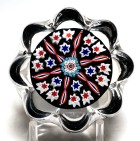 |
| 4016 | Large Mdina Glass Swirl Paperweight.
circa 1968-1985. Wonderful paperweight with a dark
interior of red, green, blue, yellow, and other colors. There
are additional swirls that surround the core and extend out to the
surface. The glass encasement is a dark grey or green.
Made on the island of Malta in the Mediterranean Sea. It is
signed "Mdina"in script on the base. Mdina Glass was founded on the Island of Malta in 1968 by Michael Harris (1933-1994) and Eric Dobson with financial incentives and the encouragement of the Maltese government. Initially it was called the Maltese Glass Industries, but the name was changed to Mdina Glass shortly later. Michael Harris received his training in glass at several institutions graduating from the Royal College of Art in London in 1959. He later became an RCA tutor setting up hot glass facilities there in 1967. He was a pioneer of the studio glass movement in the UK. Eric Dobson was also at the Royal College of Art. Mdina Glass was a successful venture and gave rise to a significant glass craft industry on the Island of Malta. Michael Harris left Malta in 1972 to establish Wight Glass in the UK. In 1971, two Italian maestros, the father and son team of Vincente and Ettore Boffo joined Mdina Glass to introduce Italian glassmaking techniques. Eric Dobson continued until about 1985 working with the local glass artists that he and Michael had trained. Eventually Mdina Glass was taken over by Joseph Said, a Maltese glassworker who had trained at Mdina. For context, during this period Malta gained independence from Britain in 1964 after 150 years as a British colony. In 1974 it became the Republic of Malta, and in 2004 joined the European Union. Large Size: 3" diameter and just under 4 1/4"
high. The bottom is fire finished with a left hand flame
pontil mark. For extra pictures, click on the picture at the right and the following links: Large picture $85 postage paid in the US.
Added 8/14/2020. For more information about paperweights from England, see my English Paperweights Web Page.
Click on the picture to see a larger image. |
Click
on the picture to see a larger image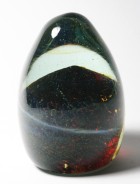 |
| 1585 | Very Rare Chinese Quatrefoil Faceted Blue
Flower with Bud on Double Latticinio Paperweight - copy of NEGC.
circa 1930. This is an almost antique Chinese copy of a New
England Glass Company (NEGC) Blue Flower with Bud Paperweight made
circa 1860. It has the fancy NEGC quatrefoil faceting and
double latticinio ground. There is a blue flower with five
petals and a millefiori center and also a large blue bud and two
large green leaves and a stem. The design is set on a great
double latticinio ground. The paperweight is faceted with a
four part top facet and eight side facets (four large and four
smaller). This is a fantastic addition to any collection of
antique paperweights. In some ways, the execution of this
example is better than the original NEGC, since NEGC examples often
have large bubbles or other defects in the latticinio.
Chinese Paperweights were made in the late 1920s and throughout the 1930s as an attempt to duplicate 19th Century antique weights made in the United States and France. Because they are almost 100 years old, they are very collectible and every collector should own a few of these as study pieces. The history of the early Chinese paperweights is mostly anecdotal as no written records have been discovered. The story is that an American dealer sent examples of paperweights made by the New England Glass Company (NEGC), Boston & Sandwich Glass Company (B&S), Millville makers, and French factories to a Chinese factory and requested copies be made. The results are interesting and sometimes confused with the originals by inexperienced collectors. The earliest pictures of these paperweights appeared in the book American Glass Paperweights by Francis Edgar Smith published in 1939. Smith was aware that at least one of the paperweights shown in his book was Chinese. Since Smith was not an expert collector, this indicates that there was some general knowledge that these were Chinese prior to 1939. In the United States, the Tariff Act of 1930 required that every imported item must be conspicuously and indelibly marked in English with its country of origin. As a result, many of these Chinese paperweights are scratch signed on the bottom "CHINA". Many are also not signed, suggesting that either they were imported prior to 1930 or the importer ignored the requirement. Most likely the earliest Chinese paperweights were made prior to 1930. The Chinese makers often combined design features found in paperweights from different makers. For example they copied the latticinio grounds used by New England Glass Company and used them with copies of Baccarat Pansy weights. The original Baccarat pansy paperweights never had a latticinio ground. They copied the pedestal rose from Millville and then used the pedestal bottom with other weights. It is fun to collect all the variations. In general, Chinese paperweights from this period have a light weight glass mixture that is high in soda and has a greenish tinge. The glass also has a soft almost oily feel. Frequently they have bubbles or debris in the glass. And because of their age, many of these have minor scratches or other surface defects. Large Size: Just under 2 5/8" diameter by 1
7/82" high. The bottom is ground concave. For extra pictures, click on the picture at the right and the following links: Large picture$295 postage paid in the US. Added 7/27/2020 For more information about paperweights from China, see my Chinese Paperweights Web Page. Click on the picture to see a larger image. |
Click
on the picture to see a larger image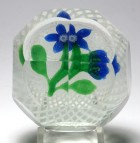 |
| 5304 | Large Murano Spaced Millefiori on Lace
Paperweight with Rare Signature Cane and KB Label - Probably by
Fratelli Toso. dated 1969. This paperweight
is a good example of a Murano spaced millefiori paperweight with
eight bright colored millefiori canes plus a rare signature cane
placed on a lace ground. The signature cane reads "M.B 69" in
blue letters on a white background. This signature cane has
been previously recorded and a variation appears in Andrew Dohan's Dictionary
of Paperweight Signature Canes", revised edition. At
this time, the precise meaning of the signature cane is
unknown. In addition, it has a worn and faded silver foil
label from KB (Koscherak Brothers) stating that it is "AN ORIGINAL
CREATION BY KB. MADE IN ITALY".
This paperweight was made on the island of Murano in Venice, Italy. Venetian glass making dates back centuries and the Venetians are given credit for the earliest millefiori canes and paperweights in 1840s. More recently, paperweight making was revived in the 1930s and again in the 1960s. Koscherak Brothers (KB) were importers of Murano glass and Italian pottery from the 1950s until the late 1970s . At the time, they had a showroom at 225 Fifth Avenue, New York, NY. Some writers have observed that most of the Italian Glass imported under the KB Label was made by Fratelli Toso, but others have noted that KB labels appear on other good Italian glass including Barovier-Toso, Seguso, and others. KB is believed to have stopped importing Italian glass about 1977, but continued to exist in New York City until at least 1993. Large Size: 2 15/16" diameter by 2 5/8"
high. The base is ground flat. For extra pictures, click on the picture at the right and the following links: Large picture$195 postage paid in the US. Added 7/19/2020 For more information about Murano paperweights, see my Murano Paperweights Web Page . Click on the picture to see a larger image. |
Click
on the picture to see a larger image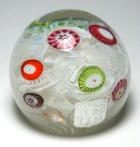 |
| 5159 | Robert Eickholt 1993 Magnum Blue
Iridescent Abstract Paperweight. dated 1993.
This paperweight has an abstract design with a deceptive three
dimensional design. Unlike other works where the peaks and
valleys are physical, in this paperweight the peaks and valleys are
created using the veiling technique. The dark blue inner core
has a mostly smooth surface with only a few depressions to anchor
the larger bubbles. Additional texture and depth are the
result of adding transparent and translucent layers to blanket the
core. Two large bubbles and an arc of smaller bubbles add to
the magic. The iridescent colors progress in layers in shades
of light to dark blue. It is signed "Eickholt 1993 EMAS" on
the base. An excellent large example of Eickholt's
work. Note: Please ignore the white areas, they are glare from the light. Robert Eickholt has been making glass paperweights since 1978 when he founded Eickholt Glass in Columbus, Ohio. His designs often make use of precious metals such as gold and silver, and rare oxides such as cobalt and copper. In later paperweights by Eickholt the design moved to the interior and veiling techniques began to appear. He retired in 2013. Very Large Size: 5 9/16" tall by 3 3/16"
diameter. The base has been ground flat. For extra pictures, click on the picture at the right and the following links: Large picture$195 postage paid in the US. Added 7/4/2020 For more paperweights by contemporary American paperweight makers, see my Contemporary American Paperweights Web Page. Click on the picture to see a larger image. |
Click
on the picture to see a larger image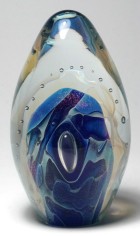 |
| 4680 | Large Early Selkirk Peter Holmes 1979
Aquarius Limited Edition Footed Paperweight. dated
1979. In my mind, this paperweight has an abstract
representation of the expression "the dawning of the age of
Aquarius" from the 1967 musical Hair, which was released on film in
1979. That's my interpretation, you can have your own. I
see a large silvery bubble charged with green energy suspended above
a green sea. There are undefined bodies rising from the
surface to join the sphere. The paperweight is an early design
from Peter Holmes created shortly after founding Selkirk
Glass. It is signed in script on the edge of the base "SELKIRK
GLASS SCOTLAND AQUARIUS 102/350 1979", indicating it is number 102
in a limited edition of 350 paperweights. It also has an early
Peter Holmes "PH" signature cane. Pedestal or footed
paperweights like this from Selkirk are rare, with only a few
designs made in this form. A imaginative paperweight in
excellent condition. Selkirk Glass founded in 1977 by Peter Holmes and Ron Hutchinson. Peter apprenticed under Paul Ysart at Caithness from 1963 and continued at Caithness until 1977. Ron Hutchinson was also at Caithness. Selkirk produced a wide range of paperweight styles including abstract, lampwork and millefiori paperweights. The company was located in Selkirk, Scotland in the Borders Region. At some point they were purchased by Edinburgh Crystal and remained in operation until 2006. . Peter Holmes started his glass working career at Caithness Glass (Scotland) in 1963 as an apprentice to Paul Ysart. He continued at Caithness until 1977, when he and Ron Hutchinson left Caithness to start Selkirk Glass. Peter left Selkirk in 2002 to start Scottish Borders Art Glass with his son, Andrew, at Galalaw, Hawick. Large Size: 3" diameter by 2 7/8" high. There is a
footed base, which is 2 3/8" diameter. The bottom of the
foot is ground flat. For extra pictures, click on the picture at the right and the following links: Large picture$165 postage paid in the US. Added 6/12/2020 For more information about paperweights made by Scottish makers, see my Scottish Paperweights Web Page Click on the picture to see a larger image. |
Click
on the picture to see a larger image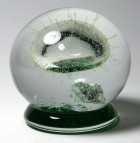 |
| 2257 | Large Antique Dorflinger Red over White
Petaled Lily-Style Paperweight. circa 1895-1920.
This lily paperweight has
four large red petals or panels, each with a red color over a
white base. The petals form a deep well in the center.
They are pleated with a large bubble and second smaller bubble
between each pleat. There is also a larger center
bubble. The petals are formed by
pushing the top of the design down with a crimp. The
paperweight is confirmed to have been made at Dorflinger
Glass. An amazing large paperweight with considerable
depth. This style of paperweight is referred to as a lily paperweight. It is similar to the pleated umbrella-style paperweights and paperweight inkwells made at Whitall Tatum in Millville, NJ (circa 1900-1912). The Millville umbrella designs usually have more pleats, typically eight, but four paneled examples also exist. The umbrella shaped weights were originally modeled to resemble the wild tiger lily of Southern New Jersey. C. Dorflinger & Sons Glass Company was founded by Christian Dorflinger in White Mills, PA in 1865. Paperweight stoppers for bottles were made by Nicholas and Francois Lutz at Dorflinger during the period 1866-1870. Lily style paperweights and other large paperweights, some with foil lettering and dates, were made by other glass workers at Dorflinger from 1895 to 1920. Recent research at the Dorflinger Glass Museum has located a catalog including references to paperweights. Most of the credit for the later styles of paperweights has been given to Tobias N. Hagberg and Ernst Von Dohln, although other Dorflinger workers also tried their hand. None of the paperweights is dated later than 1915. Christian Dorflinger died in 1915 and the business closed in 1921. Large Size : 3 5/`6” diameter by 3 3/4" high.
The base is ground flat. For extra pictures, click on the picture at the right and the following links: Large picture$395 postage paid in the US. Added 6/7/2020. For more information about Antique Paperweights, see my Antique Paperweights Web Page (dl-ant-va) Click on the picture to see a larger image. |
Click
on the picture to see a larger image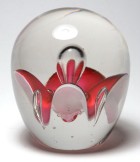 |
| 3112 | Magnum Antique Union Glass (Somerville,
Massachusetts) Paperweight "GEORGE M FLINT". Circa
1900-1929. This is a great Union Glass Company Paperweight
featuring a garland of eight lampwork flowers and the name "GEORGE M
FLINT" in the center. There are four red flowers and four blue
flowers, each with four petals, four light blue sepals, and a white
dot in the center. The letter "G" at the beginning of "GEORGE"
is reversed. In perfect condition. Union Glass Company of Somerville, Massachusetts is the third of three related factories in the Boston area. The first two were the Boston & Sandwich (B&S) Glass Company and the New England Glass Company (NEGC). Both B&S and NEGC produced paperweights at the same time, both were founded by Deming Jarvis, and both declared bankruptcy in 1888. Union Glass came a little later. It operated from 1851 to 1929. These name/date paperweights are made with lampwork flowers and letters and are not frit weights. There are some nice articles in the literature including a lengthy article in the Paperweight Collectors Association 2004 Annual Bulletin. There is also a short chapter in George Kulles' third book - Identifying Antique Paperweights - The Less Familiar. Nicholas Lutz worked at Union Glass from 1895 to 1904 and his influence can be seen on the Union Glass flowers although most of these weights were made after Lutz's death. There is some current speculation that Lutz had an apprentice who continued to work at Union Glass and was responsible for not only some of the better Union Glass examples, but also some of the fine lampwork paperweights attributed to Mount Washington Glass. Very Large Size: Just under 3 11/16" diameter by 2
5/16" high. It weighs 2 pounds 2 ounces. The
bottom is ground flat with a clear finish. For extra pictures, click on the picture at the right and the following links: Large picture$345 postage paid in the US. Added 6/5/2020 For more vintage American paperweights, see my Vintage
American
Paperweights Web Page.
(dl-va-ant) Click on the picture to see a larger image. |
Click
on the picture to see a larger image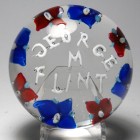 |
| 2267 | Large Millefiori Paperweight with Frit
Ground by Unknown Maker. This is a large mystery
millefiori paperweight made by an unknown maker. There are ten
millefiori canes (two designs) in brown, white, and black. Nine are
arranged in a circle alternating in an irregular pattern between two
cane types. And the tenth cane is a slightly larger black and
white cane in the center. All over a colorful frit
ground. The base is ground concave. A mystery for future
study. The maker of this paperweight is unknown. It is probably European in origin. Possibly early 20th century Murano, but it could also have originated at one of the many glass houses in Bohemia. Large Size: 2 15/16" diameter by 1 15/16"
high. The base is ground concave. For extra pictures, click on the picture at the right and the following links: Large pictureSOLD. Added 5/27/2020 For more information about paperweights by unknown makers, see my Unknown Makers Paperweights Web Page . Click on the picture to see a larger image. |
Click
on the picture to see a larger image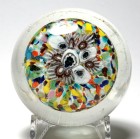 |
| 2958 | Antique Baccarat Roundels or Circlets
Millefiori Paperweight. circa 1845-1860. Antique
Baccarat millefiori paperweight with a red, white, and blue garland
pattern consisting of seven circles of millefiori canes, each with a
single complex cane in the center. Six of the roundels are
arranged in a a circle around the center roundel. The design
is placed over a clear ground. The paperweight is unsigned but
has several unique Baccarat canes and I guarantee that this is a
genuine Baccarat millefiori paperweight from the classic period
1845-1860. A desirable addition to any collection of antique
paperweights. Great color. Baccarat was founded in 1776 in Alsace-Lorraine with the name of Verrerie de Sainte Anne. The original location was near the town of Baccarat. Today the firm is known as Compagnie des Cristalleries de Baccarat. Most collectors refer to three periods of Baccarat paperweight production.
In 1952, Paul Jokelson approached Baccarat
with the idea of making sulphide paperweights again. In
1953 Baccarat resumed paperweight production with a series of
sulphide paperweights the first of which were the unsuccessful
Eisenhower sulphide followed by the Queen Elizabeth coronation
sulphide. Millefiori paperweight production was resumed in
1957 and lampwork paperweights were re-introduced in the early
1970s. Baccarat stopped making this type of fine glass
paperweights in 2002. You can read more about the Baccarat
paperweights in the book Baccarat
Paperweights - two centuries of beauty by
Paul Dunlop or one of the older books on paperweights in
general, such as The
Encyclopedia of Glass Paperweights by Paul Hollister
or World Paperweights by Robert
Hall. Size: 2 5/8" diameter by 1 3/4" high. The
bottom is ground concave. For extra pictures, click on the picture at the right and the following links: Large picture$895 postage paid in the US. added 5/24/2020 For more information about antique paperweights see my Antique Paperweights Web Page. (dl-ant-bacc) Click on the picture to see a larger image. |
Click
on the picture to see a larger image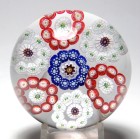 |
| 2793 | Medium Colorful Strathearn Paneled
Millefiori Paperweight. circa 1963-1968. This very
attractive paperweight consists of a paneled millefiori pattern with
eight sections of 1+2+2 millefiori patterns each separated by a
white latticinio twist cane. There is a central ring of six
millefiori canes and then a center millefiori cane. The canes
are early Scottish millefiori canes on an opaque blue
ground. This is a very nice example. A great
addition to any collection of Scottish paperweights.
The birth of Scottish paperweight making is credited to the glass making family of Salvador Ysart, who moved to Crieff, Scotland in 1922. They worked first at John Moncrieff Ltd and made the earliest Scottish paperweights during that period. In 1946 Salvadore and his sons Augustine and Vincent founded Ysart Brothers Glass and produced glass wares under the Vasart label. Salvador Ysart died in 1955 The company name was later changed to Vasart Glass. Strathearn Glass was formed in a reorganization of Vasart glass in 1963. The new company was owned by Teachers Whiskey. Medium Size: 2 9/16” diameter by 1 7/8”
high. Bottom is fire polished. For extra pictures, click on the picture at the right and the following links: Large picture$95 postage paid in the US. Added 5/4/2020 For more information about paperweights made by Scottish makers, see my Scottish Paperweights Web Page Click on the picture to see a larger image. |
Click
on the picture to see a larger image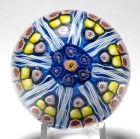 |
| 1872 | Mystery Magnum Star Millefiori Paperweight
by Unknown Maker. This is a very large mystery
paperweight made by an unknown maker. There are 13 black five
pointed stars each with a white background arranged in a 1-4-3-4-1
pattern. The design is placed over a large bubble with a
funnel like hole on the base which leads to the bubble. There
is no pontil mark. The maker of this paperweight is unknown. One collector has suggested that glass artist Richard Ritter made paperweights with similar star shaped millefiori, but that isn't enough to attribute this paperweight. So, it remains by an unknown maker. Very Large Size: 3 9/16" diameter by 2 1/4"
high. There is no pontil mark on the base, but there is an
unusual funnel shape that leads to the large bubble in the design.
For extra pictures, click on the picture at the right and the following links: Large picture of the paperweight$79 postage paid in the US. Added 5/1/2020 For more information about paperweights by unknown makers, see my Unknown Makers Paperweights Web Page . Click on the picture to see a larger image. |
Click
on the picture to see a larger image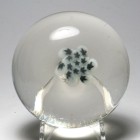 |
| 4245 | Antique Baccarat Miniature Spaced
Concentric Millefiori Paperweight with Four Gridel Canes on a Lace
Ground. circa 1847-1860. Antique Baccarat spaced
concentric millefiori paperweight with seven complex millefiori
canes, including four Gridel figures, the butterfly, dog, goat, and
deer. There are also two arrowhead canes and a multicolored
complex cane. Six canes are arranged in a circle around a
great center cane. The design is placed on a white lace ground
with bits of colored filigree. This perfectly balanced
miniature paperweight will be a wonderful to any collection antique
paperweights. According to Paul Dunlop in the Dictionary of Glass Paperweights, the first Gridel cane to appear was the lovebirds cane, which appeared in some 1846 paperweights. The others appeared in 1847 or later. Baccarat was founded in 1776 in Alsace-Lorraine with the name of Verrerie de Sainte Anne. The original location was near the town of Baccarat. Today the firm is known as Compagnie des Cristalleries de Baccarat. Most collectors refer to three periods of Baccarat paperweight production.
Baccarat continued to make paperweights after the classic period (1845-1860), but little is known about the extent of the product line or who made the paperweights. It is known that by 1910, the offering in the catalog had dwindled to pansy paperweights, simple open concentric paperweights, and rock paperweights. Popular lore attributes 1920-1934 Baccarat paperweights to a Mr. Dupont, who supposedly was the last worker at Baccarat to know the secrets of paperweight making. These paperweights were sold at a Baccarat retail shop in Paris. No collector or scholar ever met Mr. Dupont although at least one visited the Baccarat factory and asked to meet with him. The weights stopped appearing in the shop in 1934. New research of the Baccarat archives has identified the actual maker as Joseph Boyé (1877-1948). He is recorded as the maker of millefiori canes and millefiori paperweights during this period (1920-1934). Very little is known about Mr. Boyé, but there is enough similarity in the millefiori canes to suggest that he had access to the original molds or some of the original millefiori canes from the classic period. He later trained another glassworker, Georges Brocard, to make open concentric paperweights in 1946. Armed with this knowledge, Brocard was influential in the revival of paperweight making at Baccarat in the 1950s. Another glassworker, Louis Idoux (1882-1941), is recorded as making the Baccarat pansy paperweights during the 1920-1934 period. You can read more about the Baccarat paperweights in the book Baccarat Paperweights - two centuries of beauty by Paul Dunlop or one of the older books on paperweights in general, such as The Encyclopedia of Glass Paperweights by Paul Hollister or World Paperweights by Robert Hall. Miniature Size: Just under 2" diameter by 1 3/8"
high. The bottom is ground concave.. For extra pictures, click on the picture at the right and the following links: Large picture of the paperweight$1,250 postage paid in the US. US sales only for this paperweight. Delivery will require a signature. Added 4/24/2020 For more information about Antique Paperweights, see my Antique Paperweights Web Page. (dl-ant-bac) Click on the picture to see a larger image. |
Click
on the picture to see a larger image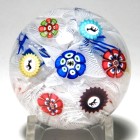 |
| 3529 | Early Kenyon Brown 1990 Multi-Color Swirl
Paperweight. dated 1990. This paperweight
features a blue, white, green, and brown swirl design with the swirl
winding from the base up to a tight point on top. The ground
is clear. It is signed with an engraved "Ken Brown '90" on the
fire finished base. One of Ken Brown's earliest
paperweights. A rare item. Kenyon Brown was originally an auctioneer in Buckingham, PA. After his retirement he developed an interest in glass and volunteered at Wheaton Village (now WheatonArts) in Millville, NJ. He experimented for more than a decade making paperweights. While he did some of the setups at his home in Lahaska, PA, he would do the encasement in the hot shop at Wheaton Village. Ken passed away in 2017 at the age of 94. Large Size: 2 13/16” diameter by 2 1/4" high.
The base is fire finished. For extra pictures, click on the picture at the right and the following links: Large picture of the paperweightSOLD. Added 3/12/2020 For more information about Contemporary American paperweights, see my Contemporary American Paperweights Web Page . Click on the picture to see a larger image. |
Click
on the picture to see a larger image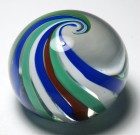 |
| 2238 | Chinese Millefiori Perfume Bottle or
Inkwell. c.1930. Matching concentric millefiori pattern
in the base and the stopper. Each has four rings of millefiori
around a central floral cane. The base is footed. I
would call this bottle a scent or perfume bottle because of the long
stopper that reaches almost to the bottom of the well. A very
desirable Chinese paperweight collectible.
This is a copy of a Whitefriars inkwell from about 1920. You can see the Whitefriars version by clicking this link. Note the similarity right down to the footed base. Size: 3 1/8" diameter by 5 1/2" high. Excellent condition with only minor wear consistent with age. As is typical of Chinese paperweights from this period, there is some debris in the glass and it has a greenish hue. For comparable pricing, check lot 288 in Selman's Fall 2002 auction, in which a similar sized bottle brought $303 against an estimate of $275-$400. Chinese Paperweights were made in the late 1920s and throughout the 1930s as an attempt to duplicate 19th Century antique weights made in the United States and France. Because they are almost 100 years old, they are very collectible and every collector should own a few of these as study pieces. The history of the early Chinese paperweights is mostly anecdotal as no written records have been discovered. The story is that an American dealer sent examples of paperweights made by the New England Glass Company (NEGC), Boston & Sandwich Glass Company (B&S), Millville makers, and French factories to a Chinese factory and requested copies be made. The results are interesting and sometimes confused with the originals by inexperienced collectors. The earliest pictures of these paperweights appeared in the book American Glass Paperweights by Francis Edgar Smith published in 1939. Smith was aware that at least one of the paperweights shown in his book was Chinese. Since Smith was not an expert collector, this indicates that there was some general knowledge that these were Chinese prior to 1939. In the United States, the Tariff Act of 1930 required that every imported item must be conspicuously and indelibly marked in English with its country of origin. As a result, many of these Chinese paperweights are scratch signed on the bottom "CHINA". Many are also not signed, suggesting that either they were imported prior to 1930 or the importer ignored the requirement. Most likely the earliest Chinese paperweights were made prior to 1930. The Chinese makers often combined design features found in paperweights from different makers. For example they copied the latticinio grounds used by New England Glass Company and used them with copies of Baccarat Pansy weights. The original Baccarat pansy paperweights never had a latticinio ground. They copied the pedestal rose from Millville and then used the pedestal bottom with other weights. It is fun to collect all the variations. In general, Chinese paperweights from the 1930s have a light weight glass mixture that is high in soda and has a greenish tinge. The glass also has a soft almost oily feel. Frequently they have bubbles or debris in the glass. And because of their age, many of these have minor scratches or other surface defects. Chinese paperweights made in the 1970s and later usually have better quality glass and are free of debris. For extra pictures, click on the picture at the right and the
following links: Large
picture of the paperweight For more paperweights from China, see my Chinese Paperweights Web Page. Click on the picture to see a larger image. |
Click
on the picture to see a larger image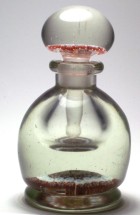 |
| 5027 | Faceted Harlequin Type Paperweight
with Five Icepick Bubbles - Possibly Unknown European or Scottish.
circa 1950 -1980. Most likely made at an unknown
European factory although there is a slight possibility that it was
made by a member of the Ysart family. This paperweight has a
large central bubble and four side bubbles pushed down to a
multi-colored frit ground. It is similar to the Harlequin
paperweights shown in Colin Mahoney's book on Paul Ysart
paperweights, but it not good enough to be called a Paul Ysart
Harlequin weight. There is a tight ring of twelve thumbprint
facets around the side near the base. The glass has a lot of
small bubbles. An interesting study paperweight. Note: My first inclination was to call this Bohemian or unknown European, but I could not find any close matches in the literature. Similarly, it shares some characteristics with the harlequin paperweights shown in Colin Mahoney's book Masterpieces: The Paperweights of Paul Ysart, but is not a good match there either. The birth of Scottish paperweight making is credited to the glass making family of Salvador Ysart, who moved to Crieff, Scotland from Spain in 1922. They worked first at John Moncrieff Ltd and made the earliest Scottish paperweights during that period. Paul Ysart (1904-1991), originally Pablo Moreno Isart, was apprenticed to his father as a glass worker at Moncrieff in 1922. He worked on the production of Monart Art Glass. Paperweights were primarily an after hours activity. Paul made his first paperweight in the early 1930s. Production was interrupted by World War II and the Monart line was not restarted until 1946. In 1946 Salvadore and his sons Augustine and Vincent left Moncrieff and founded Ysart Brothers Glass. They produced glass wares under the Vasart label. Salvador Ysart died in 1955. Paul stayed at Moncrieff from until 1962, when he joined Caithness as a Training Officer. While at Caithness, he trained Peter Holmes, Colin Terris, and William Manson, among others. After he retired from Caithness in 1972, he continued to make paperweights initially under the Harland label and then the Highland Paperweights label until 1979. You can read more about Paul Ysart in the book by Colin Mahoney Masterpieces: The Paperweights of Paul Ysart. Large Size: 2 15/16" at the widest by 2 9/16"
high. The bottom is ground slightly concave. There are
twelve flat side facets For extra pictures, click on the picture at the right and the following links: Large picture of the paperweight$95 postage paid in the US. Added 1/17/2020 For more information about paperweights made by Scottish makers, see my Scottish Paperweights Web Page Click on the picture to see a larger image. |
Click
on the picture to see a larger image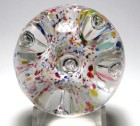 |
| 3506 | Antique Baccarat Miniature Single Clematis
with Millefiori Garland Paperweight. circa
1845-1860. Antique Baccarat miniature red/orange single
clematis with six ribbed petals, five leaves, and a stem. The
center of the flower is a complex millefiori cane with two rings of
white star shaped canes arranged around a red bulls-eye cane.
The clematis is surrounded by an outer garland of alternating ten
white and ten blue and white complex millefiori canes. The
white canes in the garland match the cane at the center of the
clematis flower. The blue and white canes have a ring of
arrowhead canes around a Baccarat star cane. The design is
placed over a clear ground and finished with a Baccarat star cut on
the base. The paperweight is unsigned but I guarantee that
this is a genuine Baccarat millefiori paperweight from the classic
period 1845-1860. A unique addition to any collection of
miniature paperweights. Great color. Note: The flower is noticeably off-center in this paperweight. Note on white glare: Please ignore the white areas, they are glare from the lights. According to Paul Dunlop in Baccarat Paperweights: two centuries of beauty, the single clematis is much rarer than the double clematis. Miniature Size: 1 15/16" diameter by just under 1
7/16" high. The bottom is ground slightly concave and is
finished with a Baccarat star. For extra pictures, click on the picture at the right and the following links: Large picture of the paperweight$1,750 postage paid in the US. US sales only for this paperweight. Delivery will require a signature. Added 1/17/2020 For more information about Antique Paperweights, see my Antique Paperweights Web Page. (dl-ant-bac) Click on the picture to see a larger image. Baccarat was founded in 1776 in Alsace-Lorraine with the name of Verrerie de Sainte Anne. The original location was near the town of Baccarat. Today the firm is known as Compagnie des Cristalleries de Baccarat. Most collectors refer to three periods of Baccarat paperweight production.
Baccarat continued to make paperweights after the classic period (1845-1860), but little is known about the extent of the product line or who made the paperweights. It is known that by 1910, the offering in the catalog had dwindled to pansy paperweights, simple open concentric paperweights, and rock paperweights. Popular lore attributes 1920-1934 Baccarat paperweights to a Mr. Dupont, who supposedly was the last worker at Baccarat to know the secrets of paperweight making. These paperweights were sold at a Baccarat retail shop in Paris. No collector or scholar ever met Mr. Dupont although at least one visited the Baccarat factory and asked to meet with him. The weights stopped appearing in the shop in 1934. New research of the Baccarat archives has identified the actual maker as Joseph Boyé (1877-1948). He is recorded as the maker of millefiori canes and millefiori paperweights during this period (1920-1934). Very little is known about Mr. Boyé, but there is enough similarity in the millefiori canes to suggest that he had access to the original molds or some of the original millefiori canes from the classic period. He later trained another glassworker, Georges Brocard, to make open concentric paperweights in 1946. Armed with this knowledge, Brocard was influential in the revival of paperweight making at Baccarat in the 1950s. Another glassworker, Louis Idoux (1882-1941), is recorded as making the Baccarat pansy paperweights during the 1920-1934 period. You can read more about the Baccarat paperweights in the new book Baccarat Paperweights - two centuries of beauty by Paul Dunlop or one of the older books on paperweights in general, such as The Encyclopedia of Glass Paperweights by Paul Hollister or World Paperweights by Robert Hall. |
Click
on the picture to see a larger image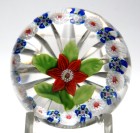 |
| 4904 | Daniel Salazar Lundberg Studios 1992 Rose
Vine Paperweight Perfume Bottle. dated 1992. This
elegant paperweight perfume bottle features six deep red roses with
dark green leaves on vines at the top of a gracefully shaped
bottle. The vines wrap around the lip of the bottle.
There is a ball stopper extending into the bottle. Signed and
dated on the edge near the base "Daniel Salazar 0714100 Lundberg
Studios 1992". A great three dimensional design that is hard
to find. Note: Please ignore the white areas in the pictures caused by the light. Daniel Salazar is one of the lead gaffers at Lundberg Studios in Davenport, California and is their primary paperweight designer and maker. He joined Lundberg in 1975. The studio was founded by James Lundberg in the early 1970s. Steven Lundberg joined shortly later. The first paperweights were made in 1972. In 1973 the firm was renamed Lundberg Studios and moved to Davenport, California. James died in an accident in 1991. Steven left Lundberg Studios in 1997 and set up his own studio. He died from ALS in 2008. Each paperweight produced at Lundberg Studios is signed and dated by the studio and signed by the artist.
Large Size: 3" diameter by 5 5/8" tall
with the stopper. It is 4 3/16" tall without the
stopper. The bottom is ground concave with a remnant of
pontil mark in the center. For extra pictures, click on the picture at the right and the following links: Large picture of perfume bottleSOLD. Added 1/11/2020 For more paperweights by contemporary American paperweight makers, see my Contemporary American Paperweights Web Page. Click on the picture to see a larger image. |
Click
on the picture to see a larger image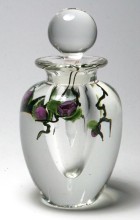 |
| 5128 | Large Murano Scramble Paperweight. circa
1970. This fun scramble paperweight is filled with light blue
twist canes placed over a ground of white lace or upset
muslin. The blue twists have gold aventurine edges.
Unsigned. Note: Please ignore the white areas, they are glare from the lights. This paperweight has a faint scratch on the top of the dome. I also found a tiny (1/8") area on the side that appears to be debris in the glass. It cannot be felt and is not a bruise or pinprick. See the pictures for a closeup. Although many people collect scramble paperweights for their own merit, scrambles are also valuable tools for learning to identify the different colors and canes used by each factory. This paperweight was made on the island of Murano in Venice, Italy. Venetian glass making dates back centuries and the Venetians are given credit for the earliest millefiori canes and paperweights in 1840s. More recently, paperweight making was revived in the 1930s and again in the 1960s. Large Size: 3" diameter by just under 2 11/16"
high. The base is ground flat. For extra pictures, click on the picture at the right and the following links: Large picture of the paperweight$65 postage paid in the US. Added 11/11/2019 For more information about Murano paperweights, see my Murano Paperweights Web Page . Click on the picture to see a larger image. |
Click
on the picture to see a larger image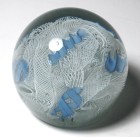 |
| 5087 | Vintage Thuringia Lauscha Bohemia Paperweight with Name
Plaque "Karl Laur". Circa 1920-1939. Colorful
vintage paperweight with a central name plaque over a two layer frit
ground. There are four icepick flowers each with a bubble in
the center. The name on the plaque is Karl Laur. An
interesting example of a name weight that is popular with many some
collectors. The maker of this paperweight is unknown, except that it is believed to originate either in Thuringia (now part of Germany) or in the region along the Czech - German border, hence the label Bohemian. Similar paperweights have are on display in the museum in Lauscha and are identified as being from Thuringia. Some examples can be found in the book by von Brackel, Paperweights: Historicism - Art Nouveau - Art Deco - 1842 to Today See pages 220-221 in particular figure 510. Both paperweights in this figure may have been decorated by the same hand as this paperweight. Size: 2 1/3" diameter by 1 11/16" high. The base is
ground flat. There is a small circular remainder of the
pontil mark in the center. For extra pictures, click on the picture at the right and the following links: Large picture$75 postage paid in the US. Added 4/27/2019 For more information about Bohemian paperweights, see my Bohemian Paperweights Web Page . Click on the picture to see a larger image. |
Click
on the picture to see a larger image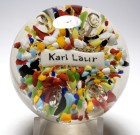 |
| 3065 | Antique Baccarat Dupont Period Miniature Concentric Millefiori
Paperweight. circa 1900-1932. This is a very nice
example of a Dupont period paperweight from Baccarat. The
middle (red) ring has great Baccarat star and arrow canes. The
inner ring has nice white stardust canes with blue whorls in the
center. There is a slight chance that this is from the classic
period, but the outer ring is less distinct which is why I think it
is Dupont. The design is off center. A very nice
example. Miniature Size: Just under 2 1/16” diameter by 1
1/2” high. Base is slightly concave. Baccarat was founded in 1776 in Alsace-Lorraine with the name of Verrerie de Sainte Anne. The original location was near the town of Baccarat. Today the firm is known as Compagnie des Cristalleries de Baccarat. Most collectors refer to three periods of Baccarat paperweight production.
For extra pictures, click on the picture at the right and the following links: Large picture of the paperweight$295 postage paid in the US. Added 3/4/2019. For more information about Antique Paperweights, see my Antique Paperweights Web Page. (dl-ant-bac) Click on the picture to see a larger image. |
Click
on the picture to see a larger image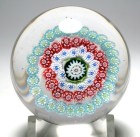 |
| 5058 | Dramatic Marcolin (Sweden) Sfumato Technique Owl Figural
Paperweight. circa 1961-1991. This
dramatic owl figural paperweight demonstrates the excellence of
Marcolin's use of the sfumato technique to create a smokey feathered
appearance. The upper figural owl portion is clear glass with a
round sfumato paperweight base. There is a slight reddish
tinge to the grey color of the sfumato. This paperweight
design was unique to Marcolin. It is unsigned but I guarantee
the attribution. A fantastic example. Please ignore the white areas, they are glare from the lights. Note: Please review the pictures. This paperweight has a large (3/4") scratch on the back next to base. FM Marcolin Art Crystal or FM
Marcolin Konstglas was founded Sweden in 1961 by two Italian
brothers, Josef and Benito Marcolin. They learned
their glass making skills on the island of Murano, Venice, and
later worked at Reijmyre before starting their own
company. FM stands for Färe-Marcolin. The
company went through several name changes as they moved from one
location to another, including "FM Konstglas, Eneryda", "FM Konstglas, Ronneby",
and then "FM
Konstglas / Marcolin". "Konstglas" is Swedish
for "Art Glass". The company changed its name to FM
Marcolin Art Crystal in 1983, and in 1988-89 changed again to
Marcolin Art Crystal. The Swedish factory closed in 1991,
and production was moved to Sardinia, Italy. The Marcolin
brothers left and went their separate ways, Benito moved back to
Sweden, while Josef moved to Austria and continued production
under the name Marcolin Art Crystal, which is still operating
today. The term Sfumato originated in
painting. Leonardo da Vinci described the technique as
blending colors, without the use of lines or borders "in the
manner of smoke". In glass, it is the use of a smokey
bubbled texture to create a soft feathered or quilted
appearance. Marcolin often used sfumato on bird
figurines. Large Size: The rounded base is 3 1/8"
diameter. The paperweight is 3" (80 mm) high. The bottom
ground flat. For extra pictures, click on the picture at the right and the following links: Large picture of the paperweight$69 postage paid in the US. Added 7/15/2018 For more paperweights from other countries, see my Other Countries Web Page. Click on the picture to see a larger image. |
Click
on the picture to see a larger image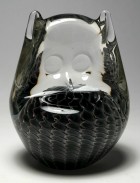 |
| 4963 | Rare Vasart / Lassman Checquer Pattern Millefiori Paperweight
Handle Bottle Opener. circa 1950s-1960s. This
bottle opener has a rare checquer pattern on the millefiori
handle. It is possibly unique. The firm of Lassman &
Co. designed and produced this bottle opener opener and a variety of
other useful objects during the 1950s and 1960s. The
attractive millefiori paperweight handle was made by the Ysart
family of Scotland under the Vasart label. The handle has a
checquer design with nine millefiori canes arranged in a square
surrounded by a latticinio square made up of four short twist
canes. There is a millefiori cane in the each corner of the
latticinio. The design is set on an amber colored opaque
ground. The chrome plated opener was made by Lassman and the
assembly was also done by them. The maker of this item was Lassman & Co. located in the Kilburn area of North London. Samuel Lassman purchased the paperweight handles from George Dunlop's Pirelli Glass in London. Pirelli obtained them from Vasart. Pirelli also took some assembled inventory back from Lassman and sold the barware items under the Pirelli label. Pirelli also included the line in their 1959 catalog. For more information, see my web page on Lassman & Co. or the article by Angela Bowey and Allan Port “Pirelli, Vasart and the Ysart Family” in the Paperweight Collectors Association Inc. Annual Bulletin 2015. A complete set of similar objects can be found at this link. The birth of Scottish paperweight making is credited to the glass making family of Salvador Ysart, who moved to Crieff, Scotland in 1922. They worked first at John Moncrieff Ltd and made the earliest Scottish paperweights during that period. In 1946 Salvadore and his sons Augustine and Vincent founded Ysart Brothers Glass and produced glass wares under the Vasart label. Salvador Ysart died in 1955 The company name was later changed to Vasart Glass. Stuart Drysdale was hired manage the business side of the enterprise in 1960. The company evolved into a new company Strathearn owned by Teachers Whiskey. In 1967 Drysdale was sent a magazine article on antique paperweights (Woman's Day, July 1965). The inspired him to try to produce weights comparable to the French antiques. With this goal in mind, he and several of the glass workers left Strathearn to found Perthshire in 1968. Size: 1 1/2" diameter. With the opener
hardware, it is 3 15/16" long. For extra pictures, click on the picture at the right and the following links: Large picture of the bottle opener$245 postage paid in the US. Added 1/26/2018 For more information about paperweights made by Scottish makers, see my Scottish Paperweights Web Page Click on the picture to see a larger image. |
Click
on the picture to see a larger image |
| 2020 | Vasart / Lassman Millefiori Paperweight Handle Bottle Opener
with Original Box. circa 1950s-1960s. The firm of
Lassman & Co. designed and produced this bottle opener opener
and a variety of other useful objects during the 1950s and
1960s. The attractive millefiori paperweight handle was made
by the Ysart family of Scotland under the Vasart label. The
handle has a concentric design on a rust colored ground that matches
the setup and canes of other Vasart paperweights. The chrome
plated opener was made by Lassman and the assembly was also done by
them. This item comes with its original box and celluloid
cover. The box is fabric lined (the original advertisements
said "silk lined") with elastics to hold the bottle opener in
place. A rare find for collectors of barware and Scottish
paperweights. The maker of this item was Lassman & Co. located in the Kilburn area of North London. Samuel Lassman purchased the paperweight handles from George Dunlop's Pirelli Glass in London. Pirelli obtained them from Vasart. Pirelli also took some assembled inventory back from Lassman and sold the barware items under the Pirelli label. Pirelli also included the line in their 1959 catalog. For more information, see my web page on Lassman & Co. or the article by Angela Bowey and Allan Port “Pirelli, Vasart and the Ysart Family” in the Paperweight Collectors Association Annual Bulletin 2015. A complete set of similar objects can be found at this link. The birth of Scottish paperweight making is credited to the glass making family of Salvador Ysart, who moved to Crieff, Scotland in 1922. They worked first at John Moncrieff Ltd and made the earliest Scottish paperweights during that period. In 1946 Salvadore and his sons Augustine and Vincent founded Ysart Brothers Glass and produced glass wares under the Vasart label. Salvador Ysart died in 1955 The company name was later changed to Vasart Glass. Stuart Drysdale was hired manage the business side of the enterprise in 1960. The company evolved into a new company Strathearn owned by Teachers Whiskey. In 1967 Drysdale was sent a magazine article on antique paperweights (Woman's Day, July 1965). The inspired him to try to produce weights comparable to the French antiques. With this goal in mind, he and several of the glass workers left Strathearn to found Perthshire in 1968. Size: Just over 1 1/2" diameter by just under 3
3/4" long. The box is just under 3" long by 2 11/16" wide by
2 9/16" high. For extra pictures, click on the picture at the right and the following links: Large picture of the bottle opener$345 postage paid in the US. Added 10/8/2017 For more information about paperweights made by Scottish makers, see my Scottish Paperweights Web Page Click on the picture to see a larger image. |
Click
on the picture to see a larger image |
Back to Allan's Paperweights (www.paperweights.com)
Revised 4/18/2024 EI9